

10 Macabre, Strange & Interesting Dark Tourism Destinations In Rome!
R ome, the eternal city of captivating history and timeless beauty, has long been a magnet for travelers seeking to unravel its iconic wonders.
But beyond the well-trodden paths that lead to the Colosseum, Vatican City, and the Trevi Fountain lies a world of secret treasures waiting to be discovered.
For the intrepid souls who yearn to veer off the beaten track, Rome’s offbeat attractions promise an enchanting journey into the city’s lesser-known, yet equally captivating, corners.
So let’s trade in familiarity for something a little more unexpected, and step away from the crowded tourist scenes we’ve seen a dozen times before. From ancient underground crypts to monuments plagued with morbid pasts, we want to explore what’s hidden in quiet alleyways in the dark side of tourism in Rome.
Each of these offbeat gems offers a unique perspective on the city’s multifaceted history and vibrant culture.
So, lace up your walking shoes and open your heart to a Rome less traveled – where stories of the past and the pulse of the present intertwine to create an unforgettable adventure through Rome’s best dark tourism destinations.

The Macabre, Strange & Interesting Dark Tourism Destinations of Rome!
1. the colosseum.
Centuries ago, the Romans sat at the head of the metaphorical global table, with an unfathomable infrastructure and society that in some instances outdoes modern times.
But unlike modern society, the world of technology was somewhat premature. Instead of being able to widdle away mindless hours watching TikToks and Youtube videos, the Romans had to find something interesting to pass the time.
Ancient Ampitheatres began to spring up, and the cities would flock in droves to the stands to watch Gladiators battle to the death.
The Colosseum is considered today, one of the first Dark Tourism destinations on earth, not just Rome. Its visitors were not drawn there for theatrics. They wanted to witness the guts and glory of heart-stopping brawls, which often had a bloody ending.
It’s only recently as historians delve deeper into the history and significance of the Colosseum, that the morbid horrors became apparent. Beneath the ring sat a maze of prison cells, in which unwilling slaves and animals were kept and tortured. Death not only plagued the surface, but lingered beneath the soil as well.
While the Colosseum was eventually left to ruin, it became one of Rome’s most popular tourist destinations. With some modern adjustments, guests can step onto ancient turf and feel the breath catch in their throat.
Aside from the jaw-dropping architectural feats, as you listen to helpful tourist guides regale on Greek Tragedies, the silence that clings to this ancient stone relic begins to surface a new meaning.
It may have once been a popular entertainment destination, but that will never hide from the fact that thousands of people died here, all in the name of sport.
Location: The Colosseum, Rome, Italy
Tags: Dark History

2. Torre Argentina
Largo di Torre Argentina was unearthed as part of Bento Mussolini’s effort to rebuild the great city of Rome in 1929.
Four distinct temples revealed themselve, and after becoming a fascination to archaeologists and historians alike, it was rumored that these ruins were part of the very same complex in which Julius Caeser was so infamously stabbed by Brutus.
It’s perhaps one of the most famed Greek Tragedies to date, and is still reinacted in theatres across the world today.
Unfortunately, Mussolini’s mission didn’t get too much further, leaving the ruins standing empty just long enough for the self-proclaimed royalty of domesticated animals to turn it into a permanent home.
That’s right, the cats that sleep on every sun-soaked stone in Italy have turned the ruins of Julius Caeser’s murder site into their cosy new abode.
But don’t worry, the city isn’t allowing the population to grow unchecked. In fact, the ruins have become a sanctuary that caters mainly to ferals with special needs.
The gattare, or as we know them today, childless millennial females, take very good care of the feral population, ensuring they’re well fed and happy in their home.
It’s a wholesome ending for a murder site, if only someone would convert the Amityville Horror House into a puppy rescue!
Location: 1-41 Via di Torre Argentina, Rome, Italy
3. Domus Aurea
Now this a destination that’s definitely NSFW, at least if you attended an event here several hundred years ago.
Emperor Nero built the Domus Aurea as a grand palace to sit on the Oppian Hill. Although it’s a palace fit for royalty, Nero hardly saw it as a permanent abode, instead frequenting it as a leisurely hideaway whenever he felt fit.
While most royalty prefer to soak up their lavished lifestyles with luxurious parties and extravagant ownership, Nero… Well. Nero took a different turn. For anyone who visited the Domus Aurea, they’d say it is the pinnacle of opulence, stacked with ivory, marble and mosaic.
But it was a site that caused ridicule amongst Nero’s followed due to the type of entertaining that happened behind closed doors. Basically, whenever Nero was around, you could expect to find a trail of ladies (and sometimes men) and a sock attached to the door knob.
Ah yes, this mad King was quite shameless. In fact, in a last ditch attempt to bury the shame of the Nero’s Dome of Pleasure, his pride and joy were buried under constant construction.
Ironically, this just kept the frescoed halls in perfect condition until it was rediscovered by chance again some centuries later. Until its immaculately kept halls began to corrupt to outside exposure.
The intricate details were destroyed, and all that stands now is a shell of the former pleasure house it used to be, with some interesting graffiti courtesy of Casanova, mind you.
It’s open to tours, and as it might be a struggle to picture the ruins as some ancient version of Christian Gray’s Red Room, you may need is an imagination equally as wild as Nero’s.
Location: Via della Domus Aurea, 1, Rome, Italy
Tags: Obscure Tourism
4. Museum of the Holy Souls of Purgatory
To anyone with a slight sense of world history, you’d know that Rome is amongst one of the holiest places in the world, thanks to the Vatican City being so nicely confined within the city limits.
So it’s no surprise that you’ll find quite an intricate maze of religious tourism to navigate. And yes, while the stunning churches and
The Museum of the Holy Souls of Purgatory is an eerie destination that holds a lot of unanswered questions. It’s a tribute to the ancient Catholic belief that when you pass, your soul sits in a strange state of inbetween. Your soul can only ascend from Purgatory, if it can atone for its sins.
This was rumored to be further urged along by the prayers of still living loved ones. Strangely enough, a similar belief exists elsewhere where Catholicism is quite prominent. Maybe Disney’s Coco was on to something?
Anyway! It is said that some souls are able to make their presence known by reaching through the veil of life and death. It is because of this, that the exhibits of the Museum of Holy Souls of Purgatory was made possible.
Cloth, singed with the handmark of an unknown entity, pages of books with seared paper. The small but intriguing collection really makes you ponder about the blurry line between life and death, and whether there is indeed some kind of afterlife to look forward to.
As if our quarter-life crises were not enough, add a little existential crisis to that Roman Holiday, would ya?
Location: Lungotevere Prati 12, Rome, Italy
Tags: Dark Tourism, Religious Tourism
5. Mausoleum of Augustus
The Romans knew how to live and die with flare, after all, look at all the theatrics involved with Julius Caeser’s assassination! Well, we can blame the first Emporer of Rome, Augustus for that.
In fact, after a trip to Egypt in 28 BC, Augustus felt quite deeply that he’d like to do as the Egyptians do, and wanted to build himself some sort of monolith to remember his legacy by.
Thus construction on Augustus’ Mausoleum began.
Today, the ruins of his colossal burial site stand as a waypoint in the centre of Rome, right by the Tiber River. It is the final resting place to several of Rome’s leaders, with Augustus being the first, and Nerva being the last.
The site sat dormant, and privy to ruin from 98 AC up until the early 20th century when it was briefly used as a concert hall. Eventually it was restored, or somewhat at least, to its rightful purpose as a tomb of Kings. If you ever find yourself in the area, take a moment to admire the stunning intricacy of detail that went into this glorified graveyard.
And take a moment of silence for the former rulers of Rome, after all, they changed the history of the modern world indefinitely.
Location: 61 Via Mario Dè Fiori, Rome, Italy
Tags: Grave Tourism
6. The Catacombs of San Sebastian
The Catacombs of San Sebastian lie nestled along the 6 kilometer stretch of Via Appia. In 350 AC, the remains of the martyr Saint Sebastian were put to rest at this site, in a basilica built to commemorate and honor him.
It was amongst one of the first of its kind, starting a long-standing burial tradition with deeply embedded roots in the Christian faith to this day. Without the Catacombs of San Sebastian, we wouldn’t have half the global dark tourism sites that attract thousands of visitors year round.
The walls of the catacombs are adorned with frescoes and inscriptions that depict scenes from the Bible and Christian symbolism. And throughout the years it started to gain a niche collection of items including a set of marble footprints said to be from Jesus himself.
You don’t have to be a Christian to admire the delicate details put into this monument, which, for the time, was quite an incredible feat! Guided tours are available which will lead you through the hallowed tunnels where you can gaze at the religious artistry that adorns its walls, and hear stories about its significance throughout history.
Aside from the eerie passages though, there’s nothing entirely “dark” about visiting this catacomb. That is, if you can get past the fact that there’s a bunch of bones buried behind the walls that surround you.
Location: Via Appia Antica 136, Rome, Italy
7. Ospedale delle Bambole
Taking a stretch beyond the religious relics of Rome, we want to introduce you to a destination that’s as wholesome as it is disturbing. Ospedale delle Bambole, which translates to “the Doll Hospital” is exactly what it sounds like.
And luckily for those with Pediophobia, a fear of inanimate humanlike objects (thanks Annabelle), this creepy little store is tucked away in a cobblestone alley that most tourists don’t know to look for. But for those of us fascinated by the strange and let’s face it, downright creepy, this is the spot for you!
While the motive behind this destination is far less sinister, we can’t help but shudder at the mirage of dolls heads in different states of disrepair staring at you through the glass window.
If you step inside, you’ll instantly feel the gaze of hundreds of porcelain and plastic dolls burrowing in to you. This small little shop is actually a tiny workspace run by a mother-son duo who’s main priority is to restore porcelain dolls and objects to their former glory.
For collectors, it’s a paradise!
Location: 29 Via Ripetta at Via del Vantaggio, Rome, Italy
8. Museo Storico Nazionale Dell’ Arte Sanitaria
The Museo Storico Nazionale Dell’ Arte Sanitaria is a well hidden part of the history of Rome, namely its medical history. It’s found quite close to Vatican City, and is an often overlooked tourist attraction that not too many people have heard about.
It is part of the Santo Spirito in Sassia, a 12th century learning hospital, and has converted the student ampitheatre into a mirage of exhibits. Museums like this, while macabre to some, are vital in showing the history of medicine, and can be quite eyeopening in terms of our evolution to modern medicines today.
From the porcelain anatomical recreations of the 17th century, to full recreations of alchemy labs and pharmacies, this museum is definitely worth a visit for anyone with a fascination for the medical field. Or just plain morbid curiosity.
Some of the exhibits are quite lifelike, so we do advise that it’s not a tourist attraction for the faint of heart. After all, standard medical practices up until the 21st century included labotomies and some other unbelievably strange operations that fit straight into a torture playbook.
Location: Lungotevere in Sassia, 3, Rome, Italy
Tags: Dark History, Obscure Tourism
9. Santa Maria della Concezione Crypts
Visiting the Santa Maria della Concezione Crypts is an experience that transcends the realm of the ordinary. It is a place that is equally as haunting as it is awe-inspiring!
Located beneath the Church of Santa Maria della Concezione dei Cappuccini in Rome, Italy, these crypts are renowned for their unique and macabre decoration. The remains of Capuchin friars have been artistically arranged to create intricate designs on the walls and ceilings, much like the Paris Catacombs!
Built in the 17th century, Baroque artists and architects took inspiration from the delicate line between life and death.
While the original point of the crypts were to give the Capuchin friars a final resting place, those tasked with the assignment took their artistic liberties to the next level, creating macabre murals made from skulls and femurs, and even human bone chandeliers!
While the intricacy and attention to detail might be enough to steal your breath away, one thing is undeniable – the Santa Maria della Concezione Crypts are a stark reminder of the afterlife. The bone decor within the crypts hold deep symbolic meaning. They serve as a visual representation of the cycle of life and death.
They are open to the public, and tours are not only welcomed, but encouraged. In fact, the crypts have become a significant cultural and historical site in Rome, capturing the imaginations of tourists of all kinds. But, of course, this destination holds a special place in the hearts of Dark Tourism lovers.
Location: Via Vittorio Veneto, Rome, Italy
Tags: Dark Tourism, Grave Tourism
10. Cimitero Monumentale del Verano
It goes without saying that the majority of Rome’s dark tourism industry thrives off their bountiful burial sites. Cimitero Monumentale del Verano is no exception, and has become a much beloved offbeat destination for lovers of art, architecture, and death. What a combination!
Established in response to the increasing need for burial spaces in a growing city, the cemetery emerged during a period marked by profound cultural changes. As a result, it not only became a final resting place but also a reflection of evolving architectural and artistic trends that shaped the era.
It seems that everybody in Rome wants a lavish burial site of their own! The influences here are as diverse as the people they commemorate, from Art Nouveau to Gothic, the monuments, masauleums and statues make this cemetery a sight to behold!
It’s an attraction that’s now packed with symbolism and for art lovers, or people who simply enjoy a good riddle, it’s interesting to try and decipher the deeper meaning behind each intricate detail engraved in the tombstones.
The cemetery serves as a quiet oasis where history and art entwine, and it’s a good way to remind yourself of the fragility of life. And as far as cemeteries go, this well-maintained and beautiful dedication to the deceased is not as creepy as you’d hope.
But, if there’s ever a zombie uprising, Cimitero Monumentale del Verano wouldn’t be the worst place to get eaten alive.
Location: Piazzale del Verano, 1, 00185 Roma RM, Italy
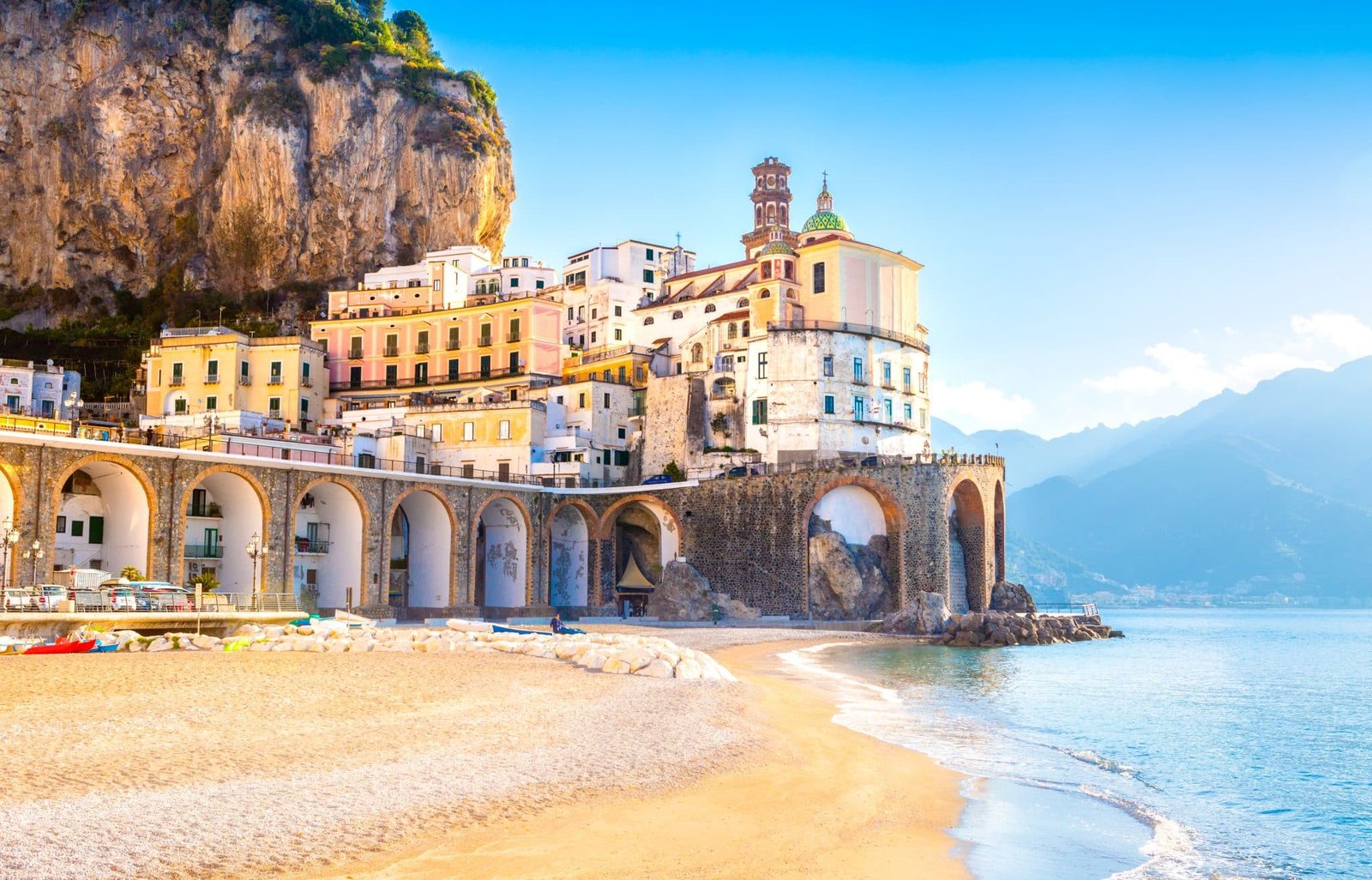
Related Posts

Athens vs Rome An Honest Comparison To Help You Choose
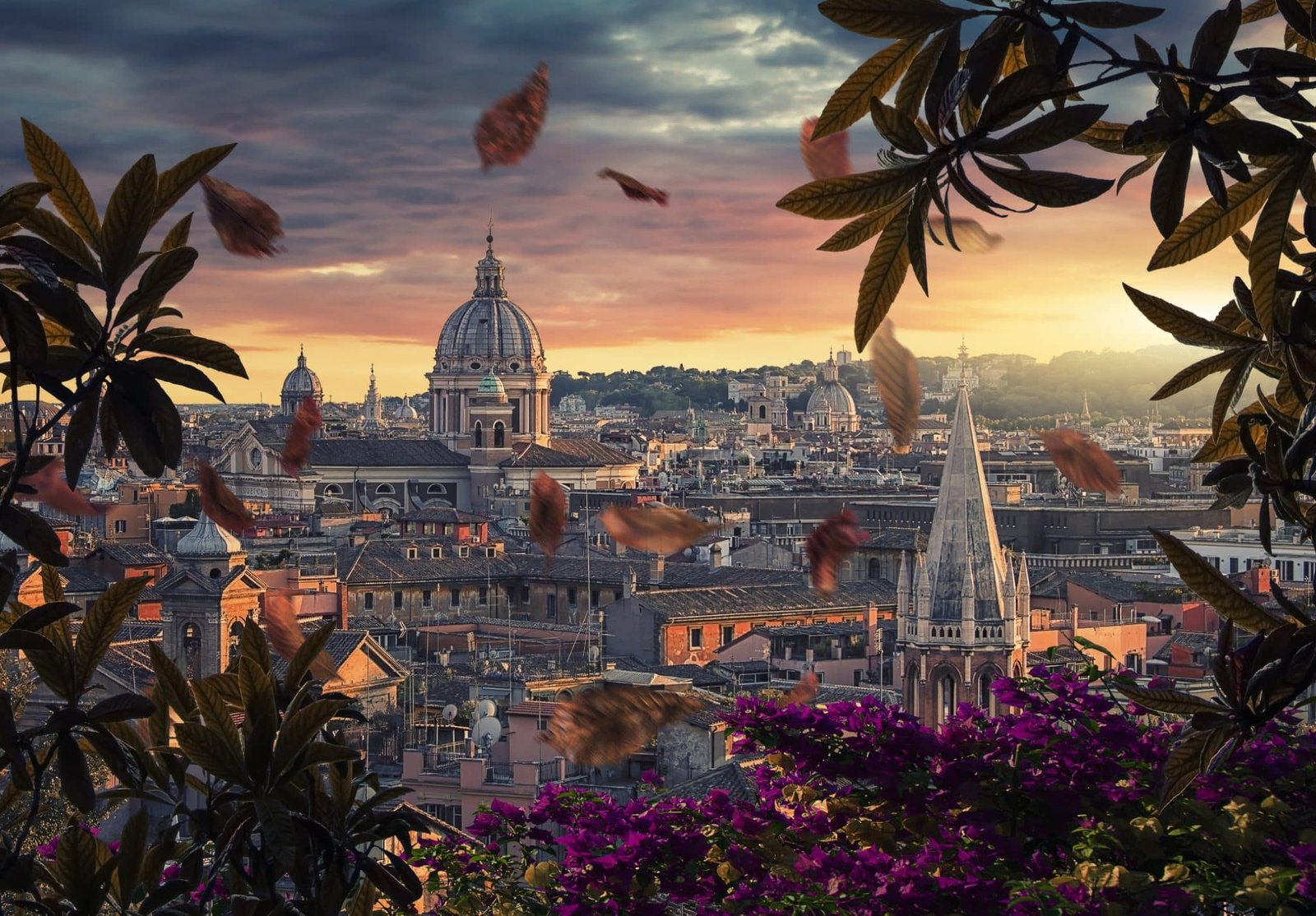
Rome or Barcelona: An Honest Comparison To Help You Choose!
10 macabre, strange & interesting dark tourism destinations of paris.

Lorem ipsum dolor sit amet, consectetur adipisicing elit sed.
Follow us on

- dark tourism
- Andaman & Nicobar
- Bosnia & Herzegovina
- Channel Islands
- Cyprus (North)
- Czech Republic
- Dominican Republic
- Easter Island
- El Salvador
- Falkland Islands
- French Guiana
- Great Britain
- [Nagorno-Karabakh]
- Netherlands
- New Zealand
- Northern Ireland
- North Korea
- Philippines
- South Africa
- South Georgia
- South Korea
- Switzerland
- Transnistria
- Tristan da Cunha
- Turkmenistan

- disclaimer & privacy policy
© dark-tourism.com, Peter Hohenhaus 2009-2024

17 Must-Visit Dark Tourism Destinations Around the World
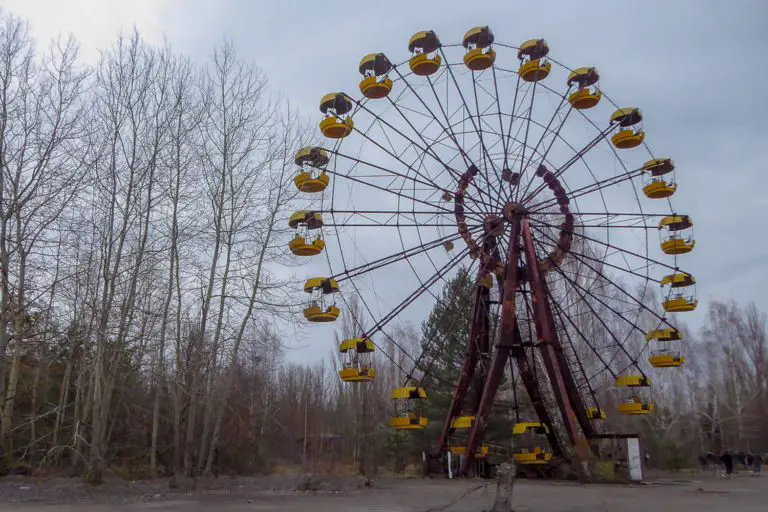
Dark Tourism destinations were once the remit of a select group of travellers. However, after the launch of popular Netflix show Dark Tourist, these attractions have hit the mainstream.
If you’re interested in the morbid and the macabre, look no further. After making several visits to dark history sites myself, I’ve teamed up with other travellers to bring you this list of dark tourism destinations all around the world.
Read more: (opens in new tab)
- What is Dark Tourism?
- Are Bolivia’s Mine Tours Ethical?
- Chernobyl Exclusion Zone Photographic Guide
17 Must-Visit Dark Tourism Destinations
1. chernobyl exclusion zone – kyiv, ukraine.
The abandoned amusement park in Pripyat is one of dark tourism’s crowning images. The haunting stills of the fairground that never heard the laughs of children hang in modern consciousness, a symbol of tragic loss and a warning of the mistakes men can make.
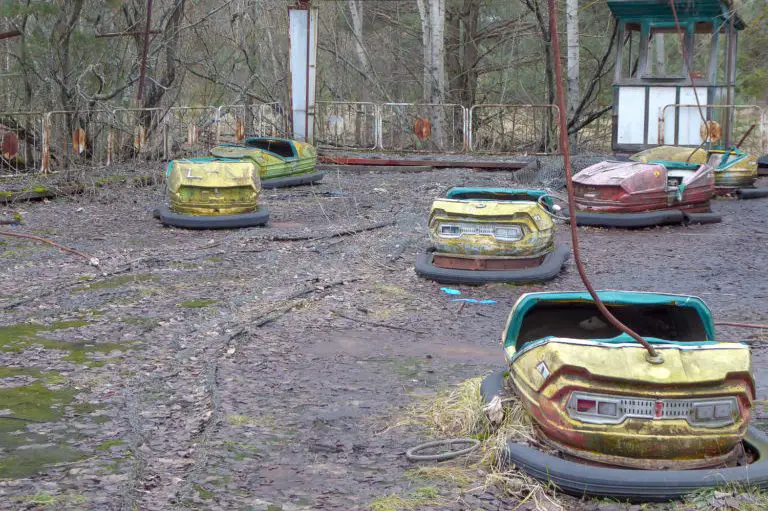
In 1986, the nuclear reactor at the Chernobyl power plant exploded, causing the worst nuclear accident in the world’s history. The effects were huge; people were forced to evacuate their homes and the surrounding areas became a hotbed of radiation. It was predicted that never again in our lifetime, would Chernobyl be inhabited by anything living.
Surprisingly, the Chernobyl exclusion zone has recovered quicker than was ever predicted. Although there are still risks with spending long periods in the exclusion zone, wild animals have returned and are thriving. Despite its recovery, Chernobyl acts as a very sobering reminder of the damage humanity can do without intention.
2. Sucre Cemetery – Sucre, Bolivia
Sucre Cemetery is an unlikely attraction in Bolivia’s capital. Regularly appearing on tourist maps, it is a peaceful place which attracts visitors who come to see how the Bolivians handle death and all that comes after.
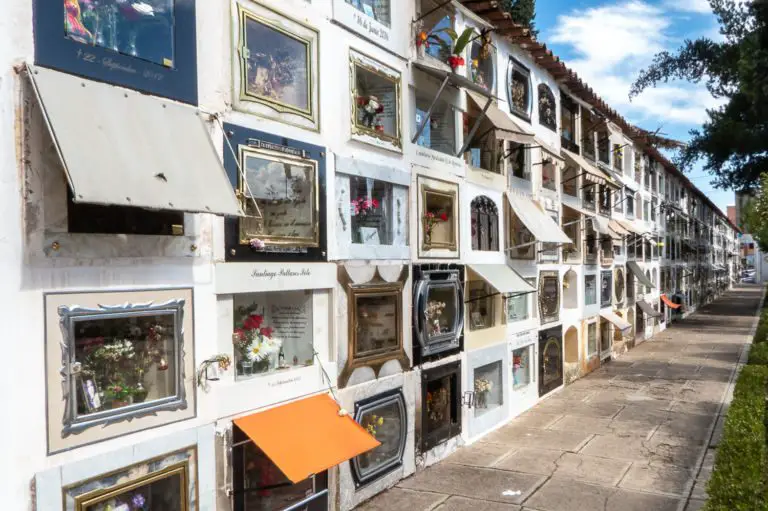
Also frequently visited by locals, this cemetery is a surprisingly popular spot for catching up with friends, studying and paying homage to the dearly departed.
Unlike other cemeteries I’d visited, these graves were arranged in a block system above ground. The vast majority of these were carefully maintained and were regularly stocked with gifts for departed loved ones. Small bottles of spirits were a common appearance, alongside slices of cake!
In Bolivia, death is accepted as an inevitability of life. While graveyards ultimately provide a space for burial, they hold a far more important symbolic role in Bolivian culture. Although death is traditionally seen as a dividing force, Sucre Cemetery demonstrates that death can continue to unite us all, long after somebody is gone.
3. The Poison Garden – Alnwick, England
Home to around 100 toxic and narcotic plants, the Poison Garden is undoubtedly one of the best things to do in Alnwick . This small but deadly garden is home to some of the world’s most dangerous plants and visitors are only allowed to enter on a guided tour.
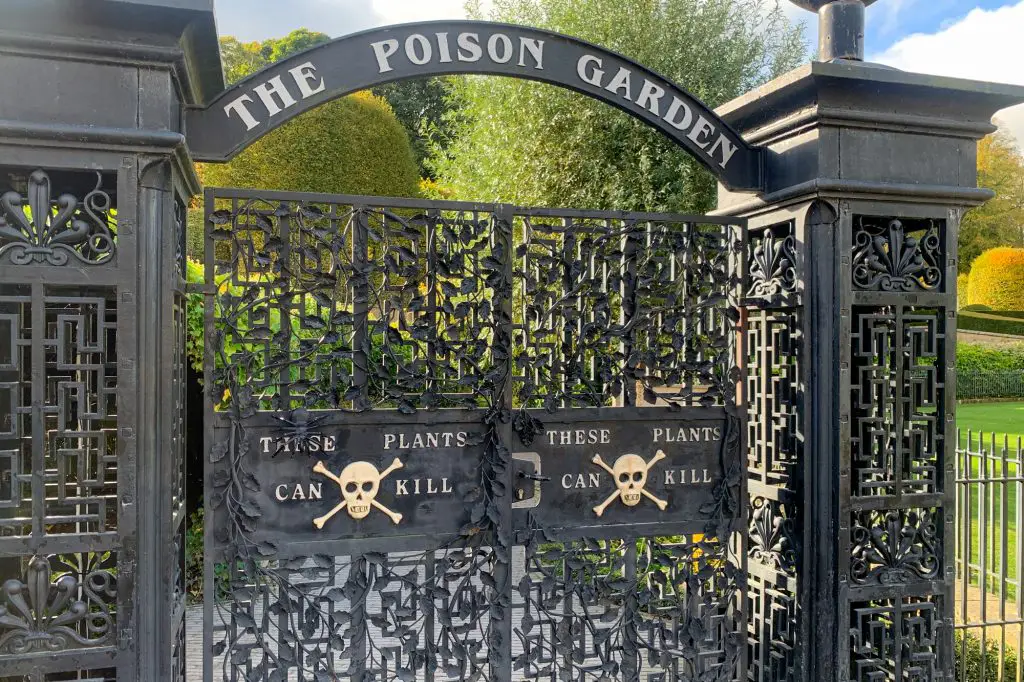
Deadly nightshade, cannabis and coca (the plant from which cocaine is derived) are a few examples of the plants housed in the Poison Garden. Visitors are prohibited from touching any of the greenery and there have even been cases of people passing out after smelling the plants!
The tour guides at the Poison Garden are great at explaining the real-life application of the plants using case studies such as Harold Shipman (Doctor Death) and Graham Young (The Teacup Poisoner). The garden also runs tours for local school children, educating them about drug use.
4. Paneriai Massacre Site – Vilnius, Lithuania
Paneriai is one of Vilnius’ many neighbourhoods. However, it will be forever remembered as the Ponary massacre site. The Einsatzgruppen (Nazi death squads) rounded up groups of Jews from the Vilna Ghetto, took them to Paneriai, executed them and forced other Jewish prisoners to dig mass graves and bury them.
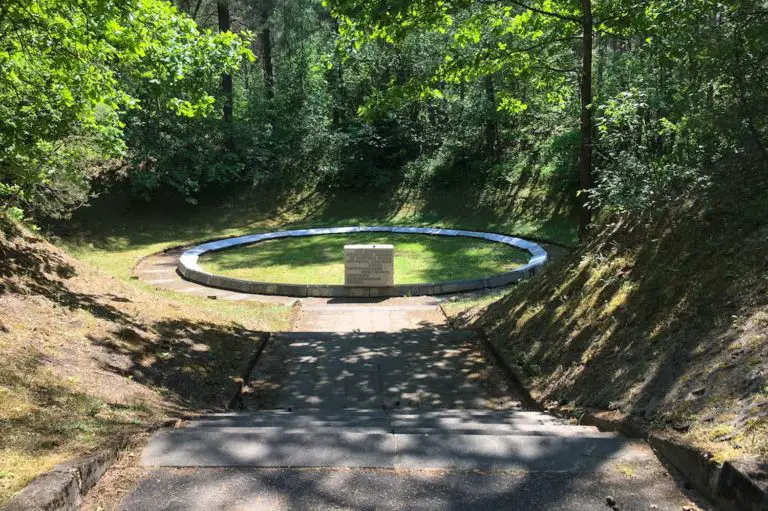
There are six burial sites within the complex, each the site of multiple mass executions. Because so many sets of bodies are stacked on each other, it is impossible to know the exact number of deaths. It is estimated to be around 100,000.
Those brought to Paneriai were burned to death in an attempt to destroy evidence. They were then shovelled into the pits, which today are marked by memorials. Like many of the massacre sites in the Baltics, Paneriai is a forested area. This makes walking around a surreal experience as it is quiet, peaceful and beautiful, a stark contrast to the memorials reminding you that thousands of people were slaughtered there.
Contributed by Cultura Obscura . Follow them on Facebook !
5. St. Nicholas’ Church – Hamburg, Germany
In July 1943, Hamburg was the target of an allied aerial World War Two bombing. The tall spire of St. Nicholas’ Church was used as an orientation marker and the building was almost completely destroyed. All that remained were some external walls, the crypt and most of the tower.
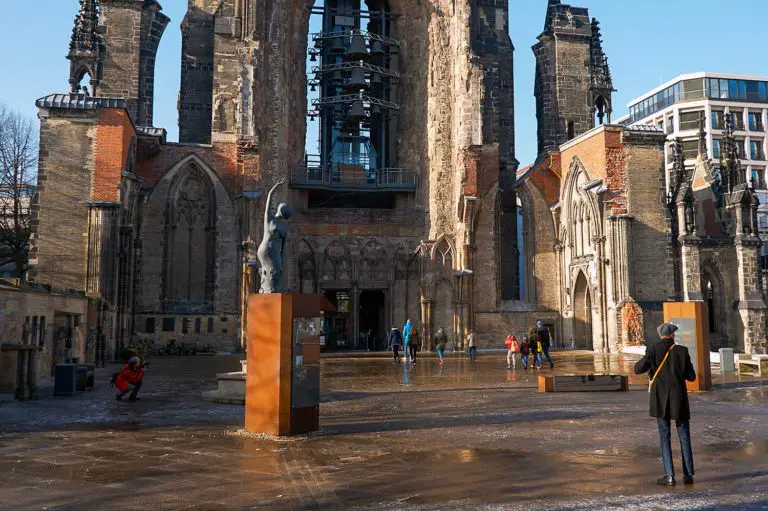
Today, St. Nicholas’ Church stands as a memorial to the victims of WWII. The memorial exhibits in the crypt provide many details of the events leading up to Operation Gomorrah , the air war over Europe. Beautiful sculptures sit inside, illustrating the futility of war and its disastrous consequences. A 51-bell carillon has been installed in the tower and sounds every Thursday at noon.
We visited the church on a walking tour of Hamburg and the experience still haunts me. The vast majority of people in Hamburg during Operation Gomorrah would have been perfectly ordinary citizens going about their daily lives – people just like me.
Contributed by Lesley of Freedom 56 Travel . Follow her on Twitter !
6. Comuna 13 – Medellin, Colombia
Medellin was once the most dangerous city in the world. When infamous drug lord Pablo Escobar controlled the city, crime was extremely high and the locals lived in fear. The neighbourhood of Comuna 13 had direct access to the main highway, making the exportation of drugs, weapons and other illegal goods extremely easy.
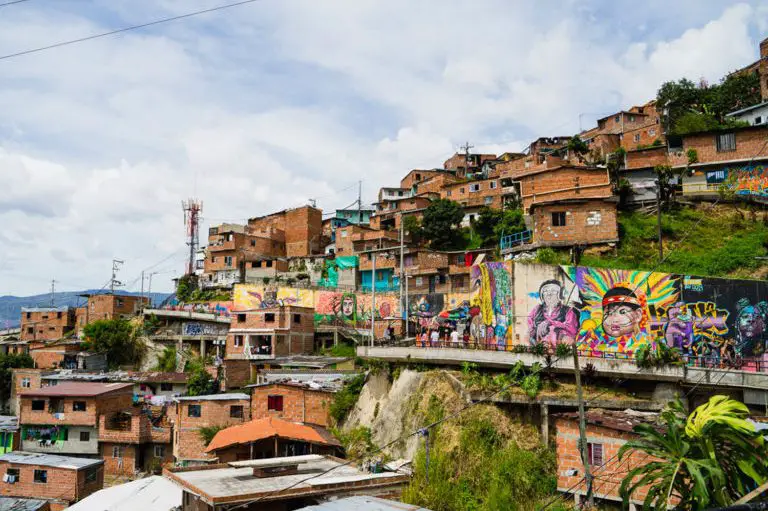
Drug cartels fought over control of the area and as a result, Comuna 13 was a very dangerous place. It was not uncommon to hear gunshots throughout the day and even to see dead bodies piled on the street. With that in mind, it might come as a surprise that Comuna 13 is now one of the most visited neighbourhoods in Medellin.
Over recent years, a tremendous amount of money has been invested in Comuna 13. A cable car system was installed to link it to the city centre. The resulting increase in tourism has sparked real change for the locals and the neighbourhood has become one of the country’s leading creative hubs.
Contributed by LivingOutLau . Follow him on Instagram !
7. Gulag Labour Camps – Karaganda, Kazakhstan
My trip to Kazakhstan left a deep impression on me. While I had heard about the so-called gulags, I did not know that most of them were in Kazakhstan. Stalin deported whole ethnic groups to the remotest corners of the country. This is how during WWII, the Volga Germans ended up in Karaganda .
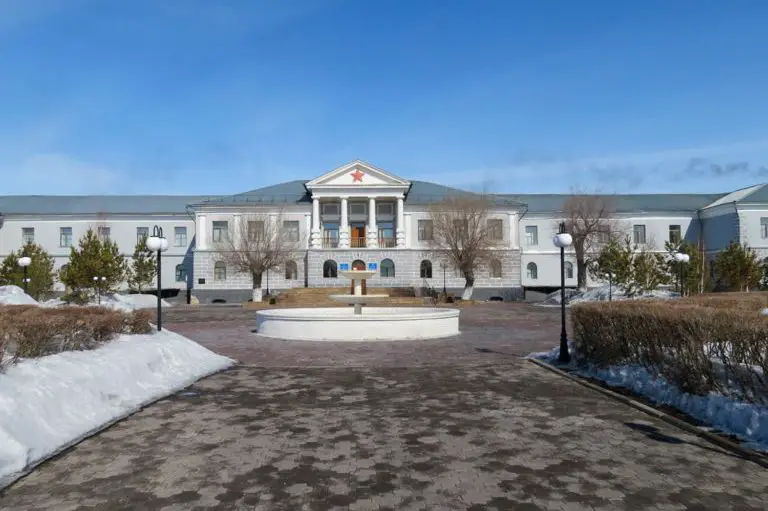
Stalin wanted to develop the farms and coal mines in Karaganda and set up a network of labour camps to support these projects. Political prisoners and deportees provided the free labour that was necessary.
Even though not much of the labour camps remain, Karaganda is the perfect example of a dark tourist site. There is an excellent Gulag Museum in the former headquarters of the labour camp in Dolinka.
Also nearby, the Ecological Museum covers other dark parts of Soviet history. The museum has an exhibition on the nuclear tests done in Kazakhstan and the debris that falls from the sky from the space program in Baikonur.
Contributed by Ellis of Backpack Adventures. Follow her on Instagram !
8. The Eruption of Mount Vesuvius – Pompeii, Italy
Pompeii was a thriving coastal city in Italy that was completely destroyed in 79AD when the neighbouring Mount Vesuvius erupted and covered the city in ash. It is a prime example of what is termed disaster tourism, where tourists visit a location where an environmental disaster has occurred.
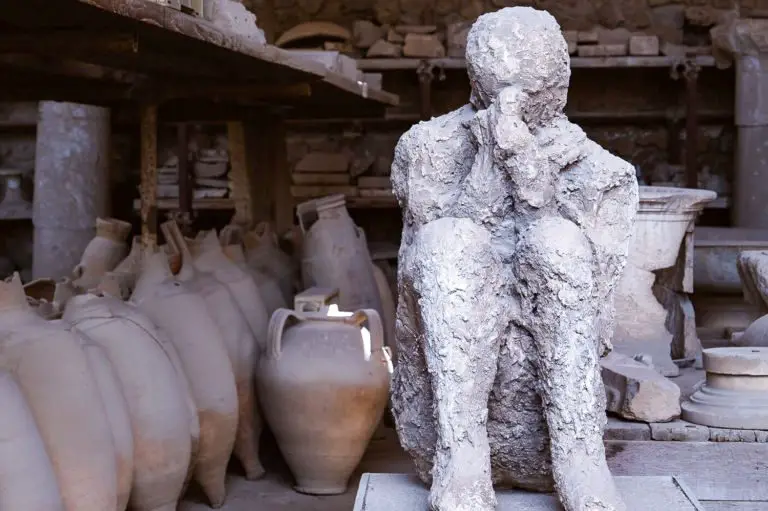
What makes the eruption of Mount Vesuvius more tragic was that the majority of people who died were slaves, who either had no means of escaping or were trapped. When archaeologists began excavating the site, they found several bodies. The ash preserved these bodies which allowed historians to create the human casts we see on site today.
Seeing these casts in crouching positions while covering their faces, gave me shivers. To get a greater understanding of the site and everything inside of it, I highly suggest finding a good tour guide. This photographic travel guide to Pompeii gives lots more tips for planning a visit.
Contributed by Natasha of And Then I Met Yoko. Follow Natasha on Instagram !
9. Mary King’s Close – Edinburgh, United Kingdom
Below the Royal Mile in Edinburgh hides an underground street paved with dark history. Mary King’s Close was alive with residents when the bubonic plague seized the country in 1645. The grievous epidemic turned the once-thriving close into a dreadful place, where its inhabitants suffered a slow and torturous death.
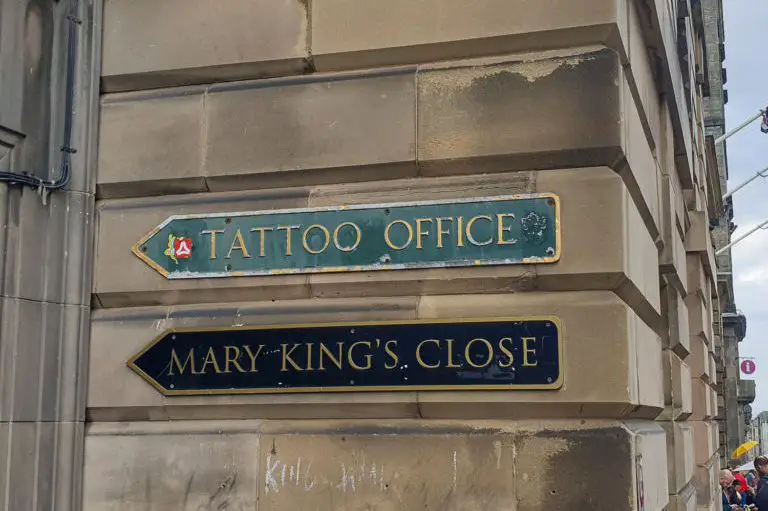
Mary King’s Close was sealed off and used as a foundation for the Royal Exchange in the late 1700s. Years passed and its terrible secrets were left trapped within its dark walls. In the 1990s, the close was rediscovered and opened to the public, allowing people to explore the subterranean streets that once festered with disease.
The mental image of the street once bustling with life left a lump in my throat – the locals had no idea how many would lose their lives to the Great Plague. Like Mary King’s Close, the entire city of Edinburgh is filled with dark and spooky places so be sure to check out Scotland’s capital if you’re a fan of the macabre.
Contributed by Wandering Crystal. Follow her on Instagram !
10. The Killing Fields and S-21 – Phnom Penh, Cambodia
During the Khmer Rouge genocide in Cambodia, execution, starvation and disease were allowed to flourish, killing an estimated three million people. Led by Pol Pot, the regime attempted to enforce brutal and inhumane policies to push Cambodia into being a classless society.
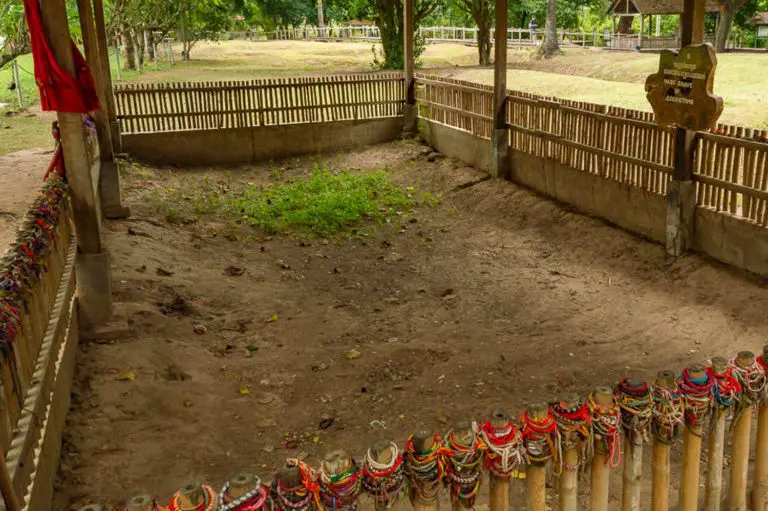
Phnom Penh and the surrounding area are home to S-21, a political prison used by the regime, and Choeung Ek, the largest of the Killing Fields. Over 12,000 prisoners were held at S-21 during the regime and with only seven known survivors, it’s a place known for unthinkable torture and suffering. The S-21 site now houses the Tuol Sleng Genocide Museum where you can learn more about the Cambodian massacre.
Much like S-21, a tour of the Cambodian Killing Fields can be hard to digest. There is a memorial stupa filled with the skulls of victims and you can still see bone fragments and strips of clothing along the paths. It’s a horrifying place but important to visit to ensure history doesn’t repeat itself.
Contributed by Ben at Horizon Unknown . Follow him on Facebook !
11. Abandoned Ghost Palace – Bali, Indonesia
Located near the village of Bedugul lies an abandoned hotel. Legend has it that in the early 1990s, the hotel began to be constructed by Tommy Suharto, the youngest son of the former Indonesian President. Tommy was later convicted of ordering the assassination of a judge who previously found him guilty of corruption and he subsequently went to prison. The hotel was never completed.
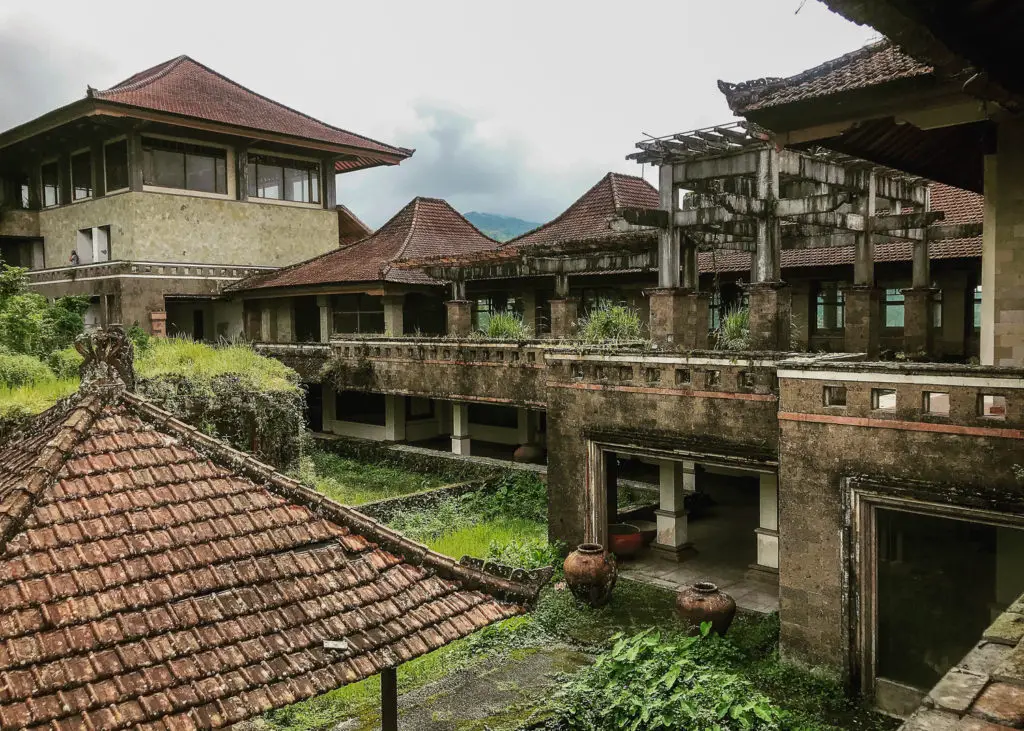
Another theory is that the hotel is haunted by the landlocked souls of labourers who were worked to death during its construction. The hotel, originally named Hotel Pondok Indah Bedugul, isn’t open for visitors but if you hand the guard 10,000 IDR, he’ll let you in to explore. I recommend seeing it as soon as possible because rumours indicate that visitors will no longer be permitted entrance (even with a bribe) because of how dangerous it is.
Contributed by Nat Wanderlust.
12. Auschwitz-Birkenau – Oświęcim, Poland
The “Final Solution to the Jewish Question” was the official code name for the murder of Jews during World War II. At least 1.3 million people were sent to Auschwitz by the Nazis and a shocking 1.1 million people were murdered by the SS, mainly in gas chambers.
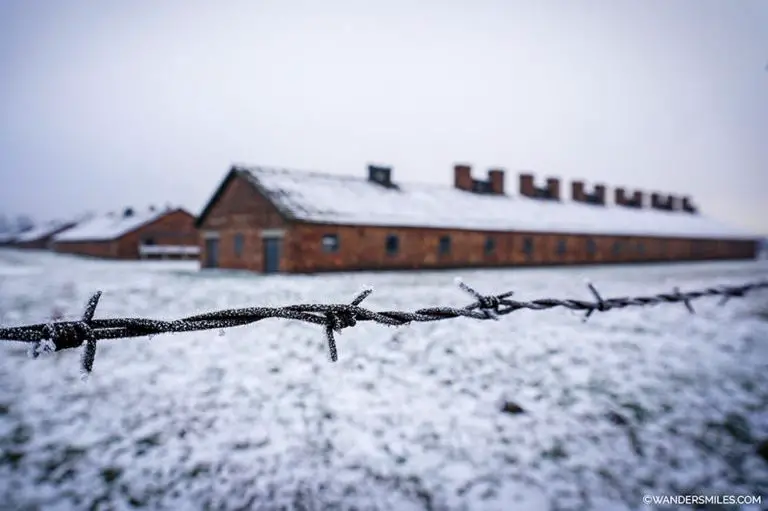
Auschwitz-Birkenau is located on two different sites. Auschwitz I comprises brick buildings and the Death Block where people were gassed. Auschwitz II, known as Birkenau, was opened as they could not cope with the scale of death at Auschwitz I.
On arrival, you’ll see the famous train tracks where people were transported in and either sent to the gas chambers or given labour duty. Once the latter were emaciated, they were gassed and replaced with new prisoners.
I cried in horror seeing the piles of shoes, suitcases and false legs that once belonged to people. Human hair was used to make felt for socks given to the forces in submarines – 293 sacks of hair were found on liberation. Words cannot describe the emotions you’ll have upon seeing this symbol of this horrific dark chapter in our history.
Contributed by Vanessa from Wanders Miles, follow her on Instagram !
13. Day of the Dead – Oaxaca, Mexico
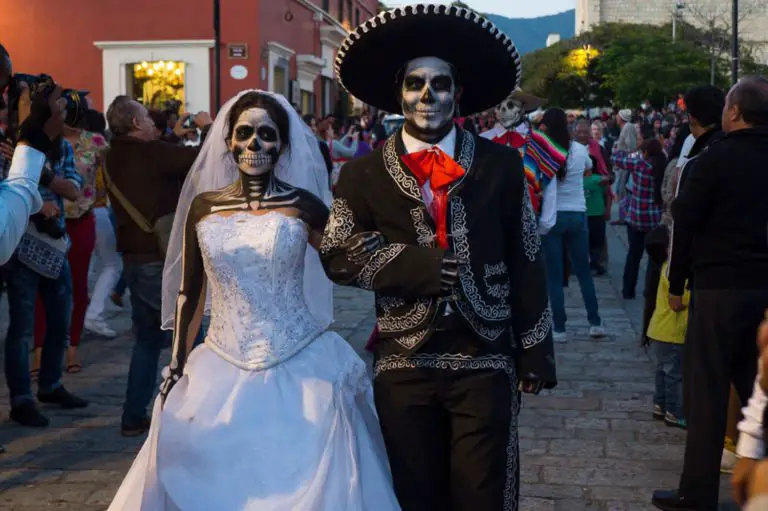
The Mexican Day of the Dead festival is a darkly uplifting event that occurs each year between October 31st and November 2nd. On these days, family and friends celebrate the lives of loved ones passed. It is widely believed that for three days each year, the veil between this world and the next is especially thin.
During the Day of the Dead festival, the spirits of the departed return to provide counsel to their living family members and friends. Much of the reunion is celebrated within the cemetery, where graves are cleaned and decorated for the occasion. On certain dates, families spend the whole night in the cemetery eating sugar skull sweets, drinking alcohol and playing music.
UNESCO recognises ‘Dia de Los Muertos’ as being ‘ Intangible Cultural Heritage of Humanity ’. Experiencing the Day of the Dead is a once-in-a-lifetime opportunity; especially in Oaxaca where visiting graves is commonplace. Prepare for everything you have ever thought about death to be challenged.
Contributed by Castaway With Crystal. Follow her on Instagram!
14. Red Terror Martyrs’ Museum – Addis Ababa, Ethiopia
The military junta who took power after Ethiopia’s Emperor Haile Selassie was ousted were known as the Derg. After prolonged internal wranglings, Mengistu, a soldier from the ranks, emerged as their leader and the dictator of Ethiopia.
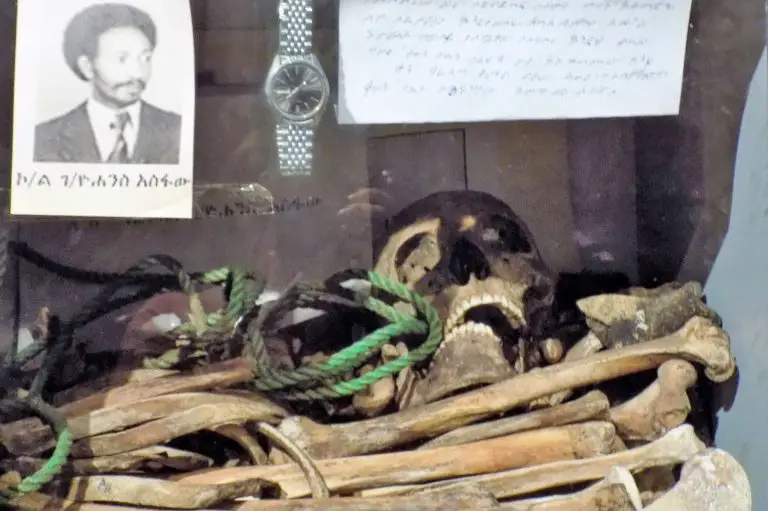
Within a couple of years, the Derg had created terror among ordinary Ethiopians, tens of thousands of whom had been imprisoned without trial and tortured, or worse, executed. The term ‘Red Terror’ comes from Mengistu’s famous speech when he smashed a bottle of blood to illustrate the killings to come. His regime is estimated to be responsible for the deaths of between 1.2 and 2 million Ethiopians.
Today, the horrors of Mengistu’s regime are remembered in the Red Terror Martyrs’ Museum in Addis Ababa . Opened in 2010, this small museum teaches about the atrocities of the regime. Photos of victims cover the walls alongside displays of human remains recovered from mass graves. We came away from the Martyrs’ Museum appalled by man’s inhumanity to man.
Contributed by Andrea of Happy Days Travel Blog. Follow her on Facebook !
15. Constitution Hill – Johannesburg, South Africa
Constitution Hill is now a living museum which tells the story of South Africa’s journey to democracy. It’s hard to comprehend that people like Nelson Mandela and Mahatma Gandhi served time here in the 1960s and that the prison was still operational until 1982.
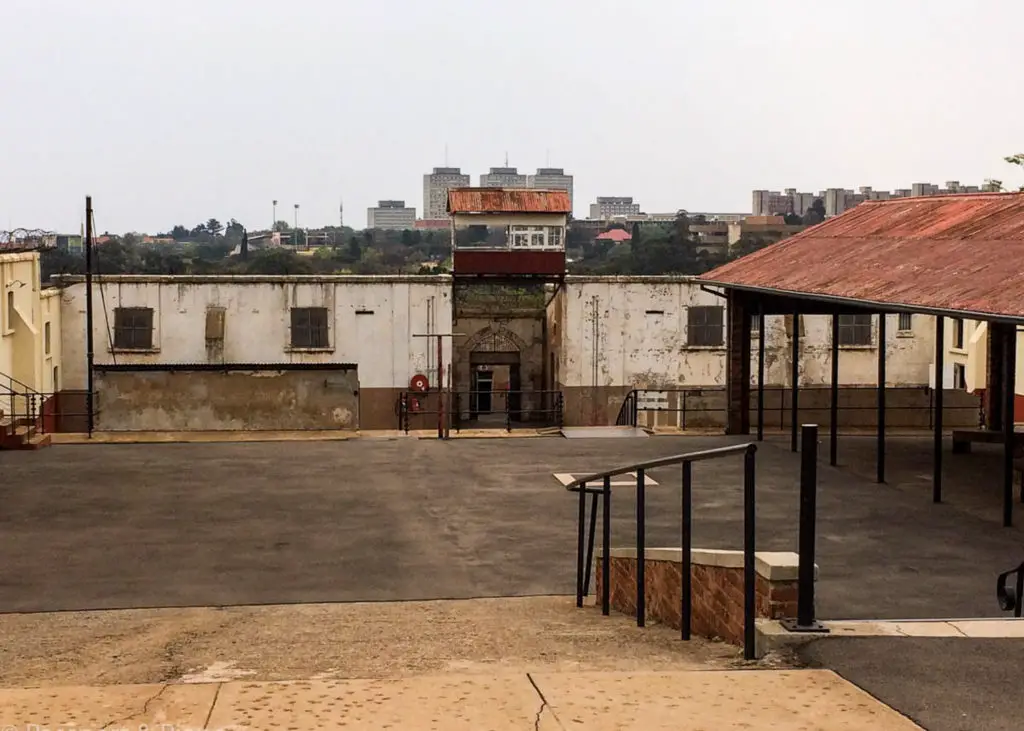
There are several sites that you can visit at Constitution Hill. The Old Fort is where white male prisoners were housed. Although the cells were overcrowded and unhygienic, the rooms are larger than those of the black prisoners. They were held in Block number 4. There was very little daylight and as I stepped inside, I was terrified that someone would shut the cell door behind me.
There’s also the Awaiting Trial Block. The block was demolished and the bricks were used to build South Africa’s new Constitutional Court. Thankfully this court serves to uphold the rights of all South Africans, regardless of colour, but the bricks are a poignant reminder of its troubled past.
Contributed by Fiona of Passport and Piano . Follow her on Facebook !
16. Shanghai Tunnels – Portland, USA
In a city known for the slogan ‘ Keep Portland Weird ,’ the Shanghai Tunnels fit right in. It’s believed that from 1850 until 1941, men in Portland, Oregon, were regularly kidnapped and sold to ship captains as labourers. During this period, there was a shortage of labour available for the city’s booming shipping industry and this created a black market.
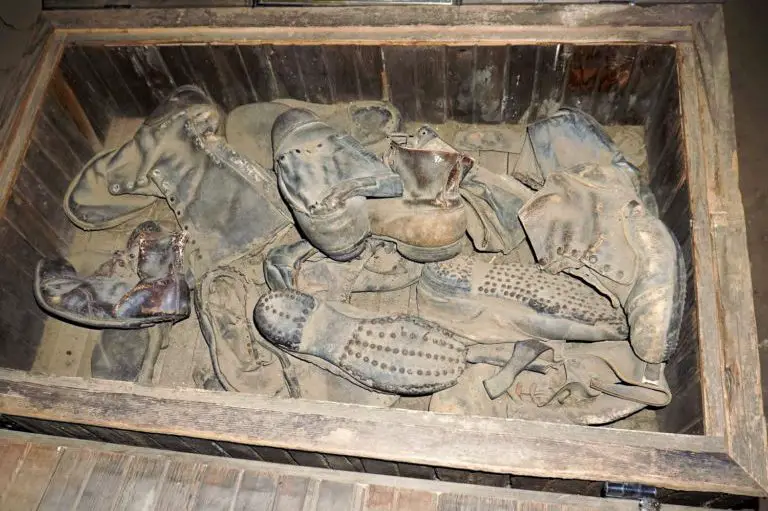
To capture these men, underground tunnels originally built to move inventory between businesses were repurposed for illicit use. Trapdoors were even installed in some of the local bars so that drunk men would drop into the tunnel below.
Today, tours of these tunnels are offered daily by a non-profit organisation, Shanghai Tunnels/Portland Underground. All tour participants are advised to be prepared for spending an hour in a confined space. While the nature of the tour is sad and tragic, it’s an important part of Portland’s history.
Contributed by Wendy of Empty Nesters Hit the Road. Follow her on Facebook !
17. Brno Ossuary – Brno, Czech Republic
Of the attractions in Brno , several of them could be classed as dark tourism attractions. The one that moved me the most, though, was the ossuary underneath the St. James Church.
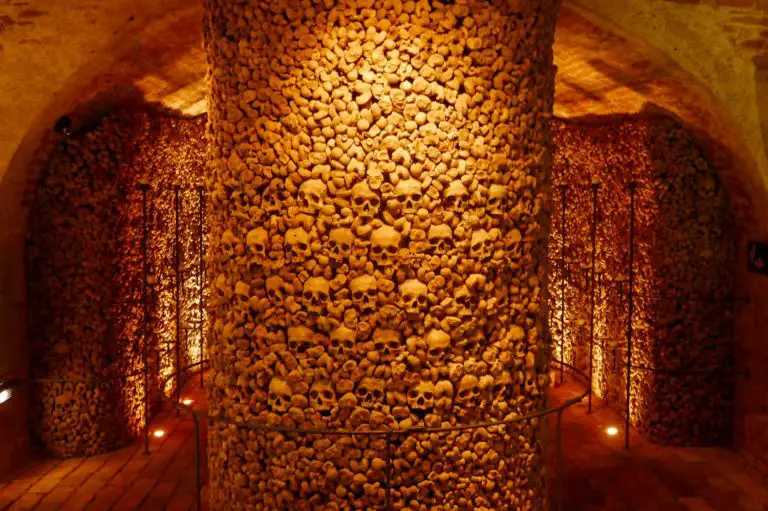
Surrounding this church, which is known as the ‘Kostnice u sv. Jakuba’ in Czech, was one of the main churchyard cemeteries in Brno. Eventually, as the city grew, there was no room left for new burials so a grave rotation system was adopted.
When a burial took place, the body was left in the grave for between 10 to 12 years. After that, the bones were taken out to make room for the next burial. The displaced remains were then relocated to the ossuary, where bones from thousands of graves were piled up.
It’s estimated that Brno Ossuary holds the bones of more than 50,000 people, which makes it the second-largest ossuary in Europe; only second to the Paris catacombs. The mortal remains laid to rest here include victims of the Swedish siege of Brno and the Thirty Years’ War, as well as many victims of plague and cholera epidemics.
Contributed by Wendy of The Nomadic Vegan. Follow her on Instagram !
Do you have any dark tourism examples to share? Let us know in the comments!
9 thoughts on “17 Must-Visit Dark Tourism Destinations Around the World”
Comuna 13 is spellt with only 1 -m-.
I wonder why choose the cemetery in Sucre, when so many others are more characteristic (eg. Père Lachaise in Paris) or even ‘livelier’ (eg. in Santiago de Chile).
Interesting & important topic though. I’m in the process of rewriting an article about the mines of Potosi. That is one dark tourism destination I strongly oppose, for one simple reason; people are still dying in there.
Thanks for the heads up Anthony! 🙂
I chose the cemetery in Sucre because it was a little bit off the beaten track – I like visiting the lesser known places as well as the more famous ones.
I can understand your point about the mines of Potosí and can see why you disagree with it. I must say though, from my own personal experience, I found my visit to be hugely enlightening. I was initially very torn about the idea of visiting an active mine but in the end, we chose a company run by an ex-miner who took us into the mine personally. In my opinion, our visit never felt voyeuristic at all and the miners seemed very grateful for the tourists visiting. A percentage of the tour cost went directly into the funding the healthcare of the miners when needed and also towards maintenance of the mine.
Such a great and informative post, Sheree! There were so many sites here that I was not even aware of – that is why sharing posts about dark tourist sites is so important! It really helps educate the world and helps us honour the past and the lives that were lost at some of these sites.
Like you, I am a huge fan of cemeteries. It is so wonderful that some countries treat death as a natural normal part of life (unlike some of our countries!). It really helps people remember happy memories of their loved ones they recently lost.
Thanks so much for being a part of it Crystal! I also learnt about loads of new dark tourism sites – it has definitely been an eduction as there was plenty of these I had never even heard of. It is definitely important to make sure the stories behind these places get told.
Thank you for including us in this fantastic collab!
I love how varied these sites are, and that you’ve included a lot of lesser know dark tourism destinations mixed in with some of the big ones. Even as professional dark tourists (that’s a thing, right?), we hadn’t heard of all of these places. The Shanghai Tunnels were completely new to me, but definitely want to head to Portland now.
I’m also a little embarrassed to admit that despite being to Hamburg MANY times, I was not aware of the St. Nicholas’ Church. I blame that on the fact that I was visiting a friend and not really touristing…
Awesome post everyone! I think it is really important for people to visit at least one of these in their lifetime. I think we are jaded from the major events that happened to our world and it’s people when we are told the stories. To see the places in real life, it puts life into perspective and how crazy life can be if we don’t fight for what is right.
I couldn’t agree more. Even though visiting these kinds of places is hard, I still think it is really important to help us realise the human effect of what we see on the television. As you said, it is only once you truly understand the devastation that you realise the importance of fighting for the right things.
Great article . I’ve been to a lot of places around the world and haven’t even heard of some of these .
Thanks Jennifer! I’ve certainly added a lot of places to my future visit list!
Leave a comment Cancel reply

10 Haunting Dark Tourism Destinations From Around the World
By tobias wartime | sep 25, 2023.
While some people go on vacation for a little rest and relaxation, others prefer to travel to destinations that are primarily associated with the morbid and the macabre.
The practice, which is known as dark tourism , involves visiting locations with a lot of notoriety because they’re largely associated with death , devastation, and unspeakable acts against humanity.
“It’s not a new phenomenon,” J. John Lennon, a professor of tourism at Glasgow Caledonian University told The Washington Post in 2019. “There’s evidence that dark tourism goes back to the Battle of Waterloo where people watched from their carriages [as] the battle [took] place.” Lennon and his colleague Malcolm Foley are credited with coining the term dark tourism in 1996, and together they wrote the book Dark Tourism: The Attraction to Death and Disaster .
In recent years, foot traffic to Civil War battlefields and places like Auschwitz have even been on the rise, perhaps because tourists want to better understand some of history’s most tragic chapters. Below are some of the most well-known dark tourism destinations from around the world.
1. The Ruins of Pompeii // Pompeii, Italy
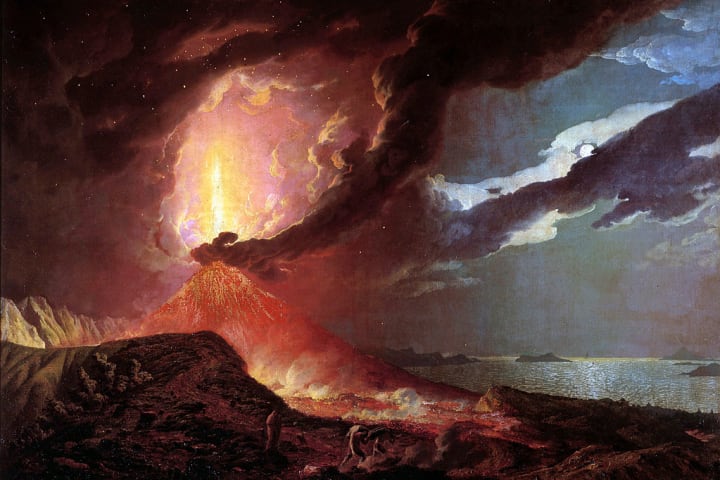
In the fall of 79 CE, Mount Vesuvius erupted with the force of 100,000 atom bombs, releasing toxic gas, ash, and other volcanic debris into the air. It subsequently wiped out the nearby cities of Herculaneum and Pompeii . Nearly 2000 years later, the ruins of Pompeii , as part of Vesuvius National Park, have become one of Italy’s most frequented tourist attractions, in large part due to the volcanic ash deposits that completely coated and preserved the ancient city.
There are a number of guided tours and excursions that take tourists to historical sites around the ruins that are still frozen in time, such as Pompeii Archaeological Park, The Forum, Teatro Grande, and more.
2. Auschwitz-Birkenau State Museum // Oświęcim, Poland
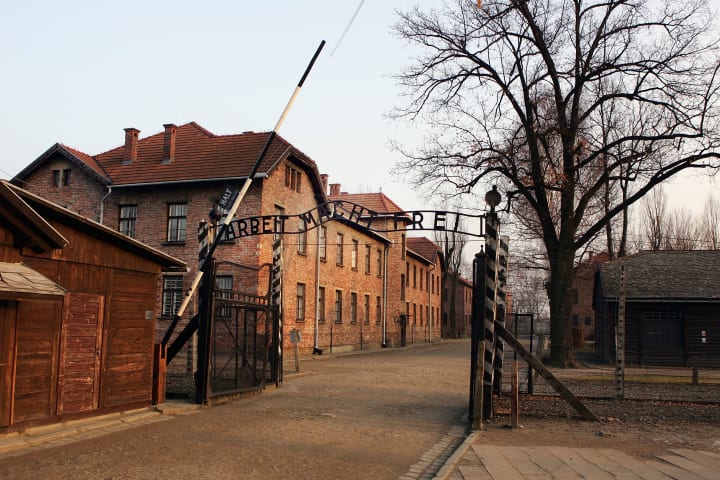
One of the most harrowing places on the planet to visit is the Auschwitz-Birkenau State Museum , which opened in 1947 in Oświęcim, Poland. Auschwitz was the largest Nazi concentration camp during World War II (an estimated 1.3 million people were sent there before 1945); it was also the site of a mass genocide where more than 1.1 million people—including over 960,000 Jewish people—were murdered or died due to illnesses like typhus , tuberculosis, and dysentery. Poor sanitary conditions also led to issues like scabies, and many prisoners suffered from boils, rashes, and abscesses that were largely caused by vitamin deficiencies.
Today, Auschwitz is a memorial and museum that’s dedicated to history, education, and remembrance of the atrocities inflicted on fellow humans.
3. National September 11 Memorial & Museum // New York City, New York

Ever since the terrorist attacks that destroyed the World Trade Center on September 11, 2001, people from around the world have flocked to New York City’s Financial District to pay their respects to the nearly 3000 lives lost at Ground Zero.
In fact, according to a 2022 survey by Passport Photo Online, Ground Zero is one of the most popular dark tourism destinations in the world. The National September 11 Memorial and Museum , which opened in 2014, features twin reflecting pools containing the largest man-made waterfalls in North America where the Twin Towers once stood. The names of every victim are engraved in bronze panels surrounding each acre-sized pools. The museum itself has artifacts on display, personal stories , special exhibitions, and more. There are also exhibits focused the World Trade Center bombing that happened on February 26, 1993.
4. The Killing Fields of Choeung Ek // Phnom Penh, Cambodia
From 1974 to 1979, the Khmer Rouge regime murdered more than 1 million political prisoners in Cambodia (about one-fourth of the country’s total population), burying the bodies in mass graves known as “killing fields.” The largest of the killing fields was Choeung Ek, located on the outskirts of Phnom Penh. The site was an orchard and Chinese cemetery before the Khmer Rouge used it for widespread massacres.
In 1980, after the regime was overthrown, the remains of nearly 9000 people were exhumed from the mass graves surrounding Choeung Ek (although some graves were left untouched ). Roughly 8000 skulls that were taken from those graves are now on display behind glass panels at the Choeung Ek memorial stupa, a Buddhist-style structure which was erected in 1988 to remember the victims who were lost.
In 2019, more than 250,000 visitors—a mix of international travelers and Cambodians— explored the site ; prior to the COVID-19 epidemic, approximately 300 to 600 guests visited daily. Attendance rates sharply declined after 2020 because it was closed, but in 2022, more than 45,000 foreign guests and over 21,000 Cambodians visited. In addition, the Choeung Ek Genocidal Center is a focal point every year during Cambodia’s National Day of Remembrance, which is observed on May 20.
5. Hiroshima Peace Memorial Museum // Hiroshima, Japan
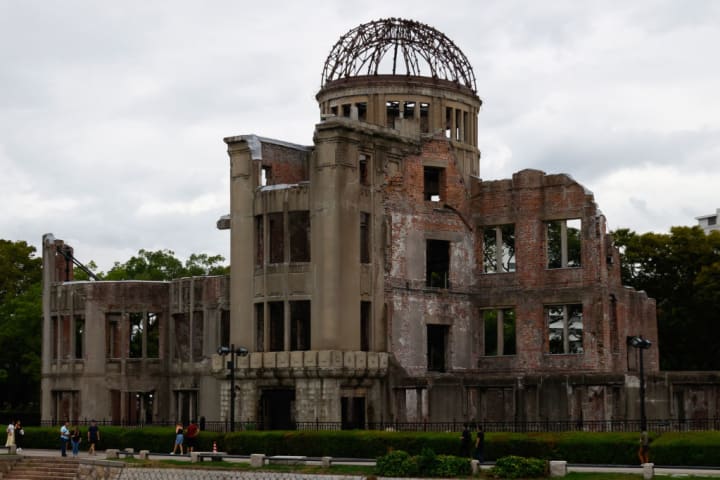
Since it opened in August 1955, the Hiroshima Peace Memorial Museum in Hiroshima, Japan, has been dedicated to preserving stories, photos, and other artifacts that convey the unimaginable terror and loss of life that the city endured after being on the receiving end of the world’s first atomic bomb strike on August 6, 1945. (The U.S., in case you missed it in your history classes, was responsible for dropping the bomb .)
The museum reportedly gets around 1 million visitors every year and is a very popular choice for school field trips within the country. Inside you’ll find victim testimonials and exhibits depicting the horrors of war and the destructive nature of nuclear weapons. As the museum explains , “Each of the items displayed embodies the grief, anger, or pain of real people. Having now recovered from the A-bomb calamity, Hiroshima’s deepest wish is the elimination of all nuclear weapons and the realization of a genuinely peaceful international community.”
6. Murambi Genocide Memorial Centre // Murambi, Rwanda
Formerly a technical college, the Murambi Genocide Memorial Centre in southern Rwanda is one of the grimmest places for dark tourism. While the destination itself is picturesque (complete with rolling countryside hills and other scenic views), it was also the site of a brutal 1994 massacre which claimed approximately 50,000 lives during the Rwandan Civil War.
Approximately 65,000 refugees from the Tutsi minority community had fled to the technical college after being told by authorities that they would be safe there . Instead, they were confined without food or water, and subsequently massacred by a government-backed Hutu militia. Only 34 people are believed to have survived the carnage that ensued.
Throughout the 100-day period now known as the Rwandan genocide , Hutu militias collectively murdered upwards of 800,000 civilians, many of whom were Tutsis. The Murambi Genocide Memorial Centre, which opened in April 1995, is now one of six National Genocide Memorial Sites within the country. More than 800 mummified corpses and preserved skeletons are on display in Murambi, to serve as a reminder of the horrific darkness and gruesomeness of the genocide, and to honor those who were victimized.
7. The Catacombs of Paris // Paris, France
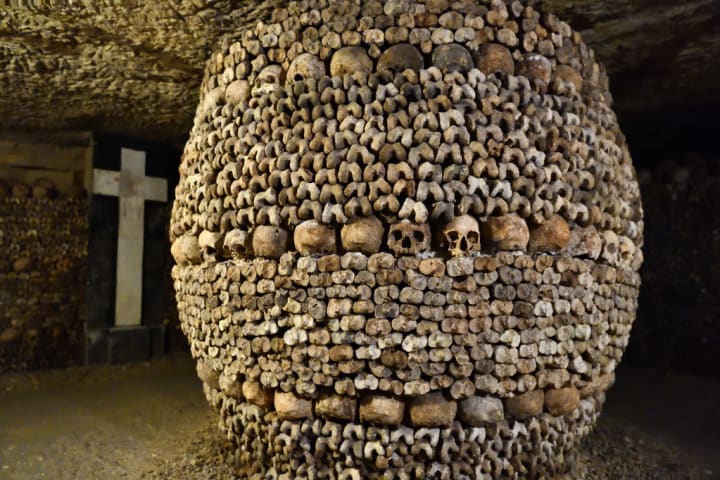
During the 18th century, Paris had a big public health problem on its hands: Local cemeteries were overcrowded and improper disposal of corpses was fueling the spread of disease. In response, the city decided to convert its subterranean Lutetian limestone quarries into sprawling underground ossuaries.
Located about 65 feet below the City of Light’s streets, the Les Catacombes de Paris (a.k.a. the Catacombs of Paris ) house the remains of more than 6 million late Parisians. Today, visitors can take guided tours and learn about its unique history, all while viewing the millions of human skulls and bones that line the walls of the cavernous space.
8. Alcatraz Federal Penitentiary // Alcatraz Island in San Francisco Bay, California
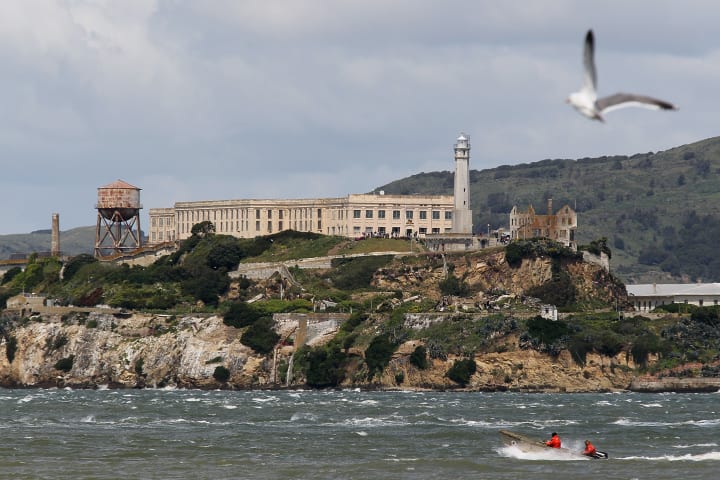
It might come as a surprise, but one of San Francisco ’s most popular tourist attractions is technically located in San Francisco Bay, on Alcatraz Island. Better known to some as “The Rock,” Alcatraz Federal Penitentiary was a former maximum-security federal prison that closed down in 1963. But before it did, it hosted some pretty infamous inmates , including Al Capone , George “Machine Gun” Kelly, James “Whitey” Bulger, and others.
Over the decades, Alcatraz has been immortalized in pop culture through music and movies. It’s also considered a U.S. National Park now and has over 1.5 million visitors annually. Tourists can take guided walks around the main cell-house, dining hall, lighthouse, and other locations around the grounds.
9. Cape Coast Castle // Cape Coast, Ghana
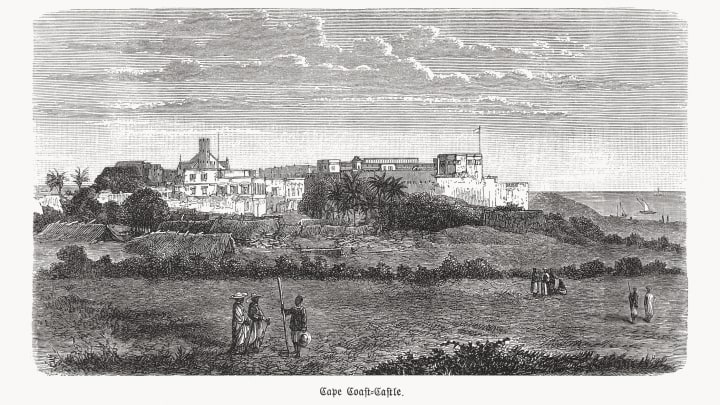
Originally built for the Swedish Africa Company in 1653 for the purposes of trading gold and timber, Ghana’s Cape Coast Castle later became an integral part of the Atlantic slave trade. Famously, one of the doors at the slave-trade outpost was known as the “ Door of no Return .” Many believe that captive Africans were led through it to ships that were about to embark on the Middle Passage , and were never seen or heard from again. (However, some have recently speculated that the door may not have been linked to the slave trade at all, and may have actually been used as a way to dispose of waste by tossing it into the sea.)
During the ‘70s, Cape Coast Castle was converted into a museum and monument, and the United Nations Educational, Scientific, and Cultural Organization (UNESCO) later named it a World Heritage Site for preservation and protection, as a “cultural and natural heritage around the world considered to be of outstanding value to humanity.” Over the years, it has become a major tourist attraction for some Black Americans (including former President Barack Obama ) looking to reconnect with their roots.
10. Chernobyl // Pripyat, Ukraine
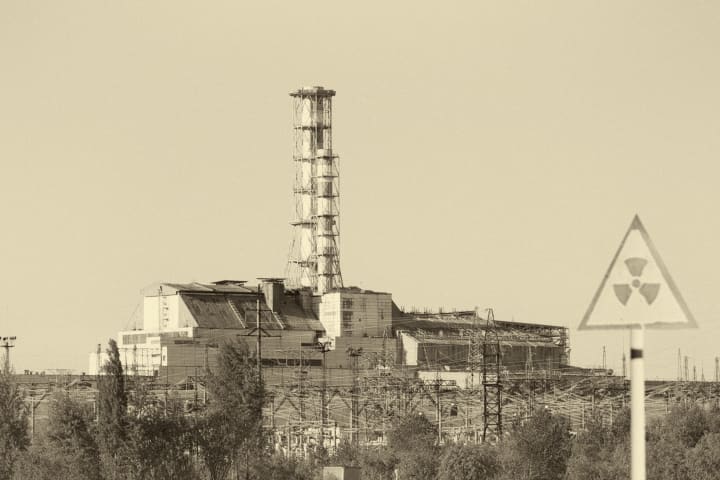
On April 26, 1986, nuclear reactor number four at the Chernobyl Nuclear Power Plant in Pripyat, Ukraine exploded, leaving the area uninhabitable and in ruins. Although it’s currently unsafe to visit due to the ongoing Russo-Ukrainian War, the site of the world’s worst nuclear disaster has been a favored destination for dark tourism since 2011 , when the Chernobyl Exclusion Zone opened up for visits.
Pripyat has since become a ghost town with abandoned schools, hospitals, apartment buildings, and more; there’s also a deserted amusement park with a Ferris wheel and bumper cars. Scientists believe it could take up to 20,000 years for the land to fully recover from the radioactive damage. However, there have been very strict short-term guided tours allowed in the past throughout the exclusion zone. There are a number of very strict safeguards —like wearing restrictive clothing and using a Geiger counter—to prevent radiation poisoning. In 2019, an estimated 200,000 tourists visited the site.

30 Dark Tourism Destinations and How to Visit
By: Author Zachary Friedman
Posted on Last updated: March 1, 2024
Categories Travel Destinations
Home » Travel » Travel Destinations » 30 Dark Tourism Destinations and How to Visit
Many of us have a natural morbid curiosity. Death, disasters, atrocities, and destruction fascinate us. Every year, millions of people travel to some of the darkest and most tragic sites on earth to satisfy that curiosity as well as to gain a deeper understanding of the events that took place there. This is called dark tourism. In this guide, we’ll outline some of the most popular dark tourism destinations and explain how to visit them. We’ll also explain exactly what dark tourism is and talk a bit about the ethics, controversies, and motivations of dark tourism.
Personally, I’m a big fan of dark tourism. Over the years, I’ve visited many of the dark tourism sites on this list. In this guide, I’ll share my experience.

Table of Contents
- Auschwitz-Birkenau Memorial, Poland
- Chernobyl Nuclear Disaster Site, Ukraine
- Choeung Ek Killing Fields and S-21, Cambodia
- September 11 Memorial and Museum, New York
- Hiroshima Peace Memorial Park and Museum, Japan
- Kigali Genocide Memorial, Rwanda
- Pompeii, Italy
- Slave Castles, Ghana
- Sedlec Ossuary, Czech Republic
- Alcatraz Island, San Francisco
- Suicide Forest (Aokigahar), Japan
- Fukushima, Japan
- Robben Island, South Africa
- Pearl Harbor, Hawaii
- The Colosseum, Rome
- Mount St. Helens, Washington
- Anne Frank House and Museum, Amsterdam
- Various Nuclear Test Sites
- The Catacombs of Paris
- Warsaw Ghetto, Poland
- Perm-36 Gulag, Russia
- Cremations on the Ganges River in Varanasi, India
- WWII memorials and museums in Berlin, Germany
- Communist Leader Mausoleums
- Somme Battlefield, France
- Verdun Battlefield, France
- D-Day Beaches and Memorials in Normandy
- Antietam National Battlefield, Sharpsburg, Maryland
- Cu Chi Tunnels, Vietnam
What is Dark Tourism?
Dark tourism is a relatively new term for a form of tourism that involves travel to a site where death, tragedy, disaster, violence, atrocity, or suffering took place. This could include sites of genocide, assassination, natural disaster, war, terrorism, man-made disaster, etc. Usually, dark tourism sites have some kind of historical significance. They could also be the site of a recent or ongoing tragic event. Dark tourism is also called black tourism, morbid tourism, and grief tourism.
A few of the most well-known and popular dark tourism sites in the world include the ruins of Pompeii, Auschwitz concentration camp, the site of the Chornobyl nuclear disaster, the Paris Catacombs, Gettysburg, Ground Zero, and the 9/11 memorial in New York. In each of these sites, death, suffering, tragedy, or disaster took place.
Most people visit dark tourism sites for educational purposes. These sites usually have interesting histories. Some people visit because these sites pique a morbid curiosity. Others just want to witness large scale destruction and damage. Everyone has their own motivation.
There are different types of dark tourism as well. For example, dark tourism and heritage tourism are sometimes closely related. For example, someone may choose to visit Holocaust sites to learn about the events that their ancestors experienced. Descendants of slaves may choose to visit slavery heritage sites. Some consider this a form of dark tourism as well.
To consider someone a dark tourist, they must visit the site for dark tourism purposes. Some sites have a dark element but aren’t exclusively visited for dark tourism purposes. For example, if you visit Mount St. Helens to go for a hike, you’re not a dark tourist. If you visit to learn about the volcanic eruption and the damage it caused, you are a dark tourist.
Dark Tourism Destinations
1. auschwitz-birkenau memorial and museum, poland.

Located outside of Krakow, Poland, Auschwitz was the largest and most deadly of the Nazi concentration camps. Between 1.1 and 1.6 million men, women, and children were murdered here during the Holocaust. Auschwitz is one of the largest mass murder sites in the world.
Today, the site symbolizes genocide and the evil acts that humans inflict upon one another. It also acts as a valuable education tool to help prevent atrocities such as the Holocaust from happening again.
Auschwitz is actually a series of 40 concentration camps rather than one large camp. Auschwitz I is the older and smaller camp where political prisoners were held. Here, you’ll see a terrifying exhibition of some of the inmates’ possessions including piles of suitcases, shoes, and human hair.
Auschwitz-Birkenau, which is located a couple of miles down the road, is a much larger concentration camp and extermination camp. Here, you’ll find the ruins of the infamous gas chambers, barracks with wooden shelves where prisoners slept, and the train track which was used to haul thousands of people into the camp.
Auschwitz has become a mass tourist site seeing over 2 million visitors per year and over 60 million visitors since the site opened in 1947. This is probably the world’s biggest and most well known dark tourism site. The Auschwitz Memorial is free to enter but you should book in advance. Only a limited number of tickets are available per day because the site is so popular.
2. Chernobyl Nuclear Disaster Site, Ukraine

On April 26, 1986, the world’s worst nuclear meltdown took place at the Chernobyl nuclear power plant near Pripyat, Ukraine. This disaster caused the death of around 4,000 individuals from radiation-related illness as well as the displacement of over 300,000.
The area is still not safe for people to inhabit, even though some have moved back into their villages anyway. In fact, scientists believe it could take 20,000 years before the exclusion zone is completely safe. The radiation has dissipated enough for tourists to make short visits on guided tours.
Several tour companies offer day trips and multi-day trips to Chernobyl from the nearby city of Kyiv. During the tour, you’ll see the radiation-contaminated Red Forrest and eerie abandoned buildings including the famous Pripyat Amusement Park and a Kindergarten. You’ll also learn about the impact the disaster had on the region.
Keep in mind that there is still a risk of radiation poisoning when visiting the Chernobyl exclusion zone. Radiation levels are still hazardous in much of the zone. Your guide will explain the safety precautions you must take and guide you through the areas that are safe enough to visit.
Chernobyl is one of the world’s most famous and popular dark tourism sites. The recent HBO miniseries, Chernobyl, greatly increased the popularity of the area. Following the release of the show, tourism increased by 30%.
Note: Currently, it’s not possible to visit this site. Hopefully, it will be possible to visit again in the near future.
3. Choeung Ek Killing Fields and Tuol Sleng Genocide Museum (S-21), Cambodia
The Khmer Rouge regime came into power after the Cambodian civil war ended in 1975. The new government was called the Communist Party of Kampuchea. Their leader was prime minister Pol Pot.
Immediately following the end of the war, the Cambodian genocide began. From 1975 to 1979, between 1.7 and 2.5 million people were killed at 300 sites throughout the country. These sites are known as killing fields.
The most famous of these killing fields is Choeung Ek, which is located about 11 miles outside of Phnom Penh, the capital of Cambodia. It is estimated that around 17,000 men, women, and children were killed at this site. Many were killed violently with knives, scythes, bats, and bayonets. This is the main memorial for the Cambodian genocide.
At this site, you’ll see a memorial Buddhist stupa made of glass. Inside the stupa, there are 5,000 human skulls. Many of the displayed skulls are catastrophically damaged, showing the brutal manner in which the victims were killed. The site also includes a mass grave that contains the remains of almost 9,000 people that were exhumed from the surrounding area. Human bones still litter the entire site. Occasionally fragments wash up after heavy rain.
Another famous Cambodian Genocide site is the Tuol Sleng Genocide Museum or S-21. This museum is located in Phnom Penh. Originally, this site was built as a secondary school but was converted into a prison by the Khmer Rouge. Around 20,000 people were imprisoned here during Pol Pot’s reign. Many were tortured and killed. Here, you’ll see prison cells, photos of victims, as well as an exhibit that documents the events of the Cambodian genocide.
4. National September 11 Memorial and Museum, New York

This New York City memorial and museum was built to commemorate and honor the 2,977 people who died in the September 11, 2001 terror attacks as well as the six people who died in the 1993 World Trade Center bombings. The memorial sits on the site where the twin towers once stood.
The main memorial, called Reflecting Absence, consists of two 1-acre pools that occupy the exact footprints where the Twin Towers stood. Each pool features a large waterfall. Bronze parapets with the name of each victim etched in surround the pools. The September 11 Museum, located underground, contains thousands of images, artifacts, recordings, and videos. The exhibit tells the complete story of the events of 9/11.
This site is fairly controversial. Partly for the high price of entry ($24) but mostly for the fact that the remains of over 1000 victims were placed in a tomb in the bedrock under the museum. Many people find this disrespectful. Even so, the 9/11 Memorial is one of the world’s most popular dark tourism sites. Over 6 million people visit this memorial per year.
5. Hiroshima Peace Memorial Park and Museum
This memorial and museum commemorate and honor the city of Hiroshima and the 140,000 people who died when the United States dropped an atomic bomb on the city on August 6, 1945. It also memorializes the world’s first nuclear attack. The aim is to educate people about the danger of nuclear weapons as well as to promote peace.
The atom bomb, codenamed “Little Boy,” detonated 600 meters above the busiest part of downtown Hiroshima. The explosion essentially leveled the area except for a few ruins. This event marked the beginning of the end of WWII. Japan surrendered on August 15, 1945. The park was built on the site of the bombing. Today, the Hiroshima Peace Memorial Park contains a number of monuments as well as a museum and a lecture hall.
Hiroshima Peace Memorial Museum is the main feature of the park. The museum educates visitors about the events leading up to the bombing as well as the catastrophic effect the bomb had on the city. You’ll see photos and artifacts from the bombing. A major section of the museum is dedicated to the stories of the victims and survivors.
The A-Bomb Dome is the second most important site in the park. This is the ruins of the Hiroshima Prefectural Industrial Promotion Hall. Today, it’s just a shell of a building. This building is significant because it is one of the only buildings that survived the blast. Most structures in Hiroshima were built from wood and burned up in fires that the bomb started. This building was also just 150 meters from the hypocenter of the blast. It has been designated a UNESCO World Heritage Site.
A few more significant points of interest in Hiroshima Peace Memorial Park include Children’s Peace Monument, Peace Flame, Peace Bells, Peace Pagoda, Gates of Peace, and Atomic Bomb Memorial Mount. You could easily spend half a day wandering around the park viewing the various monuments and memorials.
3 days after the bombing of Hiroshima on August 9, 1945, The United States bombed the city of Nagasaki in a second nuclear attack. Today, you’ll find a number of memorials and museums including the Atomic Bomb Museum, Peace Park, Oka Masaharu Memorial Peace Museum, and more.
6. Rwanda Genocide Sites (Kigali Genocide Memorial and Murambi Genocide Memorial)
In 1990, a rebel group of Tutsi refugees called the Rwanda Patriotic Front (RPF) invaded Rwanda from Uganda. This started the Rwandan Civil War. President Juvénal Habyarimana signed peace accords in 1993. The following day, the president was assassinated. Genocidal killings of Tutsi people began soon after and the civil war resumed.
The Rwandan genocide lasted from April 7 to July 15, 1994. During that time 500,000-1,000,000 people were killed. This includes about 70% of Rwanda’s Tutsi population. The genocide ended when the RPF captured Kigali and gained control of the country. The government and genocidaires were forced into Zaire (now the Democratic Republic of the Congo).
Today, there are a number of genocide memorials located throughout the country. The largest and most visited is the Kigali Genocide Memorial Centre. The remains of an astonishing 250,000 people are interred at this site. The attached museum includes three exhibits. The first documents the events of genocide from start to finish. The second exhibit is a memorial to the children who died. It includes photos and details about their lives, things they liked, and the way they died. The third exhibit covers genocide around the world.
The Murambi Genocide Memorial (Murambi Technical School), located in southern Rwanda is one of the darkest dark tourism destinations on the planet. Here, around 50,000 Tutsi men, women, and children were murdered by Hutu Interahamwe militiamen in April of 1994.
The Tutsis were told that they could safely shelter at the school and that the French military would protect them. This turned out to be a trap. After being starved for several days to weaken them, they were attacked and killed. Only 34 people survived the attack and escaped. At Murambi, the remains of 800 people are displayed partially decomposed and preserved by lime.
7. Pompeii, Italy

This ancient Roman city was wiped out when nearby Mount Vesuvius erupted in 79 AD. Historians estimate that about 2,000 people died in the disaster. The thick layer of ash and pumice that covered the city preserved this little slice of ancient Rome.
At the ruins, you can see beautifully preserved artwork, pottery, casts of people who died, houses, an amphitheater, and more. Pompeii is a UNESCO World Heritage site and is one of Italy’s most popular tourist destinations with over 2.5 million visitors per year.
Some people question whether or not Pompeii is actually a dark tourism site due to the age of the site. After all, the eruption occurred nearly 2000 years ago. In my opinion, Pompeii is absolutely a dark tourism site due to the large scale death and destruction that happened here. The age of the site is irrelevant.
8. Slave Castles, Ghana (Cape Coast Castle and Elmina Castle)
During the colonial period of West Africa, the British, Dutch, and Portuguese built around 40 castles or forts along the Gold Coast. The Europeans originally used these castles as trading posts for timber or gold.
During that time, African slaves were in high demand in the Americas. The European traders quickly found that the slave trade was more profitable.
They modified their forts to hold as many slaves as possible. Usually in an underground dungeon. African slavers would capture slaves inland then sell them to the Europeans who lived in the castles on the coast. The slaves stayed in the castles until they were shipped across the Atlantic to the Americas.
Living conditions for the slaves were horrible. Slavers shackled and packed the slaves into the castle’s dungeons. There was very little light or ventilation. There was no water or sanitation so the floors were covered in waste. Many became ill. The slaves lived in these conditions for up to three months before being shipped across the Atlantic.
Today, dark tourists visit these castles to learn about the horrors of the slave trade. Two of the most significant castles to visit include Elmina Castle and Cape Coast Castle. Both are located in Ghana. Guided tours are available.
Elmina Castle was the first European trading post and is the oldest European building in Sub Saharan Africa. The Portuguese built the castle in 1482. Today, it is a UNESCO World Heritage Site. Here, you can see the famous ‘Door of No Return’ where slaves exited the castle before boarding ships to Brazil and other Portuguese colonies. You’ll also see the dungeon where the slaves were held as well as the living quarters for the European slavers, who lived on the upper floors of the castle.
Cape Coast Castle was built by Swedish traders in 1653. Over the years, the castle changed hands multiple times until it came into British possession. Here, you can see the dungeons where slaves were held and cannons that were used to defend the fort. In 2009, President Obama visited Cape Coast Castle during his visit to Ghana.
9. Sedlec Ossuary, Czech Republic
This small Roman Catholic chapel is located in a cemetery in a suburb of the city of Kutná Hora in the Czech Republic. Here, you’ll find the remains of 40,000-70,000 people. Initially, the remains were moved from the cemetery into the basement of the chapel to solve an overcrowding problem that was caused by the plague in the 14th century.
In 1870, a local artist named František Rint rearranged the piles of bones into artwork. The most impressive piece is a massive chandelier in the center of the chapel that is made entirely from human bones. Supposedly it contains at least one of every bone in the human body.
Another interesting piece is a large coat of arms made from bones. In the corners of the chapel, you’ll find large stacks of bones. There are cabinets filled with damaged skulls of those who were killed violently in war. The artist also signed his name in bones.
You can visit Selded Ossuary as a day trip from Prague. It’s easy to visit independently by train. Organized tours are available as well. The chapel is pretty small. It only takes 20 minutes or so to see the whole thing. The place gets pretty crowded as it receives over 200,000 visitors per year.
10. Alcatraz Federal Penitentiary, San Francisco

Also known as The Rock, Alcatraz Federal Penitentiary was a maximum-security prison from 1934-1963. It is located on an island in the San Francisco Bay, 1.25 miles offshore. During the 29 years that the prison operated, some of the hardest criminals of the day served time here including the infamous Al Capone, Machine Gun Kelly, Henri Young, and ‘the Birdman of Alcatraz’, Robert Stroud.
For punishment, prisoners were sent to solitary confinement, known as ‘the hole’ at Alcatraz. These inmates got one shower and one hour of exercise per week. Almost equally punishing for some, the prison sits close enough to the mainland that prisoners could see people going about their lives on the outside.
Today, Alcatraz is San Francisco’s most popular tourist attraction with up to 1.5 million visitors per year. The National Park Service manages the island. After arriving at the island by boat, you can take a tour of the prison. You’ll see the prison cells, learn about the dark history of the island, and hear stories of former inmates. Much of the prison remains the way it was while the prison was in operation.
11. Suicide Forest (Aokigahar), Japan
This forest, located to the Northwest of Mount Fuji, is famous for being one of the most popular suicide site in Japan. In 2003, a record was made when 105 bodies were found in the forest. In 2010, over 200 people attempted suicide here with 54 of those being successful.
The most common methods of suicide used are hanging and drug overdose. Because the suicide rate is so high here, Japanese officials installed a sign at the entry to the park which urges suicidal people to seek help.
Part of the reason for the popularity of this forest as a suicide site is that the area has long been associated with death in Japanese culture. The forest is said to be haunted by the yūrei, which are spirits that can’t leave our world.
Here, visitors can roam about the many trails that wind throughout the 30 square kilometer forest. This is an excellent place to enjoy the solitude of the dense forest. Tours are available as well.
Some visitors come here to see if they can spot a body. As you can imagine, this is a very controversial form of dark tourism. For example, YouTuber Logan Paul was criticized for filming a video of a man who had recently committed suicide here in 2018.
12. Fukushima, Japan
On March 11, 2011, an earthquake off the east coast of Japan triggered a tsunami that flooded the reactors at Fukushima nuclear power plant and caused an electrical grid failure. The reactors lost their cooling which led to three nuclear meltdowns at the plant. 154,000 people had to be evacuated. Many were never able to return to their homes.
Today, there is a 20 km exclusion zone surrounding the nuclear plant to protect people from radiation exposure. In 2018 tours to visit the exclusion area began. In 2020, The Great East Japan Earthquake and Nuclear Disaster Memorial Museum opened. On the tour, you’ll see abandoned structures and witness the effects that the disaster had on the region.
13. Robben Island, South Africa
Robben Island, located in Table Bay, north of Cape Town, was used as a prison from the colonial times of the late 1600s until 1996. The prison gained notoriety during the apartheid era of South Africa. It held political prisoners between 1961 and 1991.
The most famous prisoner was political revolutionary, Nobel Peace Prize recipient, and president of South Africa, Nelson Mandela. He served 18 of his 27-year imprisonment on Robben Island before his release in 1990. in 1994, South Africa elected Mandela as the first president. A total of three former inmates went on to become South African presidents including Kgalema Motlanthe and Jacob Zuma.
Conditions in the prison were incredibly harsh. Prisoners were held isolated from one another in small cells. The prison was segregated by race. Food rations were small and communication with the outside world was limited. Prisoners were also forced to do hard labor in a lime quarry located on the island.
Today, Robben Island is a UNESCO World Heritage Site and a South African National Heritage Site. The only way to visit Robben Island is on a guided tour. The tour leaves from Cape Town and lasts for about 3.5 hours. The guides are all former prisoners. They take you around the prison and share their first-hand stories about their time there. You’ll see the lime quarry where the prisoners were forced to work as well as Nelson Mandela’s prison cell.
14. Pearl Harbor, Hawaii
On December 7, 1941, the Imperial Japanese Navy Air Service surprise attacked the United States naval base at Pearl Harbor, Hawaii. The goal of the attack was to prevent the United States Navy fleet from interfering with the Japanese military plans to expand throughout Southeast Asia. If Japan crippled the United States fleet was crippled, they could invade and conquer US and British held territories such as the Philippines, Guam, Singapore, Malaysia, and Hong Kong, as well as other small islands of the Pacific.
The Japanese launched a massive attack with 353 aircraft which took off from six aircraft carriers. They sank 4 of the 8 battleships stationed at Pearl Harbor. They seriously damaged the other four. 188 aircraft were also destroyed in the attack 159 were damaged. The attack killed 2,403 Americans and injured 1,178. The attack also damaged or destroyed a considerable amount of the base’s infrastructure including a power station, piers, various buildings, and more.
The most significant loss was the battleship USS Arizona. It suffered a direct hit to an ammunition magazine which exploded and caused the ship to sink almost instantly. 1,000 sailors sank with the ship.
The attack on Pearl Harbor dragged the United States into World War II. The day after the attack, Japan declared war on the United States. The next day, the United States declared war on Japan. Three days later, Germany and Italy both declared war on the United States.
Today, there are a number of museums and memorials at Pearl Harbor that commemorate the attack. The main site is the USS Arizona memorial. This memorial straddles the sunken ship and is accessible only by boat. Inside, you’ll see a number of exhibits including one of the ship’s anchors, a shrine with the names of all of those who died as well as some plaques with information about the attack. There is also an opening in the floor where you can view the deck of the ship underwater. Onshore, there is also a museum that outlines the events leading up to the attack and the attack itself.
Nearby, you can also view the USS Missouri Memorial, USS Utah Memorial, USS Oklahoma Memorial, Pacific Aviation Museum, and USS Bowfin Museum.
15. The Colosseum, Rome

Built in Ancient Rome between 72-80 AD, the Colosseum is one of the oldest and most recognizable dark tourism sites. At the time, it was the largest amphitheater ever built with a capacity of 50,000-80,000 spectators. The Colosseum, also known as the Flavian Amphitheatre, hosted a number of dark and violent events including gladiatorial events, executions, animal hunts, and battle re-enactments.
The most famous of these events were the gladiatorial contests. People and animals brutally battled to the death for the entertainment of thousands of spectators. Most gladiators were slaves, criminals, or prisoners of war but some volunteered to seek fame and fortune.
Exotic wild animals including lions, hippos, rhinos, elephants, bears, tigers, crocodiles, etc. were brought in from Africa and the Middle East. These animals were used for hunts or battles. In some cases, people were fed to lions.
Over the course of the 400 years that these gladiatorial events took place, historians estimate that around 400,000 people died in the Colosseum. Some people consider these events the earliest form of dark tourism.
Today, the Colosseum is one of the top tourist destinations in Rome and the world. Around 7 million people visit this site per year. There are a number of guided tours available. You’ll see the underground level where the gladiators prepared to fight, the arena floor where the gladiatorial fights took place, areas where the animals were kept, and artwork.
16. Mount St. Helens, Washington
The 1980 volcanic eruption of Mount St. Helens killed 57 people and caused a great deal of destruction to the mountain and surrounding area including the largest landslide in recorded history. The eruption was so violent that the mountain’s elevation decreased by 1300 feet. The top completely blew off.
Many tourists come to visit the area each year. Today, you can see tree stumps and dead trees that still stand around the blast site. There is a visitor center with an exhibition about the eruption. In the visitor center, they also have a small movie theater that shows a short documentary about the event. The surrounding state park offers plenty of hiking, camping, climbing, and other recreational activities.
17. Montserrat
This volcanic island in the Caribbean is sometimes called a modern-day Pompeii. The Soufriere Hills Volcano became active in the mid-1990s and slowly covered the former capital of Plymouth in ash. The town was evacuated in 1997 just before a major eruption covered much of it.
The volcano is still very active today, periodically spewing ash, smoke, and gasses across 1/3 of the island. Occasionally pyroclastic flows cover more of the island’s land. Travelers can hike to a lookout point to view smoke spewing from the volcano and maybe get a glimpse of Plymouth. It is also possible to view the volcano and town by boat. It is unsafe to visit the town of Plymouth at this time.
16. Anne Frank House and Museum, Amsterdam
In this famous canal house Anne Frank, her family, and four others hid from Nazi persecution for 761 days. They quietly lived in a hidden part of the house called the Secret Annex. Anne Frank is famous for keeping a diary of her daily thoughts and experiences during her days in hiding during World War II.
Sadly, Anne Frank and the others hiding in the Secret Annex were betrayed by an unknown informant and discovered by the Nazis on August 4, 1944. The Nazis split them up and moved them to various concentration camps. Anne Frank died in Bergen-Belsen concentration camp in February of 1945 when she was just 15 years old. Anne’s father Otto, who survived the Holocaust, discovered his daughter’s diary after the war and published it in 1947.
The canal house where the two families hid is a now museum that attracts up to 1.2 million visitors per year. Here, you can walk through the Secret Annex where Anne Frank and her family hid. The original diary is on display in the attached museum. The museum also includes a permanent exhibit about the life of Anne Frank and her experience during the war.
19. Nuclear Test Sites
Since nuclear testing began in 1945, 8 countries have detonated around 2056 nuclear bombs at dozens of test sites around the world. A few nuclear test sites that you can visit include:
- Semipalatinsk Test Site (The Polygon)- Semipalatinsk was the Soviet Union’s primary nuclear test site from 1949-1991. It is located on the steppe of northeastern Kazakhstan. More nuclear weapons detonated here than anywhere else on the planet. Beginning in 2014 parts of the area have opened up for tourism. There isn’t all that much to see here outside of some massive craters and some concrete towers and bunkers that housed instruments to measure the blasts.
- Nevada Test Site- This site was the United States’ main nuclear testing site from the time it was established in 1951 until nuclear testing ended in 1992. The site is located about 65 miles to the northeast of Las Vegas. Here, you can see a number of large craters in the desert where nuclear weapons were detonated for testing purposes. Monthly public tours are offered but are often fully booked months in advance. This is a difficult place to visit.
- Bikini Atoll, Martial Islands- This was one of the United States’ main nuclear test sites. Between 1946 and 1958, 23 atomic bomb tests were performed here. The blasts turned out to be more destructive than anticipated and resulted in significant contamination to the surrounding area. Probably the biggest attraction for tourists here is Scuba diving the 10 ships that were sunk during nuclear tests. This is a risky area to visit due to the significant levels of radiation that still exist.
20. Catacombs of Paris, France

This network of underground ossuaries underneath the city of Pairs holds the remains of around 6 million people. The tunnels were originally mine tunnels. The Paris Catacombs were built to solve the problem of the city’s overflowing cemeteries. The dead were crowding the living. Starting in 1786, the city began transporting human remains from the city’s cemeteries into the underground tunnels by covered wagon during the night. The catacombs open to tourism in 1867.
Today, the Catacombs are one of the more popular tourist destinations in Paris. You can book a guided tour and wander through the labyrinth of bone filled tunnels and view the millions of bones stacked neatly throughout. Around 300,000 people visit this site per year. It is only accessible by tour.
21. Warsaw Ghetto, Poland
Ghettos were segregated neighborhoods where Jewish people were forced to live while under Nazi occupation during WWII. The largest of these was the Warsaw Ghetto. The area actually consists of two smaller ghettos with a footbridge between them. At its peak, approximately 460,000 people lived in Warsaw Ghetto.
During the Uprising the ghetto was almost completely destroyed. Today, you can visit the area and view a small number of streets and buildings that survived. The monument called ‘The Footbridge of Memory’ stands at the site of the original footbridge.
22. Perm-36 Gulag, Russia
Following the Bolshevik Revolution, the Soviet Union built a large system of forced labor camps to imprison ‘enemies of the state.’ These included government officials, military members, and regular citizens. Anyone who was anti-communist or anti-Stalin was imprisoned. These camps were known as gulags. Millions of people were held in these camps and forced to perform backbreaking work in extremely brutal conditions.
Perm-36 is the only remaining Soviet gulag. It is located about 60 miles from the Russian city of Perm in the Western Ural Mountains. The camp operated from 1946-1987. Perm-36 is unique because it was not closed after Stalin’s death in 1953. This is one of the only gulags that was not demolished after the Soviet Union collapsed in 1991.
When Perm-36 opened, it was used as a forced labor camp for regular criminals. In later years, the camp housed political prisoners. The prisoners were forced to do logging work. Some political prisoners lived in 24 hour closed cells. Perm 36 was considered the harshest political camp in the Soviet Union.
Today’s site operates as a museum and memorial called The Museum of the History of Political Repression Perm-36. It opened to the public in 1995. Here, you’ll see the wooden barracks that the prisoners built, various prison buildings, and an exhibit about the gulag system and the prisoners. You’ll also learn about the economic benefit that the gulag system created for the Soviet Union.
23. Cremations on the Ganges River in Varanasi, India

Varanasi is a holy city located on the Ganges river in Uttar Pradesh, India. The city has become a popular dark tourism destination for its famous Hindu cremation ceremonies that take place on the banks of the river. In the Hindu religion, people believe that cremation on the banks of the Ganges river breaks the cycle of reincarnation so they can achieve salvation. Along the river, dozens of cremations take place out in the open every day.
The bodies are placed atop piles of wood and set on fire until they turn to ash. The ashes are then scattered in the Ganges River, which is considered a holy site in the Hindu religion. Poor families who cannot afford a cremation sometimes release the entire body of their loved one in the river to decompose naturally. Some terminally ill people travel to Varanasi so they can die and be cremated in the holy city.
Tourists are welcome to view and experience these cremation ceremonies. When you arrive at the famous ghats on the bank of the river in Varanasi, you’ll clearly see the cremation sites. Just look for the smoke. You’ll see open areas with large fires and piles of wood sitting around. The cremations take place here.
For a few dollars, you can hire a guide to walk you through the cremation site and explain how the process works. There are multiple cremations taking place simultaneously at all hours of the day. You can walk right up and see the cremation and feel the heat from the fire and smell the smoke.
As you can imagine, this is a fairly controversial form of dark tourism. After all, you are essentially attending a cremation for touristic purposes as the family grieves of the loss of their loved one. Some view this as voyeuristic. It’s up to you to decide whether or not this form of dark tourism is ethical.
24. Berlin, Germany

Berlin is one of the darkest cities on earth. It was the capital of Nazi Germany, one of the world’s most evil regimes. Next, it became the most significant city in the cold war. It was also the capital of the socialist single-party regime of the former GDR. As a result, Berlin is packed with dozens of dark tourism sites. A few of the most popular ones include:
- Memorial to the Murdered Jews of Europe (the Holocaust Memorial)- This memorial is to the Jewish people murdered during the Holocaust. It contains 2,711 concrete slabs ranging in height from .2-4.7 meters. The slabs are arranged in a grid pattern over a 19,000 square meter site. Below the memorial is an information center that contains the names of 3 million Holocaust victims as well as photographs and letters. This memorial is quite controversial. Partly because it is so vague. There is no mention of Nazi Germany or the Holocaust on the memorial itself or in the official name of the memorial. People also use the site as a recreational area, sitting or standing on the pillars. Many consider this to be disrespectful. Due to its size and design, the memorial is difficult to defend from vandals.
- Berlin Wall- Between 1961 and 1989, this concrete barrier divided West Berlin from surrounding East Germany. The German Democratic Republic (East Germany) constructed the wall to prevent East Germans from defecting to the west. The four-meter tall wall extended 155km (96 miles) and cut through 55 streets. Today, you can see several small sections of the wall still standing in the city. The largest is is a 1.4 km section that is part of the Berlin Wall Memorial. Here, you can see the graffiti on the west side and learn about the historical significance of the wall.
- Checkpoint Charlie Museum- Checkpoint Charlie is the most well-known crossing between East and West Berlin. The original guardhouse was preserved and today is part of the Checkpoint Charlie museum. Here, you can see exhibits about the Berlin Wall, the Cold War, and some famous escape attempts.
- Jewish Museum- Designed by architect Daniel Libeskind, the Jewish Museum is one of Germany’s best and most popular museums as well as one of Berlin’s most striking landmarks. Here, you’ll find thousands of artifacts, photos, religious objects, and archives that document the struggle of the German Jewish people from the Middle Ages to the present time. The museum also houses a massive library and hosts various events throughout the year.
- Topography of Terror Museum- This museum is located on the site of the Gestapo secret police and SS headquarters. Allied bombings destroyed the original building in 1945. After many years of delay, the museum opened in 2010. The main exhibit focuses on policing under Nazi rule. You’ll see photos, documents, short films, and artifacts that show the crimes that the SS and Gestapo committed throughout Europe. The grounds of the museum also contain some historic artifacts including a large section of the Berlin Wall. You’ll also see an excavated trench that exposes the cellar wall, where political prisoners were kept, tortured, and ofttimes executed.
- DDR Museum- This newer museum outlines life in East Berlin under communist rule with a hands-on approach. Here, you’ll see a recreation of an interrogation room, prison cell, and an apartment. You can try on clothing and watch television from the era. The exhibit covers food, music, daily life, education, architecture, and more. You’ll also learn about the mass surveillance conducted during the time. This is a private museum and is one of Berlin’s most popular.
25. Communist Leader Mausoleums
For whatever reason, communists love to embalm their leaders after they die and put the bodies on public display. A few famous mausoleums you can visit include:
- Lenin Mausoleum- This mausoleum is located in the Red Square in the center of Moscow. Inside, you can view the embalmed corpse of the Soviet leader Vladimir Lenin. The body has been on public display since shortly after his death in 1924. The mausoleum is open to the public and free to enter. Stalin’s body was put on display here from 1953-1961 but was removed and buried near the mausoleum.
- Ho Chi Minh Mausoleum- This mausoleum is located in Ba Dinh Square in Hanoi, Vietnam. Inside, you can view the embalmed body of Vietnamese revolutionary and president Ho Chi Minh, who died in 1969. The body is kept in a dimly lit glass case which is heavily guarded by military honor guards. The mausoleum is open to the public.
- Mausoleum of Mao Zedong- This large mausoleum, also known as Chairman Mao Memorial Hall, is located in the center of Tienanmen Square in central Beijing. Here, you can view the embalmed remains of Mao Zedong, who served as the Chairman of the Communist Party of China from 1945-1976. Interestingly, Chairman Mao wanted to be cremated. The mausoleum is open to the public.
- Kumsusan Palace of the Sun (Kim Il Sung Mausoleum)- This absolutely massive palace is located in the North Korean capital of Pyongyang. The building was intended to be the official residence of Kim Il Sung but was converted into a mausoleum when he died in 1994. Inside, you can view the embalmed remains of North Korean founder Kim Il Sung as well as his son and former leader of North Korea, Kim Jong Il. Both bodies lie inside of glass sarcophaguses. The mausoleum is open to the public. Foreigners can only enter the palace when they are on an official government tour.
26. Somme Battlefield, France
The Battle of the Somme was a WWI battle fought between the French Third Republic and British Empire against the German Empire. The battle took place between July 1 and November 18, 1916. Over three million men fought in the Battle of the Somme. One million were killed, injured, or went missing, making this the most bloody battle of WWI and possibly the most deadly battle in world history.
Several factors contributed to the massive amount of death in the battle. First, the battlefield was small. The Germans were also well prepared and trained for trench warfare. An incredible amount of heavy artillery was also used in this battle.
The Battle of the Somme ended when British Commander in Chief Sir Douglas Haig decided to stop the offensive near the Somme River. When the battle ended, the British and French armies had gained just six miles of land. Modern historians are not in agreement as to whether or not the battle was a success.
Today, there are a number of monuments, museums, cemeteries, and battle sites that you can visit in Somme. The Remembered Trail leads visitors through some of the most significant locations. It’s is a great place to start in the region. Guided tours of the area are also available.
27. Verdun Battlefield, France
The battle of Verdun lasted from February 21-December 18, 1916, making it the longest battles in World War One at 302 days. This battle was also one of the most costly with up to 1 million casualties between the French and German armies.
Today, you can view the battlefield complete with shell craters that are still visible over 100 years later. You’ll also find several memorials including an ossuary. The battlefield itself contains the remains of 100,000 soldiers. You can also visit the Verdun Memorial Museum which features artifacts from the battle as well as information about the time.
28. D-Day Beaches and Memorials in Normandy
On June 6, 1944, the Allied Forces invaded Nazi occupied France on the beaches of Normandy. This operation, known as Operation Overlord, was the largest amphibious invasion in world history. This event marked the beginning of the liberation of France and Western Europe and eventually led to the Allied victory over the Third Reich on the Western Front. The D-Day invasion of Normandy resulted in 4,000-9,000 German casualties and around 10,000 Allied casualties including 4,414 deaths.
Today, there are dozens of memorials, museums, and war cemeteries along the beaches of Normandy as well as further inland. A few of the most significant D-Day sites to visit include:
- Beach landing sites- The 50 miles stretch of Normandy beach was divided into 5 sections where the invasion took place. The beach landing sites include Utah, Omaha, Gold, Juno, and Sword. Today, you can visit each of the 5 beaches. Probably the most popular beach to visit is Omaha. Here, you’ll see German bunkers and the sculpture Les Braves which commemorates the American soldiers who died on D-Day.
- Utah Beach Museum- This museum outlines the entire D-Day invasion from the planning phase until the end of the battle. Here, you’ll see vehicles, artifacts, and photographs from the massive invasion. The museum overlooks Utah Beach.
- Normandy American Cemetery and Memorial- This cemetery, overlooking Omaha Beach, contains 9,388 graves of American soldiers who died in WWII. Mostly on D-Day.
- Overlord Museum- This museum, located near Omaha Beach and the American cemetery, documents the time period between the Allied landing and the liberation of Paris. Here, you’ll see thousands of artifacts from the invasion including tanks and cannons as well as photos and reconstructed battle scenes.
- Pegasus Bridge- 6000 British paratroopers landed here with supplies and weapons just past midnight on June 6, 1944. Their job was to secure the bridge so German reinforcements couldn’t cross. The current bridge is a reconstruction of the original, which was destroyed.
- Memorial Museum of the Battle of Normandy- This museum, which is located in Bayeux, outlines the military operation in detail. Here, you’ll see military equipment, artifacts, photos, and a fantastic short film about the D-Day landings.
- Caen Memorial Center- This museum outlines the battle of Normandy from the end of WWI all the way to the beginning of the Cold War. This gives you a great overview of the historical events leading up to the war and their effects on Europe and the world. Here, you’ll see letters and personal belongings from soldiers, airplanes, and a short documentary film with footage of the D-Day invasion.
- Airborne Museum- This museum, located in Sainte-Mère-Église, focuses on the paratroopers who landed in Normandy the night before the attack. Here, you’ll see photos, artifacts, tanks, and airplanes including a WACO glider and C-47 that you can enter.
29. Antietam National Battlefield, Sharpsburg, Maryland
On September 17, 1862, Confederate General Robert E. Lee and his Army of Northern Virginia battled Union General George B. McClellan and his Army of the Potomac in the Battle of Anteteitum near Sharpsburg, Maryland. This was the bloodiest battle of the American Civil War with 22,717 dead, injured, or missing. This massive loss of life took place over the course of just 12 hours.
The battle ended when Lee decided to withdraw back to Virginia. McClellan decided not to follow him. The Union claimed victory. After the battle, President Lincoln announced his Emancipation Proclamation which freed 3.5 million slaves.
Antietam is considered to be one of the most well-preserved American Civil War Battlefields. Probably because it was one of the first battlefields preserved in 1890. Today, visitors can take a self-guided tour of the battlefield or hire a tour guide. You’ll see landmarks of the battle such as the Cornfield, Dunker Church, and Burnside’s Bridge.
30. Cu Chi Tunnels, Vietnam
The Cu Chi Tunnels are a massive network of underground tunnels located outside of Ho Chi Minh City, Vietnam. They were used by Viet Cong soldiers for a number of purposes including hiding spots, supply routes, living quarters, hospitals, and food and weapons caches. They were famously used as a base of operation for the North Vietnamese during the Tết Offensive in 1968.
Life in the Cu Chi Tunnels was difficult. Air quality was poor. The tunnels were cramped and claustrophobic. Food and water were limited. Rodents, ants, snakes, scorpions, and spiders infested the tunnels. Diseases including Malaria and intestinal parasites were common. During heavy bombing campaigns, soldiers had to stay in the tunnels for days at a time.
Today, the Cu Chi Tunnels are a war memorial operated by the Vietnamese government. They are also a popular tourist dark tourist attraction. You can visit the tunnels on a day trip from Ho Chi Minh City. Here, you can crawl through a safe section of the tunnels, watch a short film about the war, and view some different booby traps and trap doors as well as an entrance into the tunnels. There is also a firing range where you can shoot Vietnam War era weapons including an M60 machine gun.
My Experience: Why I Enjoy Dark Tourism
My main motivation to visit dark tourism sites is education. For whatever reason, I wasn’t interested in history when I was in school. I just found it boring. Now, I love history. By visiting dark tourist sites, I have gained a deeper understanding of some of the most significant events in world history. It’s so much more real and engaging when you are standing where an event took place and exploring the landscape and looking at actual artifacts.
It’s also amazing to see how human civilization evolves over the years. For example, 2000 years ago, gladiator games were an acceptable form of entertainment. Most people would not be okay with that today. It is also interesting to see how technology, weapons, clothing, politics, and more have changed throughout the years. The world was a completely different place just 20 years ago. Times change quickly.
I also have a pretty strong morbid curiosity. Dark things simply interest me. I find it fascinating to imagine the horrors that humans have endured and overcome.
Final Thoughts About Dark Tourism
Dark tourism often gets a bad rap in the media. People get the idea that it is disrespectful, voyeuristic, sick, or even unethical. Some country’s tourism departments also try to hide their dark tourism sites because they fear a bad reputation. They may not want people to associate the country with its dark past.
The truth is that most dark tourism is simply educational. People like to visit these sites to learn about their history. They also satisfy our natural morbid fascination. There is nothing wrong with visiting dark tourist places, as long as you do so respectfully.
One important thing to remember is that dark tourism is not a new form of tourism. People have been visiting dark sites for as long as tourism has existed. For example, tourists began visiting Pompeii in the 1800s. The gladiatorial games could be considered one of the earliest forms of dark tourism. Those began when the Colosseum opened in 80 AD. People are naturally interested in these types of destinations and will continue to be.
Dark tourism is also a very broad term. Many of the world’s most visited tourism sites can be considered dark tourism sites. There is also a lot of overlap with mass tourism. Most people don’t travel exclusively to visit dark sites. Instead, they pair dark tourism with regular tourist attractions. For example, if someone is in Hawaii, they may spend a day visiting Pearl Harbor and the various memorials then go to the beach the next day. If someone visits Kyiv, they’ll probably take a day trip to Chornobyl because it’s one of the biggest tourist attractions in the region. It’s common to pair dark tourist sites with other types of sites.
Hopefully, this guide helps you in planning your visit to some of the world’s best dark tourism sites.
If you’re on the fence about dark tourism, check out my guide to the ethics and criticisms of dark tourism.
Are you a dark tourist? Share your favorite dark tourism destination in the comments below!
Pin it for later!

More from Where The Road Forks
- 35 Types of Tourism
- How to Plan a Round the World Trip
- 30 Free Things to do While Traveling
- The Best Solo Travel Destinations
- Whale Watching in South Africa: Where to Go
- 21 Free Airline Stopover Options
Zachary Friedman is an accomplished travel writer and professional blogger. Since 2011, he has traveled to 66 countries and 6 continents. He founded ‘Where The Road Forks’ in 2017 to provide readers with information and insights based on his travel and outdoor recreation experience and expertise. Zachary is also an avid cyclist and hiker. Living as a digital nomad, Zachary balances his professional life with his passions for hiking, camping, cycling, and worldwide exploration. For a deeper dive into his journey and background, visit the About page. For inquiries and collaborations, please reach out through the Contact page. You can also follow him on Facebook.
Sharing is caring!
Sign me up for the newsletter!
- Harper's Bazaar
- Aaj Tak Campus
- India Today
- Business Today
- Cosmopolitan
- Reader’s Digest
- IndiaTodayNE
- Brides Today
Heard of dark tourism? Here are 10 places to visit for it
From poignant memorials to haunting historical sites, each place tells a story of tragedy and resilience..
Ever heard of dark tourism? No, it's not your usual sun and sand vacation or posing in front of iconic landmarks. We're talking about diving deep into the mysterious and somewhat eerie pages of history, exploring sites linked to tragedy, morbidity, and death! Sounds unsettling, right? But it's way more fascinating than your average beach trip.
So, what's the deal with dark tourism? Well, imagine a world where your travel itinerary goes beyond the ordinary and into the realms of the bizarre. That's where dark tourism comes in. It's not about your typical touristy stuff; it's about delving into the darker side of human history, where stories are rooted in tragedy, conflict, and catastrophe.
Now, some might say, "Why on earth would anyone want to visit places associated with death and gloom?" But hold on! There's a method to the madness. Dark tourism isn't just about embracing the macabre; it's a testament to our inherent curiosity. It's about getting in touch with your humanity in a lot of ways. We're not avoiding history; we're diving headfirst into it, trying to make sense of the hardships and losses that shaped our past.
Ready for it? Here are our 10 top picks.
The Catacombs of Paris, France Beneath the romantic streets of Paris lies a macabre world—the Catacombs, where the bones of millions are arranged in bizarre patterns. In the 18th century, Paris grappled with a significant public health crisis, with local cemeteries became overcrowded, leading to improper disposal of corpses and the subsequent spread of diseases. To address this pressing issue, the city opted to repurpose its extensive subterranean Lutetian limestone quarries, transforming them into expansive underground ossuaries.

Auschwitz Birkenau, Poland Nestled in the quiet countryside of Poland, Auschwitz-Birkenau stands as a haunting site to one of the darkest chapters in human history—the most extensive Nazi concentration camp during World War II, which tragically became a site of mass genocide, claiming the lives of more than 1.1 million people, with a staggering 9,60,000 of them being Jews. Visitors come to pay their respects, learn about the atrocities committed, and reflect on the importance of preserving human rights and preventing such horrors from happening again.
View this post on Instagram A post shared by Auschwitz - Birkenau Oświęcim (@auschwitz_birkenau)
Chernobyl, Ukraine On April 26, 1986, an explosion occurred in nuclear reactor number four at the Chernobyl Nuclear Power Plant in Pripyat, Ukraine.This catastrophic event rendered the area uninhabitable, leaving it in ruins. It has become a unique destination for those interested in the intersection of history and environmental impact. Estimates by scientists suggest that the land around Chernobyl may need as long as 20,000 years for complete recovery from the effects of radioactive damage. Nearly 37 years later, evolving into a deserted town with forsaken schools, hospitals, and apartment buildings, the Chernobyl vicinity has become a magnet for thousands of visitors.
Tours take visitors through abandoned towns and the decaying remnants of a once-thriving community, offering a somber reminder of the consequences of nuclear technology gone awry.
View this post on Instagram A post shared by Keisuke Shingu | Based in Fukuoka (@kei.photography)
Ground Zero, USA The term "Ground Zero '' originally referred to the point on the Earth's surface directly below or above an exploding nuclear bomb. For this one, it is the site of the September 11, 2001 terrorist attack, which serves as a poignant tribute to the nearly 3,000 victims who lost their lives during the attacks. The memorial features twin reflecting pools set within the footprints of the original towers, inscribed with the names of those who perished. It draws visitors seeking to pay tribute to the lives lost and understand the profound impact of the event on global history.
View this post on Instagram A post shared by Pâmella Miranda • Trips da Pam (@tripsdapam)
Pompeii, Italy Pompeii, Italy, stands as a captivating dark tourist site, frozen in time by the catastrophic eruption of Mount Vesuvius in 79 AD. The ancient city was buried under layers of ash and pumice, preserving its streets, buildings, and inhabitants in an eerie tableau. The plaster casts of citizens, captured in their final moments of agony, add a hauntingly human dimension to the tragedy that befell Pompeii. Several guided tours and excursions are available for tourists, providing access to historical sites surrounding the remarkably preserved ruins like Pompeii Archaeological Park and the forum that are still frozen in time.
View this post on Instagram A post shared by Morbid Anatomy (@morbidanatomy)
Hiroshima Peace Memorial, Japan It opened in August 1955, The Hiroshima Peace Memorial, also known as the Atomic Bomb Dome, stands as a symbol of peace and a reminder of the devastating impact of nuclear warfare. Visitors to the Hiroshima Peace Memorial can explore the museum, which houses artefacts, personal belongings, and first hand accounts of the atomic bombing. Every year around 1 million people visit this site.
View this post on Instagram A post shared by mao onodera (@tsumugi9312)
Robben Island, South Africa Robben Island, situated off the coast of Cape Town, South Africa, once a notorious political prison, held Nelson Mandela and other anti-apartheid activists during South Africa's dark history of racial segregation. Political prisoners endured harsh conditions, forced labor, and systematic oppression. Today, it serves as a museum and a UNESCO World Heritage Site, providing insight into the struggles for freedom and equality.
View this post on Instagram A post shared by Amanda White (@amandalikestheworld)
Tuol Sleng Genocide Museum, Cambodia It is a haunting site that bears witness to the atrocities committed during the Khmer Rouge regime from 1975 to 1979. Formerly a high school turned into a prison, the Tuol Sleng Genocide Museum stands as a stark reminder of Cambodia's painful history, showcasing the inhumane treatment suffered by an estimated 17,000 people who passed through its gates. The museum also displays the crude instruments of torture and the grim cells where detainees were held in appalling conditions.
View this post on Instagram A post shared by Tuol Sleng Genocide Museum (@tuolslenggenocidemseum)
Jallianwala Bagh The tragic incident took place on April 13, 1919, as the sun dipped below the horizon, Brigadier General Reginald Dyer ordered British troops to open fire on a gathering of unarmed Indian civilians who had assembled for a peaceful protest against the repressive Rowlatt Act. The echoes of gunfire in the enclosed garden created a macabre symphony, resulting in the loss of hundreds of lives and leaving thousands injured.
View this post on Instagram A post shared by Amit Panchal (@amithpanchal)
The Killing Fields, Cambodia The Killing Fields, a series of sites where mass executions occurred during the Khmer Rouge regime, serve as a stark reminder of Cambodia's tragic history. It offers an immersive experience, with audio guides providing firsthand accounts from survivors and historical context. The remnants of clothing and bone fragments that occasionally surface from the ground serve as haunting reminders of the human tragedy that unfolded here.
View this post on Instagram A post shared by @citrachristina
Dark tourism, though unconventional, offers a unique lens through which travelers can explore the complexities of human history. These 10 destinations represent just a fraction of the many sites around the world that attract visitors seeking to engage with the darker chapters of our collective past.
Feature image: @lyndseyfaye/instagram
The catacombs of paris image: @undeadforeststudios/instagram

Delectable menus and restaurants that need to be on your radar
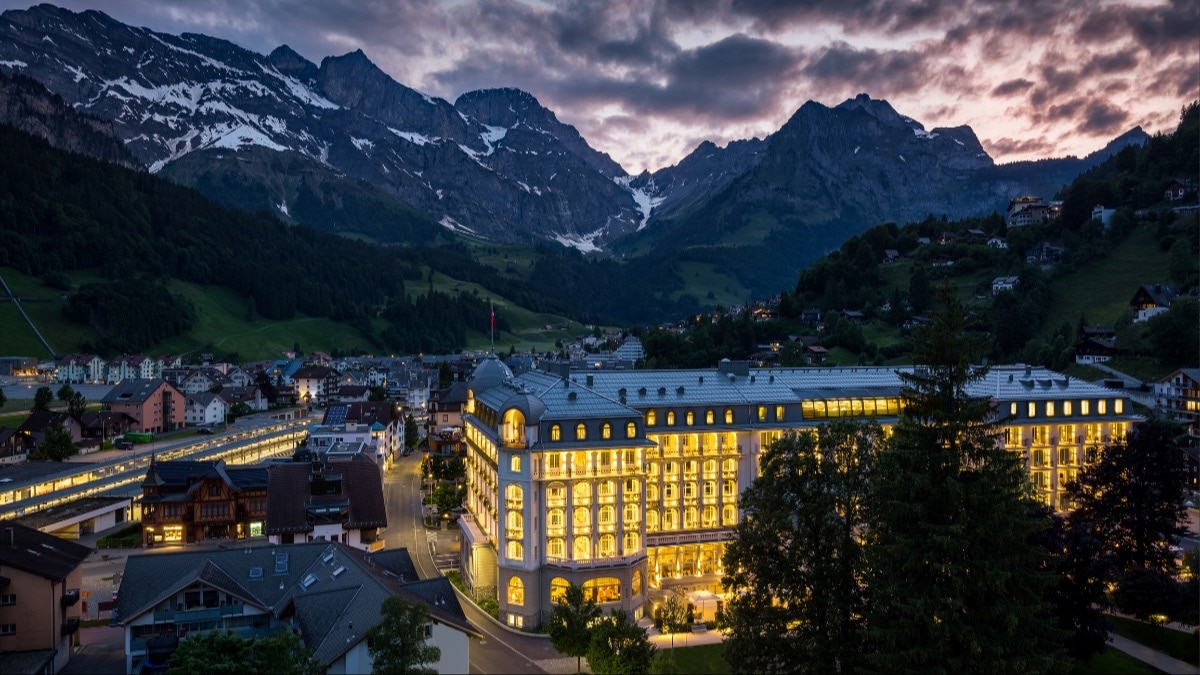
In the lap of the alps, Switzerland offers the best of hiking trails, ski slopes, and abundance of nature
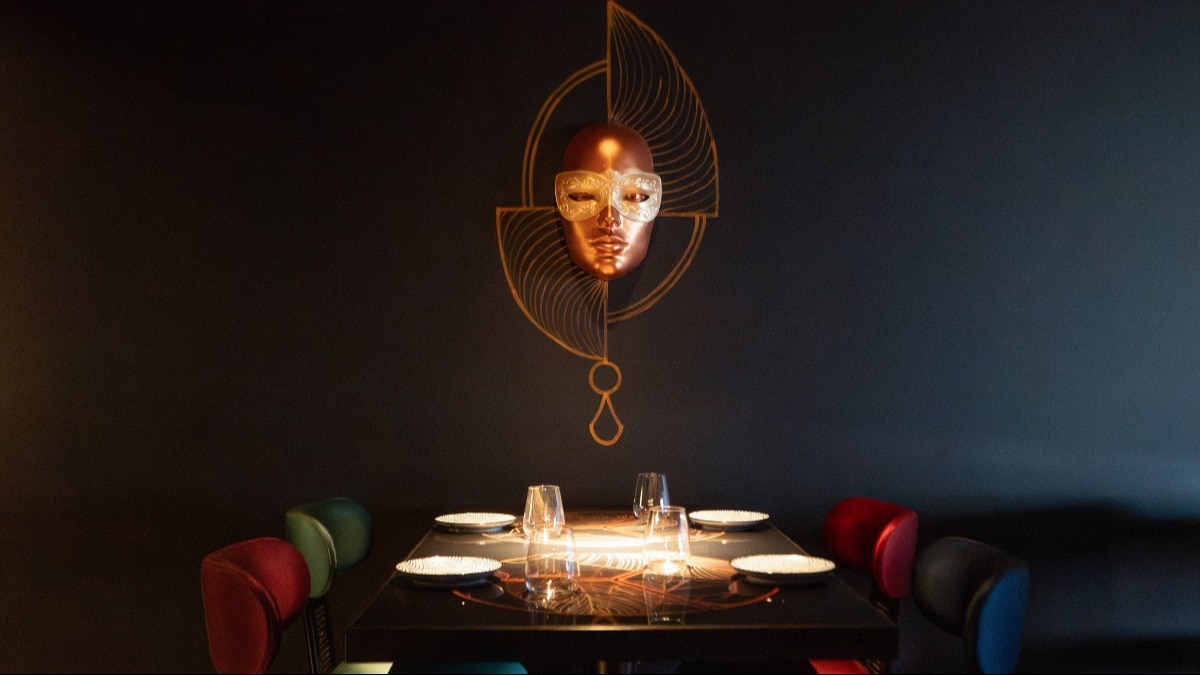
This new restaurant in Mumbai teleports you to a carnival over masquerades and pan-Indian cuisine

'Bridgerton' shows that gossip can be destructive – but believe it or not, it’s good for you too

6 spectacular film festivals, other than Cannes, that you shouldn’t miss

Deepti Sadhwani makes a grand debut at the Cannes Film Festival

This Cartier exhibition chronicles the maison’s artistic inspirations from the East

The ultimate green reading list: 10 books to help you become more sustainable

Tiffany & Co’s magic arrives in Mumbai

10 timeless, iconic jewellery pieces you'll treasure forever
National Geographic content straight to your inbox—sign up for our popular newsletters here

Dark tourism: when tragedy meets tourism
The likes of Auschwitz, Ground Zero and Chernobyl are seeing increasing numbers of visitors, sparking the term 'dark tourism'. But is it voyeuristic or educational?
Days after 71 people died in a London tower block fire last June, something strange started to happen in the streets around it. Posters, hastily drawn by members of the grieving community of Grenfell Tower, appeared on fences and lamp posts in view of the building's blackened husk.
'Grenfell: A Tragedy Not A Tourist Attraction,' one read, adding — sarcastically — a hashtag and the word 'selfies'. As families still searched for missing inhabitants of the 24-storey block, and the political shock waves were being felt through the capital, people had started to arrive in North Kensington to take photos. Some were posing in selfie mode.
"It's not the Eiffel Tower," one resident told the BBC after the posters attracted the attention of the press. "You don't take a picture." Weeks later, local people were dismayed when a coachload of Chinese tourists pulled up nearby so that its occupants could get out and take photos.
Grenfell Tower, which still dominates the surrounding skyline (it's due to be demolished in late 2018), had become a site for 'dark tourism', a loose label for any sort of tourism that involves visiting places that owe their notoriety to death, disaster, an atrocity or what can also loosely be termed 'difficult heritage'.
It's a phenomenon that's on the rise as established sites such as Auschwitz and the September 11 museum in Manhattan enjoy record visitor numbers. Meanwhile, demand is rising among those more intrepid dark tourists who want to venture to the fallout zones of Chernobyl and Fukushima, as well as North Korea and Rwanda. In Sulawesi, Indonesia, Western tourists wielding GoPros pay to watch elaborate funeral ceremonies in the Toraja region, swapping notes afterwards on TripAdvisor.
Along the increasingly crowded dark-tourist trail, academics, tour operators and the residents of many destinations are asking searching questions about the ethics of modern tourism in an age of the selfie and the Instagram hashtag. When Pompeii, a dark tourist site long before the phrase existed, found itself on the Grand Tour of young European nobility in the 18th century, dozens of visitors scratched their names into its excavated walls. Now we leave our mark in different ways, but where should we draw the boundaries?
Questions like these have become the life's work of Dr Philip Stone , perhaps the world's leading academic expert on dark tourism. He has a background in business and marketing, and once managed a holiday camp in Scotland. But a fascination with societal attitudes to mortality led to a PhD in thanatology, the study of death, and a focus on tourism.
"I'm not even a person who enjoys going to these places," Stone says from the University of Central Lancashire, where he runs the Institute for Dark Tourism Research. "But what I am interested in is the way people face their own mortality by looking at other deaths of significance. Because we've become quite divorced from death yet we have this kind of packaging up of mortality in the visit economy which combines business, sociology, psychology under the banner of dark tourism. It's really fascinating to shine a light on that."
Historical roots
The term 'dark tourism' is far newer than the practice, which long predates Pompeii's emergence as a morbid attraction. Stone considers the Roman Colosseum to be one of the first dark tourist sites, where people travelled long distances to watch death as sport. Later, until the late 18th century, the appeal was starker still in central London, where people paid money to sit in grandstands to watch mass executions. Hawkers would sell pies at the site, which was roughly where Marble Arch stands today.
It was only in 1996 that 'dark tourism' entered the scholarly lexicon when two academics in Glasgow applied it while looking at sites associated with the assassination of JFK. Those who study dark tourism identify plenty of reasons for the growing phenomenon, including raised awareness of it as an identifiable thing. Access to sites has also improved with the advent of cheap air travel. It's hard to imagine that the Auschwitz-Birkenau memorial and museum would now welcome more than two million visitors a year (an average of almost 5,500 a day, more than two-thirds of whom travel to the Polish site from other countries in Europe) were it not for its proximity to Krakow's international airport.
Peter Hohenhaus, a widely travelled dark tourist based in Vienna, also points to the broader rise in off-the-beaten track tourism, beyond the territory of popular guidebooks and TripAdvisor rankings. "A lot of people don't want mainstream tourism and that often means engaging with places that have a more recent history than, say, a Roman ruin," he says. "You go to Sarajevo and most people remember the war being in the news so it feels closer to one's own biography."
Hohenhaus is also a fan of 'beauty in decay', the contemporary cultural movement in which urban ruins have become subject matter for expensive coffee-table books and a thousand Instagram accounts. The crossover with death is clear. "I've always been drawn to derelict things," the 54-year-old says. As a child in Hamburg, he would wonder at the destruction of war still visible around the city's harbour.
That childhood interest has developed into an obsession; Hohenhaus has visited 650 dark tourist sites in 90 countries, logging them all and more besides on his website . He has plans to put together the first dark tourism guidebook. His favourite holiday destination today is Chernobyl and its 'photogenic' ghost town. "You get to time travel back into the Soviet era but also into an apocalyptic future," he says. He also enjoys being emotionally challenged by these places. "I went to Treblinka in 2008 and heard the story of a teacher at an orphanage in Warsaw who was offered a chance to escape but refused and went with his children to the gas chambers. Stories like that are not everyday, you mull over them. Would you have done that?"
But while, like any tourism, dark tourism at its best is thought-provoking and educational, the example of Grenfell Tower hints at the unease felt at some sites about what can look like macabre voyeurism. "I remember the Lonely Planet Bluelist book had a chapter about dark tourism a while ago and one of the rules was 'don't go back too early'," Hohenhaus says. "But that's easier said than calculated. You have to be very aware of reactions and be discreet when you're not in a place with an entrance fee and a booklet." Hohenhaus said he had already thought about Grenfell Tower and admits he would be interested to see it up close. "It's big, it's dramatic, it's black and it's a story you've followed in the news," he says. "I can see the attraction. But I would not stand in the street taking a selfie."
A mirror to mortality
An urge to see and feel a place that has been reduced to disaster shorthand by months of media coverage is perhaps understandable, but Stone is most interested in the draw — conscious or otherwise — of destinations that hold up a mirror to our own mortality. "When we touch the memory of people who've gone what we're looking at is ourselves," he says. "That could have been us in that bombing or atrocity. We make relevant our own mortality." That process looks different across cultures — and generations — and Stone says we should take this into account before despairing of selfie takers at Grenfell Tower or Auschwitz.
"I've heard residents at Grenfell welcoming visitors because it keeps the disaster in the public realm, but they didn't like people taking photos because it's a visual reminder that you're a tourist and therefore somehow defunct of morality," he explains. "We're starting to look at selfies now. Are they selfish?" Stone argues that the language of social media means we no longer say "I was here", but "I am here — see me". He adds: "We live in a secular society where morality guidelines are increasingly blurred. It's easy for us to say that's right or wrong, but for many people it's not as simple as that."
"Travel itself is innately voyeuristic," argues Simon Cockerel, the general manager of Koryo Tours , a North Korea specialist based in Beijing. Cockerel, who has lived in China for 17 years and joined Koryo in 2002, says demand has grown dramatically for trips to Pyongyang and beyond, from 200 people a year in the mid 1990s, when the company started, to more than 5,000 more recently. He has visited the country more than 165 times and says some clients join his tours simply to bag another country, and some for bragging rights. But the majority have a genuine interest in discovering a country — and a people — beyond the headlines.
"I've found everyone who goes there to be sensitive and aware of the issues," he says. "The restrictions do create a framework for it to be a bit like a theme park visit but we work hard to blur those boundaries. More than 25 million people live in North Korea, and 24.99 million of them have nothing to do with what we read in the news and deserve to be seen as people not as zoo animals or lazy caricatures."
More challenging recently has been the US ban on its citizens going to North Korea, imposed last summer after the mysterious death of Otto Warmbier. The American student had been arrested in Pyongyang after being accused of trying to steal a propaganda poster. Americans made up about 20% of Koryo's business, but Cockerel argues the greater loss is to mutual perception in the countries. "The North Korean government represent Americans as literal wolves with sharpened nails," he says. "At least a few hundred Americans going there was a kind of bridgehead against that. Now that's gone."
At Grenfell Tower, responsible tourism may yet serve to keep alive the memory of the disaster, just as it does, after a dignified moratorium, at Auschwitz and the former Ground Zero. Hohenhaus says he will resist the urge to go until some sort of memorial is placed at the site of the tower. At around the time of a commemorative service at St Paul's Cathedral six months after the fire, there were calls for the site eventually to be turned into a memorial garden. The extent to which Hohenhaus and other dark tourists are welcomed will be decided by the people still living there.
Five of the world's dark tourism sites
1. North Korea Opened to visitors in the late 1980s, North Korea now attracts thousands of tourists each year for a peek behind the headlines.
2. Auschwitz-Birkenau The former Nazi death camp became a memorial in 1947 and a museum in 1955. It's grown since and in 2016 attracted a record two million visitors.
3. 9/11 Memorial and Museum Built in the crater left by the twin towers of the World Trade Center, the museum, opened in 2014, has won plaudits for its portrayal of a disaster and its impact.
4. Rwanda Visitor numbers to genocide memorials have grown in Cambodia and Bosnia as well as in Rwanda, where there are several sites dedicated to the 1994 massacre of up to a million people. The skulls of victims are displayed.
5. Chernobyl & Pripyat, Ukraine Several tour companies exist to send visitors to the exclusion zone and ghost town left otherwise empty after the nuclear accident in 1986. All are scanned for radiation as they leave.
Published in the March 2018 issue of National Geographic Traveller (UK)
Find us on social media
Facebook | Instagram | Twitter
Related Topics
- EDUCATIONAL TRAVEL
- CULTURAL TOURISM
- HISTORY AND CIVILIZATION
You May Also Like

An insider's guide to Denver, Colorado's wildly creative capital

They inspire us and teach us about the world: Meet our 2024 Travelers of the Year
For hungry minds.

10 reasons to visit the East Coast in 2024

An architectural tour of the Georgian capital, Tbilisi

7 of the UK's best gallery cafes

A long weekend in Orkney

How to plan a walking tour of Glasgow in the footsteps of Charles Rennie Mackintosh
- Paid Content
- Environment
- Photography
- Perpetual Planet
History & Culture
- History & Culture
- Mind, Body, Wonder
- Terms of Use
- Privacy Policy
- Your US State Privacy Rights
- Children's Online Privacy Policy
- Interest-Based Ads
- About Nielsen Measurement
- Do Not Sell or Share My Personal Information
- Nat Geo Home
- Attend a Live Event
- Book a Trip
- Inspire Your Kids
- Shop Nat Geo
- Visit the D.C. Museum
- Learn About Our Impact
- Support Our Mission
- Advertise With Us
- Customer Service
- Renew Subscription
- Manage Your Subscription
- Work at Nat Geo
- Sign Up for Our Newsletters
- Contribute to Protect the Planet
Copyright © 1996-2015 National Geographic Society Copyright © 2015-2024 National Geographic Partners, LLC. All rights reserved
The 9 best dark tourism spots in Europe
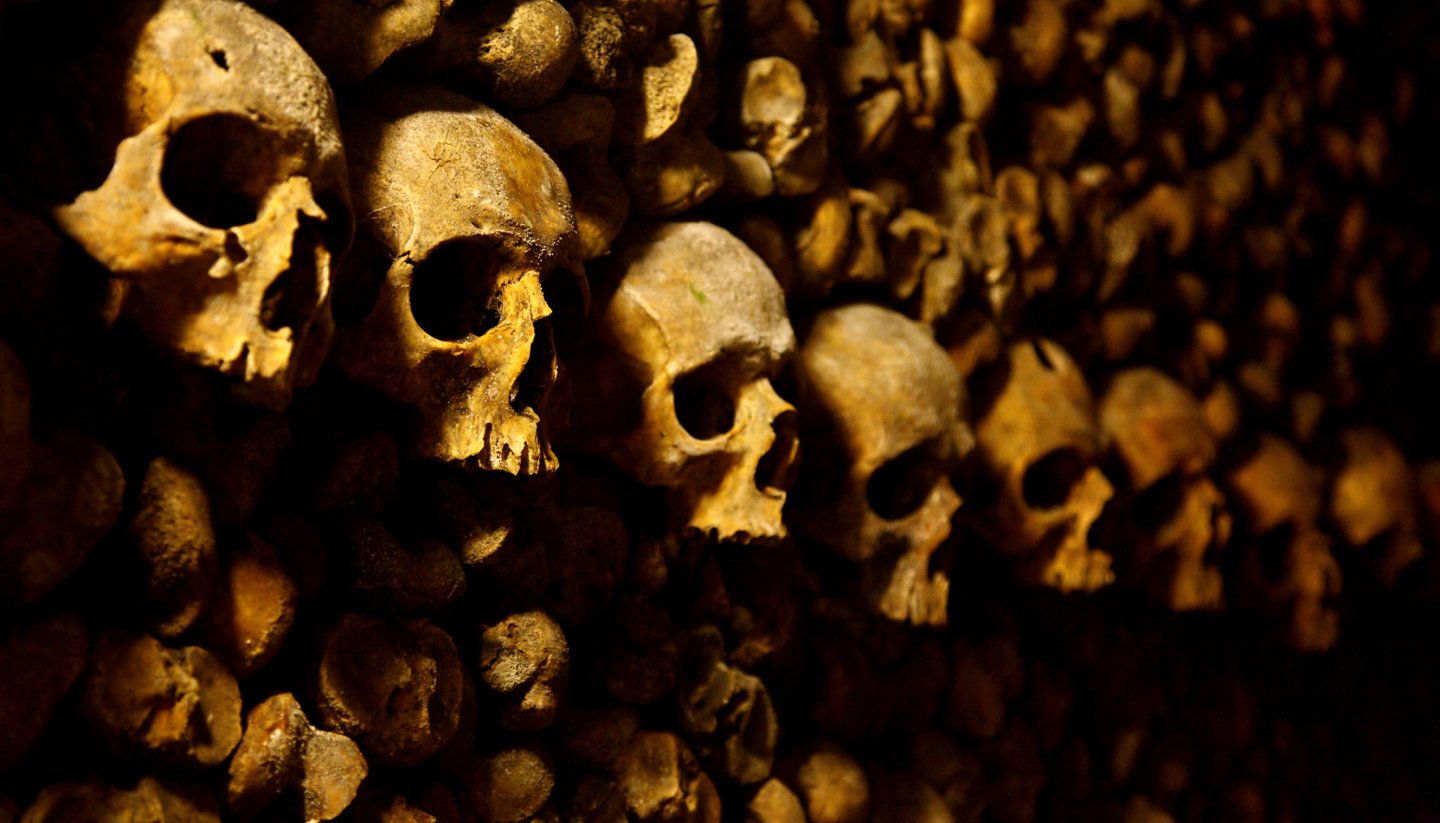
From warfare to natural disasters, Europe has many bloody periods. Here are nine places where tourists can get stark reminders of the bleak history
On 30 January 1649, Charles I was beheaded in London. A stubborn king, his refusal to share power with the Parliament had led the country to civil war, which ultimately saw the Parliamentarians (led by Oliver Cromwell) win. Charles I was tried, convicted and executed – it was the first execution of an English monarch, and of course, it was done publicly, with former subjects crowding to watch the once-king’s head leave his shoulders.
Today, this kind of morbid curiosity has evolved into what’s commonly known as dark tourism, referring to tourists visiting places that have been affected by tragedy and death. In Europe, countries may not decapitate their rulers anymore, but the continent’s long history, often punctuated by bloody periods of warfare, disease and calamities, offers many an opportunity to get up close with the grotesque. While some may argue that dark tourists are an insensitive bunch, in reality, all of us can learn a lot from history when we visit these places.
Here are our top dark tourism spots in Europe.
1. Pripyat, Ukraine
On 26 April 1986, Chernobyl’s Reactor No 4 had its roof blown off by two explosions, releasing a thick cloud of radiative dust to the adjacent town Pripyat before spreading to other parts of Europe. The radiation discharged was said to be 400 times more intense than the atomic bomb dropped on Hiroshima, and it prompted the government to evacuate the 50,000 residents of Pripyat. They were told to pack little as they would be expected to return, but in reality, many never returned as the high levels of radiation have rendered the entire area uninhabitable for 20,000 years.
Located just 129km (80mi) north of Kyiv, Pripyat is now a prime destination for dark tourists, who can only visit on guided tours through the town, the surrounding woodland and the Chernobyl nuclear plant. While it is not dangerous to spend a limited amount of time in Pripyat, safety measures must still be followed – visitors are expected to wear long-sleeve tops, long pants and closed shoes, carry their passport and be scanned at a radiation control checkpoint when leaving the exclusion zone.
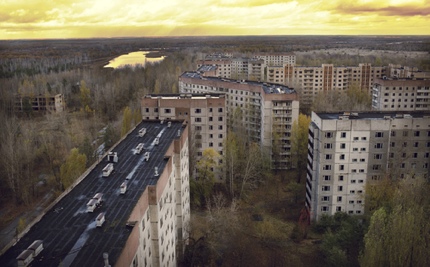
The ghost town of Pripyat Shutterstock
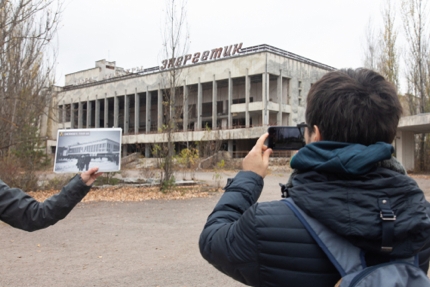
On a guided tour of Pripyat Shutterstock
2. Auschwitz, Poland
Between 1940 and 1945, more than 1.1 million men, women and children were systematically murdered in the Nazis’ biggest concentration camp. 90% of them were Jewish, the rest were Poles, Gypsies and Soviet prisoners of war. In January 1945, when the Soviet army approached, the Nazis decided to abandon Auschwitz, leaving behind piles of human ashes, along with a mountain of personal belongings – most of the people who owned them had been murdered. Decades after its abandonment, Auschwitz remains a harrowing reminder of the depths of human cruelty.
The Auschwitz Museum now sits on the site of Auschwitz I, displaying evidence that wasn’t destroyed by the Nazis when they evacuated, including well-worn shoes and spectacles by former inmates.
We recommend you join a guided tour to gain a better insight, and all guided tours will take you to other parts of the camp (Auschwitz I and Auschwitz II-Birkenau, the latter being the site of mass extermination).
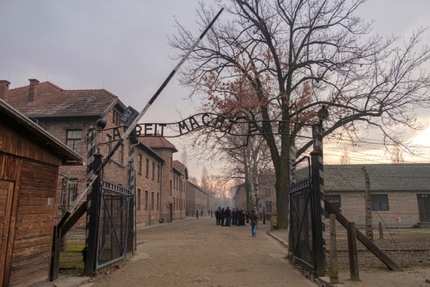
One of the camps Shutterstock
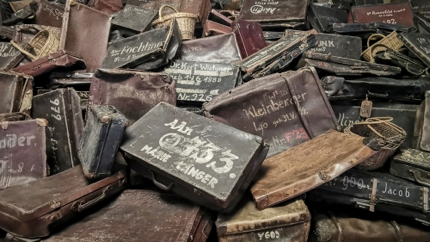
Personal belongings of the inmates Shutterstock
3. Spinalonga, Crete, Greece
Leprosy, a disease that has existed for ages, is now curable with multidrug therapy, but those infected in the past weren’t so lucky as they were stigmatised and ostracised.
In Greece, those with leprosy had their citizenship rights revoked, assets seized and were deported to Spinalonga, a small island off the north coast of Crete. And despite the cure for leprosy being discovered in the 1940s, the colony was only shut in 1957 following damning reports of its disastrous conditions.
The island now operates as a museum. Not only are there hallmarks of the lepers for dark tourists, but there are also remains of a 16th-century Venetian fortress and the homes built by Muslim settlers in the 1700s.
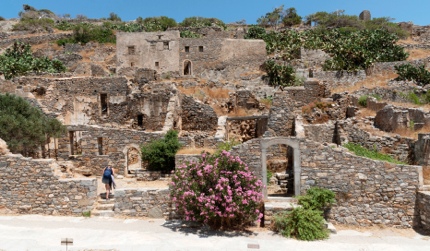
The ruins on Spinalonga Shutterstock
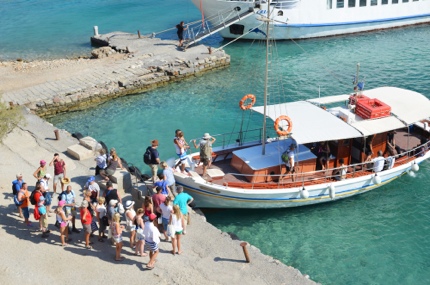
Tourists leaving Spinalonga Shutterstock
4. Santa Maria della Concezione dei Cappuccini, Rome, Italy
From the exterior, Santa Maria della Concezione dei Cappuccini (Our Lady of the Conception of the Capuchins) looks rather ordinary, but inside its crypt, the bones of some 3,700 monks make this the most morbid spot in Rome.
Commissioned by Pope Urban VIII and erected between 1626-31, the church was the refuge of Capuchin monks, a small religious order that embraced austerity and simplicity.
The monks were initially buried in the church, but as the dead began to exceed space, older remains were dug up and used to adorn the walls and ceilings to make room for more bodies. Today, you can visit the crypt and see the bones and skulls, along with skeletons, some cloaked in brown garments and holding crosses as if in prayer. There is also a ceiling-mounted figurehead of Death, made from a child’s skeleton with scales of justice in one hand and scythe of death in the other.
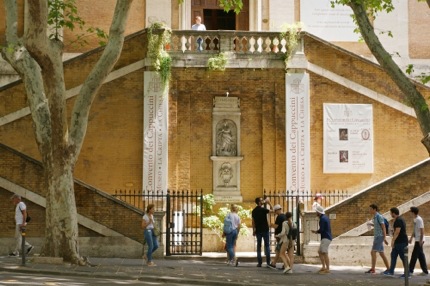
Santa Maria della Concezione dei Cappuccini Shutterstock
5. Sarajevo, Bosnia and Herzegovina
Sarajevo has many sad tales to tell. It was here – just around the corner from Latin Bridge in central Sarajevo – that the Archduke Franz Ferdinand of Austria and his wife Sophie were assassinated on 28 June 1914. The event triggered a series of crisis which eventually led to World War I. The war lasted over four years in various places around the world, causing 20 million deaths.
After WWI, Sarajevo became part of Yugoslavia and enjoyed a few peaceful years, but when Bosnia and Herzegovina declared independence from Yugoslavia in 1992, the city again found itself entering into one of the darkest chapters in European history. It was here that the Bosnian Serb forces laid siege to Sarajevo, attacking the city with countless bombs and bullets during the four-year stand-off.
When the leaders of the Bosnian Serb Army stood trial at the International Criminal Tribunal later, documents showed that they were just targeting anyone – including women and children – at random. The level of cruelty was unspeakable.
Nowadays, Sarajevo is full of echoes of that violent conflict. “War Tours” are a hugely popular attraction, detailing the siege and its origins in-depth.
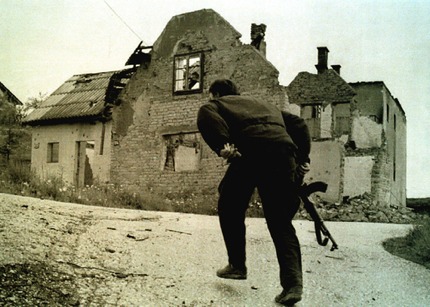
A fighter running for cover on 2 Oct 1993 Shutterstock
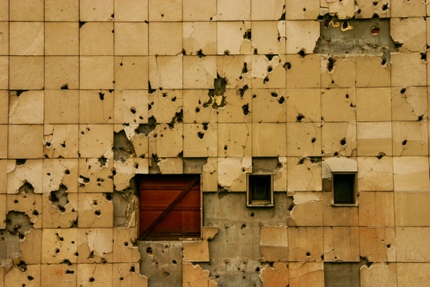
Bullet holes on a building in Sarajevo Shutterstock
6. Catacombs, Paris, France
In 1780, a lengthy period of spring rain made a wall around Les Innocents, a Parisian cemetery, collapse, spilling decomposing corpses into a neighbouring house. The incident highlighted the pressing issue that Paris had run out of burial space. The authorities then started moving bones to the old quarries below the city, resulting in the creation of Les Catacombes de Paris.
It took 27 years (1787-1814) for the authority to transfer the remains of six million people from various cemeteries to the Catacombs. Many of the bones were shaped into the most gruesome of art, with arrangements inspired by olden art styles like the Romantic and Ancient Egyptian. A gothic and insightful spectacle, it’s been a hyper-popular tourist attraction in Paris since 1809.
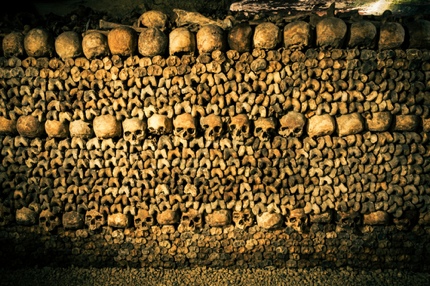
The Catacombs, Paris Shutterstock
7. Pompeii, Italy
On 24 August 79, Mount Vesuvius erupted and showered Pompeii, which was at its south-eastern base, in a torrent of volcanic rocks, ashes and thick lava. The force of the exploding volcano decimated buildings and crushed civilians, with more later choking on the ash that rained down.
Today, UNESCO regards Pompeii as ‘the only archaeological site in the world that provides a complete picture of an ancient Roman city’, acknowledging its string of imposing buildings, bath complexes, two theatres and an amphitheatre. The site now welcomes 2.5 million tourists a year, who browse gardens and architecture untouched for almost two millennia. Body casts of long-dead victims add a particularly dark touch as well.
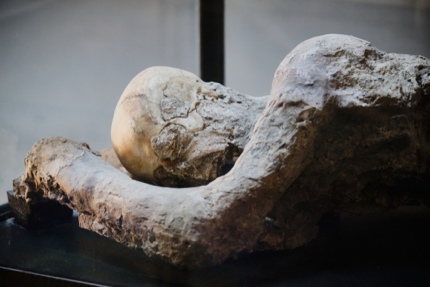
Plaster casts of a victim Shutterstock
8. Lancaster Castle, England
One day in March 1612, Alizon Device, granddaughter of a local witch known as Old Demdike, was out begging when she encountered John Law, a pedlar from Halifax who sold pins, among other products probably. When John refused to give Alizon some pins, she cursed him in frustration. John collapsed almost immediately, his body paralysed and speech slurred. John’s son reported the incident to the local magistrate. When interviewed, Alizon admitted to condemning John, but she also did something rather strange – she implicated her family members and neighbours, accusing them of using witchcraft to murder people.
Altogether 19 people were arrested and 11 were later trialled in Lancaster Castle, the very spot that some witches were accused of hatching a plan to blow it up. During the trial, much of the evidence rested on the testimony of Jennet Device, a nine-year-old family member of many of the accused, along with evidence based on hearsay and superstition. On the following day, ten people were found guilty of witchcraft and sentenced to death.
Although the execution didn’t take place at Lancaster Castle (but on nearby Gallows Hill), the castle, with its long history of various trials, imprisonments and punishments, attracts many dark tourists today.
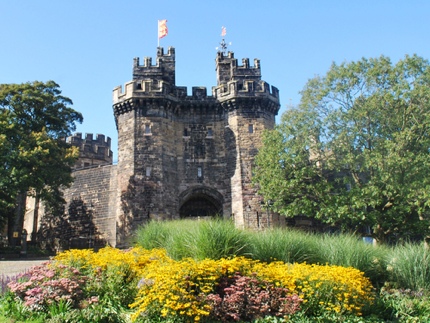
Lancaster Castle Shutterstock
9. Troyekurovskoye Cemetery, Moscow, Russia
Many of Europe’s dark tourism spots remind us of terrors that happened generations ago, but this one still sees high-profile individuals being interred, often following a ‘long and serious illness’.
In 2018, Igor Korobov, the chief of Russian military intelligence, was buried here. His sudden death prompted some sources to speculate that Korobov was murdered after the failed attempt to silence former agent Sergei Skripal and his daughter in Salisbury, England. Intriguingly, Korobov’s predecessor, Igor Sergun, also died suddenly two years before and was also buried here.
Troyekurovskoye Cemetary is also the resting place of three former KGB chiefs: Vitaly Fedorchuk, Vladimir Semichastny and Viktor Chebrikov.

Igor Korobov (L) and Sergey Shoygu (R) © licensed under CC BY-4.0
You may also like:
- 13 of the best lost cities
- Bolivia’s wrestling cholitas
- The 19 best stargazing sites in the world
- 19 things to know before travelling to Cuba
- The complete guide to smoking marijuana in Amsterdam coffeeshops
This article was updated in March 2021.
LATEST ARTICLES

© Columbus Travel Media Ltd. All rights reserved 2024
11 Of The Best Dark Tourism Destinations For First-Timers
Dark tourism is relatively new in the world of travel, and these destinations are perfect for those looking to get a taste of it.
Netflix's hit series Dark Tourist opened viewers' eyes to a niche that's been a part of travel in one way or another for centuries. Humans are naturally drawn to the macabre. It stirs something inside to witness places associated with darkness, a somewhat unexplainable thirst to understand things that seem unbelievable.
Though dark tourism has come under criticism for being exploitative, visiting sites with dark histories is an indispensable way to learn about how things happened, why they did, and how they can be prevented in the future. These destinations around the world are perfect for travelers interested in learning about the world in a way that's often missing from formal education.
*Note: As always, it's essential to be respectful of one's surroundings when traveling. Due to the nature of these places and their sensitive history, it's vital to be especially respectful when visiting.
Updated by Lauren Feather, February 18, 2022: The world overflows with just as much horrific history as that which is glorious. Many of the planet's most devastating events still echo suffering of past where they once happened, and it's possible to visit such places in order to learn all about them. With dark tourism popularity on the rise, much of the world's most discerning travelers with an interest in natural disasters and volatile history choose to enrich their learning by actually visiting the areas where such events took place. As such, some of the most popular places were darkness once occurred have been added to this fascinating yet macabre list of dark tourism destinations. And as always, please tour these places respectfully and with an open mind and heart.
11 Eyjafjallajökull, Iceland
The eruption of Eyjafjallajökull volcano put Iceland on the global map in April 2010. Most people had never even heard of it, until the massive ash cloud it spewed out grounded flights for over two weeks. The ordeal cost the European economy about five billion dollars, however tourism in Iceland has since accelerated, and consequently, helped to compensate the loss.
Before the volcano let rip, most travelers wouldn't even think of visiting the Land of Fire and Ice , but thanks to the fame it achieved (for somber reasons albeit) tourists from all corners of the world have added the cold northerly country to their bucket lists. From glaciers, icy lagoons, and the legendary Northern Lights to the midnight sun and the volcano that caused all the chaos, travelers have so much to do and see in this chilly country of spectacular icy scenery.
Related: 10 Things To Do In Iceland (That Aren't The Blue Lagoon)
10 Pompeii, Italy
Pompeii is perhaps one of the first dark tourism sites to gain popularity, attracting international travelers for over 250 years. The fallen city is one of the best-preserved places to see Ancient Roman architecture, due significantly to the violent eruption of Mount Vesuvius.
Volcanic ash blanketed the city, somewhat ironically protecting the structures from the elements. The residents trapped in Pompeii perished, their bodies transformed into plaster statues. Mount Vesuvius remains active, and scientists say the volcano is overdue for an eruption.
Related: Pompeii Was Destroyed 1,924 Years Ago, But Many People Still Don't Know These Things About The City
9 Catacombs - France
Tourists flock to Paris' Catacombs to witness a massive, real-life underground graveyard that's inspired literature and film over the years. During the 18th-century, Paris' population expanded faster than its cemeteries could, and overcrowding meant burials posed a threat to human health.
Officials decreed to use the city's underground quarries as makeshift cemeteries, at first simply tossing the deceased into the tunnels. Eventually, the remains were stacked in an orderly fashion, with skulls lining the walls like a macabre interior design choice. Upon entrance, visitors are greeted with an exhibition room to learn about the history of the Catacombs, and two kilometers of tunnels are open for observation.
Related: The Paris Catacombs Are The Final Resting Places Of Six Million People, And You Can Visit Them
8 Auschwitz - Poland
The atrocities that occurred during the Holocaust are among the worst in human history. It's unfathomable to consider how human beings were held against their will, forced to labor, starved, abused, experimented on, and exterminated. There is no nice way to put it, and it serves no purpose to surround the tragedy with euphemisms.
Visiting the notorious concentration camps of Auschwitz allows people to feel the weight of the atrocities in a way that learning about them through the pages of a book never could. It's a sobering experience that forces people to confront the harsh realities of impenetrable darkness and learn about the events that led to such a deep stain in the fabric of human history.
7 Phnom Penh, Cambodia
Cambodia is home to the stupefying Angkor Wat, which is one of the world's largest and most impressive religious monuments that's a UNESCO listed temple. Despite its intrigue and beauty, it doesn't overshadow its horrific past and the people who are still recovering from the suffering they endured under the Khmer Rouge regime only a few decades ago - during which an estimated one million people were brutally murdered.
Travelers with a discerning eye can get a feel for the dark times and misery when they visit the Tuol Svay Prey High School and the killing fields of Choeung Ek, which, in spite of the scars that are still present, are ever important grounds in Cambodia's volatile history that played a crucial role in the country becoming what it is in the modern day.
Related: A Travel Guide To Cambodia: Tourists Should Plan Their Trip Around These 10 Things
6 Hiroshima - Japan
Since its invention, nuclear weaponry has gripped humans in fear. Drills during the Cold War sent children beneath their desks in preparation for an attack. In recent years, the possibility of nuclear war regularly echoes from the nightly news. Several countries currently possess bombs powerful enough to wipe out entire nations, a sad fact considering the destruction of Hiroshima and Nagasaki during World War II.
The A-bomb destroyed the city and took the lives of thousands of innocent people. The residents of Hiroshima are fiercely dedicated to promoting peace on a grand scale. To visit Hiroshima is to witness the strength of humanity to rebuild. UNESCO designated the A-bomb Dome a World Heritage site, the building preserved as a reminder of the horrors of nuclear warfare.
5 Port Arthur - Tasmania
Located on the Tasman Peninsula is one of several convict sites steeped in dark history. Convicts at Port Arthur were subject to brutal floggings, hard labor, and long stints in solitary confinement, a practice that's frequently called into question for its cruelty. Many men lived and died within the walls, their hard work responsible for large chunks of architecture in Tasmania. Guided tours and interactive exhibits educate guests about Port Arthur's history, leaving none of the dark bits out of the stories.
Related: Here’s Everything You Can Do In Tasmania During Your First Time There
4 The 9/11 Memorial & Museum - United States
Two decades have gone by since the attack on the World Trade Center, and people can still vividly remember exactly where they were when it happened. Thousands of people lost their lives on September 11, 2001, and the New York City skyline changed forever. In the aftermath, the country put all its differences aside and united to rebuild.
People slowly cleared the rubble, dust, and debris. Life resumed as it has and will continue to in the wake of tragedy. Ground Zero and the 9/11 Memorial and Museum are among the top-visited dark tourist destinations worldwide. It is difficult to imagine what the city looked like 20 years ago on that fateful day. It's amazing to think about how human beings can come together to tend to the emotional wounds left behind by such events.
3 Berlin Wall - Germany
A majority of the Berlin Wall was dismantled after the Cold War, but fragments throughout Berlin serve as a reminder of the negative impacts division has on society. The large concrete barrier separated East and West Berlin for nearly 30 years. An area known as the "death strip" contained guard towers, beds of nails, barbed wire, and more, the defenses intended to keep people from crossing.
In 1989, the world watched on as the Berlin Wall fell, symbolically reuniting Germany and marking the fall of Communism in Europe. The remnants of The Berlin Wall are scattered throughout the world, but the largest portions can be found in Berlin. Stunning graffiti from past and present add pops of color to the city, a reminder of art's transformative and healing power.
2 Chernobyl, Ukraine
There's not a soul in the world that doesn't know about the devastating event that took place in Chernobyl in 1986, where a nuclear power plant explosion set off an apocalyptic chain of events that saw the place become a dangerous, desolate wasteland. The bravest of travelers can take guided tours of the uninhabitable, decaying city of Pripyat to see a real-life post-apocalypse that still continues today , where empty schools, abandoned residences, rusted structures overgrown with greenery, and derelict buildings stand as a reminder of the horrors that once occurred.
At the time, local communities were told they were only evacuating their homes for three days, however, what they didn't know was that they were never going to return ever again. Countless power plant staff, rescue services, and civilians died as a result of the tragedy - some right in the aftermath, whilst others suffered for many years, eventually passing of terminal diseases like cancer - caused by exposure to the dangerous radiation emitted by the power plant's explosion.
Related: Chernobyl: Over 35 Years On, Is It Actually Safe To Visit?
1 Darvaza Gas Fire Crater, Turkmenistan
A large crater has been burning in Darvaza, Turkmenistan for 50 years now, attracting tourists to witness the site commonly referred to as the "Gates of Hell." The natural gas field in the middle of the desert collapsed in the 1960s. It was set ablaze in 1971, though there are no solidified records of who did it or why. The dark tourist destination in the desert is a popular spot for wild camping, and thousands of travelers head to Turkmenistan to observe a piece of the earth on fire.
Next: Dark Tourism: What It Is And How To Do It Respectfully

10 Dark Tourism Destinations in Europe
Netflix’s latest hit has seriously put ‘dark tourism’ on the map with search results in the UK increasing by a whopping 1000 percent since it launched!
What is Dark Tourism?
Dark tourism is defined as “tourism directed to places that are identified with death and suffering”. Dark tourism places run from the macabre like the site a shipwreck to the somber like a concentration camp to the truly weird like a festival of near-death experiences.
If you’d prefer to explore for yourself rather than just ‘Netflix and Chill’ We Are Promotional has created the ultimate list of dark tourism sites and macabre attractions. So forget your beach towel and pack the tissues as we take you on the REAL tour of Europe – the one that’s not in the guidebooks!
If you ate traveling to Europe and are looking for more than just dark tourism sites in London then see the 10 sites listed below:

Costa Concordia Shipwreck, Italy
Type: Shipwreck Location: Isola del Giglio, Italy Closest Airport: Milan
“It’s just like Titanic!” cried a survivor of the Costa Concordia tragedy not long after it occurred.
Yes and no. Both were tragedies and both were cruise ships, but the Titanic sinking in 1912 killed 1,517 people, and then was relatively forgotten about by the public. The only reason everyone knows about it today is because of the famous movie starring Leonardo Di Caprio.
The Costa Concordia, on the other hand, took fewer lives and has not been forgotten about. After the tragedy, immediately, memorials and exhibitions were put up and many locals were pleased by the newfound industry in the town – tourism.
Costa Concordia was a cruise ship that had 3,206 passengers and 1,023 crew members on board when it crashed on 13th January 2012. The ship hit an underwater rock off the waters off the coast of Tuscany near Isola del Giglio.
The ship was only so close to the coast because of a foolish attempt by, Francesco Schettino, the captain, to perform a ‘sail by salute’ – the practice of sailing close by to an island for the interest of passengers and crew.
The impact caused two long strips of steel from the ship’s hull to be shredded resulting in water entering the hull. The ship then capsized and the disaster claimed the lives of 32 passengers.
Today you can visit the rusted and battered remains of the cruise ship by boat. Locals run hour-long tours on zodiacs that leave from Genoas old harbor and take you within 200 yards of the morbid spectacle.
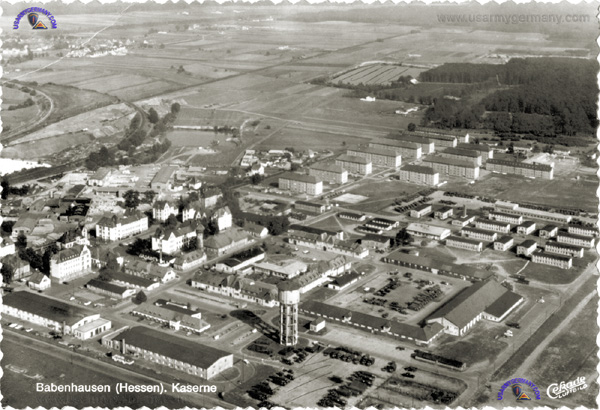
Image – Photography is not allowed on the site so this is an old US army image .
Babenhausen Barracks, Germany
Type: WW2 Barracks Location: Hessen, Germany Closest Airport: Frankfurt (FRA)
You can’t mention morbid locations in Europe without bringing up something in relation to its darkest time in modern history – WW2.
Dark tourism has lead to a rise in the number of visitors to various WW2 sites across Europe with Auschwitz seeing over 2 million visitors in 2016 but if you’re looking for something a little less crowded and a little more out there check out the Babenhausen Barracks in Germany.
The barracks used to house soldiers but fell into disrepair after WW2, but a section of them has now been turned into a museum. The reason they make the list of dark tourism hotspots in Europe is that there are frequent reports of paranormal activity at the barracks.
Nothing will raise the hairs on your arms quite like a good ghost story and Babenhausen Barracks has a great one. When you get there you may get a fright as you hear German voices coming from the basement shouting commands to their officers.
Lights in the building have been known to turn off and on by themselves so be sure you bring a flashlight with you.
German soldiers have been seen strolling the halls in their military uniforms and soldiers who have visited the site even report picking up a telephone in the barracks and hearing a woman’s voice “speaking backward” – no one is able to make out what she is saying.


Oradour-sur-Glane, France
Type: Post-war Ghost-town/Memorial Museum Location: Oradour-sur-Glane, France Closest Airport: Limoges
A visit to Oradour-sur-Glane in France is a truly moving experience but you could expect nothing less from a village that was entirely wiped out by the Nazi SS forces in June of 1944.
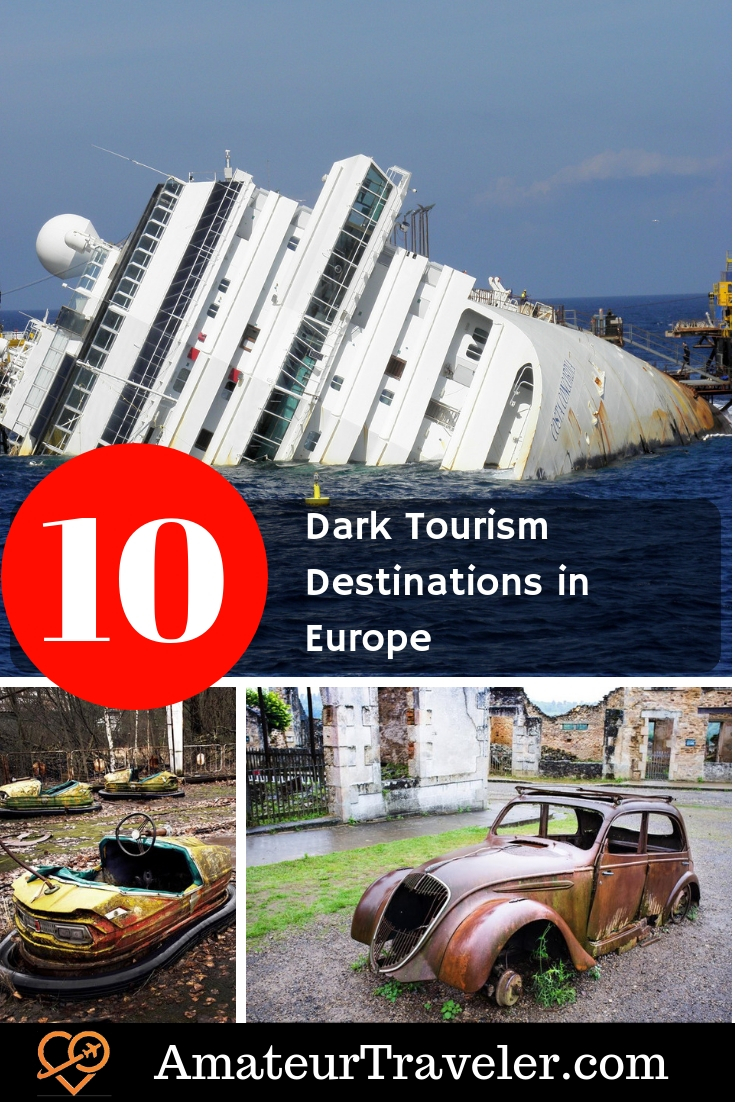
The majority of Europe had hope – there was an end in sight for the war. But just as these celebratory events were happening, a tragedy occurred in the small French village of Oradour-sur-Glane.
Men, women, and children in the village were rounded up by the Waffen SS and massacred. 642 people were killed – some asphyxiated, some machine-gunned, and some burnt alive.
The women and children were rounded up and held in the local church which the SS locked and set on fire. Today if you enter the church you can still see a flattened pushchair, left in its place where it had been found before the altar.
Stepping into the village is like stepping through time. All the remains have been left where they were found as a reminder of the tragedy that happened here and as a warning of the atrocities that happen in war.
The events are still shrouded in mystery. No one knows why this small town was chosen to experience this ultimate horror – theories of Russian gold and revenge killings still remain controversial and we may never know why this poor settlement was chosen.
“Everyone should come here once in their life. Deeply moving, well preserved, and respectful tribute to a truly terrible action and time.”
( Tripadvisor , 2018)

Overtoun Suicide Bridge
Type: Celtic mythological site Location: Dumbarton, Scotland Closest Airport: Glasgow
Near the quiet and peaceful village of Milton in Scotland, there is a mysterious bridge. For reasons unknown, this bridge has been attracting suicidal dogs since the 1960s.
If you’ve ever owned a dog you probably realize why this is such a strange occurrence – you’re probably thinking ‘I didn’t even know dog suicide was a thing.’ According to most people and canine psychologist Dr. David Sands , it’s not, making the fact that an estimated 50 dogs have taken their lives here even weirder.
Witnesses have seen a number of dogs plummet to a gruesome death from the same spot on the bridge. The canines meet a tragic end landing on rocks 50 feet (15m) below, most dying on impact.
What is even stranger than and adds to the theory that these are suicides rather than freak accidents is that on occasion these dogs can be seen climbing the parapet wall before they make their jump. Some dogs are even so lucky as to survive their brush with death only to return to the bridge and attempt the second jump.
The Scottish Society for the Prevention of Cruelty to Animals has even gone so far as to send investigators to the bridge to determine the cause of these dogs’ suicides. They were also unable to explain the cause of this bizarre behavior.
‘Animals are hyper-sensitive to the spirit world, but I didn’t feel any adverse energy.’ (Psychic Mary Armour)
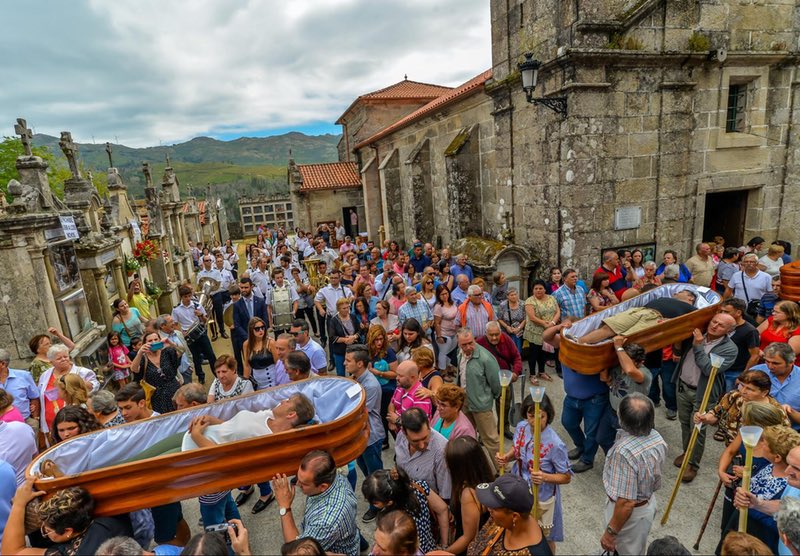
The Festival of Near-Death Experiences
Type: Celebration of life/Festival Location: As Nieves, Pontevedra , Spain Closest Airport: Vigo via Madrid
There are a lot of bizarre and strange festivals in the world but none may be quite as strange as the Festival of Near-Death Experiences held in the small village of As Nieves, Spain every July.
The festival of near-death experiences – or the Fiestas de Santa Marta de Ribarteme as the locals call it – is home to all manner of weird and wonderful events and activities. Burning effigies, running with bulls, tomato fights, and wine battles are just some of the fun events a day at this festival will hold in store.
People from all over, who have had a near-death experience, will make the long journey to this remote Spanish village with their friends and family. Once they arrive they are put into coffins and play dead. Their family then carries their coffin through the local streets along with a procession of mourners.
The collection of strange processions then meets at the cemetery of the local church – The Church of Santa Marta de Ribarteme. Prayers are said to Saint Marta and everyone gives thanks for their lives and that they were saved from death by presenting a gift (usually money) to the Saints statue.
“It is a very important day for my family and other families – I remember my mother and my pledge to her and the doctor who saved my life.” (The Irish Times, 2016)
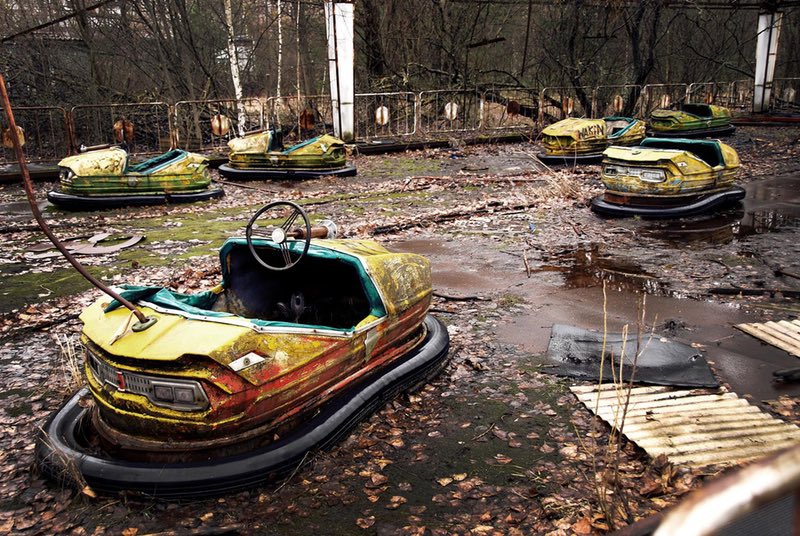
Pripyat, Ukraine
Type: Nuclear disaster Location: Pripyat, Ukraine Closest Airport: Kiev-Zhulhany
In the north of Ukraine, you will find the town Pripyat where the Chernobyl nuclear disaster happened in 1986. A horrific disaster turned tourist attraction, Pripyat now attracts over 10,000 visitors a year .
On April 25, 1986, during a late-night safety test there was a simulated station power blackout. The safety systems were intentionally turned off for the test but due to a number of flaws in the reactor design and human error, the nuclear reactor exploded.
It was the worst nuclear power plant explosion in history realizing huge quantities of radioactive material into the earth’s atmosphere. Two people were killed during the explosion and over the coming weeks and months, the full repercussions of the explosion would be realized.
237 servicemen, firemen, and employees were diagnosed with acute radiation sickness of which 31 died within the first 3 months. In the greater population, men, women, and children developed cancer, deformities, and had symptoms of acute radiation sickness.
To this day, the full human impact of Chernobyl is unknown. The estimates differ significantly with some saying the number of people affected tops a million . After this event and the tragic consequences that are still being felt today, no one ever expected it to become a tourist attraction.
Today, the Ukrainian government allows tourists to take short and regulated visits 30 miles into the exclusion zone and into the abandoned town of Pripyat.
Tens of thousands of people were evacuated from the town during the Chernobyl explosion, homes, schools, and even an amusement park were left behind to decay. Untouched by humans since their evacuation, stepping into this town is like stepping into a post-apocalyptic movie.
The ghost town is like a freeze-frame form the soviet-era, with communist propaganda hanging from the walls and hammer and sickles stuck to notice boards and streetlamps. As you walk through the town you will get the feeling that you are frozen in time as all the clocks have stopped at 11:55 – the moment that power was cut to the town.
“This was a highlight of four months of travel through Central Asia and Eastern Europe! Seeing the nuclear power plant and the nearby Duga Soviet radar system was really cool. Visiting Pripyat, in particular, was something completely different and will stay with me.”
read more at 10 Reasons Why Chernobyl Tours Are the Best Dark Tourism Experience
( Tripadvisor 2018)
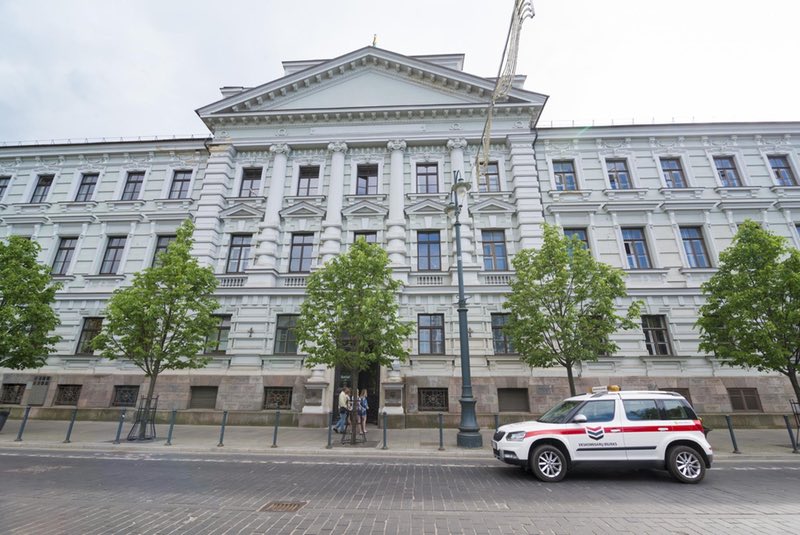
Vilnius, Lithuania
Type: Museum Location: Vilnius, Lithuania Closest Airport: Vilnius
Until 1991, Vilnius, Lithuania was home to a full operation KGB headquarters and prison.
Nowadays it has been converted into the Museum of Genocide Victims showing exhibits to educate visitors about the repression of Lithuanian citizens under Soviet rule, including the deportations to Siberian gulags.
Both the German Gestapo and the KGB have operated within the building committing and planning numerous atrocities. For most people, the events that happened in Lithuania under the rule are unfamiliar as it is not a thing that is taught in Western Europe so there is no better place to go and learn that this useful and educational museum.
Over 75,000 Lithuanians disappeared during the Soviet rule with gulags, and others put in prison or executed. There was extensive exploitation of natural resources by the communist government and a number of Lithuanians attempted to resist the government and form a rebellion but the KGB was quick to round up, torture, and kill anyone with reported links to rebel activity.
The museum includes a basement with KGB prison cells and an execution room showing visitors some of the ghastly elements of this extremely dark site. Political prisoners, as well as local Lithuanians, were interrogated and tortured here with over 1,000 victims being killed in their execution room.
Some of the basement cells are completely preserved, not having changed a bit since they were last operational in 1991 giving the museum true authenticity.
“ This museum provides insight into KGB ways of working. Chilling. It also is an ode to the many brave Lithuanian partisans. For decades they fought for their freedom which finally came after the 1989 Singing Revolution. I learned so much.”
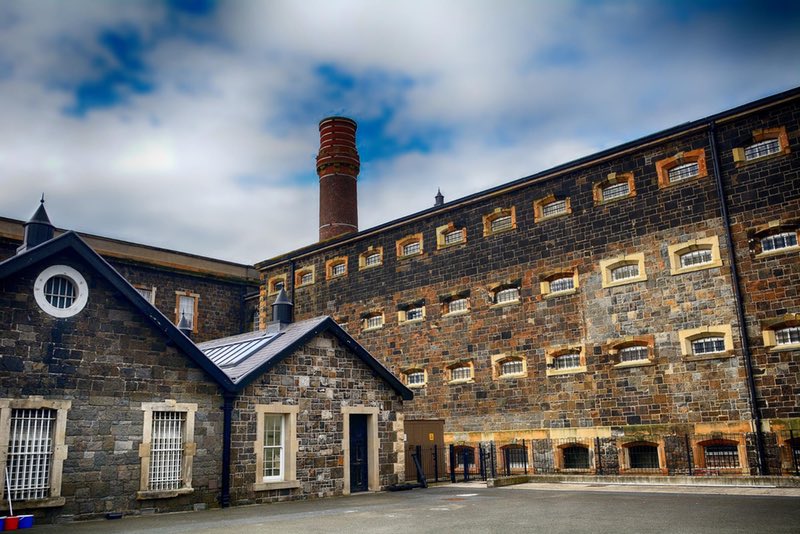
Troubles Tours, Northern Ireland
Type: City Tour Location: Belfast, Northern Ireland Closest Airport: Belfast
Now known as the Emerald of Ireland, Belfast was once associated more with gruesome than green.
For years, from the sixties well into the late nineties, no one wanted to step foot in Belfast due to ‘The Troubles.’ Now, in post-Troubles Belfast, tourists flock to the streets to learn about the brutal history of the IRA.
‘The Troubles’ refers to the period of time in Belfast where nationalists and unionists were in conflict. This conflict, often described as a guerrilla war, was ended in 1998 by the Good Friday Agreement.
Today you can get a black taxi tour of the city where you will be driven to various areas of significance during the troubles. From political murals the Falls and the Shankill which show their own graphic tale of the Troubles of Northern Ireland to the peace line that was used to keep nationalists and unionists apart during these times and lead to further division among the communities.
You can also get a tour of Crumlin Road Jail and Court House. This old Victorian building played a significant role in ‘The Troubles.’ It is the place where many people involved in the war were convicted, imprisoned, and even executed. In these courthouses, the true stories of many bombing, killings, and tortures came to light, and children were even once held within its cells.
“The visit to Crumlin Road Jail gave us a real feeling of what it was like to be in prison in the 19th century. It also includes a sobering and informative look at the execution cell and all that happened there. Not for the nervous sort.”
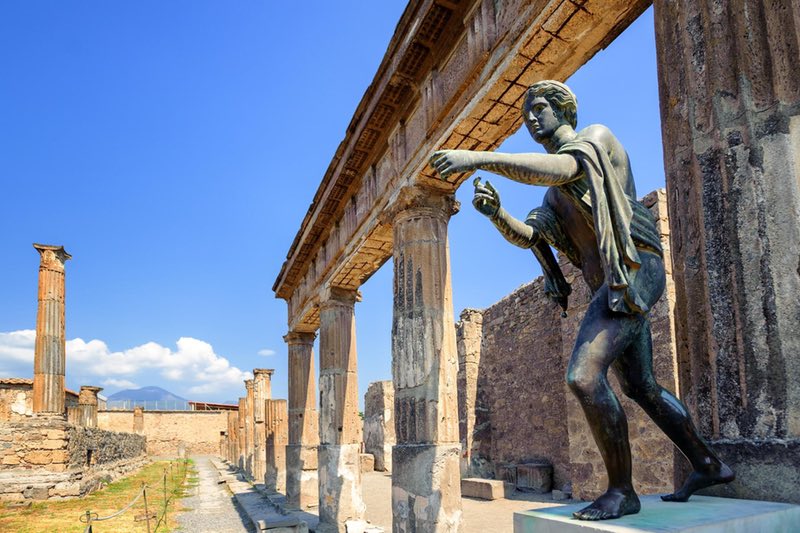
Pompeii, Italy
Type: Archeological site Location: Pompeii, Italy Closest Airport: Naples
Pompeii has been famed for centuries for its volcanic eruption in 79AD that left the entire city in ruin. It is probably one of the oldest dark sites in Europe and although the term ‘dark tourism’ was coined fairly recently, people have been making the voyage to see the destroyed city for centuries.
An important site for archaeologists or anyone interested in history, the site is the largest and most well preserved Roman town. The very reason the ancient city was preserved so well is the same reason it became a dark tourism spot – the covering of ash it got the night of the disastrous eruption of Mt Vesuvius.
The site lay covered in ash but was discovered in the 18th Century and has since held a draw for those interested in the grim and gruesome. In the archaeological dig of the site, a number of both glorious and gruesome discoveries have been made from beautiful mosaics to perfectly preserved human bodies.
The bodies are the main draw for many dark tourists – seeing perfectly preserved roman citizens as they try to flee the eruption, displaying the last agonizing moments of Pompeii is a once in a lifetime opportunity.
A number of the bodies on display within the site are actually made from plaster and come from the “Alley of Skeletons.” One of the streets in Pompeii had several air pockets in it that were the outlines of human remains so archaeologists poured plaster into the voids and waited for it to harden revealing victims contorted in various positions as they try to shield themselves from volcanic lava and ash.
“This place is amazing; you can really imagine how it was to live in Ancient Rome. Incredible remains that have been preserved so well. Beautiful mosaics. Amazing cobbled streets.”
(Tripadvisor 2018)
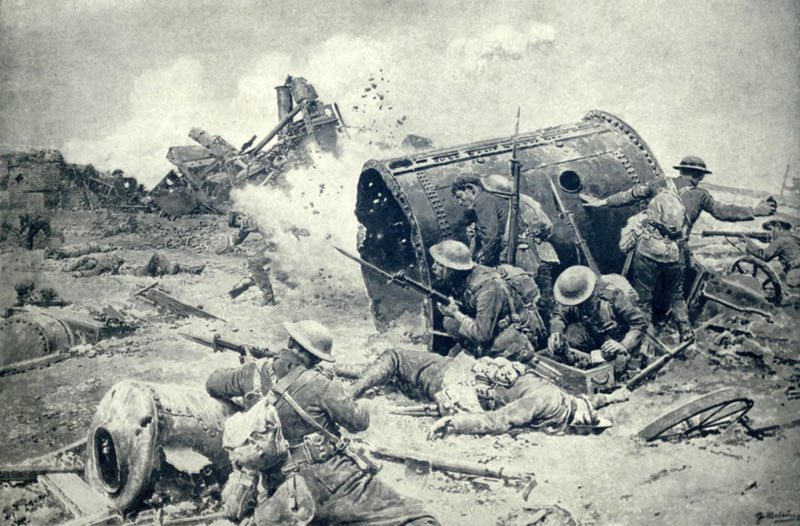
The Battle of the Somme, France
Type: Battlefield Location: Somme, France Closest Airport: Paris
As soon as someone mentions The Battle of the Somme, in your mind, you immediately conjure up the bloody images of a World War 1 battlefield. At this spot, three million soldiers of about 20 nationalities fought along 45km of land.
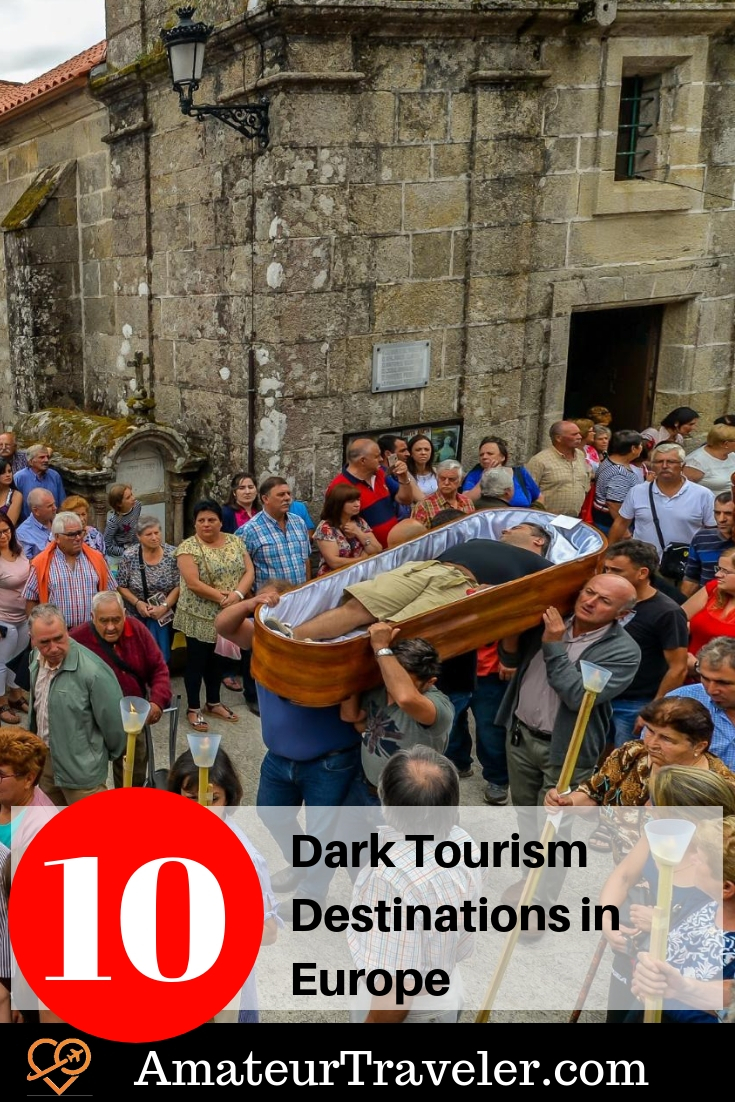
Today and forever the Somme will be scarred by the great battle that took place here. You can take a walking tour along the battlefield and see many of the trenches still in place as well as a walk among the cemeteries and memorials put up in the area for all those who died there.
The landscape tells the story of the battle as explosions, ruins, and shell holes mark the land. The Lochnagar Crater is the only remaining mine hole that you can visit on the Western Front and it is quite a sight at 91m in diameter and 21m deep.
You can also visit Historial de la Grande Guerre along the riverfront in the town of Peronne. It is home to an extensive ray of trilingual exhibitions which include loads of interactive media and are thought-provoking and educational.
“I learnt so much and saw how so many died there and so many classed as ‘missing’ in unmarked graves. A part of history we should not forget and never let happen again.”
Related Posts
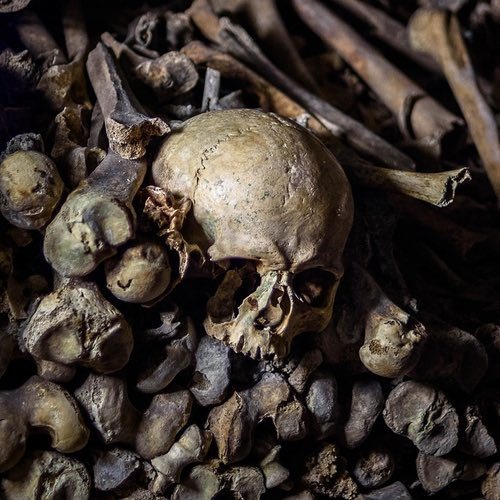
by Chris Christensen
+Chris Christensen | @chris2x | facebook
3 Responses to “10 Dark Tourism Destinations in Europe”
Darkly amusing, sad, interesting, mesmerizing post. Thanks for some great off-the-beaten-track travel ideas! I’m in Vienna right now and just heard of an “Ugly Vienna Tour”, showing the darker side of this bright and polished city. I kind of like seeing the gritty reality so I may check it out.
I thought people would like this one when it was pitched to me. 🙂
Costa Concordia Shipwreck, Italy On the evening of January 13th, 2012, the cruise industry was forever changed after the modern, family cruise ship, the Costa Concordia collided with rocks and sank off the coast of Italy. The thought of a modern cruise ships, catering to families and couples on a romantic Mediterranean getaway, would be able to sink like she did, is truly unfathomable
Leave a Reply
Name (must be a real name) (required)
Mail (will not be published) (required)
Tags: article , dark tourism , france , germany , italy , lithuania , northern ireland , scotland , spain , ukraine , united kingdom

Guides / Resources
- Getting Started Traveling
- Guide to Round The World (RTW) Tickets
- 27 Websites for Booking Hotels and Alternate Accommodations
- First Time Cruise Tips – Planning a Cruise
- How to Start an Airbnb – Tips from an Airbnb Superhost
- Travel Resources – What I Pack
- Map of San Francisco by Neighborhood and What to See by Neighborhood
- Guide to the Monterey Peninsula
- Missions of California Map – All 21 California Missions from South to North

Sign up for our newsletter and get the eBook "How To Save Money Booking Your Travel Online"
World Regions
- California Travel
- Episode Map
- Inside Chris's Head Blog
- My CafePress Store
- My Etsy Store
- The Bible Study Podcast
- Tourism Marketing Consulting
- Privacy Policy
- Amateur Traveler Media Kit
- Working with Amateur Traveler
- Pitch me a Podcast Episode
- Guest Post Guidelines
- Travel with Amateur Traveler group
- The Amateur Traveler Manifesto
- Share full article
Advertisement
Supported by
Beaches? Cruises? ‘Dark’ Tourists Prefer the Gloomy and Macabre
Travelers who use their off time to visit places like the Chernobyl nuclear plant or current conflict zones say they no longer want a sanitized version of a troubled world.

By Maria Cramer
North Korea. East Timor. Nagorno-Karabakh, a mountainous enclave that for decades has been a tinderbox for ethnic conflict between Armenians and Azerbaijanis.
They’re not your typical top tourist destinations.
But don’t tell that to Erik Faarlund, the editor of a photography website from Norway, who has visited all three. His next “dream” trip is to tour San Fernando in the Philippines around Easter , when people volunteer to be nailed to a cross to commemorate the suffering of Jesus Christ, a practice discouraged by the Catholic Church.
Mr. Faarlund, whose wife prefers sunning on Mediterranean beaches, said he often travels alone.
“She wonders why on earth I want to go to these places, and I wonder why on earth she goes to the places she goes to,” he said.
Mr. Faarlund, 52, has visited places that fall under a category of travel known as dark tourism , an all-encompassing term that boils down to visiting places associated with death, tragedy and the macabre.
As travel opens up, most people are using their vacation time for the typical goals: to escape reality, relax and recharge. Not so dark tourists, who use their vacation time to plunge deeper into the bleak, even violent corners of the world.
They say going to abandoned nuclear plants or countries where genocides took place is a way to understand the harsh realities of current political turmoil, climate calamities, war and the growing threat of authoritarianism.
“When the whole world is on fire and flooded and no one can afford their energy bills, lying on a beach at a five-star resort feels embarrassing,” said Jodie Joyce, who handles contracts for a genome sequencing company in England and has visited Chernobyl and North Korea .
Mr. Faarlund, who does not see his travels as dark tourism, said he wants to visit places “that function totally differently from the way things are run at home.”
Whatever their motivations, Mr. Faarlund and Ms. Joyce are hardly alone.
Eighty-two percent of American travelers said they have visited at least one dark tourism destination in their lifetime, according to a study published in September by Passport-photo.online, which surveyed more than 900 people. More than half of those surveyed said they preferred visiting “active” or former war zones. About 30 percent said that once the war in Ukraine ends, they wanted to visit the Azovstal steel plant, where Ukrainian soldiers resisted Russian forces for months .
The growing popularity of dark tourism suggests more and more people are resisting vacations that promise escapism, choosing instead to witness firsthand the sites of suffering they have only read about, said Gareth Johnson, a founder of Young Pioneer Tours , which organized trips for Ms. Joyce and Mr. Faarlund.
Tourists, he said, are tired of “getting a sanitized version of the world.”
A pastime that goes back to Gladiator Days
The term “dark tourism” was coined in 1996, by two academics from Scotland, J. John Lennon and Malcolm Foley, who wrote “Dark Tourism: The Attraction to Death and Disaster.”
But people have used their leisure time to witness horror for hundreds of years, said Craig Wight, associate professor of tourism management at Edinburgh Napier University.
“It goes back to the gladiator battles” of ancient Rome, he said. “People coming to watch public hangings. You had tourists sitting comfortably in carriages watching the Battle of Waterloo.”
Professor Wight said the modern dark tourist usually goes to a site defined by tragedy to make a connection to the place, a feeling that is difficult to achieve by just reading about it.
By that definition, anyone can be a dark tourist. A tourist who takes a weekend trip to New York City may visit Ground Zero. Visitors to Boston may drive north to Salem to learn more about the persecution of people accused of witchcraft in the 17th century. Travelers to Germany or Poland might visit a concentration camp. They might have any number of motivations, from honoring victims of genocide to getting a better understanding of history. But in general, a dark tourist is someone who makes a habit of seeking out places that are either tragic, morbid or even dangerous, whether the destinations are local or as far away as Chernobyl.
In recent years, as tour operators have sprung up worldwide promising deep dives into places known for recent tragedy, media attention has followed and so have questions about the intentions of visitors, said Dorina-Maria Buda, a professor of tourism studies at Nottingham Trent University .
Stories of people gawking at neighborhoods in New Orleans destroyed by Hurricane Katrina or posing for selfies at Dachau led to disgust and outrage .
Were people driven to visit these sites out of a “sense of voyeurism or is it a sense of sharing in the pain and showing support?” Professor Buda said.
Most dark tourists are not voyeurs who pose for photos at Auschwitz, said Sian Staudinger, who runs the Austria-based Dark Tourist Trips , which organizes itineraries in the United Kingdom and other parts of Europe and instructs travelers to follow rules like “NO SELFIES!”
“Dark tourists in general ask meaningful questions,” Ms. Staudinger said. “They don’t talk too loud. They don’t laugh. They’re not taking photos at a concentration camp.”
‘Ethically murky territory’
David Farrier , a journalist from New Zealand, spent a year documenting travels to places like Aokigahara , the so-called suicide forest in Japan, the luxury prison Pablo Escobar built for himself in Colombia and McKamey Manor in Tennessee, a notorious haunted house tour where people sign up to be buried alive, submerged in cold water until they feel like they will drown and beaten.
The journey was turned into a show, “Dark Tourist,” that streamed on Netflix in 2018 and was derided by some critics as ghoulish and “sordid.”
Mr. Farrier, 39, said he often questioned the moral implications of his trips.
“It’s very ethically murky territory,” Mr. Farrier said.
But it felt worthwhile to “roll the cameras” on places and rituals that most people want to know about but will never experience, he said.
Visiting places where terrible events unfolded was humbling and helped him confront his fear of death.
He said he felt privileged to have visited most of the places he saw, except McKamey Manor.
“That was deranged,” Mr. Farrier said.
Professor Buda said dark tourists she has interviewed have described feelings of shock and fear at seeing armed soldiers on streets of countries where there is ongoing conflict or that are run by dictatorships.
“When you’re part of a society that is by and large stable and you’ve gotten into an established routine, travel to these places leads you to sort of feel alive,” she said.
But that travel can present real danger.
In 2015, Otto Warmbier , a 21-year-old student from Ohio who traveled with Young Pioneer Tours, was arrested in North Korea after he was accused of stealing a poster off a hotel wall. He was detained for 17 months and was comatose when he was released. He died in 2017, six days after he was brought back to the United States.
The North Korean government said Mr. Warmbier died of botulism but his family said his brain was damaged after he was tortured.
Americans can no longer travel to North Korea unless their passports are validated by the State Department.
A chance to reflect
Even ghost tours — the lighter side of dark tourism — can present dilemmas for tour operators, said Andrea Janes, the owner and founder of Boroughs of the Dead: Macabre New York City Walking Tours.
In 2021, she and her staff questioned whether to restart tours so soon after the pandemic in a city where refrigerated trucks serving as makeshift morgues sat in a marine terminal for months.
They reopened and were surprised when tours booked up fast. People were particularly eager to hear the ghost stories of Roosevelt Island, the site of a shuttered 19th-century hospital where smallpox patients were treated .
“We should have seen as historians that people would want to talk about death in a time of plague,” Ms. Janes said.
Kathy Biehl, who lives in Jefferson Township, N.J., and has gone on a dozen ghost tours with Ms. Janes’s company, recalled taking the tour “Ghosts of the Titanic” along the Hudson River. It was around 2017, when headlines were dominated by President Trump’s tough stance on refugees and immigrants coming into the United States.
Those stories seemed to dovetail with the 100-year-old tales of immigrants trying to make it to New York on a doomed ship, Ms. Biehl said.
It led to “a catharsis” for many on the tour, she said. “People were on the verge of tears over immigration.”
Part of the appeal of dark tourism is its ability to help people process what is happening “as the world gets darker and gloomier,” said Jeffrey S. Podoshen , a professor of marketing at Franklin and Marshall College, who specializes in dark tourism.
“People are trying to understand dark things, trying to understand things like the realities of death, dying and violence,” he said. “They look at this type of tourism as a way to prepare themselves.”
Mr. Faarlund, the photo editor, recalled one trip with his wife and twin sons: a private tour of Cambodia that included a visit to the Killing Fields , where between 1975 and 1979 more than 2 million Cambodians were killed or died of starvation and disease under the Khmer Rouge regime.
His boys, then 14, listened intently to unsparing and brutal stories of the torture center run by the Khmer Rouge. At one point, the boys had to go outside, where they sat quietly for a long time.
“They needed a break,” Mr. Faarlund said. “It was quite mature of them.”
Afterward, they met two of the survivors of the Khmer Rouge, fragile men in their 80s and 90s. The teenagers asked if they could hug them and the men obliged, Mr. Faarlund said.
It was a moving trip that also included visits to temples, among them Angkor Wat in Siem Reap, and meals of frog, oysters and squid at a roadside restaurant.
“They loved it,” Mr. Faarlund said of his family.
Still, he can’t see them coming with him to see people re-enact the crucifixion in the Philippines.
“I don’t think they want to go with me on that one,” Mr. Faarlund said.

52 Places for a Changed World
The 2022 list highlights places around the globe where travelers can be part of the solution.
Follow New York Times Travel on Instagram , Twitter and Facebook . And sign up for our weekly Travel Dispatch newsletter to receive expert tips on traveling smarter and inspiration for your next vacation. Dreaming up a future getaway or just armchair traveling? Check out our 52 Places for a Changed World for 2022.
Maria Cramer is a reporter on the Travel desk. Please send her tips, questions and complaints about traveling, especially on cruises. More about Maria Cramer
Open Up Your World
Considering a trip, or just some armchair traveling here are some ideas..
52 Places: Why do we travel? For food, culture, adventure, natural beauty? Our 2024 list has all those elements, and more .
The Alaska Highway: On an epic road trip, a family plots a course from Alaska to the Lower 48, passing through some of Canada’s most spectacular scenery .
Minorca: Spend 36 hours on this slow-paced Spanish island , which offers a quieter and wilder retreat than its more touristy neighbors.
Japan: A new high-speed train stop unlocks Kaga, a destination for hot springs, nourishing food and traditional crafts , as an easy-to-reach getaway from Tokyo.
London: The Victoria and Albert Museum is a treasure trove of art and design. Here’s one besotted visitor’s plan for taking it all in .

20 Unique Dark Tourism Sites Around The World
Disclosure: Advertising and affiliate services, including Amazon Associates, help the cost of running my blog. Clicking ads or making purchases through affiliate links may, at no additional cost to you, earn me a small commission. I appreciate your support .

One of the most unique tourism trends in recent years might have to be the fascination with so-called dark tourism sites. There’s always been a curiosity when it comes to places that might have a historic connection with tragic events. But while there are many reasons for people wanting to visit such sites, dark tourism is not a bad thing.
You might argue that visiting these dark tourism sites is a way of preserving the past. Or making sure the same horrific things don’t happen again . And while you might get some mixed reactions from people about your travel plans, they are fascinating places. And I believe they are places that the world should know about.
Disclaimer: The following article has travel suggestions in both Russia and Ukraine, however was written before the current events unfolded. I have chosen to leave them in this article in the spirit of the original topic covered here, however I am in no way recommending visiting either Russia or Ukraine at this time . Please check current travel conditions for any country you plan on visiting and travel safely.
What is Dark Tourism?
Dark tourism sites are places which we can associate with death, destruction or some kind of disaster. While some might see them as morbid, you’d be surprised at how many places you’ve visited with such connotations. For example, have you ever been to the Tower of London? Full of torture chambers and stories of gruesome events. What about the Colosseum in Rome? The deadly gladiator events here were some of the most bloody spectator sports in history.
We think of them as historical sites in a way we don’t think of some of the following places in the same way. Is it because that was so long ago? Does the length of time before we start exploring these sites really make a difference in how our visiting them should be perceived?
How should I behave at dark tourism sites?

Societal rules about museums are ingrained in us from an early age. But a lot of people worry about what to do while visiting somewhere with such a dark past. How do you behave? What if you do the wrong thing?
Respect is key . Remember that these sites, while open for you to enjoy, learn and experience, are the sites of some pretty bad and horrific things . Be aware of those around you as you never know if they might have a connection to where you are.
While it’s unfair to say you shouldn’t talk or show enthusiasm, use common sense and read the room . A concentration camp is nowhere to be giggling with your friends, a memorial park is not somewhere to be shouting…you get the idea.
Unique Dark Tourism Sites To Visit
Whether you’re a big history buff or just curious in anything a little macabre, these are some dark tourism sites around the world you likely don’t want to miss. From recent tragic events to centuries-old historical happenings, you can’t deny how incredibly interesting these places are.
Alcatraz Prison – San Francisco, USA

Possibly one of the most eerie and fascinating dark tourism sites you will ever visit is Alcatraz . A prison so notorious that it still receives millions of visitors a year. Located on an island in San Francisco ‘s bay area, you now get to experience seeing it from the inside like a prisoner. So close to land but so far away.
The only way to reach Alcatraz island is by a pre-booked boat tour . The tour is popular and often sells out months in advance. There are no food or drinks allowed except at the boat dock area, so plan your day accordingly. You also have a steep walk to the prison at the top of the hill, but there are motorized vehicle transfers for those with mobility issues.
Explore the prison and the grounds with an impeccably narrated audio tour by former guards and inmates. You’ll be led through cells, the recreation areas, the kitchen and more. Learn about the riots, the escapes and the deaths that happened here, and the most famous prisoners to ever call Alcatraz home.
Gravensteen Castle – Ghent, Belgium
Contributed by Cecilie from Worldwide Walkers

Gravensteen Castle in Ghent is a classic example of dark tourism sites in Europe. The castle was built back in 1180 and housed the Count of Flanders for many centuries until it became a court, a prison, and even a cotton factory.
It’s the dark horror stories of torture that really attract visitors to Gravensteen castle. While visiting, you’ll walk through torture rooms and see all the different tools used to punish criminals back in the Middle Ages.
Many people have died within the castle walls in the most horrific ways, which creates a dark haunted feeling to the place. It’s this uncomfortable feeling that leaves you both intrigued and distressed after your visit.
While it might sound very disturbing, the free audio guide does a wonderful job carrying out all the stories in an interesting way with respect to history. It’s a great place to learn about the history of Belgium’s city Ghent . You can even get one of the greatest city views from the castle roof.
Silver Mines – Potosi, Bolivia
Contributed by Deb from The Visa Project

While there are many landmarks to see in Potosi , a unique attraction is to visit one of these working mines. A guided tour let’s you witness the working conditions of the miners.
If you live in Bolivia , you would come across many extreme tourist offerings but this one would probably be one of the darkest. The Cerro Rico mountains silver mines made Potosi a major economic center of the Spanish empire back in the colonial times.
Mining is more or less still done in 18th century style – using old tools, hand and dynamite. No modern safety equipment or protocols. Although you would be introduced to El Diablo, the mountain’s devil-god to who the miners offer cigarettes, liquor as well as blood of an animal slaughtered on the spot for their protection. Child labor is pretty common and you can buy dynamite in the local market!
You will be advised to chew on coca leaves to help with breathlessness if taking a tour through the mines . The miners work in really harsh and dangerous conditions and many get lung diseases afterwards. If you visit, definitely leave a generous tip for the miners.
Port Arthur Penal Colony – Tasmania, Australia
Contributed by Mark from Wyld Family Travel

Port Arthur lies at the bottom of the world in southern Tasmania Australia . Port Arthur was a British penal colony set up in Australia, designed to break prisoners both mentally and physically. To be sent here from England was being sent as far away from your home as possible.
The youngest prisoner was 11 years old and around 70,000 prisoners called Port Arthur home. Prisoners at Port Arthur endured harsh working gangs that built much of Tasmania. The Asylum at the site pays testament to the mental torture these convicts were put through with many slowly losing their minds. Prisoners were regularly flogged to break them into submission.
Port Arthur prison was opened 20 years from 1833-1853 and 7,000 convicts died there. In modern times Port Arthur is also the location for the largest mass shooting in Australian history. This was the catalyst for the strict gun rules Australia lives by now.
Port Arthur is today one of the most interesting places to visit when in Tasmania. The prison site has been preserved with original building and tours explaining the history of the location.
Museum of the Occupation of Latvia – Riga, Latvia

As a former Soviet occupied country, Latvia still has many historic sites linked to the KGB. One of the most interesting activities you can do in Riga is visit the Corner House. This was the old headquarters of the Soviet KGB in Latvia.
True KGB style, if you didn’t know this museum existed you might not be able to find it. A inconspicuous doorway leads into a building straight out of the 50s. Here you can find out about the KGB in the city at that time.
The museum is free or you can pay 10 EUR for a guided tour. The tour might be worth it to see parts of the museum you wouldn’t otherwise get to. Walk through the rooms where the KGB worked and to areas of the building where the prisoners would have been taken.
The storyboards depict historical stories of the KGB in Riga, Latvia , and the “criminals” they arrested, tortured and killed here. This is really one of the most unique dark tourism sites in the Baltic states.
Jallianwala Bagh Memorial Park – India
Contributed by Neha from Travelmelodies

Etched in the history of India as a dark moment, is the incident of Jallianwala Bagh. Located in the holy city of Amritsar in Punjab, it remains one of the most popular places to visit in Amritsar . Jallianwala Bagh is a memorial park in the honor the people that were wounded and lost lives on the fateful day of 13 April, 1919.
Back in 1919, India was under the rule of British and the people of India were protesting for Independence. Over a thousand people had gathered in the Jallianwala park on the festive day of Baisakhi to silently protest the arrest of few national leaders. But General Dyer opened fire unannounced on these people killing and injuring many.
The Jallianwala Bagh now houses a museum with pictures and documents related to the event and some memorial structures in honor of the martyrs. There is a ‘Martyrs Well’ in which some people jumped to save themselves from the bullets. There’s even a wall with bullet markings on it.
Every evening there is a light and sound show that throws light on the unfolding of the event. It is a must visit place and is located next to the Golden temple.
Gori, Georgia
Contributed by Emily from Wander-Lush

The small city of Gori,Georgia has a rather dark claim to fame. It’s the birthplace of Ioseb Jughashvili, better known as former Soviet dictator Joseph Stalin.
An easy day trip from Tbilisi , Gori has become one of the most-visited places in Georgia because of its Stalin connection. The main attraction is the Stalin State Museum, a grandiose sandstone building in the center of the city.
In the yard is one of few remaining Stalin statues still standing in Georgia today. Also the small wooden house where Stalin was born in 1878, and the armored railway carriage he used to travel around the USSR.
The museum opened in 1957 and exhibits remain much the same – that is to say, very Soviet-style. It has a very selective curatorial approach with most artefacts relating to Stalin’s early years and some pretty glaring gaps. With limited information in English it’s recommended to take the guided tour for a few extra dollars.
Visiting the museum is a totally bizarre experience, but it gives an interesting insight into how Stalin’s memory is treated in Georgia today. Some people in Gori (and elsewhere in Georgia) still venerate the dictator, but the younger generations less so.
There are plenty of things to do in Gori that have nothing to do with Stalin. The magnificent Gori Castle, the old town, and the hilltop Gori Jvari church. It’s these attractions that most residents would prefer you remember Gori for.
Tham Piew Cave – Laos
Contributed by Marie from A Life Without Borders

Laos holds the unfortunate title of the most heavily bombed country on Earth. It bore the brunt of clandestine bombing campaigns waged by the USA on Laos during the 1960s and 1970s. Phonsavan in the province of Xieng Khouang, was particularly decimated. In fact, unexploded ordnance still affects local communities to this day.
Many visitors to the region enjoy Phonsavan’s major tourist sights such as the UNESCO site Plain of Jars. But few venture off the beaten track to discover the site of one of the worst days in Lao history.
On 24 November 1968, just one single missile fired from a US fighter plane killing 374 innocent villagers taking refuge in Tham Piew Cave. Just 60 kilometers from Phonsavan city, the cave is a somber and emotional place to visit. But it is important in the turbulent history of Laos, even if little known throughout the rest of the world.
The site’s information center holds extremely confronting photographs of the immediate aftermath of that fateful day, together with the history of the Secret War in Laos. A moving statue of a man carrying a lifeless child marks the entrance to the memorial park. Walk through a peaceful forest to the mouth of the charred cave. Here visitors can leave offerings of incense at the small shrine for those who perished within.
Chernobyl Exclusion Zone, Ukraine
Contributed by Kami from My Wanderlust

The Chernobyl Exclusion Zone is a well-known place all over the world. On April 26th, 1986 the biggest nuclear disaster in the world took place here, changing people’s lives forever. As a result of the catastrophe, the whole area around the power plant became a closed zone. Inhabitants of numerous towns and villages had to move away.
Today you can visit the Exclusion Zone but you need to do it with an official Chernobyl tour . There are plenty of them departing from Kyiv daily and you can choose between day trips and multiday tours. Now, all these years after the disaster the area is safe to visit and the radiation is low.

During your trip, you will see numerous places in the zone, including the power plant itself. But the biggest highlight is the abandoned town of Pripyat. When the disaster happened it was one of the most modern cities in the former USSR, but now nature has taken over the place.
Keep in mind that even if the Chernobyl zone is a very touristy and popular place, it is also a place of great tragedy. Make sure to visit the place with respect and follow your guide’s instructions. Still, this is a fascinating place to visit and everyone visiting Ukraine should include a Chernobyl tour in their itinerary .
Catacombs – Paris, France
Contributed by Debbie from World Adventurists

Even the City of Light and Love has a dark history. One of the most fascinating places to visit is the Catacombs of Paris . The Catacombs have a sad history, full of bones of the unknown. In the 17th century, Paris cemeteries were overflowing so badly that there was no longer space to properly bury their dead. Overflowing graves led to the solution of using the underground tunnels to house the bones.
Approximately six million people have been laid to rest underground. Today the bones are neatly stacked, including some designs made from the bones. At some points there are femurs arranged from the floor almost to the ceiling, with rows of skulls in between, or formed into shapes like a cross.
Visiting the Catacombs, it will make you really wonder what their lives were like back then, who they were, and the cause of each death. It is very humbling.
The Catacombs of Paris are extremely popular. It is more expensive, but to skip the line, you will want to buy your ticket in advance . It can also get chilly down there, so bring a light sweater with you. Allow for at least an hour and a half to wander the Catacombs once you are inside.
Lenin Mausoleum – Moscow, Russia
Contributed by De Wet & Jin, Museum of Wander

In the center of the Red Square in Moscow is a somewhat inconspicuous structure which reminds somewhat of a pyramid. But the long line of Russians and tourists is a giveaway that it is one of the most popular things to do in Moscow .
Inside this step pyramid is where the embalmed body of Vladimir Lenin is on display. Everyone is welcome to visit and pay their respects, or simply come and look at the former Soviet leader for bragging rights.
Visitors to Lenin’s Mausoleum visitors are first searched by military personnel, and bags (and cameras) have to be deposited. There are also a few strictly enforced rules while inside the mausoleum: no talking, hands out of your pockets, no hats and the line must keep moving at all times. Disobey, and a Russian soldier will reprimand you.

The atmosphere as well as the temperature inside the mausoleum is chilling. The line moves quite slowly, so you’ll get a good look at Lenin’s body, which has been on display here for almost a hundred years.
The mausoleum is free to enter and open on Tuesdays, Wednesdays, Thursdays, and Saturdays from 10:00–13:00. Behind the mausoleum is the gravesite of former Soviet ruler, Joseph Stalin, another interesting place to see.
Tianenmen Square – Beijing, China

Dark tourism sites don’t come more secretive than that of one of the world’s biggest massacres in recent history. Tianenmen Square, the public square in China’s capital, Beijing . While most visitors to China will have heard of the Tianenmen Square Massacre, the event is so censored within China that many people don’t know the full extent of it.
In 1989 students led a 6 week long protest after the death of a pro-reform official from the Communist Party of China. The fear was that the country would fall into economic decline and that the corruption in place would become worse. As the protests continued the military were brought in and things quickly got out of hand.
There are varying reports of anywhere from 300-3000 deaths of the tens of thousands of people who protested. While the square is peaceful now, there is always a high security presence as well as airport-style check points.
The square is used for many important national celebrations and Chairman Mao Zedong announced the founding of the People’s Republic of China here in 1949. His embalmed body is now on display in a mausoleum there.
Other than that there’s not a lot happening in the square now. However, the Imperial Palace (also known as the Forbidden City) is across from Tianenmen and is an impressive place to visit.
Bodie ghost town, California USA
Contributed by Olivia from Girl With Blue Sails

Bodie State Historic Park, once a booming California gold town, is now a notorious ghost town. It sits in a memorialized state of “arrested decay” with dilapidated buildings preserved in their state of abandonment from the late 1800’s. Walking down the dusty, dirt roads of Bodie invokes a bit of a dark appreciation and wonder about what happened to the people that lived here.
Visitors can walk through the main streets of the town, seeing the various houses, stores, and saloons. Canned goods still on store shelves, original newspapers in the buildings, and old wooden pews still in the church. There are old forgotten cars in the grass, rusting and being overgrown by nature.
Bodie is most popular with history buffs, photographers, and those who love to visit dark tourism sites. Plan your trip to Bodie in the morning to avoid the peak desert heat. While walking through Bodie can be a grim experience, it also provides a unique and realistic glimpse of 1800s California mining life.
Choeung Ek Killing Fields – Phnom Penh, Cambodia
Contributed by Tasha Amy from Backpackers Wanderlust

The Killing Fields, also known as Choeung Ek Geocidal Centre, is located just a short 17 kilometer journey from Phnom Penh city center . This closeness is important considering the horrible events which occurred here between 1975 and 1979.
During this period, Cambodia was run by the Khmer Rouge Regime communist party who arrested and executed anyone they saw as a threat. This included people with education, opposing beliefs, or anyone who stood up for what was right.
Quite a few foreigners even got executed after accidentally stumbling upon Cambodia during this period. Children were trained as soldiers and those who were disobedient were killed. For a greater understanding of life under the direction of the Khmer Rouge and Pol Pot watch the film First They Killed My Father .
The Killing Fields outside of Phnom Penh is just one of many locations across the country. Though this one is the most known due to the fact of the horrible acts performed here.
You can book a tour or visit by tuk tuk. The tuk tuk ride for the day should cost you around $12.00. Once at the Killing Fields make sure you hire the audio guide for the stories of those who lived through these events.
Nazi Rally Grounds – Nuremberg, Germany
Contributed by LeAnna from Wander In Germany

It’s no secret that Germany is riddled with a dark, difficult, and oppressing past. However, decades after WWII, the country does a phenomenal job of walking the fine line between erasing the atrocities and showing respect as well as raising awareness of exactly just what happened.
One such place is the unfinished Nazi Rally Grounds in Nuremberg . These huge grounds were Hitler’s vision for an enormous epi-center and headquarters for the Third Reich.
Walking around the lake at the site, it’s almost easy to not realize exactly what you are standing on. However, on the grounds is the Nazi Dokumentation Zentrum. Here you can see all the blueprints and plans for the grand scheme Hitler envisioned. It makes walking the grounds that much more realistic.
The museum does an exceptional job of showing exactly how a man with such polarizing, disgusting, racist views could enchant not only an entire nation, but take over much of Europe.
While in Germany, doing any sort of Nazi salute or tribute in public is illegal. Therefore, this site is not flocked to by Neo Nazis, but instead is seen as a place of learning from the past.
Guanajuato Mummy Museum – Mexico
Contributed by Shelley from Travel Mexico Solo

The Museo de las Momias (Museum of the Mummies) is one of the most popular places to visit, and best things to do in Guanajuato City, Mexico .
One of the most famous of Mexico’s dark tourism sites has about 100 mummified human bodies on display, in both glass cases and in the open. Most of the bodies are from older adults, but the museum also claims to have the “world’s smallest mummy” of an approximately nine-month-old child.
While not for everyone, it is the most visited place in Guanajuato City . When visiting, you’ll notice Mexican families with children of all ages. In Mexico, death is a much less taboo subject than in other countries — evidenced by annual festivals like Día de Muretos (Day of the Dead).
The story of the mummies is as fascinating (and bizarre) as seeing them in person. Between 1865-1958, Guanajuato’s government decided to start collecting a “grave tax” on buried bodies. If left unpaid by the living relatives for three years, the body was exhumed.
Located in arid Central Mexico, Guanajuato has extremely dry soil and the bodies came out of the ground incredibly well preserved. When the government ended the grave tax in 1958, they had so many mummified bodies that they created this museum.
House of Terror – Budapest, Hungary
Contributed by Marco from Nomadic Fire

Budapest is popular with both tourists and expats for stunning architecture, gorgeous scenery along the Danube river, and affordable cost of living . The city is also home to the infamous museum: the House of Terror.
This museum juxtaposes two of the cruelest regimes of the 20th century: Nazi Germany and Soviet Russia. Fittingly located in a building that was once the headquarters of both the Nazi and Communist secret police, the museum is an important reminder of both the crimes perpetrated by those regimes and their victims’ courage and resistance.
Stepping into the House of Terror transports visitors back to a terrifying time in Europe’s history. The museum’s artifacts include personal items confiscated by the secret police. It also tells stories such as a family’s desperate attempt to hide a young boy and baby girl from the Nazis during the Holocaust. Although now a museum, many rooms remain exactly as they were when the headquarters were operational. This includes prison cells, rooms filled with torture devices, and a guillotine scale model.
You can spend anywhere from 45 minutes to a few hours wandering around this well-curated museum. Through exhibits of movie posters, photos, and re-created scenes.
9/11 Memorial and Museum – New York City, USA

One of the most emotional activities on a trip to New York is visiting the 9/11 museum. Built below the original location of the Twin Towers, the World Trade Center site of the 2001 disaster. Entering the museum from the street level, you descend past the twisted metal remains of the massive steel beams that once held the tower up.
The museum is a somber place which stirs up a lot of raw feelings from anyone who visits. It guides you on a journey from the history of the WTC towers to a timeline of the events of that morning.
With witness testimonials, photographs and messages left by those who didn’t make it, the museum is very hard to experience. But the exhibits also talk about what has happened since, what they have learned and why this site is so important. Outdoors, the footprints of the original towers have now been turned into two giant pools. The name of every single victim is engraved around them.
Did you know that white roses are placed at the name of any victim whose birthday it would have been that day? As dark tourism sites go, this one is especially somber given how recently the event took place. But it’s well worth a visit if you’re in New York .
Imperial Crypt – Vienna, Austria
Contributed by Martina & Jürgen from PlacesofJuma

A really cool spot and interesting dark tourism site not to be missed on any visit to Vienna is the Imperial Crypt. It is a real insider tip among Vienna’s best attractions and a visit is an eerie experience.
The Imperial Crypt is the final resting place of many of the most famous Habsburgs from Europe. Hidden under the Capuchin Church, it can be visited on a guided tour daily from 10:00 to 18:00.
The crypt is the final resting place of 150 members of the Habsburgs. Among the most famous are Emperor Franz Joseph I, Empress Sisi and Crown Prince Rudolf and Maria Theresa. Walking through the ten dark rooms of the imperial crypt, you travel through a 400-year-long stylistic epoch. You’ll see richly decorated coffins are sometimes even adorned with skulls.
The Habsburgs were preoccupied with their death and therefore had the sarcophagus made according to their wishes. Why not take a tour where you will get lots of information about the funeral rituals?
Auschwitz Concentration Camp – Poland
Contributed by Sean from LivingOutLau

Auschwitz is arguably one of the most tragic sites in the entire world. It was the largest of many German Nazi concentration camp and extermination center in World War II. Over 1.1 million men, women, and children, mostly Jews, lost their lives here. The collective genocide of WWII, known as the Holocaust, is one of the most horrific events in human history.
The Auschwitz-Birkenau Memorial and Museum is now a site where visitors can learn more about how the events unfolded, living conditions, defenses that were set up to prevent the captives from escaping and more.

Auschwitz is more than just a popular attraction in Poland; it is a place where visitors can understand human nature. Auschwitz is the standing testimony of the terror that humans can do to each other. It warns out what happens when an ethnic group is dehumanized. A visit to Auschwitz is solemn and eye-opening.
The best way to visit Auschwitz is to take a tour from Krakow , the nearest touristy city from Auschwitz. As part of your Krakow itinerary , don’t forget to book your tour as early as possible. There are multiple languages you can choose to have the tour in and the English-speaking tours are always the first ones to run out!
Visiting popular dark tourism sites
There’s no denying that visiting many of these dark tourism sites around the world is uncomfortable. The atrocities that happened there or the stories they tell are often unfathomable. But dark tourism sites are just as important as any museum or regular attraction.
Whether or not you want to visit any (or all) of the sites on this post, you have to agree that they are truly fascinating. As long as you have good reasons for wanting to visit, and a respectful attitude towards them you will be welcomed.
If you’ve enjoyed reading this post leave a comment or share using the social media buttons below. Which of these dark tourism sites are you most interested in visiting to learn more about?

Share this:
- Share on Tumblr

37 thoughts on “20 Unique Dark Tourism Sites Around The World”
I really appreciate this post and how you emphasized that respect is key. I so agree! I think visiting these places can be very powerful and very educational. I’ve visited four on this list, as well as a few others not mentioned, and am so grateful for those experiences to learn more and witness humanity’s dark history.
Absolutely love the unique concept of this post. I especially appreciated how you included the section on mindfulness and respect. Hope to pay many of these places a visit.
this was a great post… and while these sites aren’t for everyone, i think it’s important to connect with ‘dark’ parts of the past, so we don’t repeat those same mistakes.
It is very rare to come across such posts. I absolutely loved the concept. Keep up the awesome work.
This is such an interesting guide! I have been to a few of these places and I’ve also visited some older prisons around the world that have a dark past to them. I definitely have to visit some of these in the future. Especially the ones in Europe!
This is one of the most unique posts I’ve seen in a while! I honestly haven’t been to most of the places on this list, but I’m bookmarking it for later.
I have visited a number if these sites but never heard of the them, ‘dark tourism’ before. I can understand how the term has come about. I always leave these sites very reflective. There’s no denying they have an enormous impact on me. I have pinned the post because, in my opinion, ‘dark tourisn’ is an important aspect of world travel.
I have been to a few of them and wrote about the profound realizations I went through. Thanks for sharing a thought-provoking post.
I love how you mentioned the importance of respect when visiting these places. These places really make you think! It’s important to not forget the ‘dark’ parts of history so it doesn’t happen again.
I definitely find places that would class as ‘dark tourism’ interesting. Although to be fair, we very rarely remember the ‘good’ and ‘peaceful parts of history so I think most places could be considered ‘dark’ in one way or another! I’ve only visited Alcatraz from the places on this list but it was definitely a fascinating place and I’d love to go back. I’d like to visit the catacombs in Paris too. There’s also a lot on this list that I haven’t heard of before but I’d definitely love to check them out. Thanks for the great guide!
This list is very important given the history of these places! It’s also interesting to note the different feelings at each of them. I haven’t been to every single one, but Auschwitz, Alcatraz, 9/11, the House of Terror, Catacombs, and Gravensteen Castle (wow, I didn’t realize how many I had been to) but all of them were so uniquely dark. I think Auschwitz was my most striking and moving, though.
This is such an interesting post. It’s so heartbreaking to read through some of the dark things that have happened around the world. I believe it’s important that we visit these places to pay our respects and remember the people whose lives were drastically impacted by these places. I appreciated how you emphasized the importance of showing respect at these places. Thank you for sharing this post!
You can learn so much at these dark tourism sites. The 911 memorial has moved me to tears. I’m not sure I could visit the mummy museum.
I’ve been to Alcatraz and the Catacombs, but it was interesting to discover some new ideas from this list. And yes, mindfulness and respect are so important, particularly for several entries on the list.
As a historian I’m interested in visiting these sites, although we’ve skipped them the last years, since we found our son to young for them. I’ve been to 2 of the sites mentioned.
What a great list of dark tourism places to visit! I’ve been to many of these such as Alcatraz, Bodie, Ghent and 9/11 memorial. I’d love to visit Chernobyl and the catacombs in Paris.
What an interesting article and list of places to visit. I’ve visited a few on this list and I agree with you, visiting these places can be very educational, but we need to be respectful.
What a great post. Yes, I have been to a few of these dark tourist sites and am now adding a few more to my bucket list.
What an utterly informative and sobering post. I visited the Killing Fields in Cambodia back in 2013 but today still hold it so close to my heart.
Lenin’s Mausoleum was a surreal experience to say the least. No stopping, no taking photos, only getting a quick glance at Lenin before being ushered out. Auschwitz was another one that was really eye opening for me and a unique although sad experience.
What a fascinating post! I have never visited any of those sites other than the World Trade Center site in NYC. I would be interested in seeing several of them. sites like that are so educational and bring history to the forefront.
Thank you for this important post. I think sites of dark tourism are important for exposing atrocities of the past for many reasons. They allow us to pay tribute to those who have suffered, but more importantly, hopefully they instil in visitors the importance of playing a role in ensuring that history isn’t repeated.
I’m not sure that ‘penal tourism’ (sites such as Alcatraz and Eastern State Penitentiary) need to be included in the category of ‘dark tourism.’ My visits to S-21 and Cheoung Ek in Cambodia can’t be equated to the failings of a penal system. My visits to the Anne Frank House in Amsterdam, Dachau in Germany, or Auschwitz in Poland can’t be compared to Alcatraz.
‘Dark tourism’ and ‘penal tourism’ are important, but… separate.
Thank you for bringing attention to this issue.
that’s a fair point, and I’m in no way comparing one of these places to another, but understand that many people also have different levels of comfort in where they might want to visit so wanted to include a wide range of places. There are certain sites (like the ones you mentioned) that are always going to be the worst of the worst with regards to history. Thanks for reading
Very cool article! Haven’t seen many like this one. I’m actually in Tasmania right now!!
I have not done a lot of tourist type things alone, but one was Alcatraz. Fascinating experience walking that prison by myself and the audio tour.
I love this! I really want to try dark tourism after I saw “Dark Tourist” on Netflix! I totally agree with you, visiting these sites is very educational and an eye opener. And yes, respect is the key. It applies to everywhere we go! I will definitely save this for my future travels! 🙂
This is an interesting list. We’ve visited some already – like the catacombs in Paris. And some – like Tschernobyl are on our bucketlist!
Great compilation! There are so many places to go for dark tourism. And I know I can’t brave to most of them. I guess I can do it with museums. Opss how I missed the Crypt museum in Vienna!
What an interesting and informative article. I’ve been to a few of these sites, as well as a few more that didn’t make your list. I think that travelling is learning- and it’s important to visit places such as these to honour, respect and learn from our past.
In a way, I am really into some aspects of dark tourism, I love things that are creepy or have a ghost story behind it. I did find a few spots on this list that interest me such as the castle in Belgium. Looks beautiful and with an interesting story!
Dark tourism is no doubt not everyone’s cuppa tea. Travel ushers understanding and these sites may serve as monuments that will remind humanity about life itself and not taking the same dark path twice.
Great post Emma, I love visiting places like these (or, in some cases, “love” would definitely not be the appropriate word, but I think they’re important to visit). The hardest place I’ve ever visited is the Killing Fields in Cambodia. Horrendous. The genocide museum in Sarajevo in Bosnia was hard-hitting too. I’d be really interested to visit that KGB museum in Latvia!
Very good topic and original. i agree in most of the places listed, indeed most of them are scenario of some of the darkest moments of humanitty. I have only one thing that I don’t understand by you choose to put Lenin Mausoleum? Independently of the personal believes of rach one, Lenin led the biggest and most sucessul revolution in history . Poeple can like it more or less but I don’t how his resting place is part of dark tourist places….If would be Stalin inside ok, but this one i don’t get it. Great work overall, I am argentinian and I really appreciate that you brought-up the story of Potosi…. Well done! Looking forward for your next post!
Thanks for reading. For this one it’s also more about the fact that you can visit the body of Lenin and that it is on display as dark tourism is focused around often morbid places. There are a few countries that have former leaders on display – Ho Chi Minh in Vietnam, Chairman Mao in China – and I think the idea of visiting one of these places to see an embalmed body on display is a little dark in itself
Got your point! You know that is the same guy who embalmed Lenin and Ho Chi Minh? 😁
Great post! Especially seeing these are all easily accessible, no trespassing required. I have only been to a few, but I really recommend the Nuremberg Ralley Ground and the adjacent museum. Few people visit, and it is quite eerie. Also, the 1936 Olympic Village in Berlin which is similar architecture to Nuremberg rallye grounds, it was really abandoned a few years ago, I think more touristic now.
Have definitely been to a few dark tourist sites but Chernobyl has been on my list for ages now!
One of the most eye opening museums was the Anne Frank in Amsterdam but definitely want to keep visiting some new ones.
Leave a Reply Cancel reply
Your email address will not be published. Required fields are marked *
Notify me of follow-up comments by email.
11 Unnerving Dark Tourism Destinations Around The World
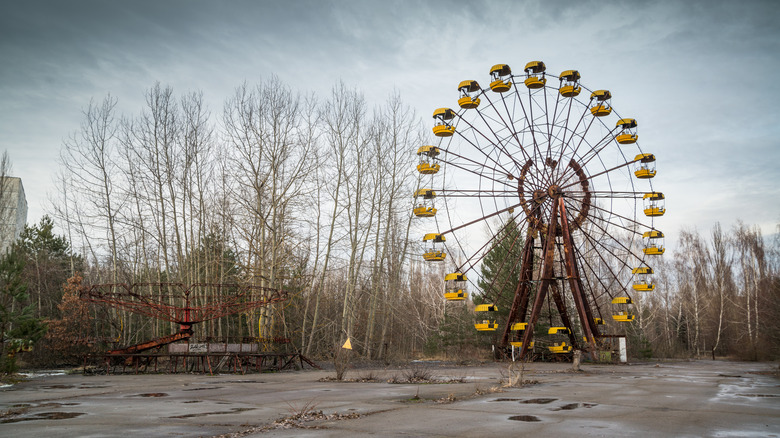
Most people plan their vacation to be the most rejuvenating, relaxing experience of the whole year, but there are a select few who travel the world in the hopes of finding the most disturbing attractions. Ever since the release of the 2018 hit TV show "Dark Tourist," the public has become more aware of and intrigued by the slightly more morbid destinations around the globe. This fascination and hobby is called dark tourism.
According to one survey from Passport Photo Online , 82% of American travelers said they had visited at least one dark tourism destination in their life so far. Most of these dark tourism travelers stated that they visit these types of creepy or depressing places because it allows them to educate themselves and pay respects to people affected by tragedies. Whether they're sad or even borderline scary, the thing that dark tourist destinations usually have in common is that they showcase a realistic, yet sometimes unpleasant, peek into the world's history firsthand.
The Catacombs of Paris
One of the oldest and most famous dark tourism destinations in the world is the Catacombs of Paris. The Catacombs are a deep series of tunnels that were converted into ossuaries as a solution to the overflow of dead bodies filling up Paris' cemeteries and creating a public health crisis in the 18th century. The remains of somewhere between 6 to 7 million people were carefully placed inside the Catacombs and still remain to this day.
Though the deep underground tunnels are very eerie, the Catacombs have been open as a tourist attraction to the public for over two centuries. There are over 200 miles of tunnels in the Catacombs, but most of it is unexplored by regular tourists and only certain portions can be visited on organized tours. Travelers are welcome to join a 1.25-mile walk through this mass underground burial site and its dark history.
The story of Pompeii is one that sticks with a lot of people after a trip to Italy. This Italian city was thriving 2,000 years ago when all of a sudden one day Mount Vesuvius erupted unexpectedly and completely took everyone in the area out. Toxic gas and smoke were carried from the explosion for 20 miles. The citizens' lives were frozen forever under ash until the city was discovered again in 1748.
It was a chilling part of history that really showed how instantaneously life can change. Today, the city of Pompeii is one of the most popular tourist attractions in Italy, but nobody forgets its grisly backstory. There are even casts of the bodies curled up in fear to really hit home the terror of this natural disaster. Travelers visiting Pompeii should opt to join a tour or at least invest in an audioguide to get all the information about the city and the influence of its tragedy.
Alcatraz Island
Most people wouldn't put a prison on their vacation wishlist, but Alcatraz in San Francisco is different. Every single year over 1.4 million people make the journey to visit Alcatraz Island. Dubbed "The Rock," it was open from 1934 to 1963 as a maximum security, inescapable prison right in the middle of San Francisco Bay.
Famous criminals like Al Capone, James "Whitey" Bulger, and George "Machine Gun" Kelly were housed in this hardcore prison for years. Capone even played the banjo in a literal band of inmates during his time at Alcatraz. There is an immense amount of weird, criminal history inside the walls of this famous prison.
Even though it closed its doors as a jail 60 years ago, Alcatraz is still open for the tourism business to this day. There are regular tours to Alcatraz from Pier 33 and it only takes around 20 minutes to reach the island by boat. Just make sure you book your ticket in advance as there is limited availability and visiting Alcatraz is one of the most popular things to do in San Francisco.
Chernobyl Exclusion Zone
In 1986, a deadly catastrophe changed Ukraine and the world forever. A reactor at a huge power plant malfunctioned and it caused a massive steam explosion, creating fires that released the radioactive material in the power plant's core to the nearby area. The results were so toxic that 350,000 people were evacuated.
The effects of Chernobyl (Chornobyl in Ukrainian) were absolutely devastating with two workers dying from the blast, 28 passing away from radiation within weeks of the incident, and 5,000 people who would get cancer over the following years. The event would go on to be called the Chernobyl Incident and it became known around the globe for just how horrible it was.
The Chernobyl incident in Ukraine was by far the worst nuclear disaster in history. It's been long enough since the incident that the area isn't completely toxic anymore and curious dark tourism travelers can visit the Chernobyl Exclusion Zone. Chernobyl is still so dangerous that visitors must be accompanied by a trained guide with radiation monitoring equipment to make sure they don't wander anywhere that's too toxic. Note that currently, tours to Chernobyl are paused for the foreseeable future due to the Russian invasion of Ukraine.
The Poison Garden
Most people add a picturesque botanical garden to their travel itinerary for a relaxing afternoon among the greenery, but Alnwick Garden in Northumberland, England has an area where everything could harm you. The Poison Garden is under lock and key at the Alnwick Garden for good reason: Even a sniff can have devastating effects on the human body.
There are about 100 highly toxic species of plants living inside the Poison Garden right now, including the opium poppy, monkshood (wolfsbane), helleborus odorus (fragrant hellebore), and atropa belladona (deadly nightshade), among many, many others. And despite the danger of the dangerous flora, brave visitors are welcome to walk through if they dare. But be aware. According to Alnwick Garden , visitors are cautioned against interacting with any of the plants, and some people have even passed out just from walking through the garden. Enter at your own risk.
Museum of Death
Travelers are always keen to find the best art and history museums in a city, but the Museum of Death is a much darker sort of attraction. There is a Los Angeles and a New Orleans version of this museum . Established in 1995, the Museum of Death covers the disturbing side of history. The displays are so extreme that families with kids should definitely skip this potentially traumatizing museum.
Inside each location of the Museum of Death, there is an eclectic collection of disturbing artifacts related to murder and death. The Los Angeles museum includes things like art pieces handmade by serial killers, crime scene photos from the Black Dahlia and Manson family murders, body bags, replicas of execution devices, ancient mortician devices, and a real cult recruiting video. The New Orleans iteration includes stuff like letters from infamous killers, eerie crime memorabilia, shrunken heads, and displays about cannibalism. Just make sure you visit on an empty stomach because some of the displays are really messed up and may catch you off guard.
Sedlec Ossuary
It may be pretty unsettling to walk around a chapel constructed of 40,000 human bones, but that's exactly what you're in for when you visit the Sedlec Ossuary in the Czech Republic. This small, countryside Catholic church was originally built back in the 13th century, but it didn't get its unique design update until 1870 when a local woodcarver was given the job to embellish the church with bones from the cemetery and create the disconcerting masterpiece it is today.
Even though it's quite macabre, the Sedlec Ossuary is considered to be a very holy place in the Czech Republic. Inside you can find a chandelier, a family's coat of arms, and religious displays completely made out of bones. The artist who assembled many of the pieces within the Sedlec Ossuary even signed his name using bones. Don't let the creepy factor scare you away from exploring this key historical site in the region.
Gravensteen
Gravensteen, also known as the Castle of the Counts, is a spooky, impervious-looking fortress in Belgium with a very gruesome past. Though it started off as a residence for a medieval ruling royal family, it was eventually converted into a military base, court, and prison for their ruling government. Needless to say, the justice system was not as clean-cut as it is today and things got horrifically messy for people unfortunate enough to get stuck here.
Countless prisoners were tortured in unthinkable ways at Gravensteen and many of the people kept here weren't even criminals; they just had mental health conditions. In the dungeon of the castle, gory Middle Ages torture tactics were used, like the rack and others. These days, visitors are allowed to wander Gravensteen without the threat of execution. There is even a torture museum that comes with your entry ticket to the castle where travelers can get a glimpse at Gravensteen's collection of brutal torture equipment.
Island of the Dolls
As Guinness World Records explains, according to local lore, a man named Don Julian Santana Barrera was living by the canal in Xochimilco, Mexico when he started hearing the voice of a little ghost girl who had drowned in the nearby water. He'd heard her crying for a doll and near the place she drowned, he found a doll, so he hung it up in a tree and that was the start of something that remained. Don Julian became fixated on putting up dolls for the girl and soon it became known as the Island of the Dolls.
To this day the island is still covered in this ominous collection of countless dolls hanging from everywhere and taking over the area. It is actually the largest collection of haunted dolls in the world, according to Guinness World Records. Getting to the island is no walk in the park either as you have to ride down the canal in a trajinera boat to reach the dark tourism destination. The Island of the Dolls is by far one of the creepiest attractions in the world, but plenty of people still go to see the nightmarish display.
Everyone learns about the horrors of war as they're growing up, but rarely do people get the opportunity to see such a gleaming example of its destruction as the Belchite ruins. The ruins are about 40 minutes outside of Zaragoza, Spain and it isn't just a simple museum or historic site — it's an entire ghost town that was destroyed in the Spanish Civil War and stands today as a sort of memorial of what happened there. It was destroyed by bombs in the Battle of Belchite in 1937 and the town has literally been left to decompose on its own ever since.
The remains of Belchite can still be explored to this day and it has actually become a fairly popular day trip from Zaragoza in recent years. There are few other visitable places left where you can so clearly see the impacts of war, even after nearly a whole century. There are lots of guided tours to Belchite for travelers who want this illuminating glimpse into European history. It's a really moving, thought-provoking destination, even if it's a little disturbing.

Italy off the Beaten Path: 25 Hidden Gems in Italy
Home » Destinations » Europe » Italy » Italy off the Beaten Path: 25 Hidden Gems in Italy
This website uses affiliate links which may earn a commission at no additional cost to you. As an Amazon Associate I earn from qualifying purchases.
Updated: 11th August 2022
I fell in love with Venice the second our eyes met, I’ve chowed down on the best pizza of my life in Naples, and I’ve marvelled at all the things to do in Rome more than once. But it’s the hidden gems of Italy that genuinely have me hooked and returning time and time again.
From quaint villages of colourful stacked houses to mirror-like lakes against alpine backdrops, going off the beaten path in Italy truly pays off.
While I’ve only explored 16 of the 20 regions that make up Italy, I’ve discovered plenty of Italian hidden gems on the way, especially over my countless visits to this loveable country in the past year.
This list will no doubt keep expanding as I venture back to discover more hidden gems (you can check out all my favourite small villages near Rome here ) but for now, these are my top suggestions for those wanting to get a little off the beaten path in Italy, something I promise you will be full of rewards.
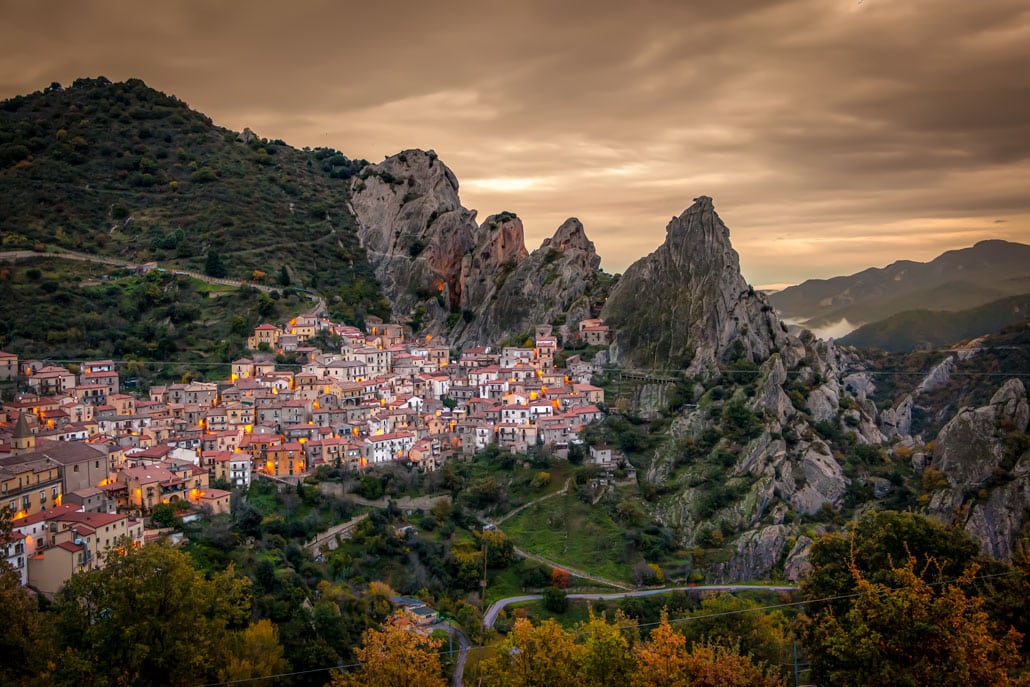
1. Castelmezzano, Basilicata
Perched against the backdrop of the Dolomiti Lucane, visiting Castelmezzano was a total accident during my recent Southern Italy road trip.
This stunning Italy hidden gem is well worth the detour from the main road cutting through Basilicata, and it comes paired up with another beauty on the opposite mountain, Pietrapertosa. Travelling between the two can be completed on the ‘ Flight of the Angel ‘ – a high-speed zip wire that connects these two off the beaten path Italian towns together.
While the town itself is mesmerising, especially when viewed from a distance to admire its unique location, the surrounding area is full of epic hikes, forests and national parks. Dating back to the 10th century and with an age-old charm, an overnight stay in Castelmezzaono is undoubtedly on my hit list when I return to Basilicata.

Stay connected with unlimited data (5% discount code: danflyingsolo): Buy your Holafly eSIM for Europe
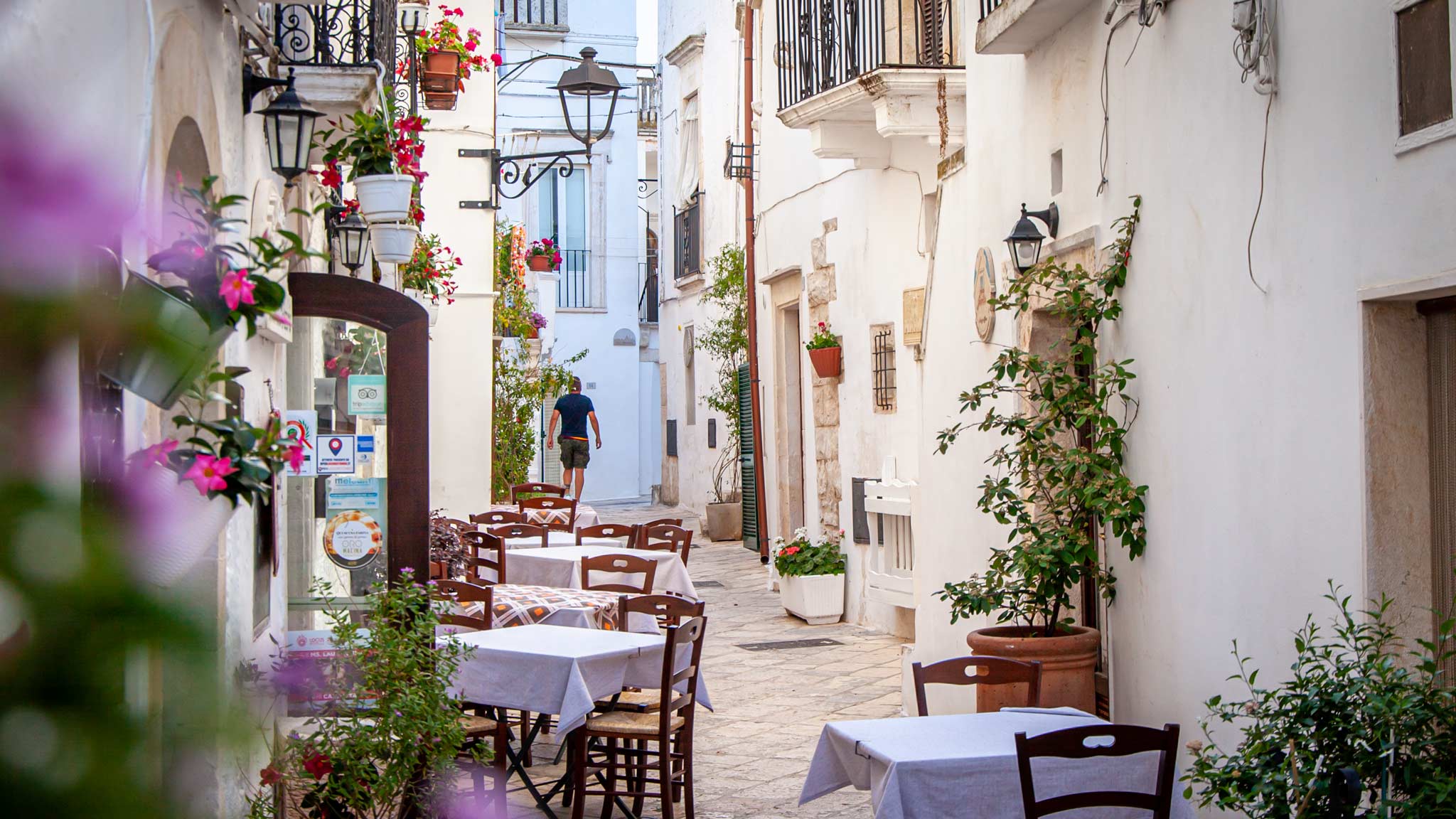
2. Locorotondo, Puglia
If you are looking for a beautiful hidden gem in Italy, then Locorotondo is the town for you!
Locorotondo became one of my favourite places in Puglia, and I absolutely fell in love with it. The coffee gave more of a kick here, the gelato felt sweeter here, and every time I turned a corner, my camera would start working overtime again. The name of the town comes from the circular shape it was built in, although this isn’t obvious from ground level.
What is obvious from the ground level, though, is how adorable, cute, and any other travel-cliche description you can throw in it was. This is a dreamy town where white-washed walls are brightened up by purple and pink flowers in pots, and little restaurants offer alfresco dining in the quaint streets.
Read More: Things to do in Puglia
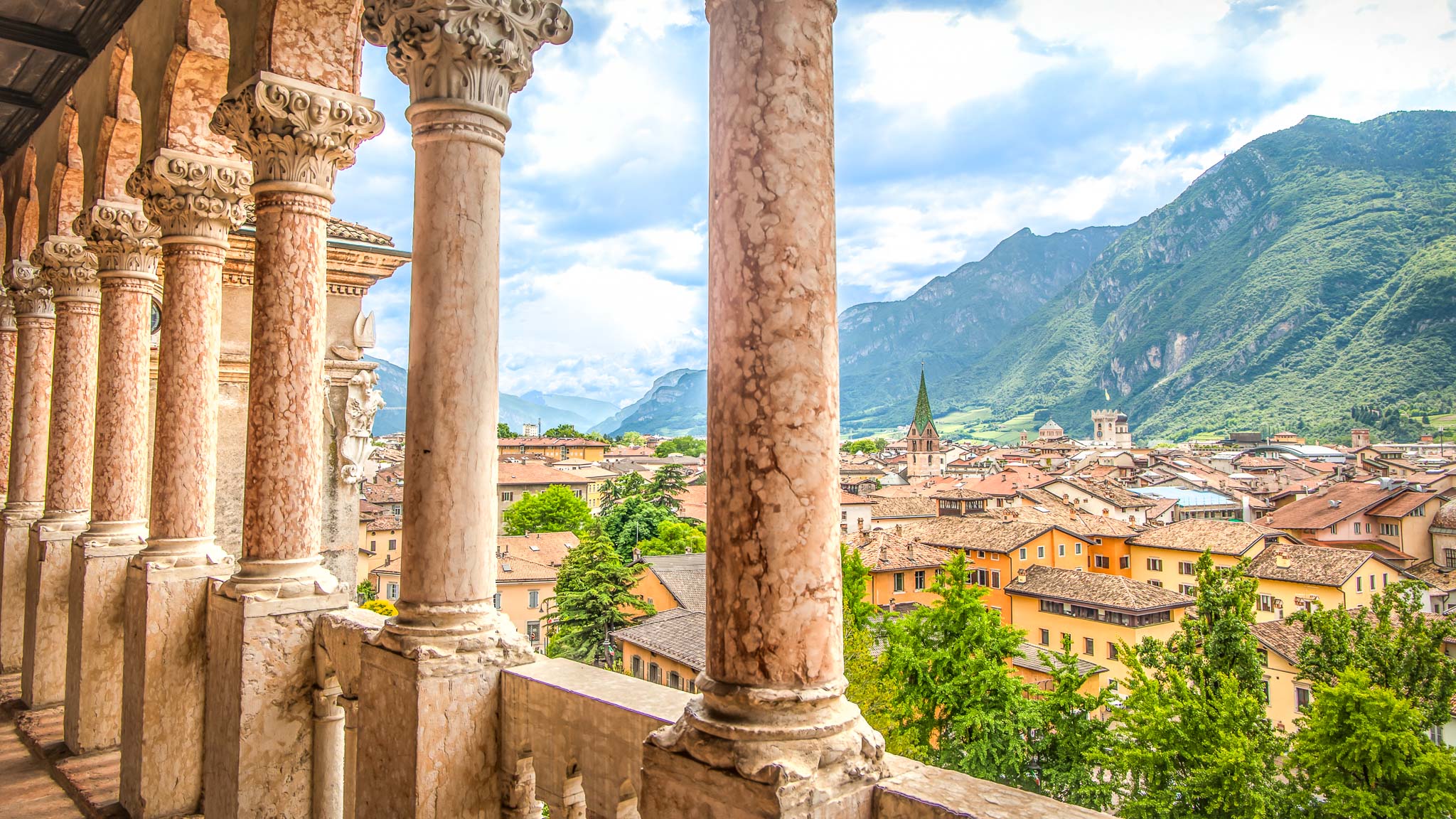
3. Trento, Trentino
The capital city of the Trentino region , Trento, is a perfectly sized city break. It won’t exhaust you like a weekend in Rome, but it still provides ample opportunity to experience the best of Italy; culture, art, food, more food and that relaxed vibe that makes Italy so unique, making it a firm favourite on my Italy hidden gem list.
The cobbled streets of the city were spotless, a far cry from some of the filthier areas of the larger Italian cities, while the impressive Buonconsiglio Castle, galleries and outside frescos provide enough culture without being overwhelming.
Over a weekend, I could walk the streets with no rush to be anywhere, turning down little alleyways, grabbing drinks in the main square under the impressive cathedral and enjoying being in a city where the locals seemed as excited to be there as I did. While the region of Trentino is popular with neighbouring countries to visit by car, it’s still a relatively off the beaten path destination in Italy.
Read More: Things to do in Trento
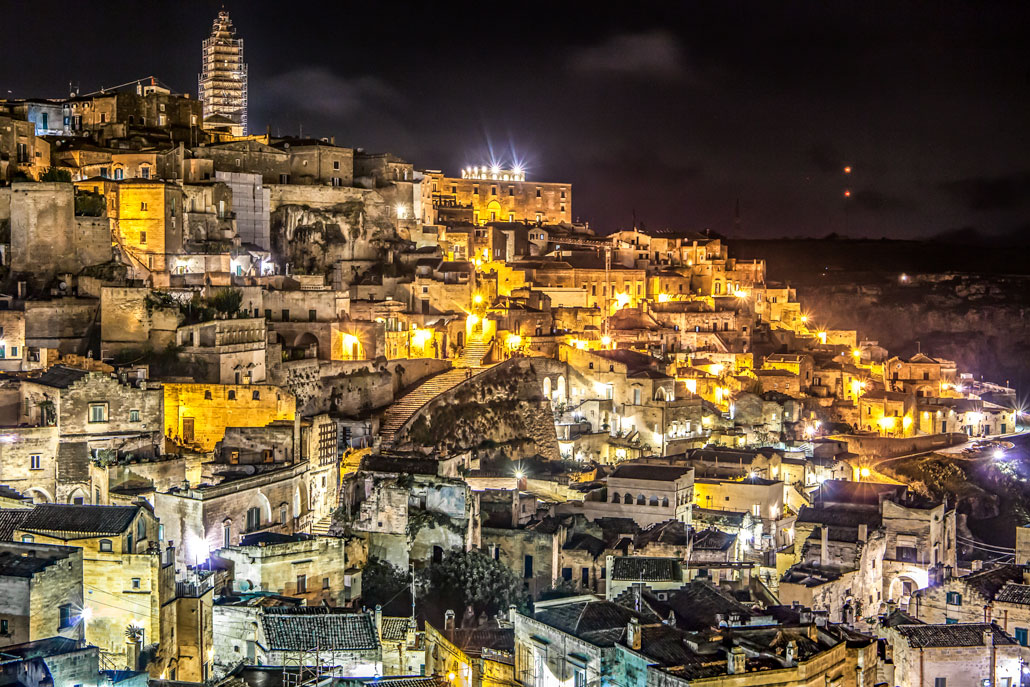
4. Matera, Basilicata (and Massafra, Puglia)
Matera has become more well known in recent years thanks to being awarded the Capital of Culture 2019, but this fascinating spot, one of the longest inhabited human settlements in the world, is a must-visit.
The selection of caves that make up the Sassi, the old part of the city which is now surrounded by the new section, is incredible to explore. The inhabitants all left these cave-like homes when diseases were rife, but they are now open to discover and visit, with the history of poverty levels of the past left behind.
If the accommodation prices in Matera make you bulk, then staying at relatively nearby Massafra or Castellaneta, which are more off the beaten path, are good bets.
Both are much quieter and relaxing but offer plenty of lesser discovered attractions. Whether you explore the castle of Massafra and marvel at its old Viaduct or visit the beaches or perched town of Castellaneta, this triangle of close-by spots provides plenty of fascinating history to discover.
Read: My favourite unforgettable experiences in Italy
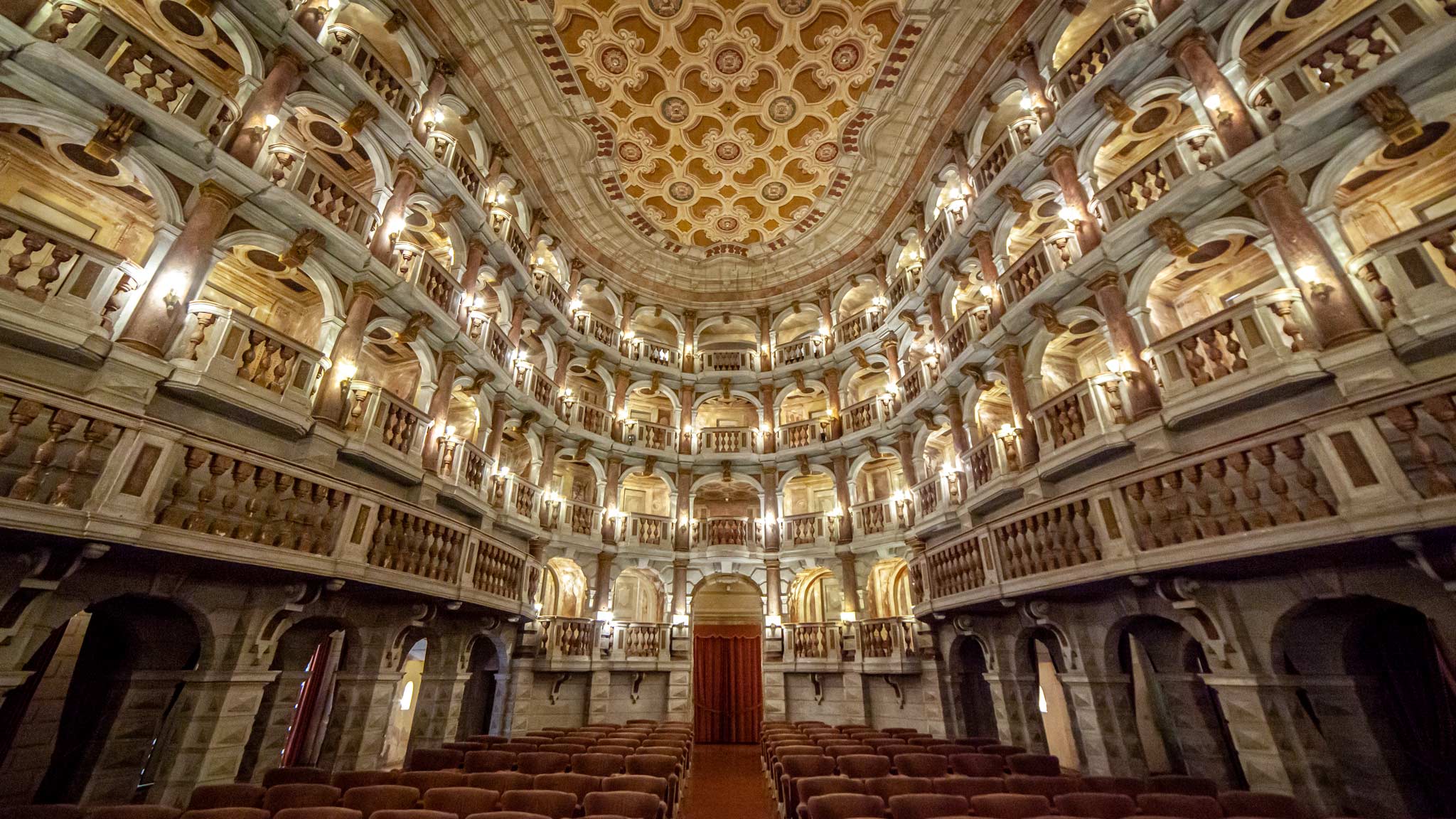
5. Mantua, Lombardy
Wow! What this has got to be one of the most underrated cities in Europe , and to be honest, I’m surprised this incredible place is somewhat off the beaten path in Italy still.
Home to the largest residential building in Europe after the Vatican, Mantua is packed with art and architectural gems.
The city is surrounded by three artificial lakes, one coated in lilypads which call out for a sunset boat cruise, but the real magic is hidden behind closed doors in the numerous grand rooms.
We have to thank the Gonzaga rulers for most of the grand architecture in Mantua, whose Ducal Palace presents some 600 odd rooms. While only some are open to the public, they are an architectural feast with grand frescos and beautiful art.
Also impressive and worth a visit is the Te Palace (which has nothing to do with the drink), which also boasts some grand halls, and perhaps my favourite spot, the Teatro Bibiena, a true Italy hidden gem if ever there was one!
If you like Lambrusco, then you are also in luck, as the wine is produced both here and in nearby Emilia Romagna.
Read More: Things to do in Lombardy
6. Tropea, Calabria
Calabria, much like Puglia on the other side, is a region of azure waters, sandy beach days, great value and off-the-beaten-path Italian experiences. As a lot of international visitors to Italy stick to the north, the south, in general, provides a more affordable beach destination.
That’s not to say it’s without the crowds, though, especially in the peak summer months when locals head south for their vacations. One of the most impressive features of Tropea is the Santa dell’Islo church which is perched on a large rock overlooking the beach.
The 12th-century cathedral and fortified old town add to the splendour, and it’s a great base to explore more of the Calabria region.
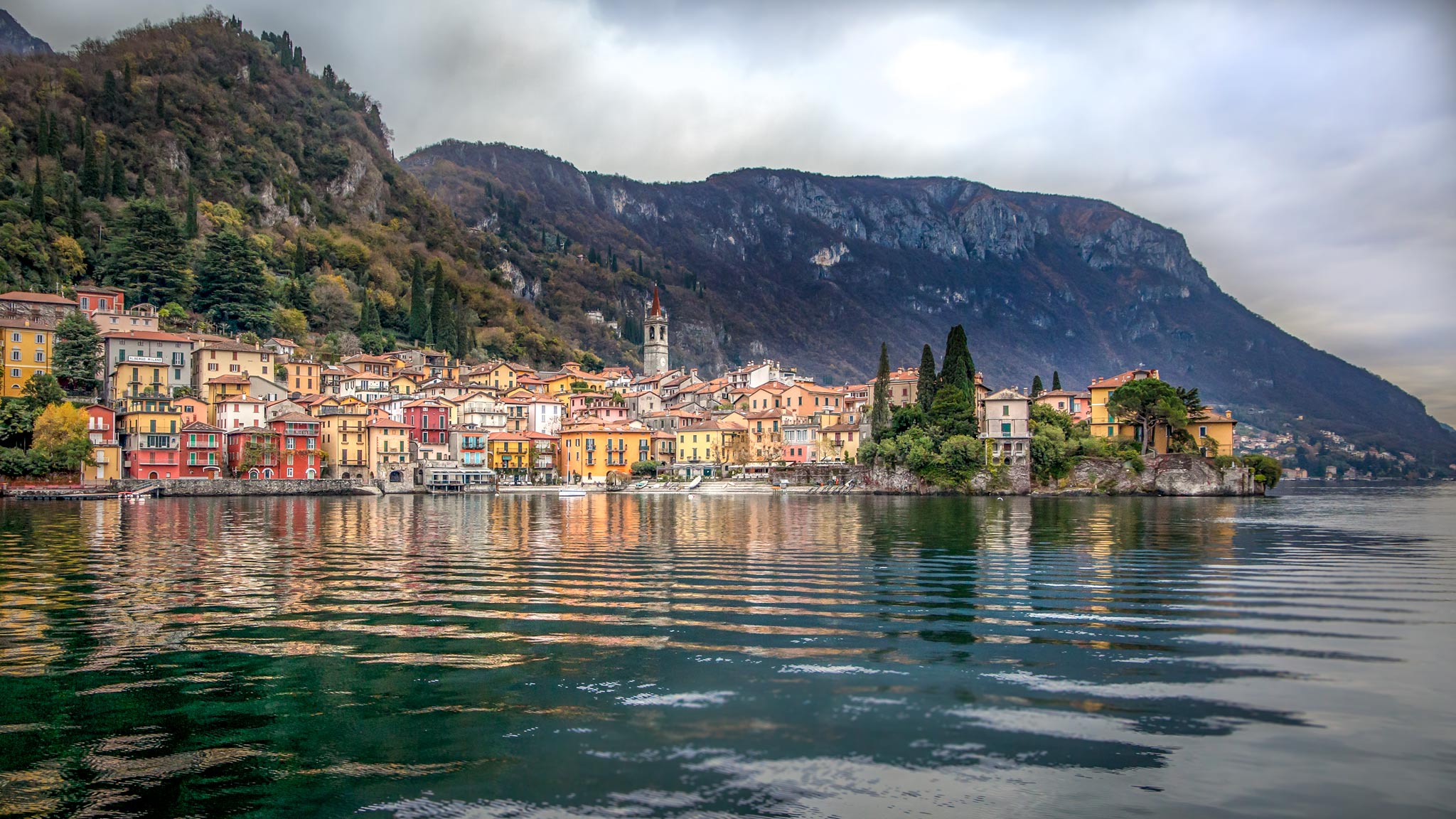
7. Varenna, Lake Como, Lombardia
Lake Como is a real gem in the Lombardia region, most famous for its capital city of Milan . While Bellagio and George Clooney’s home may be its most famous draw, there are countless villages and towns around the lake with lesser crowds that are equally, if not more beautiful.
Varenna is across the water from Bellagio and was my favourite of those I visited. During a crisp November day, with snow-capped mountains really showing off the bright colours of the houses here, I felt like I had all of Varenna to myself.
It might not be off the beaten path Italy all year round, but out of season, it really feels that way. With spectacular castles and grand houses in the mountains above, and the little coffee shops with their lakeside views at water level, Lake Como is the perfect place for a long weekend of rejuvenation.
Read More: Things to do in Lake Como
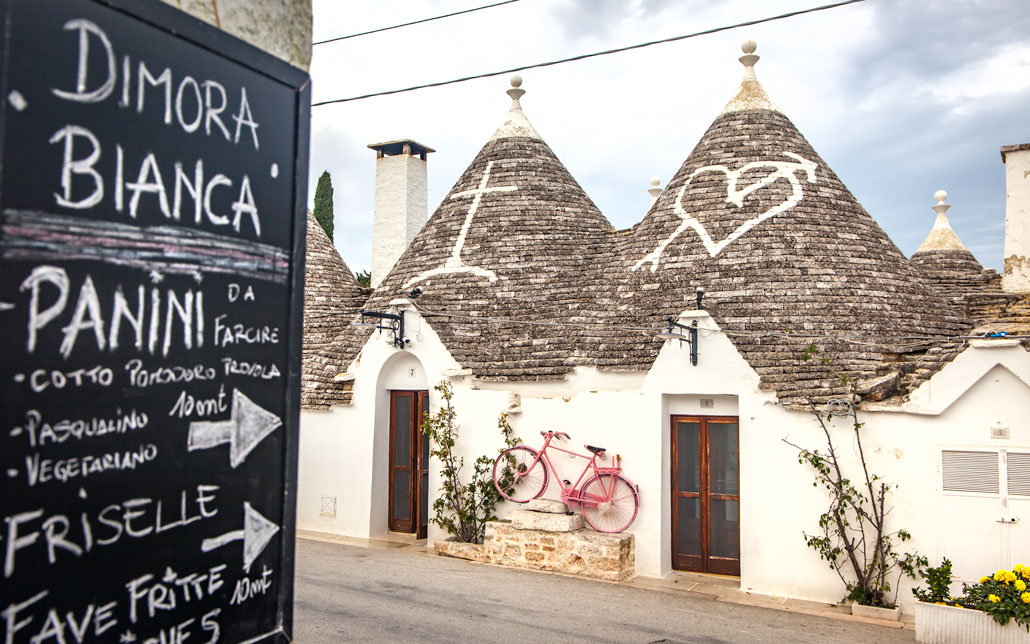
8. Alberobello, Puglia
The Trulli houses that Puglia is known for are at their most dense in Puglia. Stone buildings with pointed cone-like roofs make for a perfect postcard photo, though now more and more people are discovering Alberobello, it won’t be a hidden Italian gem for long.
The more touristy side of the Truli was reasonably busy on the public holiday I visited, but if you visit the opposite side, you’ll find much emptier streets with homes open to stroll through and discover the history of these iconic buildings.
One thing that did surprise me here was the town has built up and around these houses, which mixes the traditional with modern, and I hadn’t realised it wasn’t just a remote collection of Truli from the photos I had previously seen.
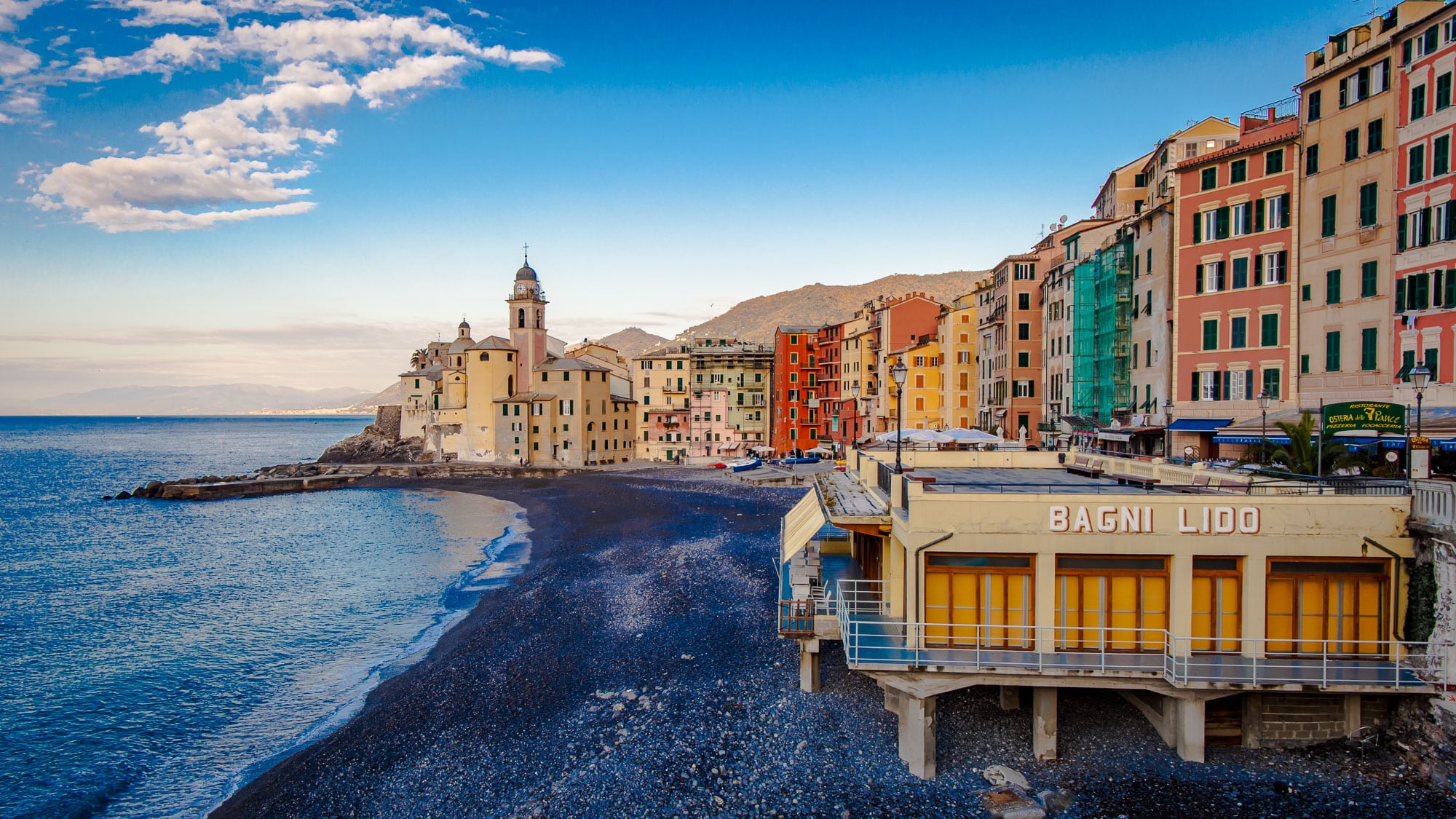
9. Camogli, Liguria
Now, this is a place that stole my heart. While Cinque Terre and Portofino steal the show along this coast, quieter and charming Camogli retains much more of its traditional fishing village feel, making it a somewhat hidden gem in Italy.
A traditional fisherman’s town with colourful houses, a long history, impressive hotels, small bakeries and a laid-back vibe is one of my favourite places in Italy and given what a fantastic country it is, that is no mean feat!
If you do visit Camogli, then be sure to check out the historical and impressive Cenobio Dei Dogi hotel, which has been lovingly restored and, although a bit pricey, provides a slice of history and elegance to go with your catch of the day and amazing views from the pool terrace.
Read More: Checking in to Camogli
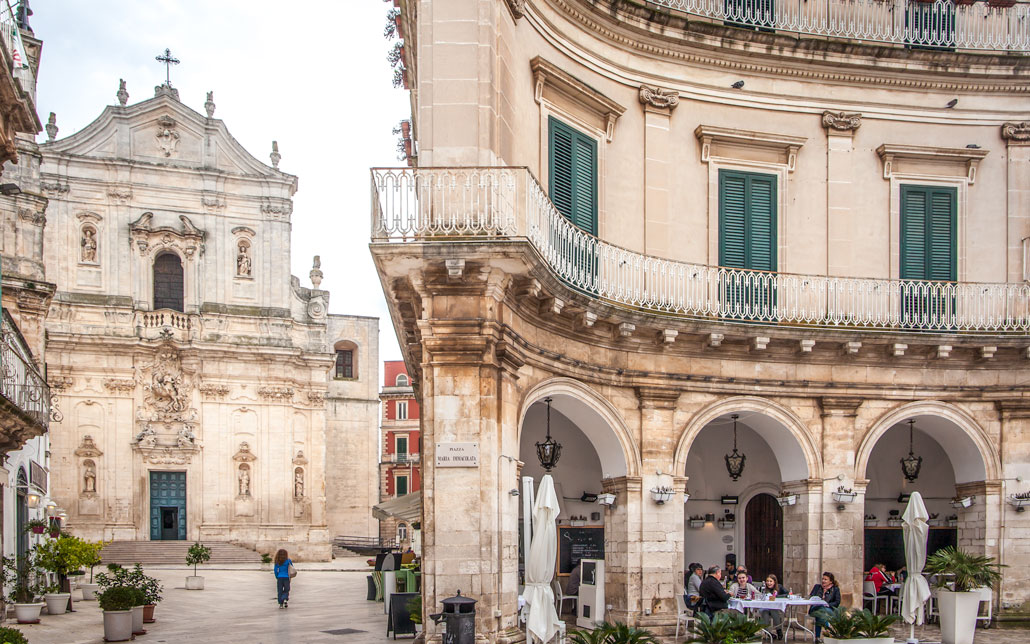
10. Martina Franca, Puglia
We had no intention of stopping here, but I was in desperate need of a toilet break that quickly turned into getting lost in the labyrinth of white streets and a delicious lunch in the church square.
Martina Franca is a short drive from Alberobello but had very few tourists, at least on the day I visited, which places it firmly on the Italy hidden gems list. In summer, it hosts an opera festival which sees its visitor numbers grow.
The town used to be completely walled off, and the large squares, little restaurants and spotless setting make this an ideal lunch stop if nothing else.
11. Orta San Giulio, Piedmont
Nestled alongside Lake Orta, this pastel-coloured town is a real gem in Piedmont and boasts lovely views of the inhabited island of San Giulio, which sits in the lake itself.
As with most lakeside towns and villages in Italy, expect colourful hues of homes, family-run restaurants, and being the north of the country, Aperitivo hour with fixed-priced cocktails served up with plenty of snacks.
The vibe here is laidback, with coffee culture going strong at the various piazzas and gardens in the town. A boat trip across to the island is a must, and staying overnight is a treat as the lights from the island flicker in the reflections of the lake.
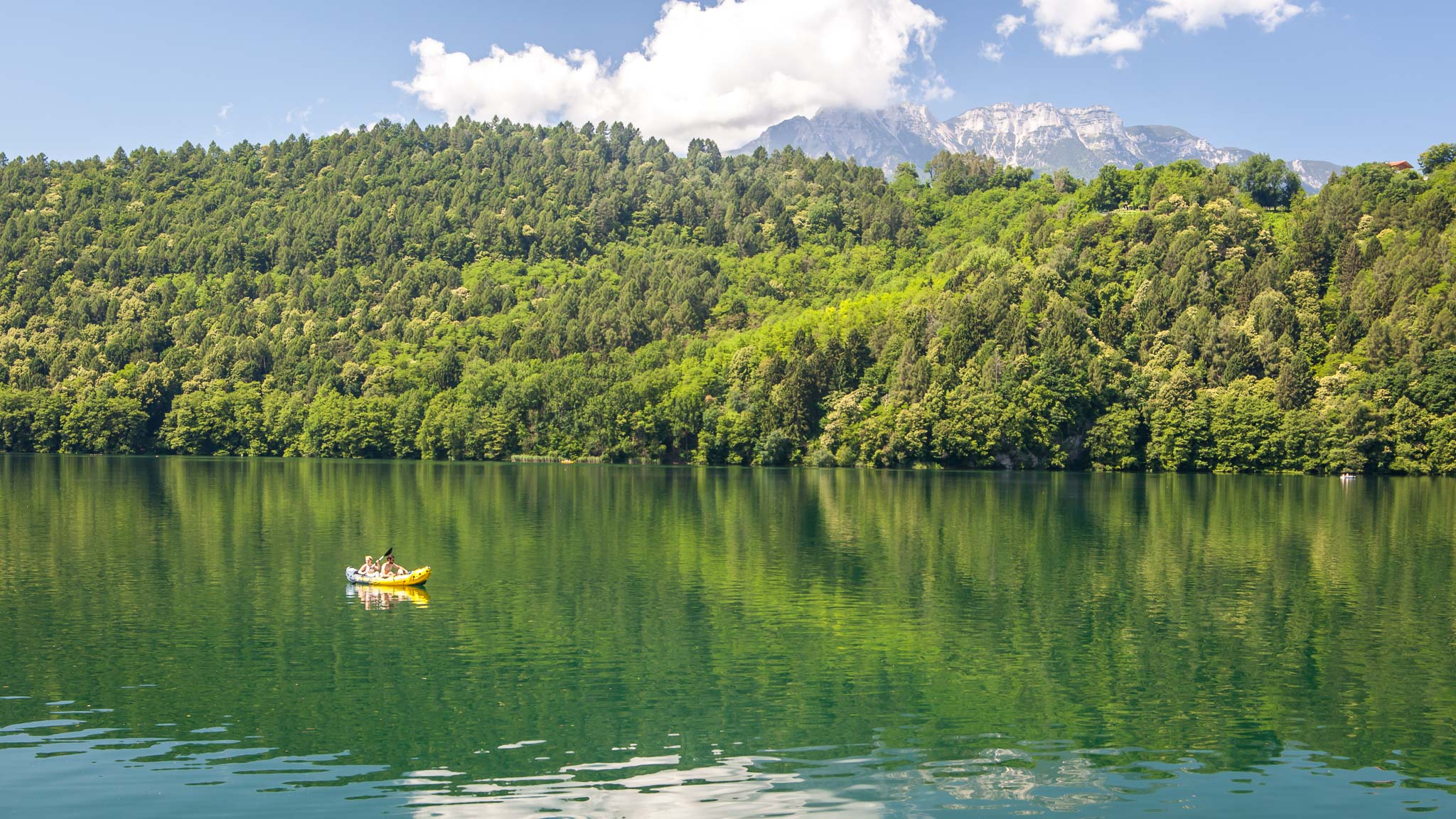
12. Valsugana, Trentino
Valsugana offers up epic hikes, lakes perfect for watersports, and all against snow-capped mountains and an alpine tree-decorated backdrop.
While Lake Garda might be the most famous lake around here, those in Valusgana, such as Lake Levico, still have those Europe hidden gem vibes about them.
I was also amazed to find out that numerous lakes had been awarded the blue flag award for beach and water quality, something I had assumed was just reserved for beautiful beaches. Once you see the bright cleanliness of the lakes and the families relaxing on the beachside shores, though, you’ll quickly see why this region deserves these accolades. I stayed in the Valsugana region for my lake-side escape, and it was the perfect off the beaten path Italian experience.
Read More: Escape to the lakes of Valsugana
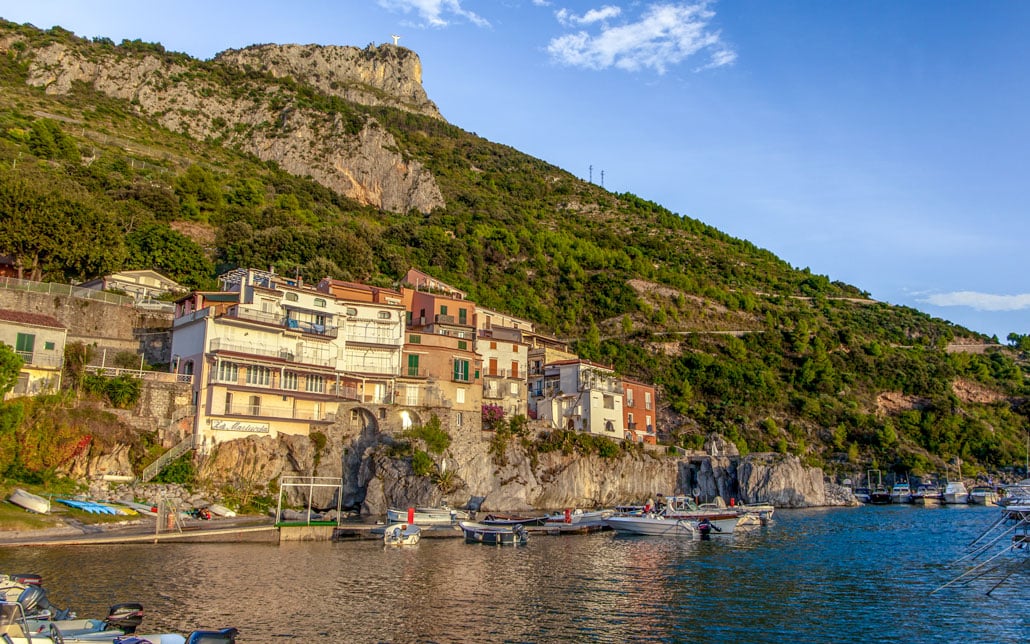
13. Acquafredda and Maratea, Basilicata
The unexpected rains did not dampen our unplanned and last-minute visit to Acquafredda and Maratea, but surprisingly become one of the best nights of my recent Italian road trip.
With the statue of Christ looking down on Maratea, it’s no surprise this picturesque town along the coast is packed with churches. Enjoy marina-side dining down on the waterfront, or take a short stroll inland to enjoy the town itself before dipping into limestone caves to escape the summer sun.
Just a short drive down the road, and you’ll arrive at Acquafreeda, a hidden gem in Italy that many just drive through as they explore the Basilicata coast. This small village has just a couple of restaurants, but we found a fantastic 4-bedroom house here for the night at a crazy price, where Gianni, the owner, welcomed us like long-lost friends by popping open Prosseco and sharing insider travel secrets of the region. With an outside bath overlooking the ocean and the colourful houses on either side of the green mountains, it felt like a magical experience without the need for a fancy hotel.
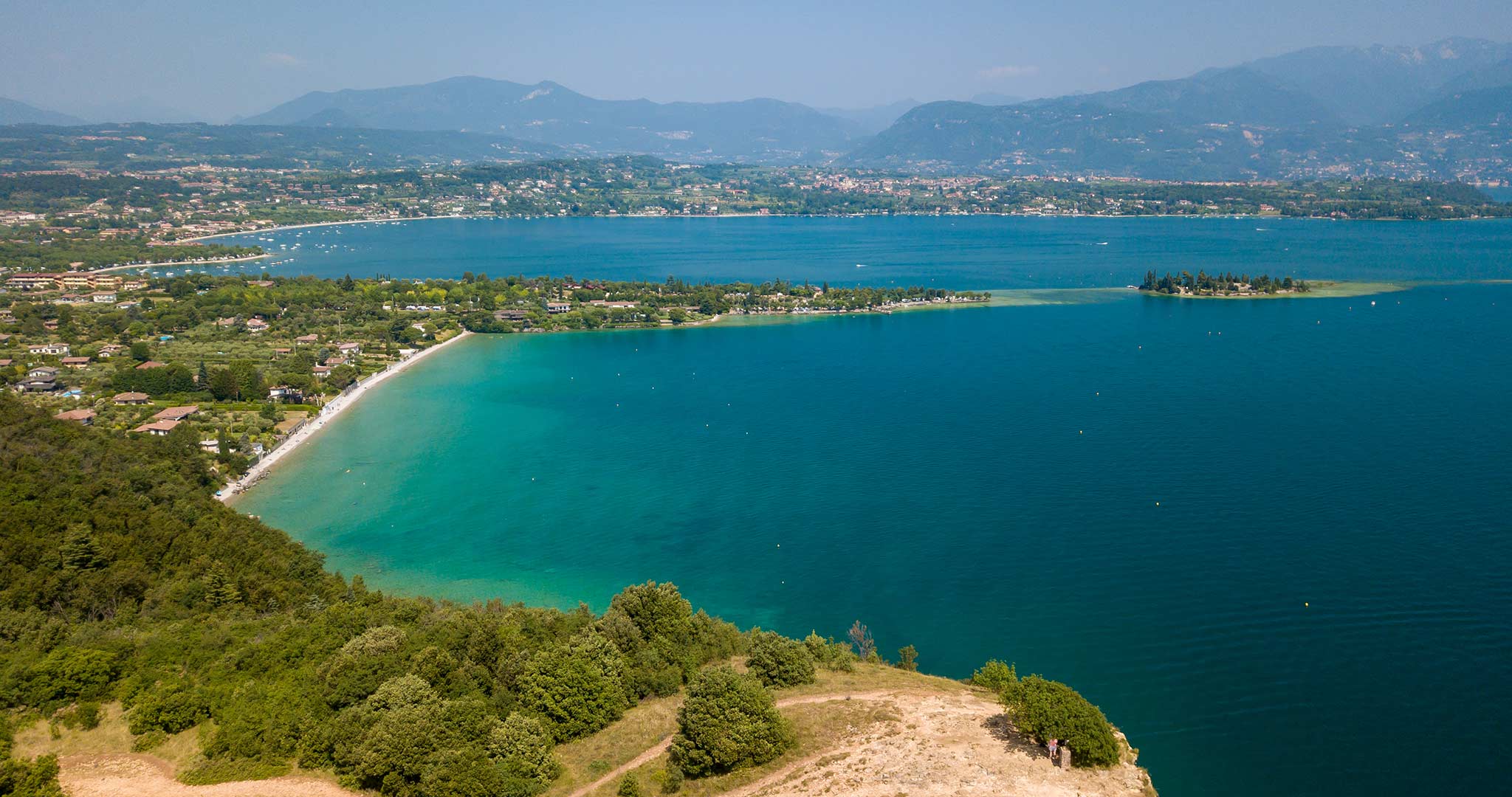
14. Lugana and Manerba del Garda, Lombardy
Sirimione, the famed village on Lake Garda, thanks to the castle which seems to float in the lake, might top the list of things to do in Lombardy , but the rest of the lake has plenty to offer.
Lake Garda is actually in three different regions of Italy; Trentino, Veneto and Lombardy, and each part offers different attractions.
There are two hidden gems I recommend you to visit on the Lombardy side, though the whole lake is beautiful.
Manerba del Gara provides some of the most stunning views across the lake, including beaches and some private islands home to costly and grand homes. Take a short and easy hike here to enjoy the views, and then climb down onto the rocky or sandy beaches along the lakeside for the perfect temperature dip in summer.
Lugana is closer to Sirimione and, although small, is a well-known wine-producing region. Here I visited one of the small wineries and also indulged in a cooking class and family-style dinner. The perfect off the beaten path Italy experience, yet so close to some of the country’s most famous attractions!
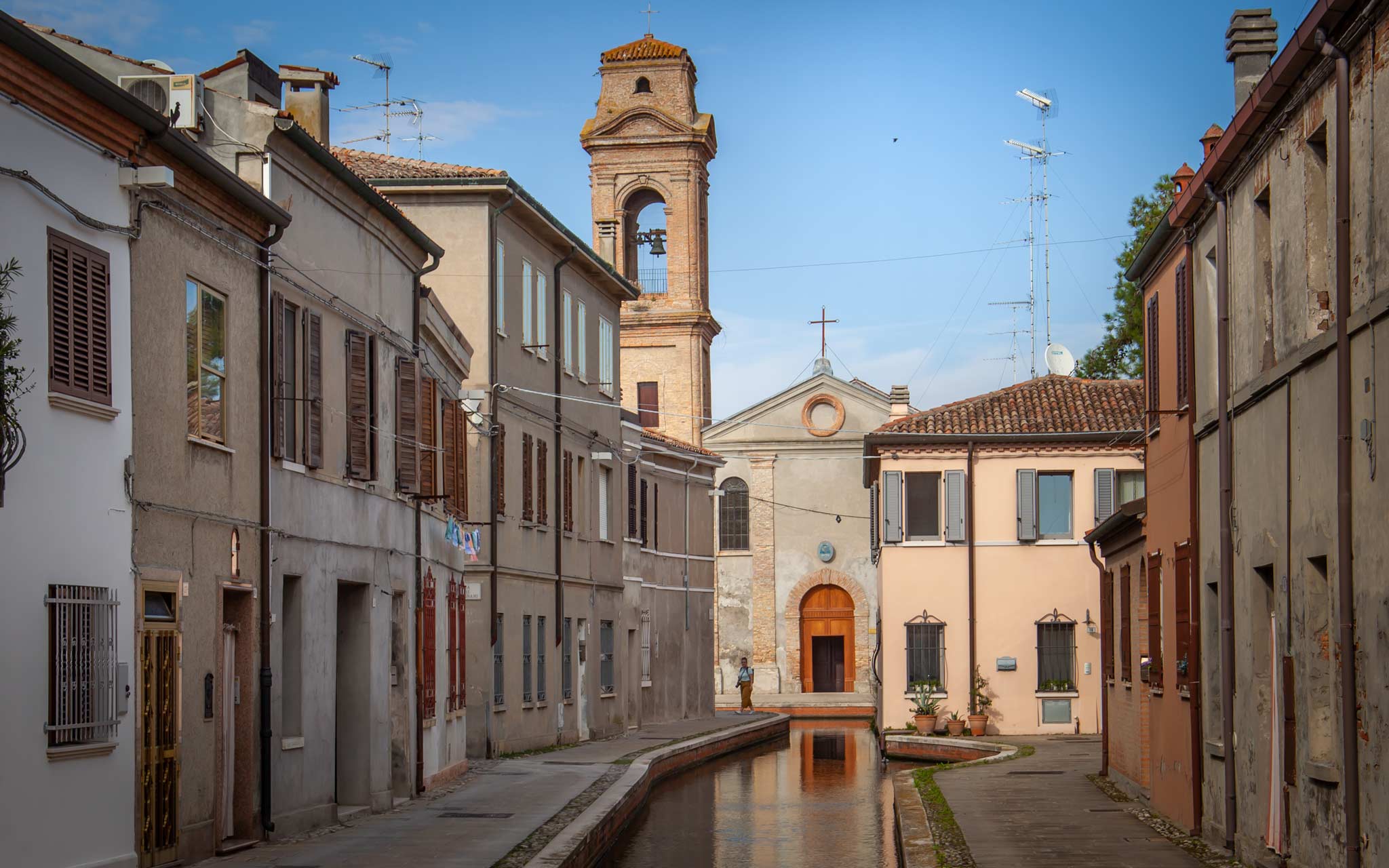
15. Comacchio and the Po Delta, Emilia Romagna
It took me a few visits to Emilia Romagna before I finally made it to Comacchio, but it was certainly worth the wait! Comacchio isn’t the most accessible place to get to in Emilia Romagna as it does not have a train station, but whether you hire a car or make it here by bus, it’s well worth taking a detour for.
Often billed as ‘Little Venice’ due to it being close to the Veneto border, complete with canals and relatively devoid of tourists, it’s an ideal base to explore the local nature and also soak up the quaint canals.
A relatively small commune, the main town itself is everything you would expect: still canals reflecting colourful buildings, streets lined with excellent restaurants and bars, and the joy of not being too crowded by tourists. It’s well worth hiring a bike to explore the local area and the Po Delta Nature Park (complete with Flamingos) after you’ve enjoyed a couple of chilled days and sampled the local fish speciality, Eel and Clams.
Read More: Comacchio and the Po Delta
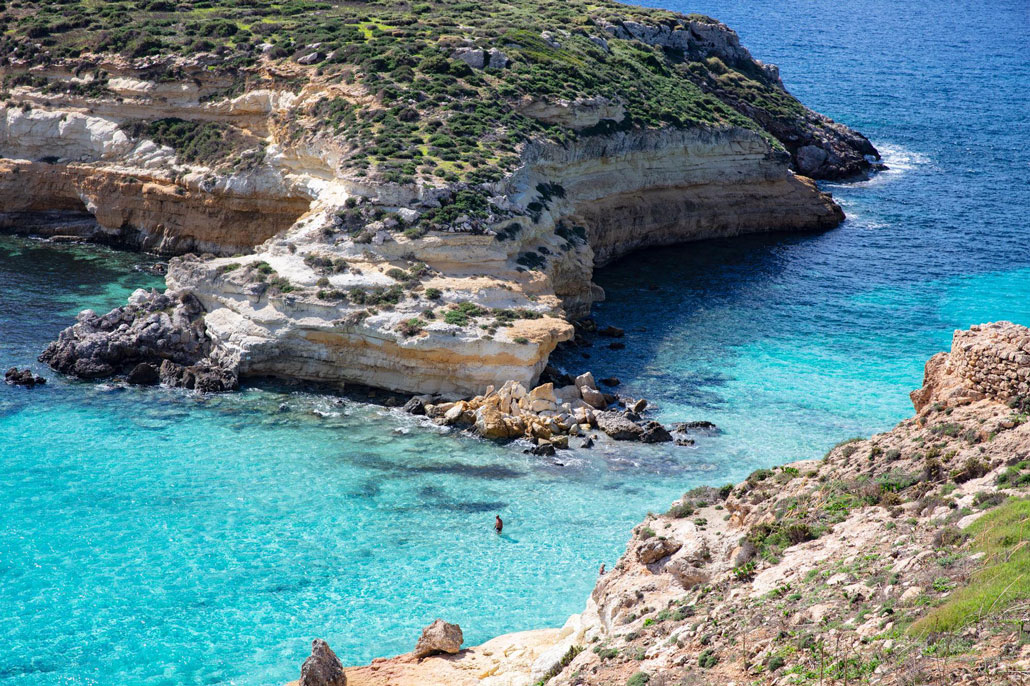
16. Lampedusa, Pelagie Islands
I can not wait to visit Lampedusa, especially after my good friend Nicole headed there just before we joined up for our South Italy hidden gems road trip.
If you have heard of Lampedusa before, it likely isn’t as an off the beaten path Italy tourist destination but is more likely linked to news reports about refugees. Located in the Mediterranean ocean, Lampedusa sits halfway between Tunisia and Malta.
With incredibly warm and clear waters around it, and the chance to swim with turtles, dolphins and countless other marine wildlife, the island is indeed a different way to experience Italy, from the food influences to the culture is entirely different to the mainland. Epic sunsets, amazing beach days and a real adventure await those who venture off the beaten path in Italy and head to any of the three Palagie Islands.
Read more on my friend Nicole’s Lampedusa Travel Guide .
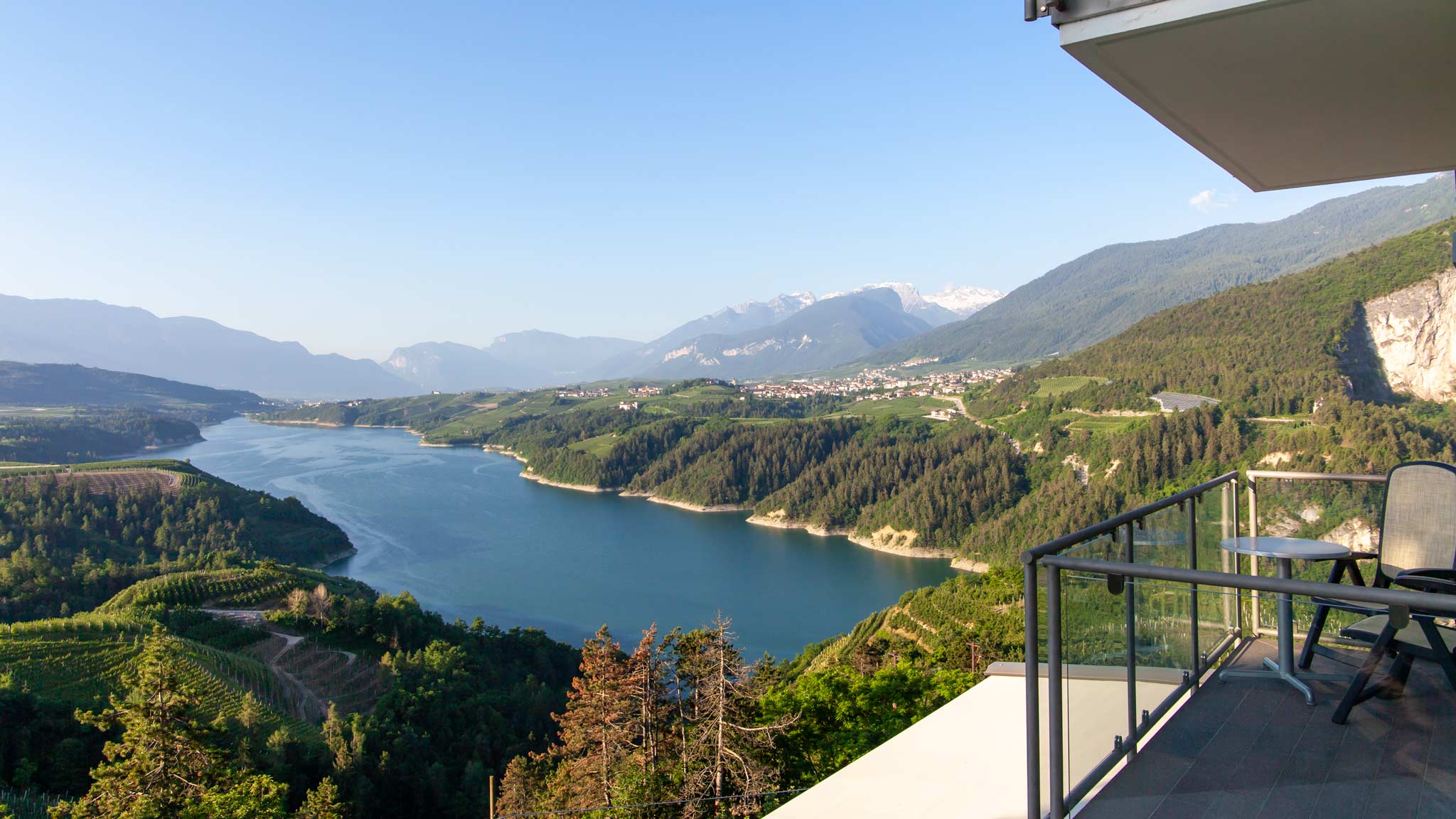
17. Val di Non, Trentino
Literally translated as the Valley of Nothing, this couldn’t be further from the truth.
This land of apple orchards is littered with castles amongst epic landscapes but also holds many natural wonders.
From the beauty of Lake Tovel high in the mountains, which reflects a near-perfect image of the alpine landscape on a flat day, to the underground apple storage centres, it’s a beautiful spot to break away from the crowds and enjoy off the beaten path Italy.
The lakes look more like Canada than Europe, and the valley full of winding rivers and apple trees lined up in their thousands like a vineyard is truly breathtaking!
Read More: Apples and aristocrats in Val di Non, Trentino
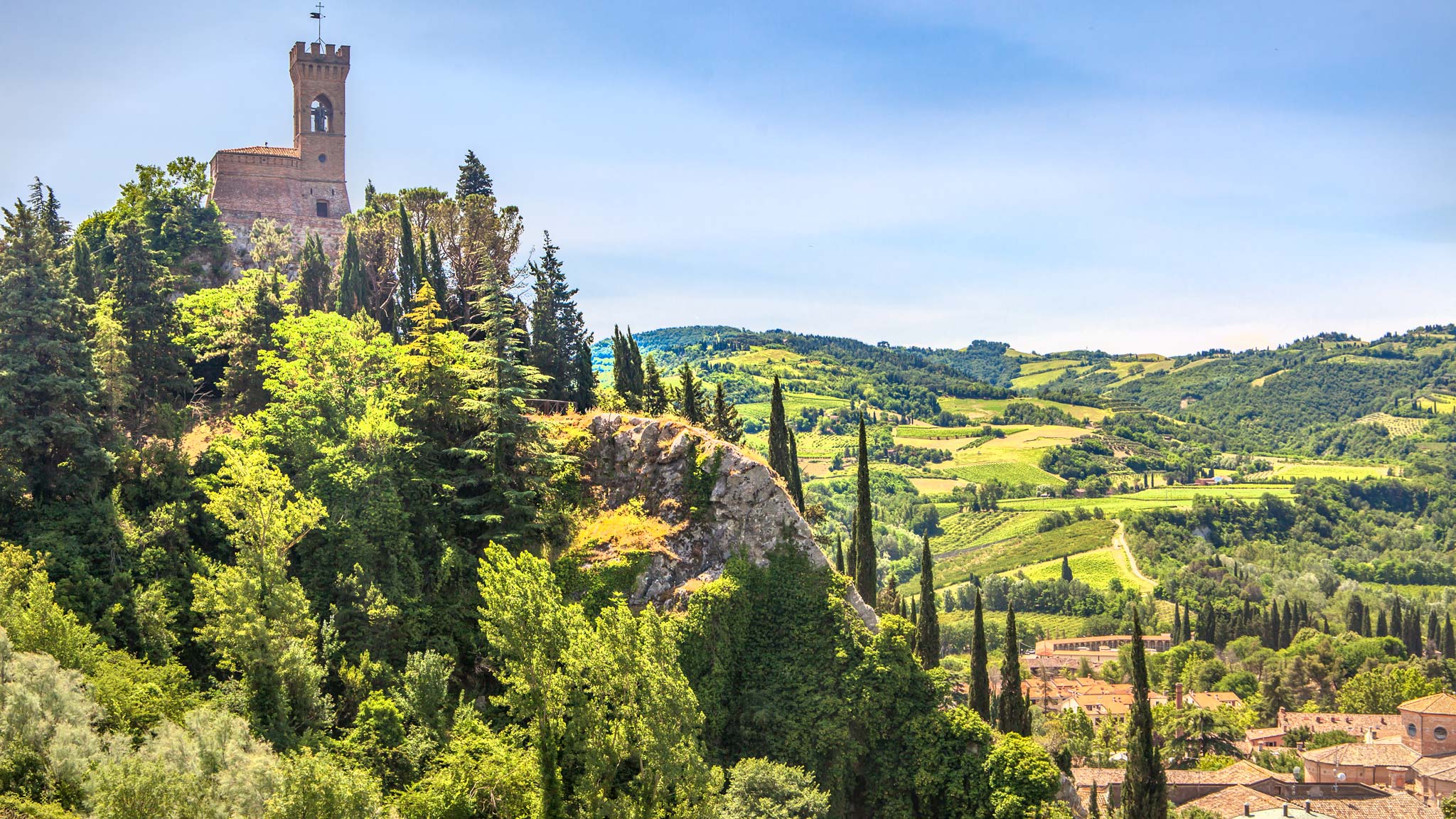
18. Brisighella, Emila Romagna
When you think of Italy from the movies, you know the ones, hair flying in convertible cars, verdant green hills of vines, castles towering above little red roof towns, you’re essentially thinking of Brisighella .
This too cute to believe Italy hidden gem was my first day trip in Emilia Romagna, and it stayed my favourite. The picturesque streets with little cafes and gelato shops sit under the three hills of the town; one clocktower, one castle and one church. You can enjoy a casual stroll between the three and visit them before noshing down on all the gelato below.
We saw one little tourist group there, but other than that, on a blissfully sunny June day, it was devoid of tourists, making this a true off the beaten path Italy experience.
Be sure to check out the surroundings, including the old quarry caves, which now host live music performances underground, the excavation site of the old castle, which offers terrific panoramic views and head to the mountains for some fantastic fresh food and fresh air at the Parco Carnè visitor centre.
Read More: Things to do in Emilia Romagna
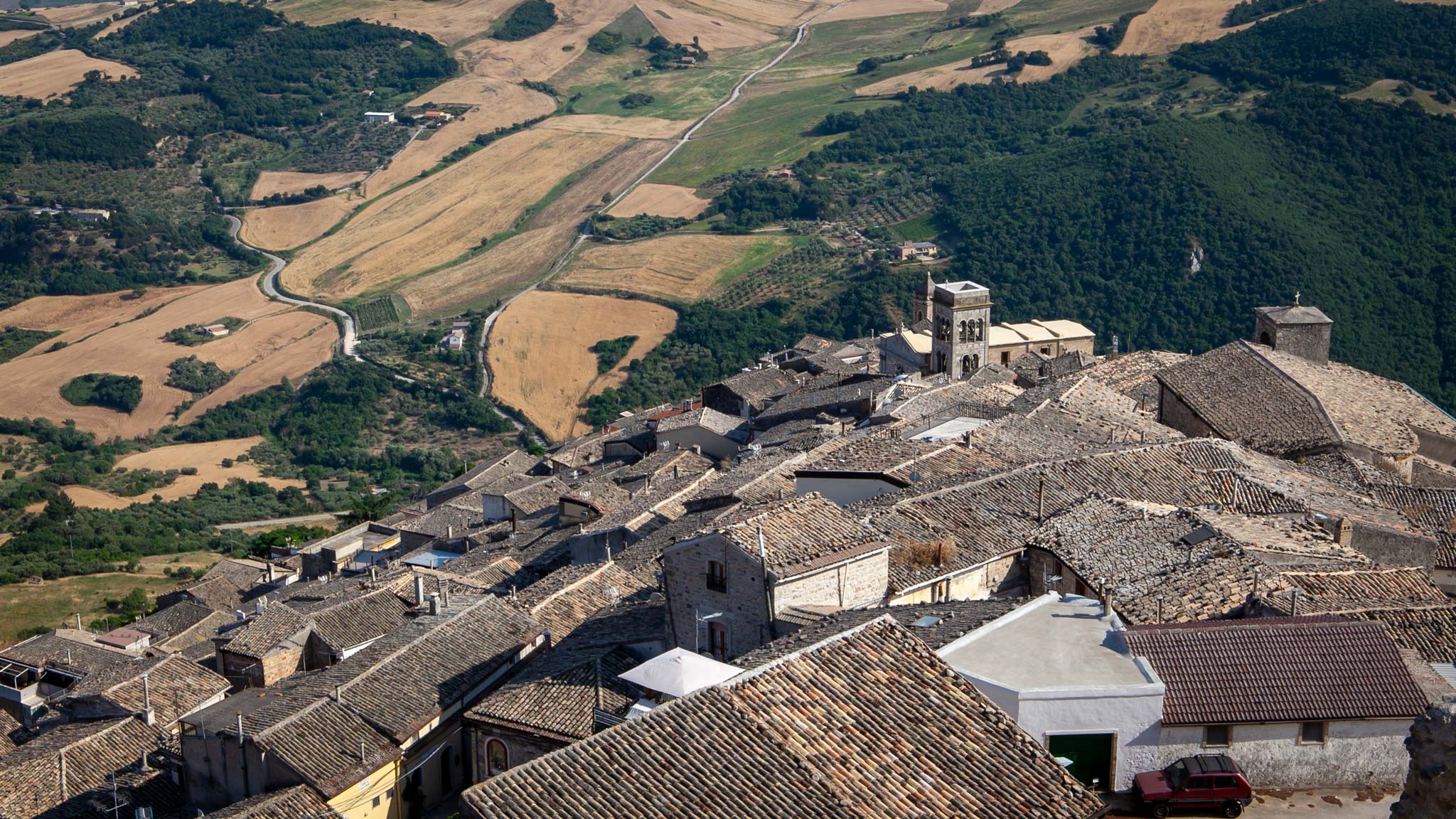
19. Sant Agata’di Puglia, Puglia
One of those towns which just takes you back in time, Sant’Agata di Puglia is a few hour’s drive from Bari in Puglia, but you’ll feel transported not to just a different setting but a different time.
Towns such as Sant’Agata di Puglia aren’t the kind of places you come to tick off a long list of must-visit attractions, but rather to relax into an authentic pace of life.
On the square, bordered by a few cafes, locals sit on benches and plastic chairs, drinking espressos or beers and catching up. Small restaurants serve up traditional Cucina Povera, the peasant food of Southern Italy; an unfortunate name for such delicious cuisine, which may be simple in ingredients but not taste.
Behind closed doors of which young and passionate archaeological staff hold the keys, old watermills and ancient underground wine cellars hide. This is a true Italian hidden gem, and the drive through the countryside winding up the mountains will make sure you feel truly off the beaten path.
Read More: Discover the hill-side towns of Foggia Region, Puglia
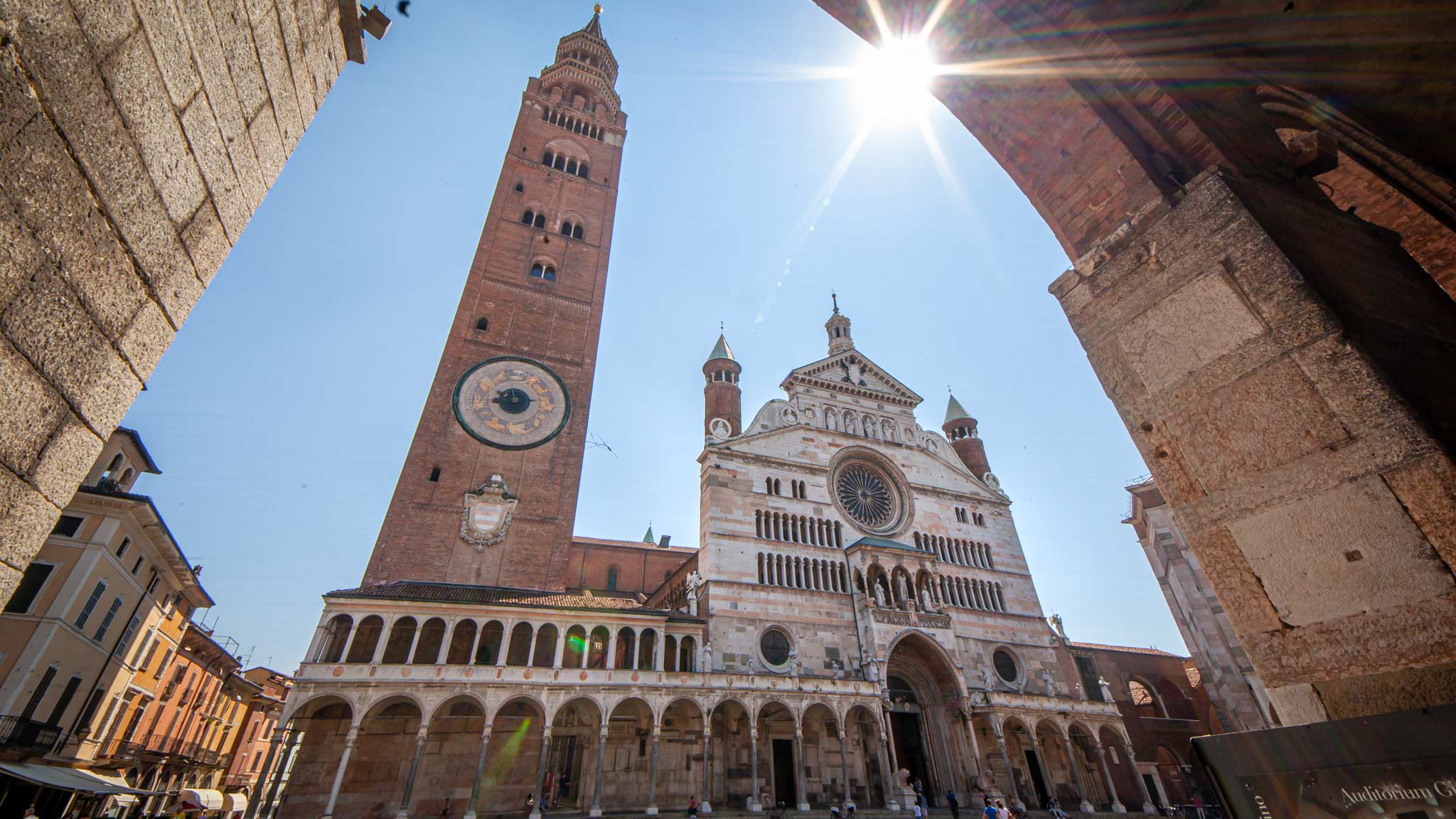
20. Cremona, Lombardy
Cremona is a city in the Lombardy region, but being so close to the Emilia Romagna border, you can see similarities such as the Porticos.
While Violins are the name of the game here, thanks to its long and successful history of producing premium versions of the stringed instruments, it’s also an ideal day trip from Milan or Venice.
As well as a Violin museum, you can also visit workshops to see how much effort goes into their production.
Meanwhile, the architecture provides a stunning example of Romanesque art, such as the Cathedral, which nearly didn’t get off the ground. While construction started in the 1100s, an earthquake came along and severely damaged the Cathedral shortly after. Eventually, some 60 years later, construction was completed, but with various extensions and additions, you’ll notice the array of styles both inside and outside the Cathedral.
Read More: Cremona, a city of more than Violins
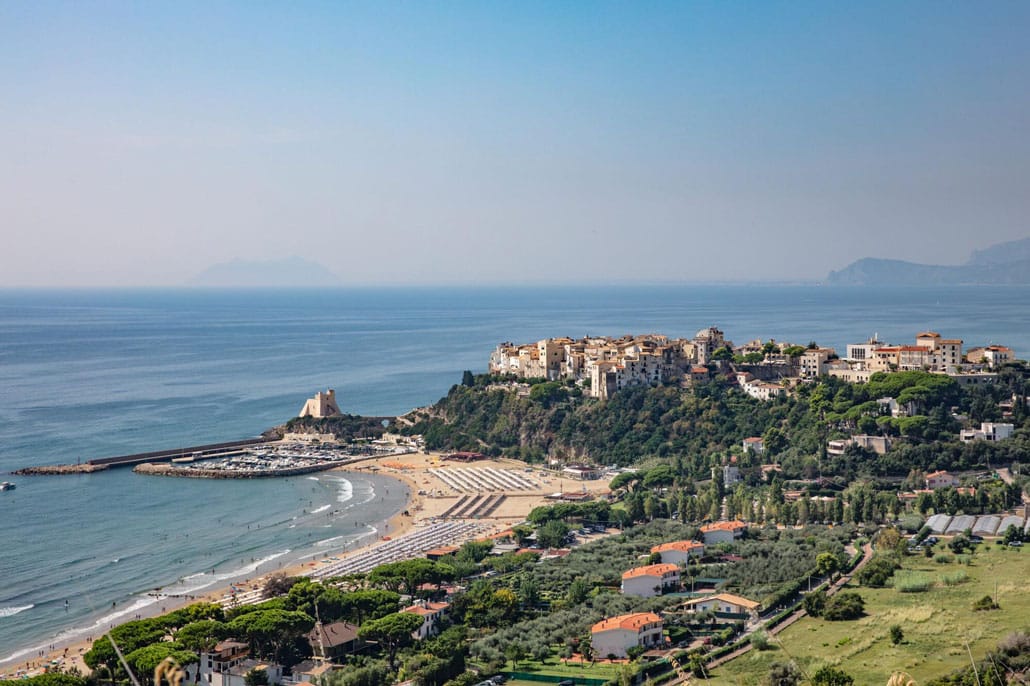
21. Sperlonga, Lazio
The Lazio region is home to one of Italy’s most famous cities, Rome, but that doesn’t mean there aren’t plenty of Italian hidden gems to find here, too, especially given it’s such a hotbed of ancient architecture.
Sperlonga is one of those places and worth going off the beaten path in Italy to visit. A coastal town that lies around mid-way between Rome and Naples, the sea grotto here, which dates back to Roman times, is the main draw.
The Villa of Tiberius is home to plenty of ancient sculptures and a well-put-together museum while the beach and port overlooked by the Torre Truglia come equipped with plenty of small restaurants to get your pizza and pasta fix.
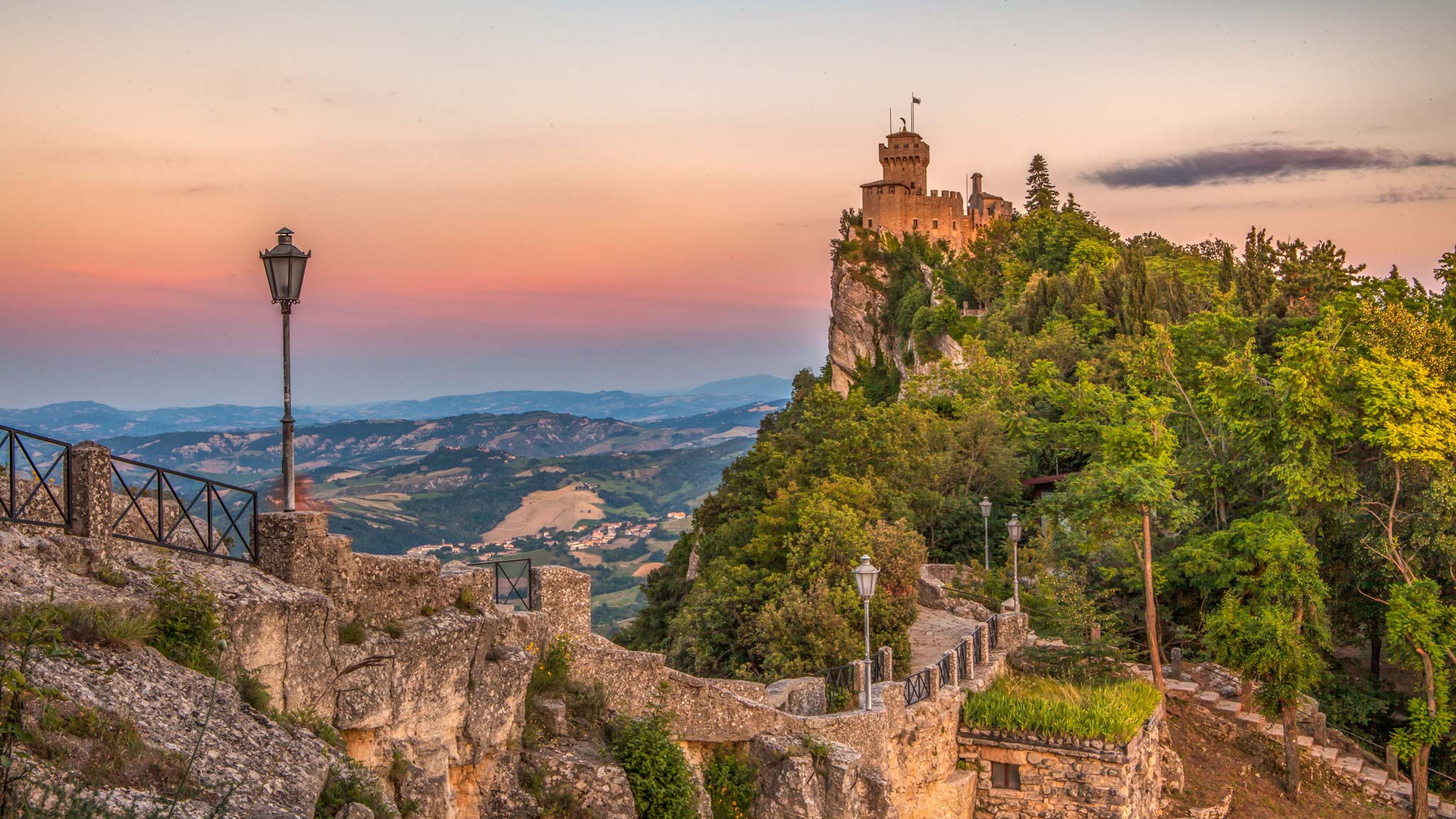
22. San Marino
To avoid any doubt, San Marino is an entirely different country to Italy, but given Italy surrounds it, I thought it warranted a place and inclusion on my Italy hidden gem list, especially as it is one of the least visited countries in Europe.
This tiny republic is the 5th smallest country in the world and after sunset and the daytrippers depart, you have the most magical ancient experience walking its old city without any crowds, to get off the beaten path in Italy, you just have to cross a land border.
It’s a truly fascinating place being one of the oldest republics in the world. Italy surrounds it but is not part of the EU (although it has no borders). They use the Euro and have individual San Marino coins. They have two presidents at any time who serve six months each. They have their own calendar.
You get the point, it’s a pretty unique place, and as such, you should certainly make the time to ‘pop over the border’ to this still fairly undiscovered gem.
Read More: An overnight stay in San Marino
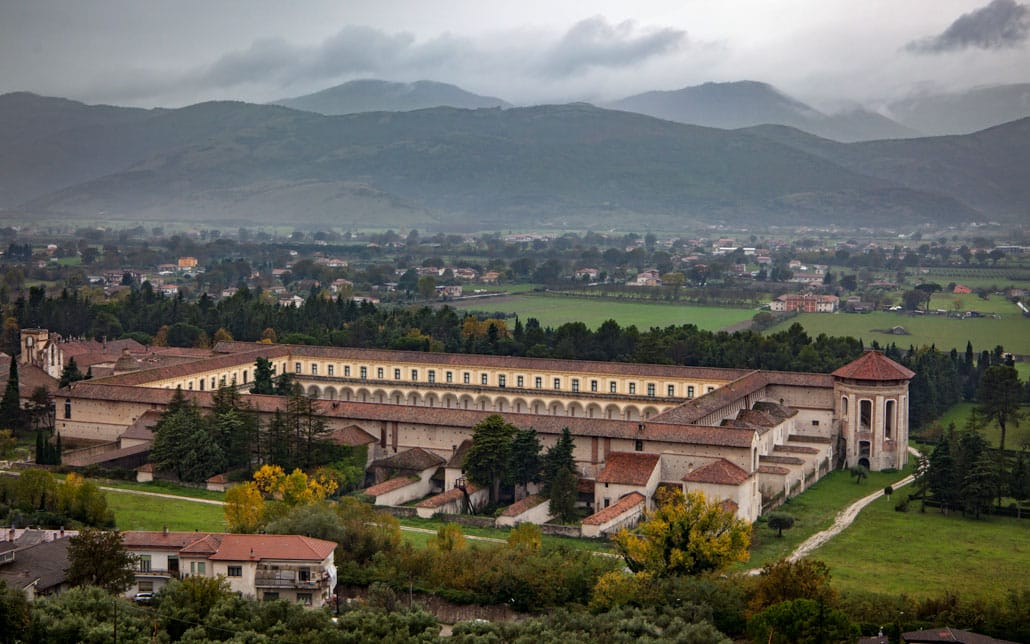
23. Padula, Campania
When we arrived at Padula, the heavens had opened, and what was meant to be a breathtaking view of this Campania town climbing up a mountain was more of a hazy cloud and dodging newly created rivers running down the roads. The windy route up to the top provides you with tremendous views down on Certosa di Padula, a large monastery that dates back to the 1300s.
Padula itself is a relatively hidden gem in Italy, with most people speeding past it on the motorway, but it’s an excellent pit-stop if nothing else to explore the monastery and plentiful churches and squares in the commune. And, if you make it on a sunny day, unlike me, the views looking at the town which rises up the mountain will be epic.
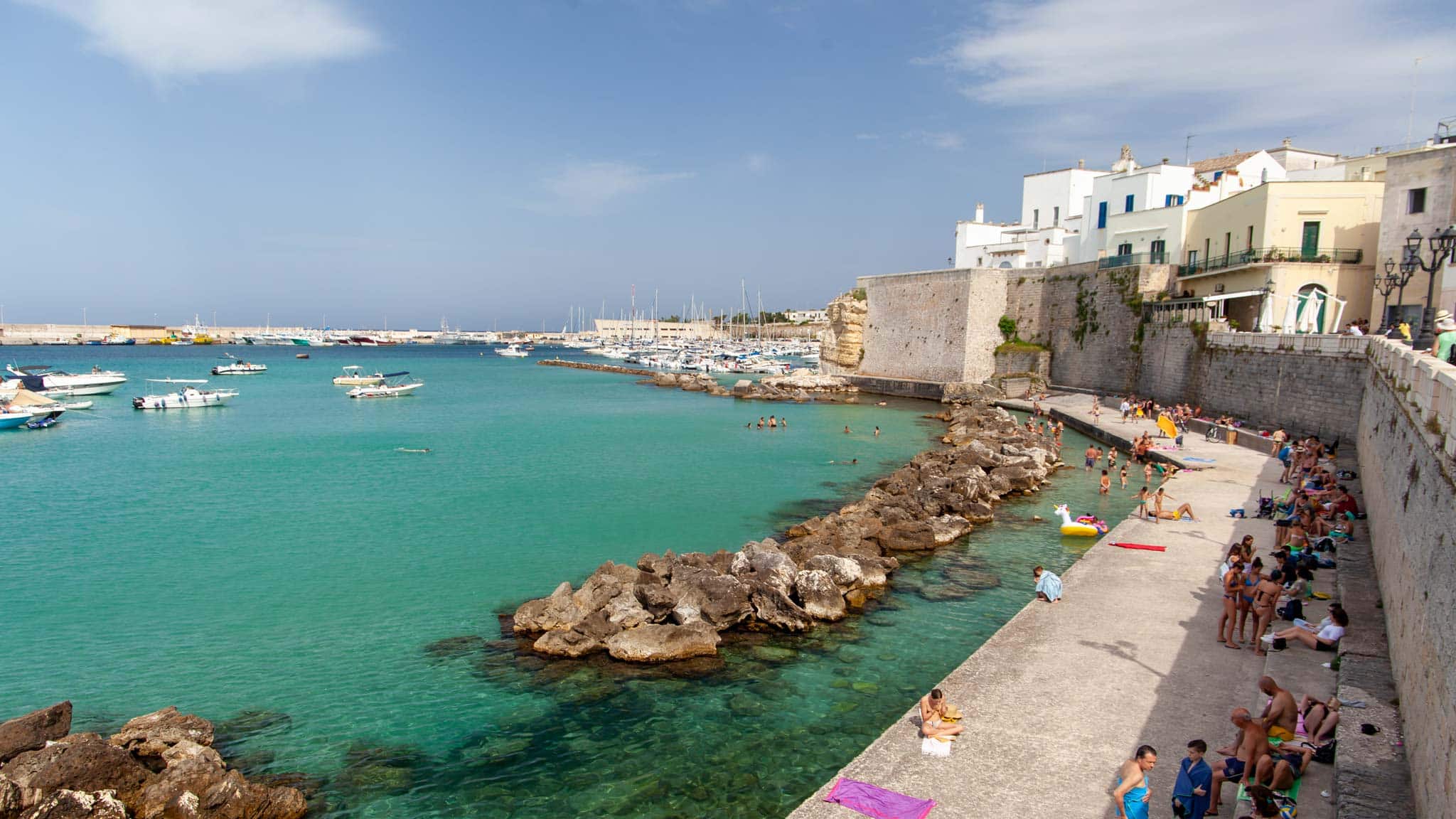
24. Otranto, Puglia
Otranto has quite a few surprises to enjoy, including the most easterly point of mainland Italy, a short drive from Otranto centre.
Along the windswept coast, you’ll find wild herbs in the national park before arriving at the Punta Palascia Lighthouse. Strong waves batter the unique rock formations and caves along the coastline.
Also outside the city centre is the Laghetto Cave di Bauxite, where bright red soil surrounding a disused quarry, now turned lake, is home to turtles and birds.
Inside Otranto, beyond the city-beach bathing opportunities and the massive castle complex, the Otranto Cathedral is well worth a visit, even if you are feeling a bit over Cathedrals. The floor is laid out with incredible mosaics depicting heaven and hell, and in the back Chapel sit the bones of Christian martyrs who passed away here. A fascinating place and a worthy hidden gem in Italy!
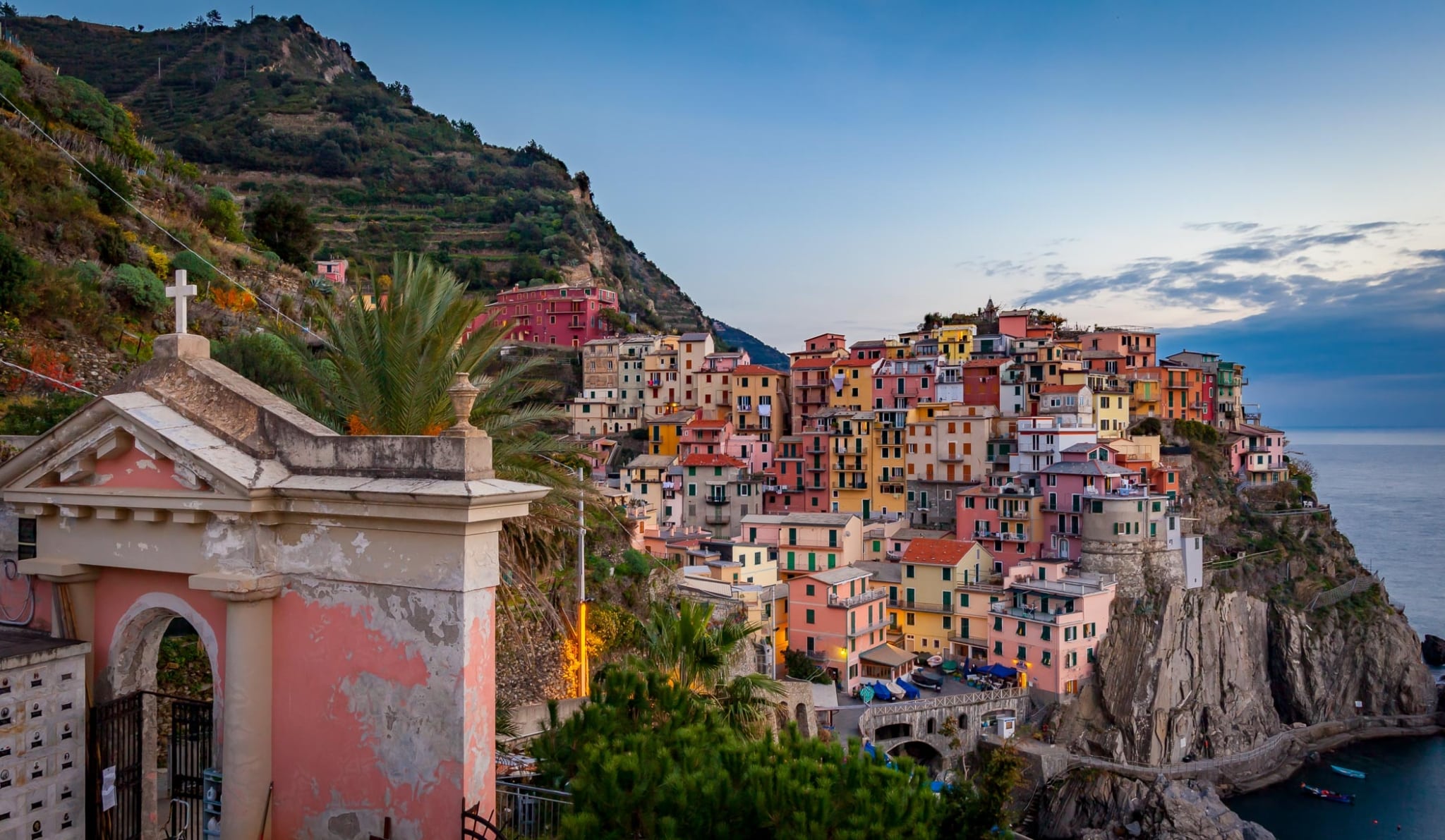
25. Cinque Terre, Liguria (in winter)
Cinque Terre is by no means a hidden gem in Italy anymore, but if you visit in the off-season as I did, you’ll feel like you have gone off the beaten path in Italy,
On a crisp November day, with blue skies and beautiful waters, I arrived at the five lands, or towns, that makeup Cinque Terre. It was basically empty, with just a few tourists to share the experience with, and I was reminded just how much the crowds in summer can completely change the vibe of European destinations.
Each of the five villages built into the rocks along the ocean offers different experiences, from hiking and vineyards to sandy beaches, but if you visit in the middle of summer, expect plenty of other tourists, including group tours from the nearby cruise terminal. For an off the beaten path experience of Cinque Terre, brave the colder winter months, the views are still just as stunning.
Read More: Finding silence in Cinque Terre Do you have any off the beaten path suggestions for my next visit to Italy? Some Italy hidden gems I should make a beeline for? If so, please leave them in the comments so I can keep adding more to this list of places to live la dolce vita.
Related Posts:
- 20 Beautiful Small Towns in Italy
- Val di Non, Italy’s Apple Eden Where The Fruit Isn’t Forbidden
- 8 Alternative Spa and Wellness Destinations in Europe
- 7-Day Puglia Itinerary (Road Trip or Public Transport)
- 7-Day Lombardy Itinerary in Northern Italy (Road Trip or Train)
- Emilia Romagna Riviera 7-Day Itinerary: Beaches and Byzantine Mosaics
Hi, Love the ideas. I wish you could add a map with the towns pinned so I could more quickly see what might be added to our plans rather than having to look up each place.
Great idea, will think of a way to do this.
I took very good notes for my Italy trip plan, thank you!
Hi, Thank you so much for the tip Lisa – I’ll be looking for new places when we can explore Italy again.
Hi Dan! This is very useful and will definitely check these places out! Peace!
Hi, Thank you so much for the tip Lisa
Thank you so much for the tip Lisa
hi Dan! thank you for the suggestions. Do you have a specific location of your Val di Non photo? I would love to go there :)
Hi, Thank you so much for the tip Lisa – I’ll be looking for new places when we can explore Italy again :)
It is very useful for my next trip, greetings from Istanbul!
My next trip this spring includes some hot springs such as Cascate del Mulino and Bagni di San Filippino.
Sounds amazing, enjoy!
You have to go to the town of Bagni di Lucca (the most northern Tuscany)and from there visit all the 23 little villages that dot the mountains surrounding it. Also all the villages in the Dolomites are absolutely wonderful!!
Sorry, my name is Angela not angels! Spellcheck always gets me too late!
Thank you for the tip Angela, dreaming of getting back to Italy sometime!
Hi, have you ever seen Bosa, in Sardinia? It’s wonderful!
Sadly not yet, Sardinia should have been this year – now, I’ll have to wait :(
Fantastic list! I am making my new Italy trip plan. Thanks very much!
Hi Dan, We loved Angnone in Molise region. We toured the bell foundry and loved it. Also went to the nearby copper museum. The bell tuner played songs on the bells for us. Beautiful area..
Thank you so much for the tip Lisa – I’ll be looking for new places when we can explore Italy again :)
I love Liguria and have made my place to stay at the Monterosa Hotel in Chiavari. I recommend Chiavari as a place not overrun with tourists but with great restaurants featuring Ligurian fare such as pesto pasta, focaccia, farinata, and of course grip misto with fried anchovies. Close to Cinque Terra, Genoa, and just a train ride away from Western Liguria.
Thanks for the suggestions Charles, hopefully one day I can visit those places too :)
Love the ideas. I wish you could add a map with the towns pinned so I could more quickly see what might be added to our plans rather than having to look up each place. Easy when you know a place a little, hard as you first are learning about it.
Now to dedice which places to see!! Thanks for such a lovely bit of inspiration!
Hey Paige, Thank you, and that is a really good point actually, especially as I know some of even the regions aren’t so well known – I’ll look at how I can add a map in soon :) Have a fab time in Italy! Dan
I loved this travel blog post on Italy particularly. Last summer I went to Italy and I loved it because of all the history and cultural significance. However, I did the basic stuff like visit the colosseum, the ancient Roman forum and the Basilica di San Pietro in Vaticano. All those places were beautiful and I am lucky to have gotten the chance to visit them but this article makes me want to go back and find the lesser known places. I really enjoyed how you listed places that were both gorgeous in looks with a rich but niche history that is not commonly explored by most tourists.
I hope you get to go back and this list helps you explore some more :)
I absolutely love travelling to Italy in the off season! (Its always been around February/March) Not only does your money go further, but we have found the locals are much friendlier and we have had so many wonderful conversations and meals with them! My favourite hidden gems so far are Riomaggiore (Cinque Terre) in winter, Casteolmola (Sicily) and also Montepulciano (Tuscany – also some of the best food and wine we have ever had!) I can’t wait to go back again!
Thanks for the tips and new places :)
Hi Dan, Thank you for the posts. Btw…. there’s 20 Regions in Italy, not 17!
Cheers, Anthony
Awesome spot, thank you!
Thanks for this post, Dan! My heart ached when I saw the picture of Camogli on your list. I was there in November, and although 90% of the stores/restaurants were closed, I found it to be a magical, magical place. I had an amazing time hiking–and the sunsets render one speechless. I am bookmarking this list because clearly we have the same taste in vacation!
Hope the list helps and 100% on Camogli, what a dream!
Omg woowww… there is so many places to explore. and After reading your blog i feel like i am traveling Italy. its awesome experience.
Loved how you covered not so famous places! I’ve seen that you went to Cinque Terre as well, maybe you can compare your day there with our itinerary ?
Love this post, we used it to plan our trip down to Italy but unfortunately, our VW bus broke down and we had to get towed back to the UK! Next time!
Wow these places seem beautiful! Growing up and moving around the world I’ve had the chance to see some pretty cool places as well, generally being more “tourist areas”. These “hidden gems” that you have found are definitely places I will be adding to my list to visit.
It’s insane how much there is to see in Italy! This is such a great post, even I had no idea there was this much to see and do. These pictures are incredible too! The beauty of the Italian country never ceases to amaze me!
Leave a Reply
Leave a reply cancel reply.
Your email address will not be published. Required fields are marked *

Hey, I’m Dan…
Sign up for (irregular) updates.
Email Address *
Recent Articles…
- 12 Fantastic Things To Do in the UK
- 11 Unforgettable Things To Do in France
- 9 Blissful Beach Destinations for Sun, Sand, and Serenity
- A Guide to Gijón, Spain: Asturias’ Beloved Beach Escape
- Summer Highs in Innsbruck, Where the Alps Are for All
- A Quick Guide To The 11 Major Edinburgh Festivals in 2024
- 8 Remote and Secluded Places to Travel for an Isolated Escape


- Chat with us
- +44(0)20 86660407
- [email protected]

From Italy, with horror – 22 Haunted Places that will give you shivers!
From Italy, with horror – 22 Haunted Places that will give you shivers! It’s Halloween and that means it’s time to get spooky. Did you know that up to 75% of Italians believe in ghosts? You know why? Because they are Latin, they are full of passion, always guided by emotions and of course because […]
It’s Halloween and that means it’s time to get spooky. Did you know that up to 75% of Italians believe in ghosts? You know why?
Because they are Latin, they are full of passion, always guided by emotions and of course because their country is filled with creepy haunted places. Lots of passionate murders, love suicides and father-daughter drama has happened in Italy in the last centuries and we want to tell you all about them. Let’s ‘wander’ among the spirits!
.css-awgsc0{font-family:var(--chakra-fonts-body);font-weight:var(--chakra-fontWeights-normal);line-height:var(--chakra-lineHeights-tall);font-size:var(--chakra-fontSizes-md);margin-bottom:var(--chakra-space-0);} 1 POVEGLIA ISLAND – VENICE
It is said that the haunted island has hosted over 160.000 plague infected souls, meaning that 50% of the soil consists of human remains.You can actually see parts of human skeletons in the open air and feel weird presence near you at all times. It hides a long tradition of human suffering, being known as a city of barbarians, a battlement station, a place where soldiers were captured and burnt alive, a bubonic plague quarantine station and checkpoint and as an asylum for the mentally ill.
Its final status is the creepiest one, because it includes a sadistic doctor. The story says that the doctor used to perform horrible experiments on the patients, being convinced that lobotomies represented the perfect way of treatment. It is said that he used hammers, nails, drills and chisels while torturing the mentally ill. Other mysterious experiments were performed on patients in the hospital’s bell tower, in which they stayed awake at night scared to death by the ghosts they already heard and screaming of pain and despair. The doctor soon began to be harassed by spirits and went insane, throwing himself from the top of the bell tower, in which he used to commit his atrocities.
Find Accommodation Nearby
2 CASTELLO DI MONTEBELLO
At one point father came up and asked the guards where the little girl was, but she was nowhere to be found. Running after her cloth ball downstairs, Azzurrina was forever lost in the dungeon. It is believed that her ghost is still in the castle and cries out on summer solstice every five years.
3 EVIL TOWER – CASTELLO DI POPPI
4 botanical garden – lucca.
This is one of the most beautiful haunted places in Italy and was owned by the famous Lucida Mansi. The legend says that the Lucchesi noblewoman was obsessed with her beauty and with her young lovers. She used to kill each one of them after a night of love-making by making them fall into a trapdoor with sharp blades beneath. In order to not lose her beauty she sold her soul to the devil in exchange for another 30 years of youth.The legend also tells that if you visit the Lake from the botanic garden and put your face down in the water, you can see Lucinda’s expression as if she was looking in the mirror. In the moonlight night it is believed that people may see the burning carriage driving underneath or crossing the garden.
5 CASA DELLE ANIME – VOLTRI, GENOA
The list of haunted houses of Italy continues with the legend of an inn, owned by a family with mental disorders that used to kill its customers. They used to drop huge pieces of furniture on the victims and squash them ignoring completely their horrible screams. Then they’d steal their money and throw them in a large hole turned into a mass grave. After WW II the haunted house was re-inhabited by a family who declared that they used to hear at night huge objects and crockery falling on the floor and making loud noises.
6 MONASTERA DI ST. ANNA FOLIGNO
This is the haunted place where you can hear Sister Teresa Margherita Gesta’s mourning and also see her creepy burnt handprint on the door of her fellow sister Anna Felix. Sister Teresa died here on November 4th 1895, of an apoplectic stroke at the age of 62, after 34 years of religious life and it is believed that her ghost still haunts the same room she lived in, because she suffered so much in Purgatory.
7 MANIERO DELLA ROTTA
Torino seems to be one of the most active places of earth, in terms of occult energies. On our list of most haunted places in Italy is the Maniero della Rotta di Moncalieri castle, a privately owned and abandoned castle that has lots of creepy ‘action’. Plenty of sightings have been noticed there, especially one of a monk, dressed in the style of the crusades. It is also supposed to be haunted by knights, ladies, knaves and hangmen that lived there or passed by on their road to Moncalieri, traveling on the 10 km dusty road to the city.
8 CASTELLO ARAGONESE
This is another haunted place in Italy that deserves our attention. It is believed that King Gioacchino Murat, who was shot to death just after Napoleon’s defeat, in 1815, still seeks for revenge inside this castle.
9 MONASTERO SANTA RADEGONDA
This haunted place has a long controversial story that includes the famous Viscontis. During the second half of the XIV century the bastard daughter of Bernabò Visconti, Bernarda, was locked in the Rocchetta di Porta Nuova for adultery. She died after a seven months on only water and bread. She seems to be appearing frequently in the cloisters of the Church of Santa Radegonda, where you can see her screaming at her father but she also did some other appearances in Bologna and Florence, as a prostitute and as a bride.
10 CA’DARIO – VENICE
This is a haunted palace that stays in the top 3 haunted places in Italy for its strange ability to kill all the people who own it. It was built in 1487 and despite its beauty, the building seems to not fit the rest of the area architecturally. The castle was designed and owned by Giovanni Dario and stayed in his family until the 19 th century, when the cursed nature of the building started making its way in more than 13 people’s lives.
The first two victims were actually two of Dario’s children, a suicide and a murder. The history continues up until recently, its last death being of Raul Gardini’s, who commited suicide in 1993, under suspicious circumstances. The palace is on sale, but no one wants to buy it. We wonder why…?
11 CASTELLO DI FENIS – AOSTA
This is a beautiful castle that is worth visiting because of its beauty and its recently observed hauntings. Tourist claimed that they heard noises from a floor upstairs that is closed for everyone. The Region has started an investigation and so can you, whilst visiting it! Muhaha!
In this village of a few souls, there’s a tiny house that is believed to be one of the most haunted places in Italy. A young violinist used to live in it years and years ago, and spend all of his time playing his violin. One day, he disappeared leaving back only his violin case. No one knows if he killed himself or was killed, but one thing is sure, no one wants to live there anymore. Anyone who had spent a night in the house swears to have heard a violin playing and terrifying screams coming from the walls.
12 PALAZZO MALVASIA – VILLA CLARA
According to the legend, this palace has the well-deserved status of haunted place because of a horrible father-daughter murder. It all begins with a young girl Clara, who is thought to be the daughter of famous noble Alessandri, who was walled up alive because of her paranormal abilities. Her father got scared of her clairvoyance and walled her up in the early 1900.
There is also a second version of events, in which the father killed her because of a secret love affair with a family member or a servant. The main idea is that she is still in the house and you can hear her ghost crying and asking for help.
13 VILLA SANTORO – SALERNO
Another haunted place in Italy is actually an abandoned house located in Salerno which is still uninhabited because of its creepy legend. It says that a very rich couple used to live there with its servants. One day the man came home to find his wife making love with one of them. He got so angry that he killed them both, buried them in the garden and then planted an apple tree right on the spot of the grave. People who tried to live there say that they’ve seen shadows and have been hearing horrible voices coming from some rooms.
14 VILLA MAGNONI – CONA, FERRARA
Let’s talk about the next haunted place from Italy, this unusual house which has all its windows walled-up, except one. The story says that after many attempts of contacting the owner for it to be sold, everyone gave up, except a group of teens that wanted to explore it in the late 80s. Once they entered the house, they started hearing children singing in the garden but couldn’t see anybody. Looking up they got to see an old woman scolding them, insulting them and telling them to leave.
After leaving the haunted house, they had a horrible car accident in which three of them died. The fourth couldn’t remember the experience and didn’t even know where the house was located after the crash. All the windows were covered by the villagers, but weeks later, one of them was uncovered. Guess which! The one the old lady stood out at. The villa is still abandoned and on sale. Would you dare to buy it or even visit it?
15 PALAZZO CARMAGNOLA – MILAN
This palace was built in the 14th century and parts of it are used now as a theater and as the domicile for the National Comission for Companies and the Exchange. The thing is that some legends give it the haunted place title, being known for two famous ghosts. Its original owner, Count of Carmagnola – Francesco Bussone and the famous Lady with Ermine – Cecilia Gallerani seem to have made themselves visible on All Soul’s Day – November the 2nd, staring out the window. He died of decapitation, while she died of natural death.
16 PALAZZO DONN’ANNA – NAPOLI
This is one of the most popular haunted places in Italy, because of its story. It is said that its owner Donn’Anna, who also gives the name to the palace, was known for her sexual exploits. She used to make love with her lovers and then dump them in a trapdoor. There are two sides of the story. Some say that the trapdoor was directly pointing at the sea, while others say that underneath it were alive crocodiles brought directly from Africa. The palace is not only haunted by the dead men, but also by some other ghost.
Two hundred years later, the place was inherited by Princess Anna Carafa who used to compete with her niece Mercede de la Torre for a lover. One night they fought and Mercede disappeared forever. Her ghost is believed to be haunting the place, together with the rest of the souls, wandering the rooms and screaming. Local fishers were horrified by the atrocities among the years and some say you can still hear the screams at the sea.
17 ROCCA DI MAIOLO – RIMINI
This haunted place has one of the strangest stories you’ve ever heard. It is actually a disappeared small village that had the whole rock which was built on turned upside-down on 29th of May in 1700. This destroyed everything and killed all the inhabitants. According to the rumors the people who lived there used to practice some rituals similar to the witch Sabbaths and orgies, called “The Angelic Dance”. It is believed that the ghosts of the dead ones are still dancing and wandering the place, because they can’t find inner peace.
18 DEVIL MONK’S MONASTERY
This is a haunted place with a story that gives you shivers. Its legend says that one day a scared traveler stopped by a monastery and asked desperately for help. He was welcomed, fed and offered shelter so he decided to pay back the monks by working in the monastery. Years later he decided to become a monk, but after he made his religious vows, he fell in love with a woman.
Soon he started thinking she was a witch and began torturing her for confession. The woman died and he lost his mind, changing his appearance and starting to scare everyone around him. Soon all the monks and most of the villagers left the village, because of some suspicious murders everyone knew he was behind.
One day a lost homeless couple asked for help and the ‘demonic’ monk welcomed them. The next day the man was sent in the village with a carriage having his skull broken and the woman was nowhere to be found. The ‘demonic’ monk was hanged at the order of the king, but his ghost is still wandering the monastery.
19 OSPEDALE MONTECATONE
This haunted place was a hospital built around 1930 by Mussolini and used for treating Tuberculosis. The Italian ghostbusters say that they noticed the ghost of a little girl playing in the garden and running around the halls. It is also claimed to be hunted by all the people who died there and also by an avenging bloody woman who was killed by her family. Near the hospital used to live a mysterious family who used to throw all the unwanted guests into a well of the castle, which had sharp blades at the bottom.
20 CASIN DEGLI SPIRITI – VENICE
Let’s talk about an other haunted place from Italy which is believed to have been haunted for centuries. It is an elegant palace facing a charming bay in the northern part of Cannaregio that served as a location to many religious sects which used to invoke spirits and demons there. It is also haunted by Luzzo, a famous 16th painter that killed himself because of his unfulfilled love for Cecilia, Giorgione’s lover.
It is said that his ghost is wandering the rooms of the palace, weeping for his impossible love. The story continues with a murder which happened in the 1950s. A young woman was cut into pieces, put in a trunk and thrown in the lagoon. Her body was discovered many years later and the palace was considered to be a haunted place never to be inhabited again. Even the fishermen avoid to sail its waters.
21 PALAZZO MASTELLI – VENICE
22 castello di bardi – parma.
Some weeks later, she saw a group of soldiers approaching the castle, carrying the enemy’s flag in sign of victory.She didn’t understand their gesture and thought her lover was killed, so she threw herself off the high castle wall and died. When Moroello found out what happened to his love, he decided to join her in death and jumped off one of the castle’s towers. His ghost is believed to be still wandering the castle grounds trying to find Soleste but the Italian ghostbusters reported that they managed to take photos of a monk’s ghost and not of the young unfortunate lover.
Scared enough? We dare you to tell us your favorite creepy place in a comment below! Happy Halloween, Italy lovers!
Auroras illuminate night skies around the world, expected to possibly continue through Monday
Night skies were lit up by the northern lights Friday in locations the auroras don't normally shine as a severe solar storm supercharged the phenomenon.
Photos taken from all over the world showed bright-colored skies lit up in hot pink, green and purple across Europe, in the United States and as far as New Zealand.
Friday’s storm was the first severe geomagnetic storm watch the agency had issued since 2005. Early on Saturday, the storm delivered, reaching intensity G5 on a 1-5 scale, making it the strongest storm to reach Earth’s atmosphere since October 2003’s “Halloween Storms,” said Bryan Brasher, National Oceanic and Atmospheric Administration’s Space Weather Prediction Center spokesperson.
The center said activity with G4 to G5 intensity was likely to reach Earth again on Sunday.
Due to continued solar flares and eruptions from the sun , the National Oceanic and Atmospheric Administration’s Space Weather Prediction Center said in a series of statements that the flares could trigger severe geomagnetic storms and "spectacular displays of aurora," possibly through Monday and beyond.
The geomagnetic field is expected to reach “severe storm levels” on Sunday, “active to severe storm levels” on Monday, and “unsettled to minor storm levels” on Tuesday, according to a center forecast released Saturday.
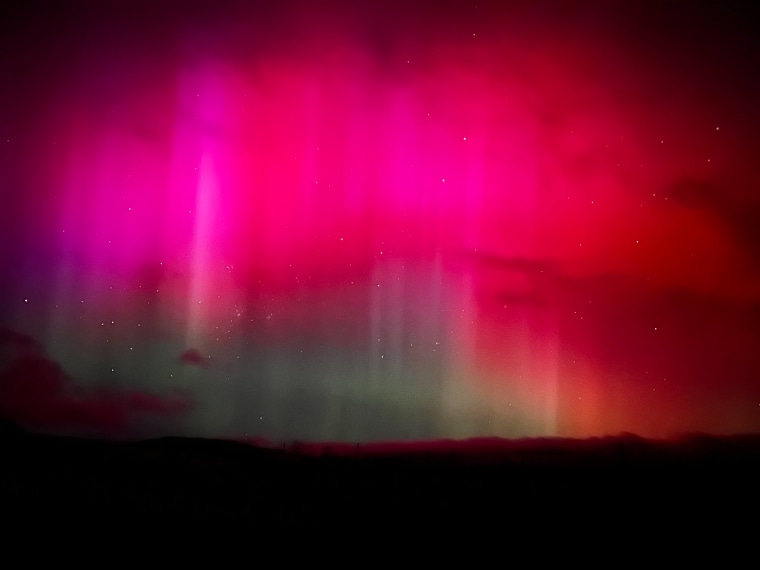
Brasher said geomagnetic storm activity was expected to continue. With the planet absorbing its impacts on a delayed timeframe, the visual effects could possibly stick around through Tuesday, he said.
“The region of the sun that’s the source of this weather has continued to be active,” Brasher said. “There is a chance for new events to occur based on that.”
The northern lights appear in the sky when charged particles spew from the sun during solar storms, making colorful light displays when clouds of those particles collide with Earth's magnetic field and interact with the atoms and molecules in Earth's upper atmosphere.
Typically, the northern lights are only seen in high latitudes, but during intense solar storms, like on Friday, they can be seen farther south than expected, with reports of sightings in Louisiana, Alabama , and Mississippi.
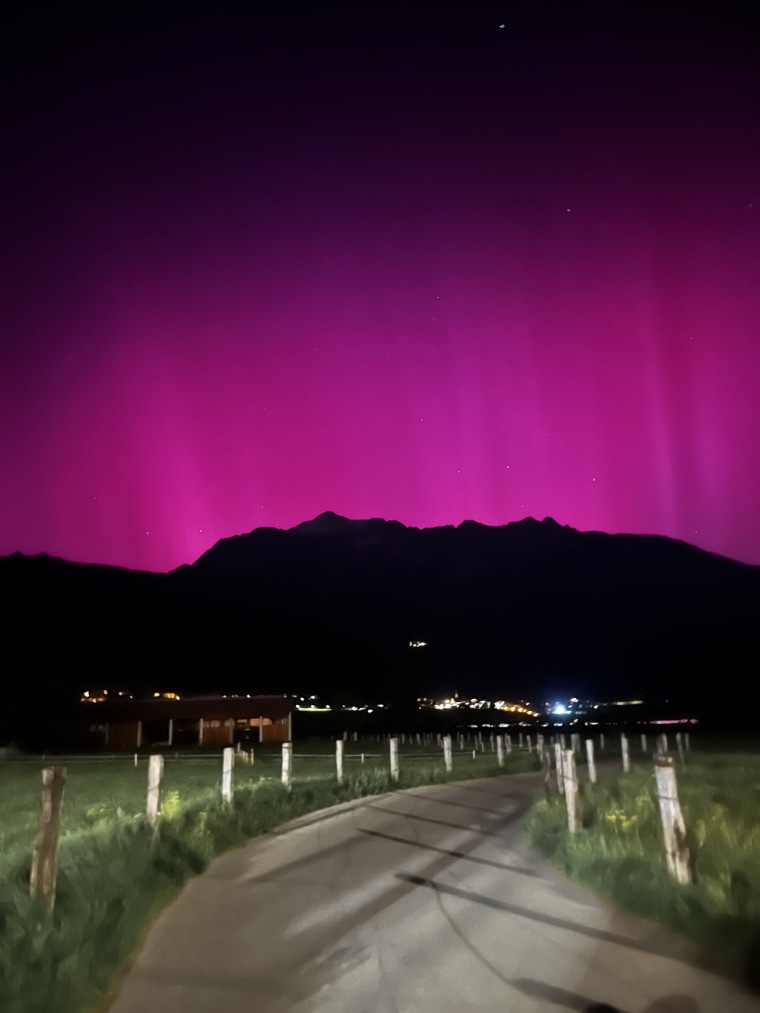
The cosmic show will likely follow this geomagnetic activity, according to the NOAA, which said that the ongoing storm has caused some reports of power grid issues.
NASA said Saturday that it had detected another sizable solar flare.
On social media, people posted pictures from a wide variety of locations around the world.
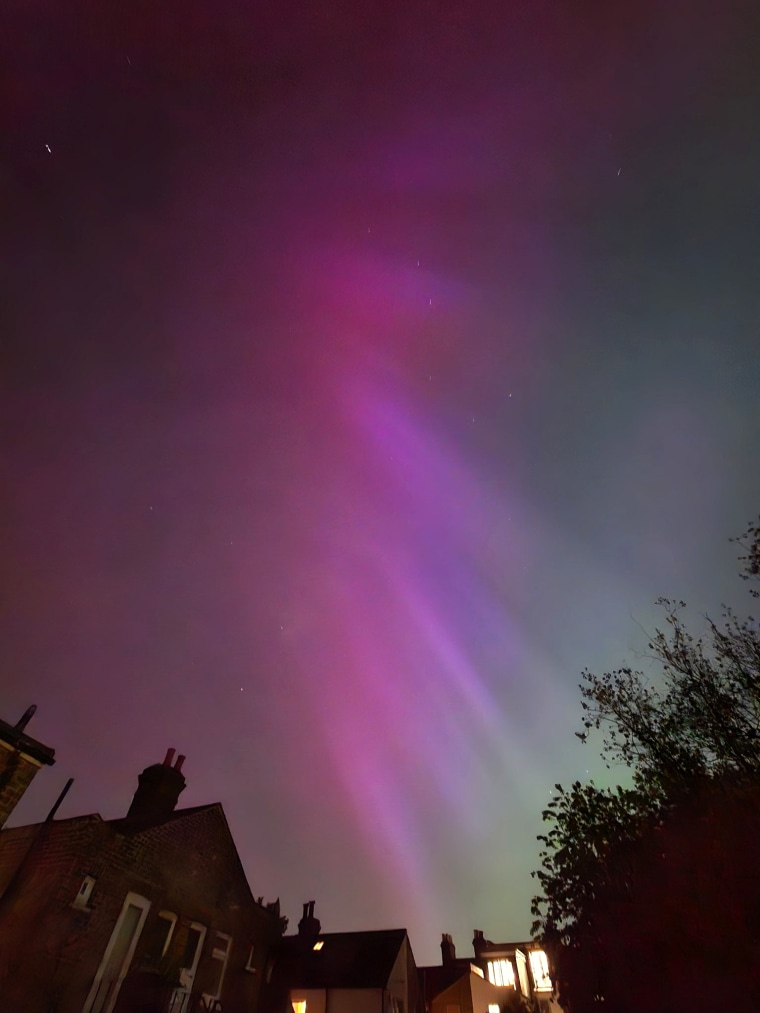
Rebecca Cohen is a breaking news reporter for NBC News.
Jean Lee is an associate reporter with NBC News’ Social Newsgathering team in Los Angeles. She previously reported for the NBC News consumer investigative unit.
Reporter with NBC News’ Social Newsgathering team

Showbizz Daily (English)
Secret Italy: 20 must-see places near Rome
Posted: November 29, 2023 | Last updated: November 29, 2023
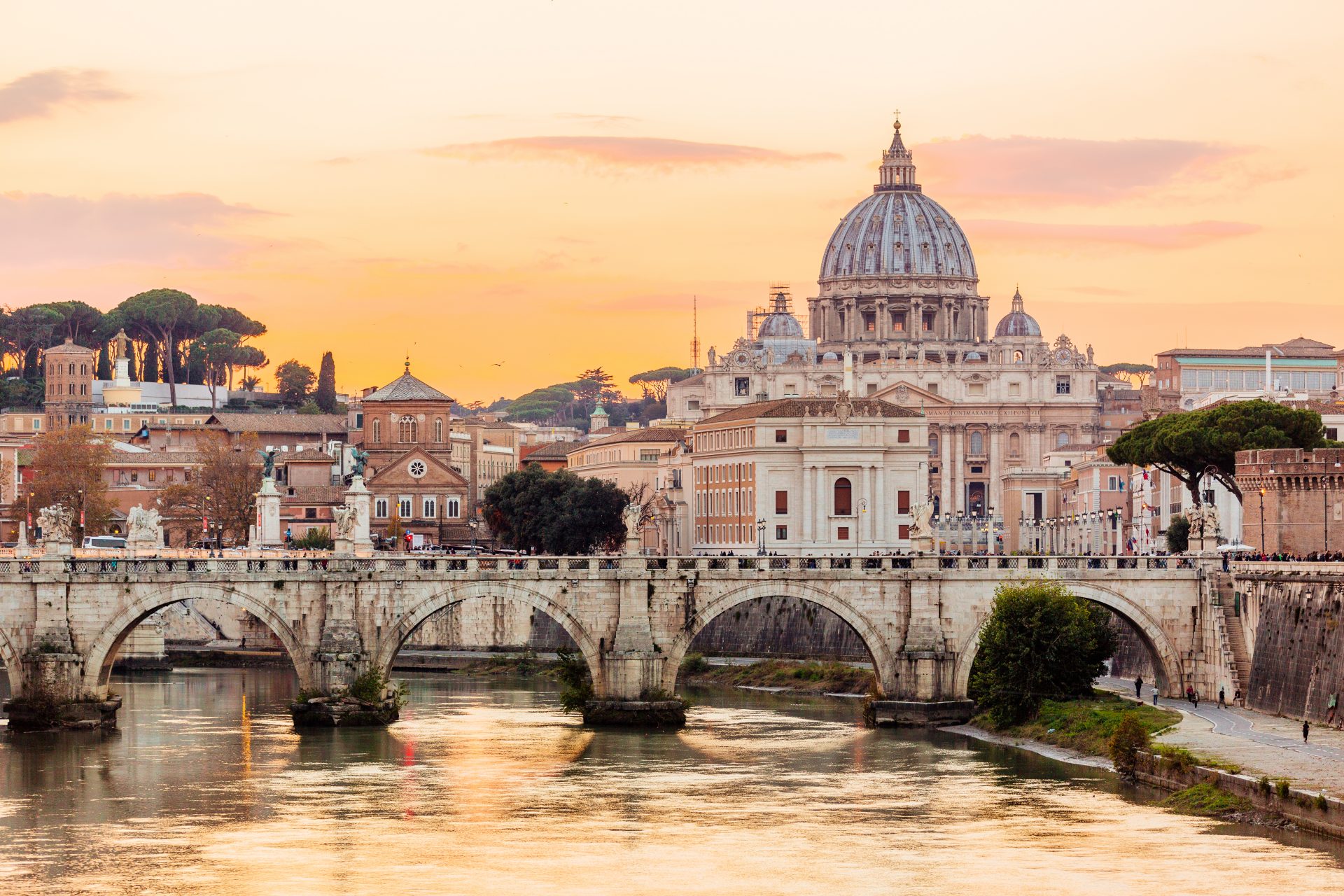
Rome and the wonders near the Eternal City
If you have already visited all the wonders that the Eternal City has to offer, or you want to go off the beaten track? These wonderful places, very close to Rome, are both relaxing and fascinating. From historical sites, villages in which time stood still, or simply enchanted landscapes, all is within reach of the Italian capital. Let's take a look!
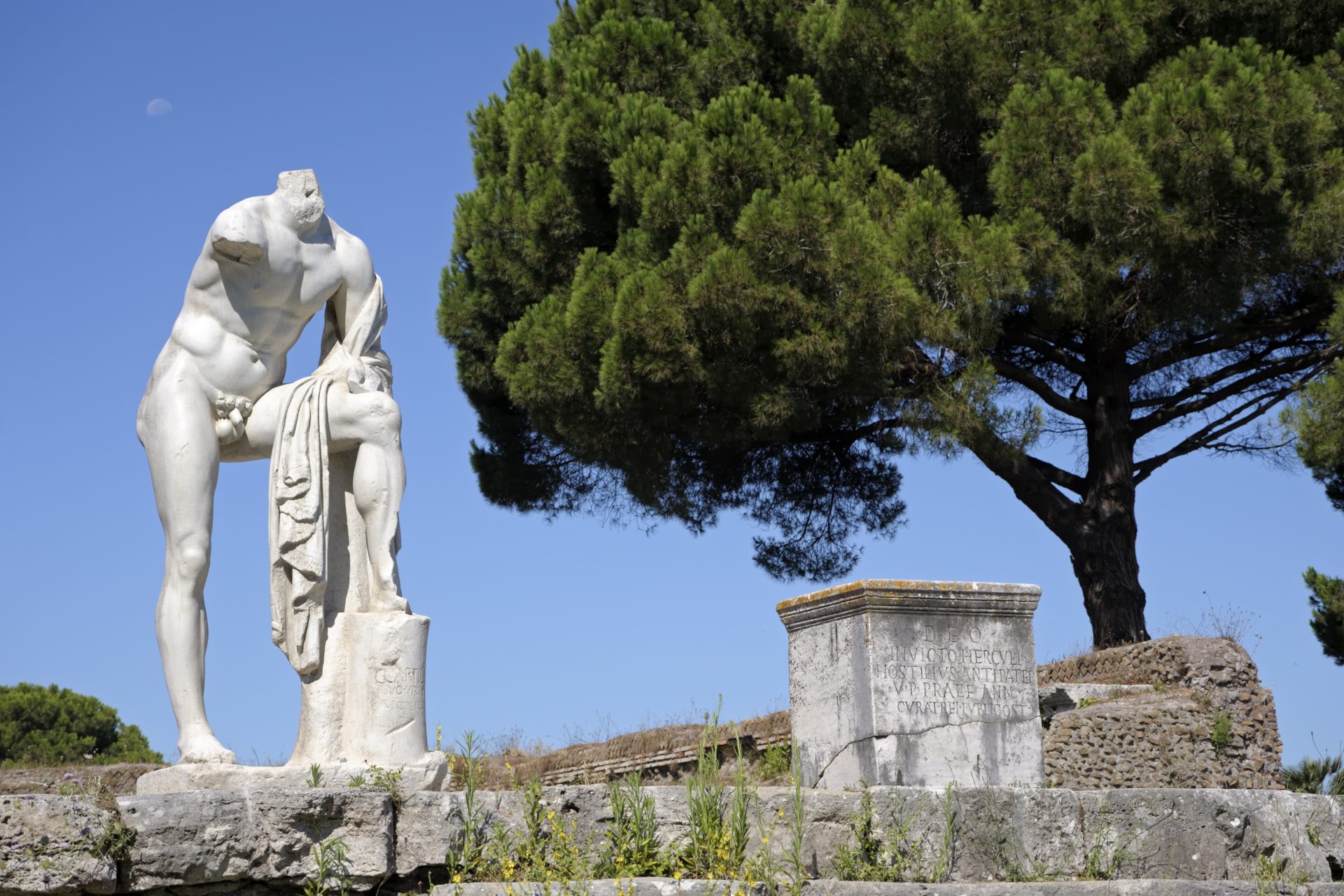
Ostia Antica
Reachable from Rome by car or subway, Ostia Antica is an essential destination for lovers of history and archeology. Located on the sea, at the mouth of the Tiber river, the splendid archaeological park of this miniature Rome is surrounded by greenery and one of the best preserved archaeological sites of the Roman era.
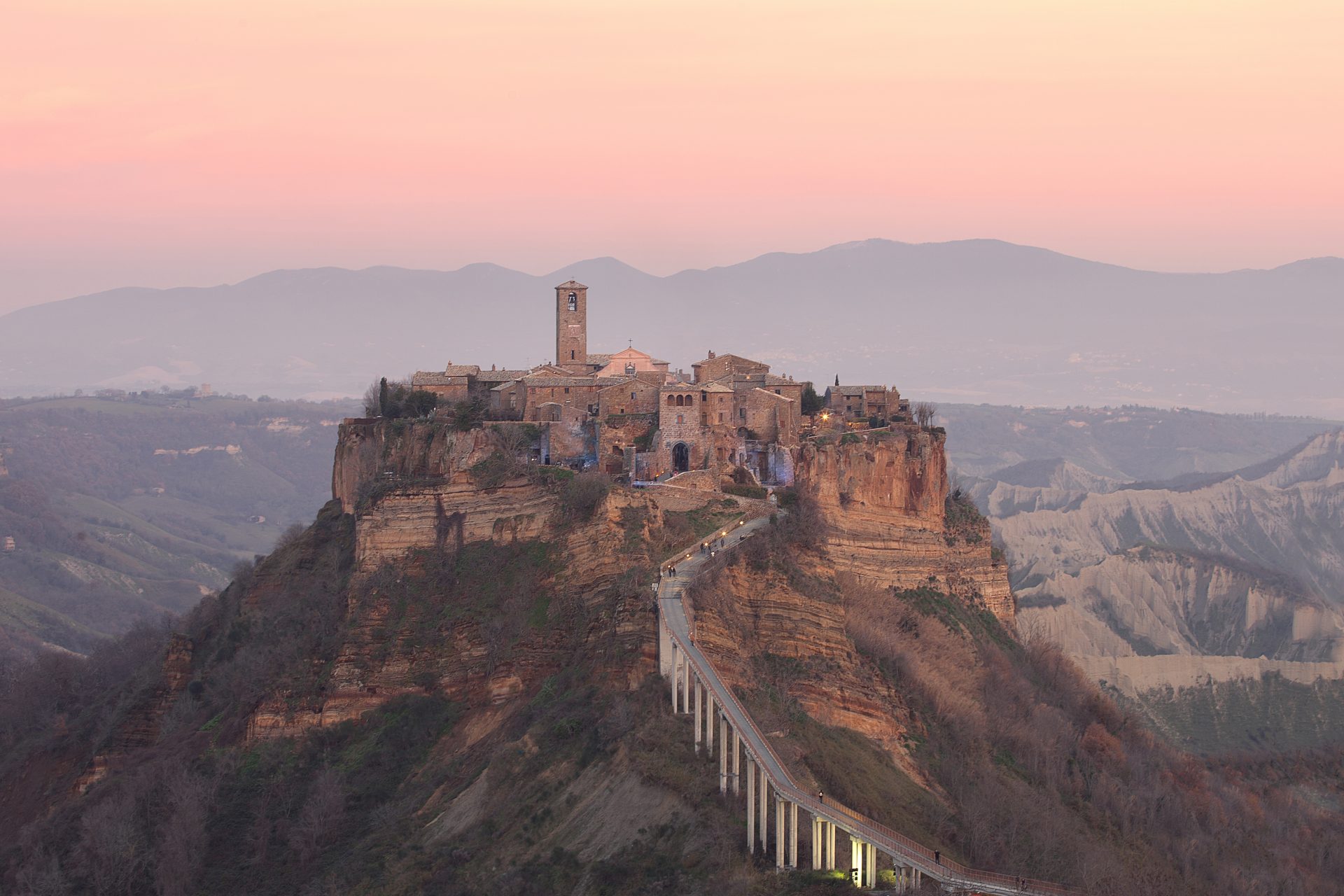
Civita di Bagnoregio
'The dying town:' this is how Italians define this wonderful village built on a hill. Its origins date back to the Etruscans - 2,500 years ago!. About two hours from Rome this village is one of 'the most beautiful in Italy.' It is accessible via a long bridge that can only be crossed on foot.
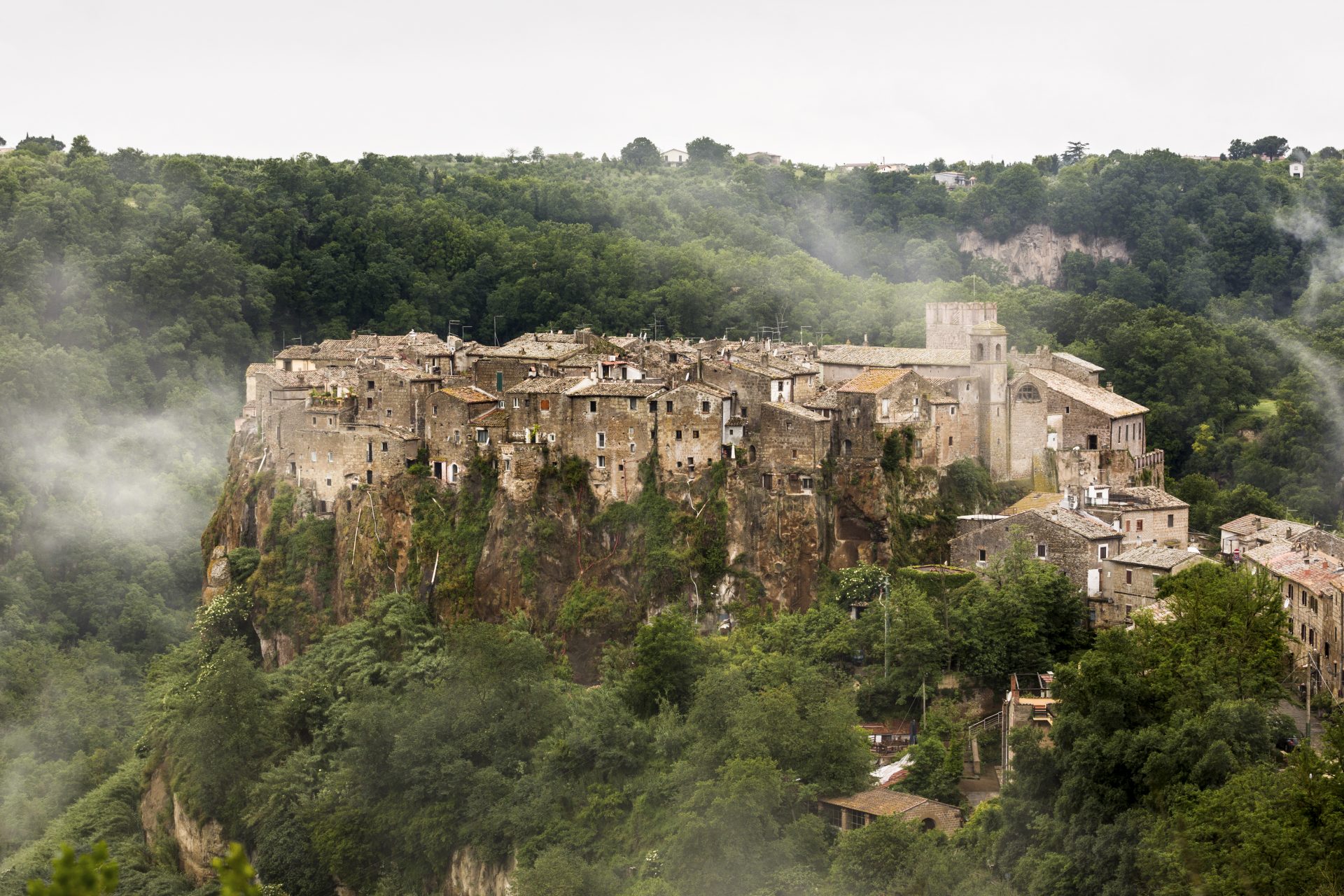
It is really worth visiting this jewel, just an hour from the capital, and getting lost in its narrow streets. The town was declared uninhabitable in 1935 but reoccupied in the 1960s by a group of hippies and artists. Legend has it that, at night, in its alleys, one can hear the song of witches.
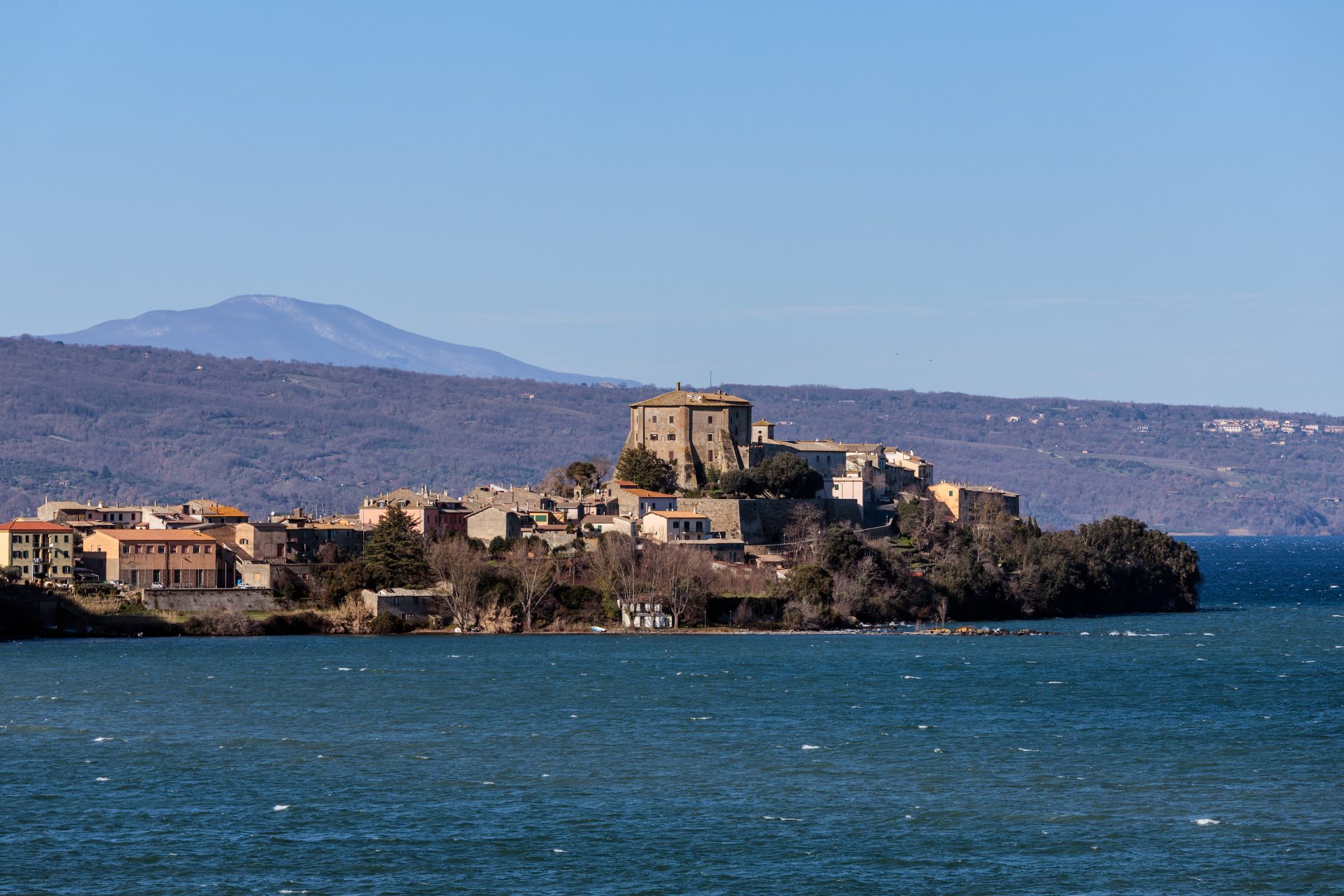
Lake Bolsena
If you are a lover of nature lover, will find the perfect spot in this beautiful lake of volcanic origin. If you visit Rome in summer, it can be a good place to escape the sweltering heat of the capital. In fact, Lake Bolsena is one of the few lakes in Italy suitable for bathing.
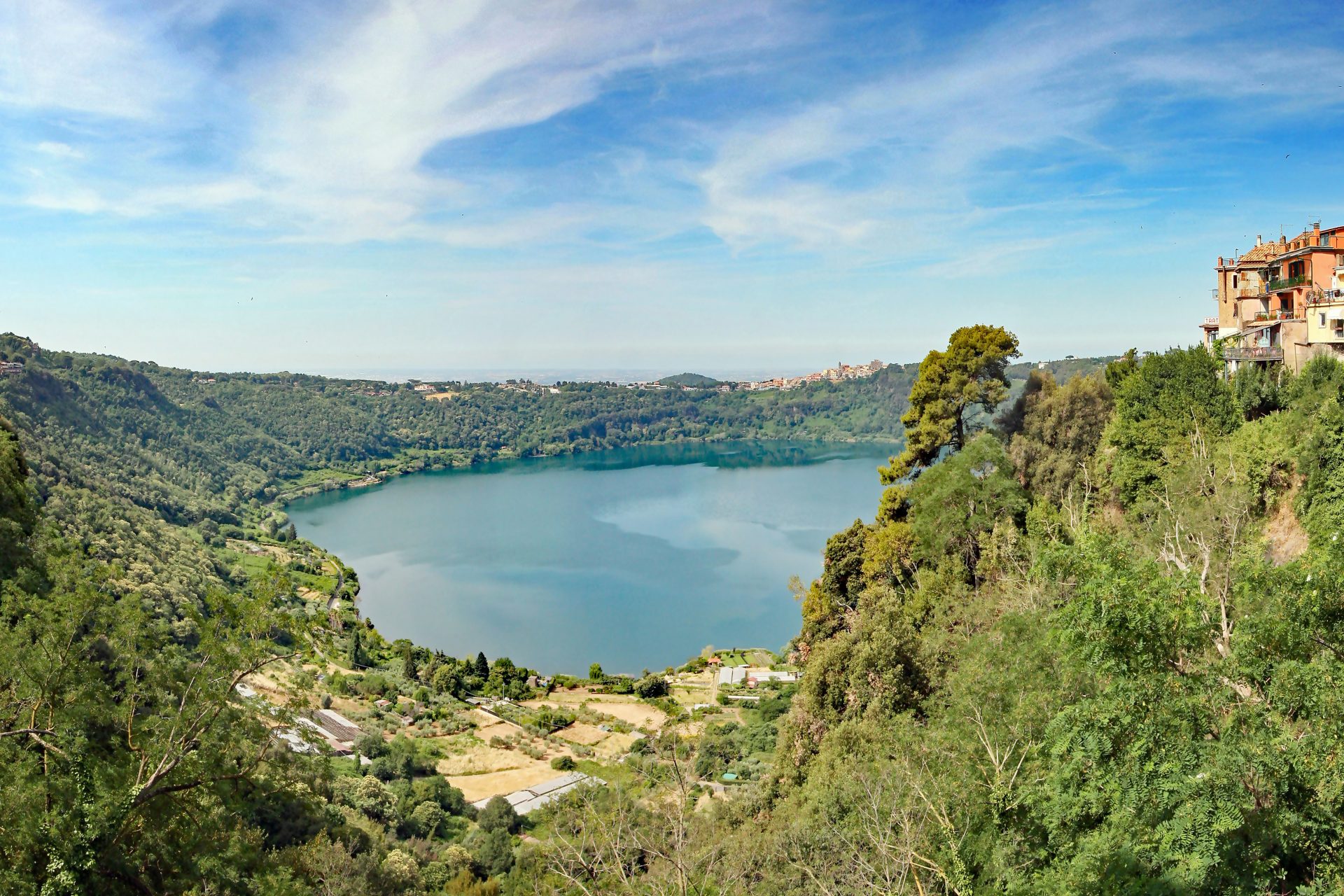
Located in the crater of an ancient volcano, this small lake, an hour from Rome, is a true oasis of peace: no wonder the Romans considered the surrounding woods to be sacred! Nemi is known for its wild strawberries. Legend has it that they were born from the tears of Venus as she was grief-stricken by the death of Adonis.

Anguillara Sabazia, Lake Bracciano
This splendid village is reflected in the waters of Lake Bracciano - where it is possible to swim! It is located just over 30 km (18.5 miles) from the capital and ideal for day trip. The town offers postcard views from any side you look at it. Not to be missed, especially at sunset.
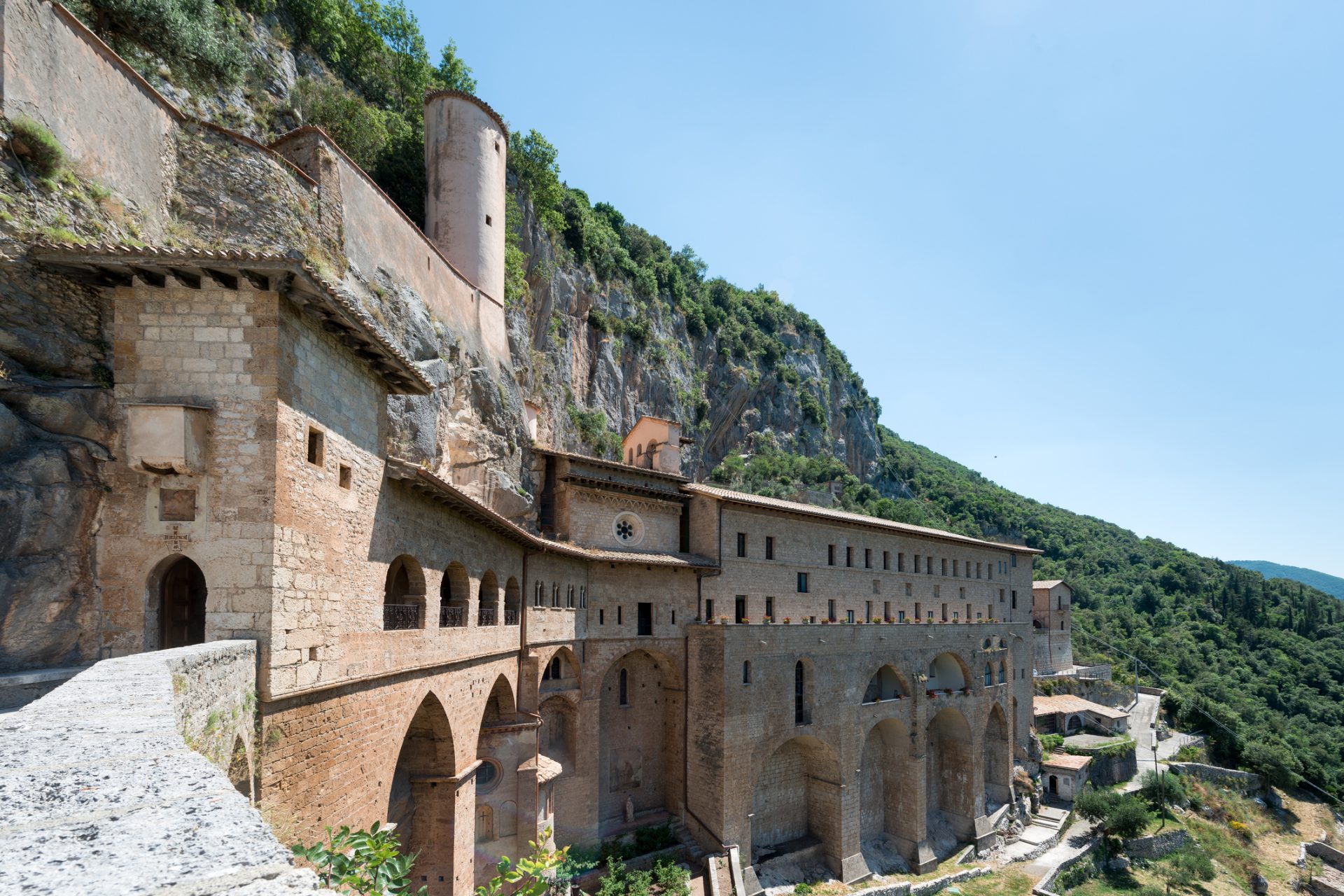
Included among the 'most beautiful villages in Italy,' Subiaco stands on a spur of limestone from which you can enjoy a fantastic view of the Parco dei Monti Simbruini. Rich in history and tradition, the village is the cradle of Benedictine monasticism. Along the road that leads from the monasteries to the historic center of Subiaco, you can see the remains of the villa of emperor Nero. The area lies 45 minutes from Rome.

Immersed in the green of the Roman countryside, about 30km (18.5 miles) from the capital and easily reachable by car, train or bus, is the city of Tivoli. Harboring the most ancient origins of Rome itself, the Tibur Superbum as Virgil says it in the Aeneid, Tivoli preserves masterpieces such as the Baroque Villa d'Este with its spectacular waterfalls (photo), and Villa Adriana, the magnificent villa of emperor Hadrian. Both have been labeled world human heritage.
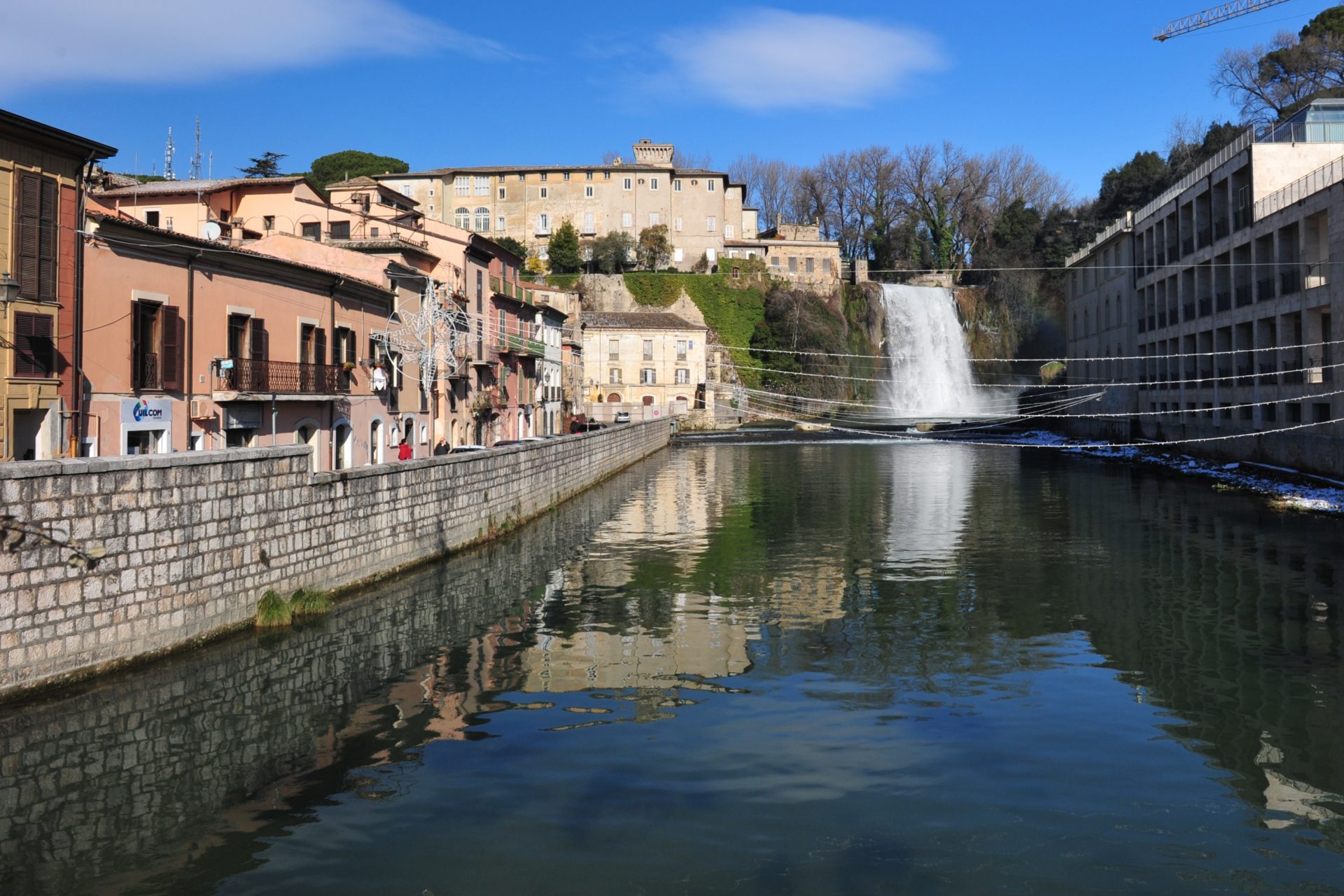
A waterfall of 30 meters (98,4 ft) is accompanied by a medieval castle in the historic center. Isola Liri is a perfect starting point for visiting nearby architectural treasures like the Abbey of Casamari and Montecassino. The town is very lively in the evening thanks to the numerous restaurants and bars along the Liri river.
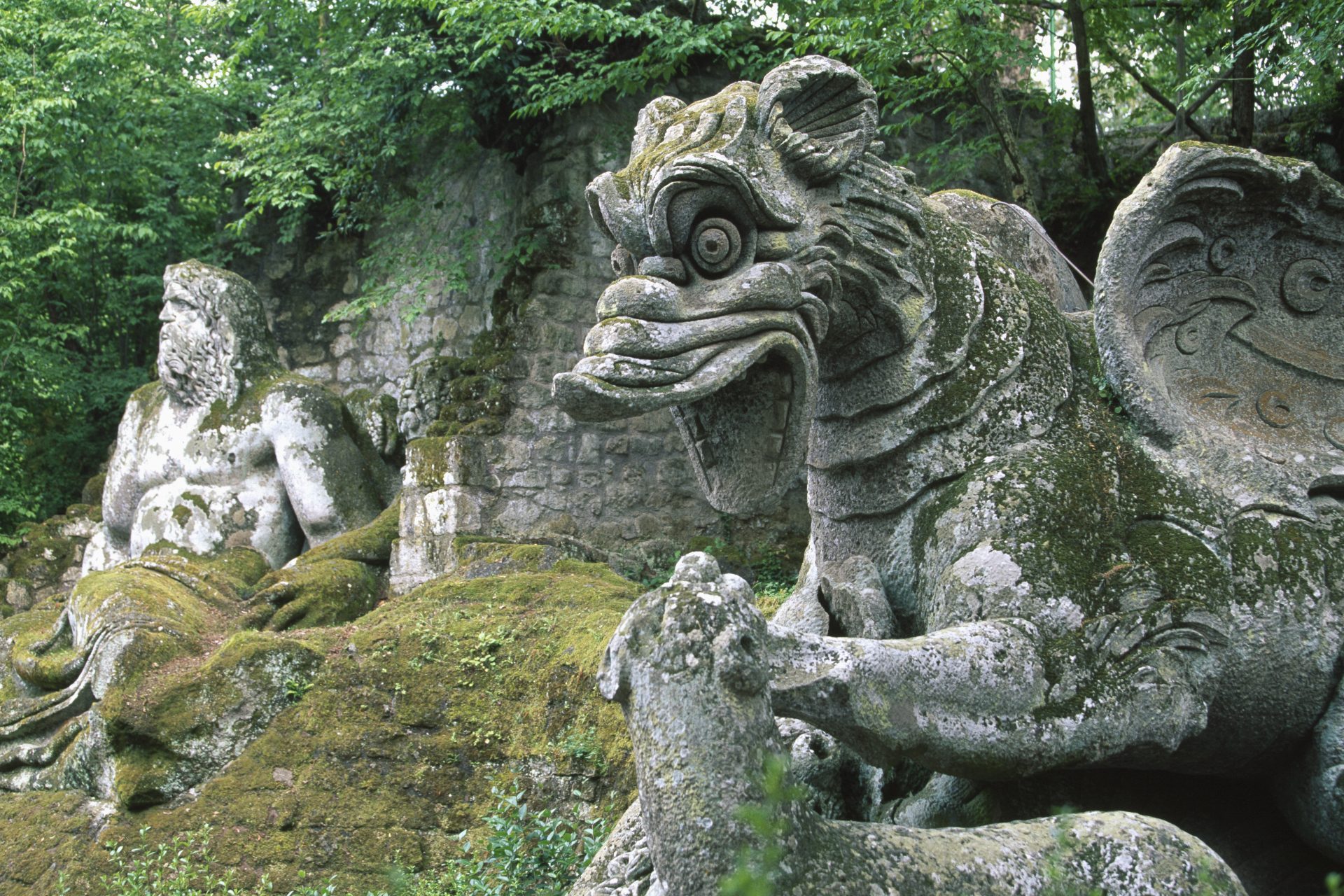
Sacred village of Bomarzo
The town of Bomarzo owes its fame mainly to its Parco Dei Mostri, created in 1547 at the behest of Prince Pier Francesco Orsini. Dominated by enigmatic mythological statues, alchemy symbols, and monsters of all kinds, this park is the object of study by philologists, scientists, and historians to this day. They continue trying to decipher the mysteries of this enchanted forest.
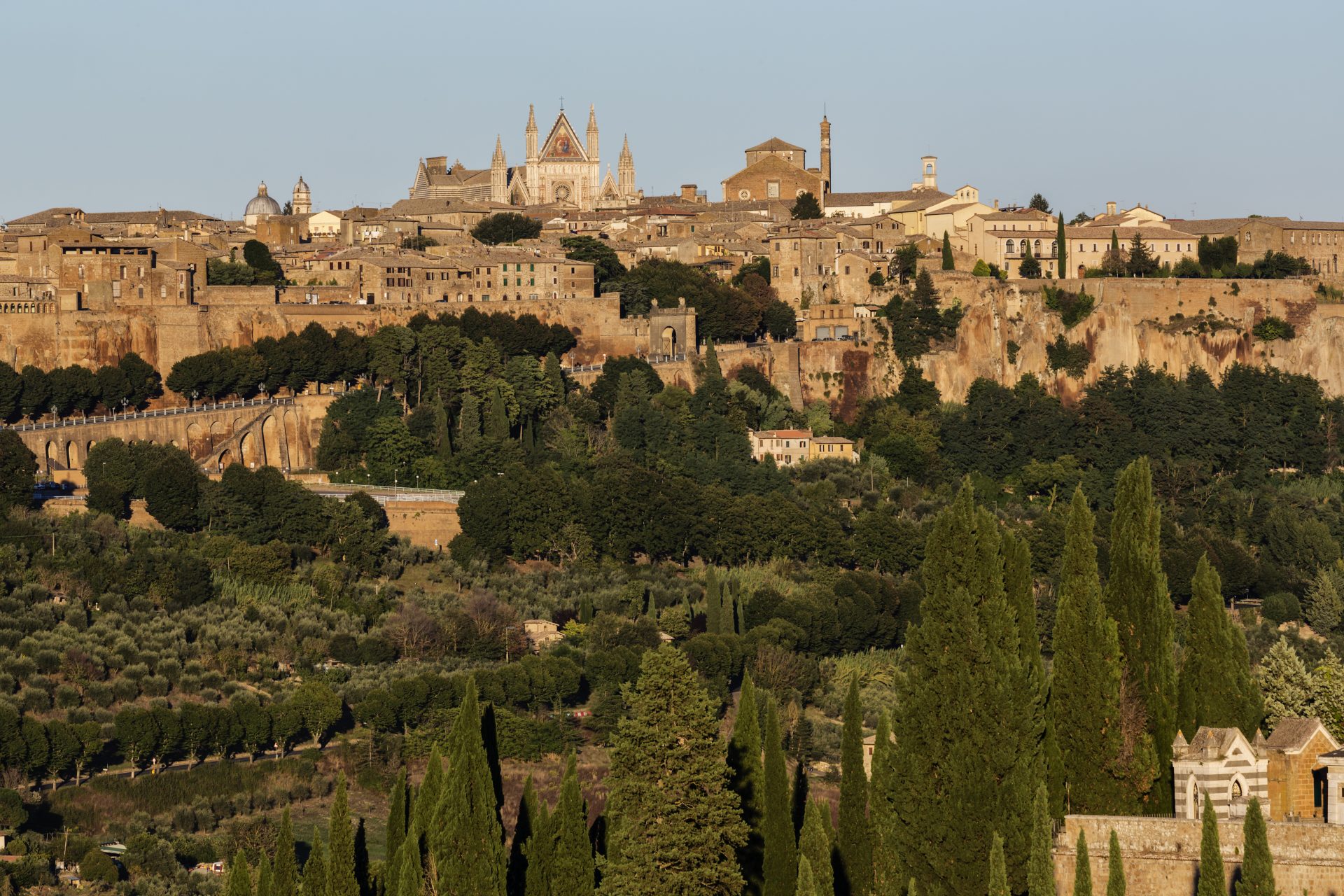
Founded as an Etruscan settlement and an important center for bronze working in Roman times, this town should be on anyone's bucket list. It has a spectacular 13th-century cathedral, called 'the golden lily of the cathedrals.' The view from the Torre del Moro is not to be missed either.
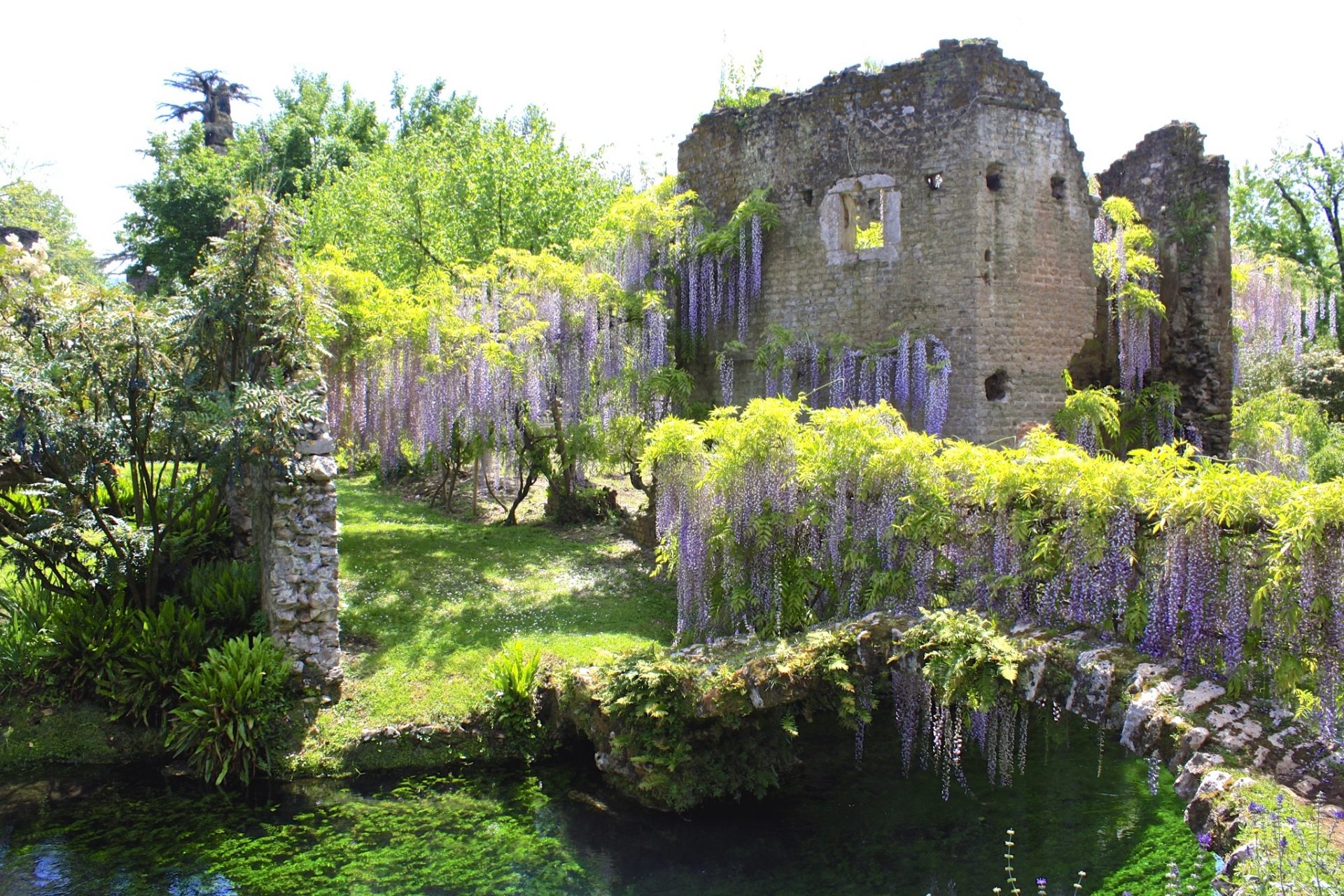
Garden of Ninfa
Cardinal Niccolò III Caetani, a lover of botany, ordered the construction of this fairy-tale place in the 16th century. He had the English garden built near the remains of the old medieval city of Ninfa. Its 8 hectares are home to more than a thousand plants and they are also a stage in the migratory path of many species of birds.
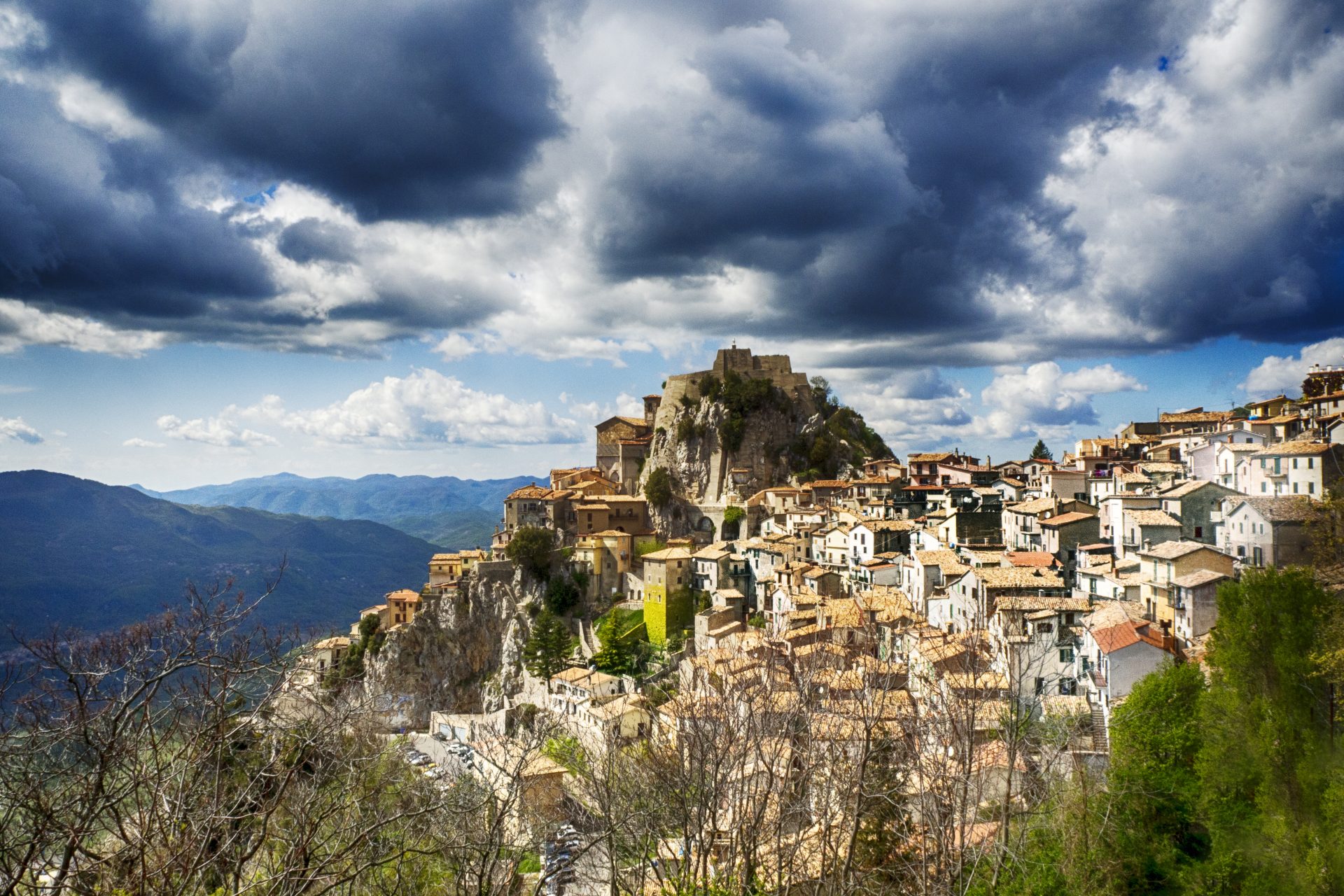
With an altitude of 1050 m (3444,8 ft), Cervara is the second-highest municipality in the province of Rome. It is, therefore, no surprise that it has some of the most breathtaking views in the area. The Scalinata Degli Artisti is an evocative path among the suggestive stone houses of the village and a tribute to the numerous artists who chose Cervara di Roma as their muse in the 19th century. On the walls of the staircase one can find the town's homage to Ennio Morricone, its honorary citizen.
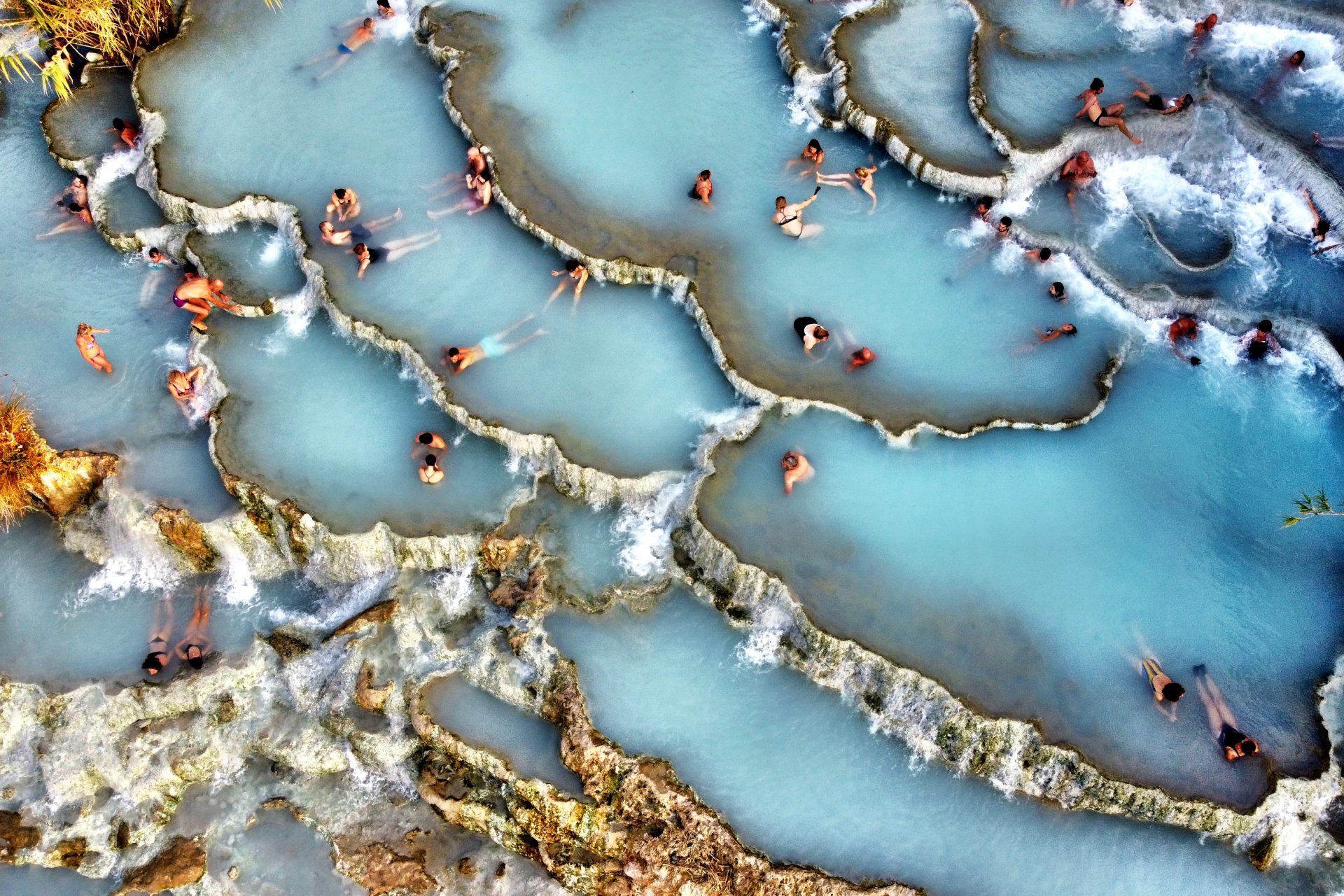
Saturnia's thermal baths
With sulfurous waters that flow at 37º Celsius, these spectacular spas have a thousand-year history. In fact, they were already highly appreciated by the Etruscans and Romans. The thermal waters also feed the 'Cascate del Mulino:' small natural limestone pools carved into the water over the centuries. They are an oasis of peace that can be visited without limitations. We do not recommend visiting them during the weekend, though, as excessive crowding may limit some of this wonderful experience.
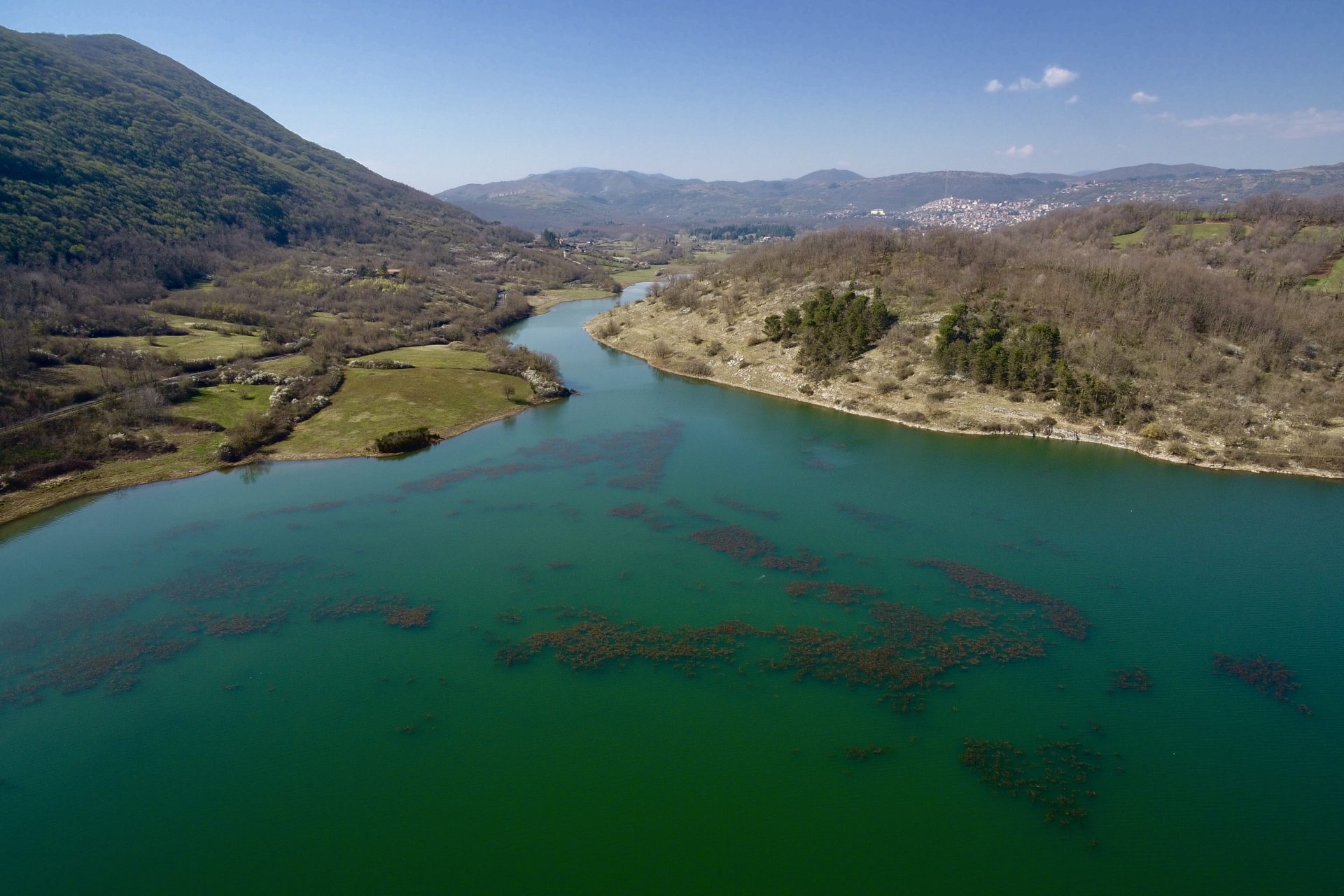
Lake Canterno
This lake is one of the most poetic and interesting tourist routes for nature lovers. Surrounded by the Ernici mountains and oak woods, it is best visited in spring when nature is at its best. Keep in mind, however, that the lake is not suitable for swimming.
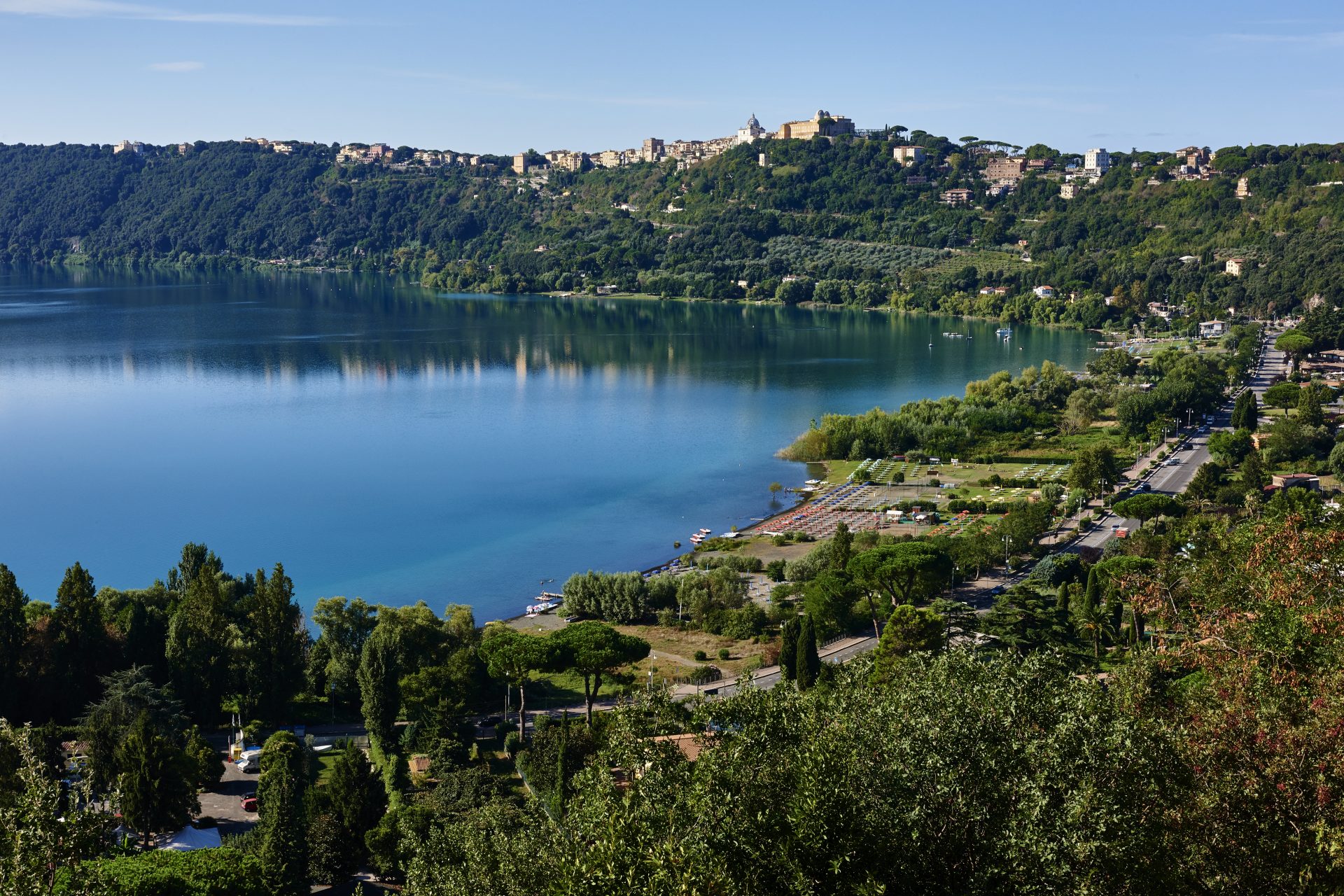
Castel Gandolfo and Lake Albano
Elected as one of the 'most beautiful villages in Italy,' Castel Gandolfo is located just over 30 minutes from the capital. Known above all for hosting the former summer residence of the popes (now part of the Vatican Museums), this town with its elegant historic center is a must for those who want to combine nature and art in one excursion.

Inhabited since the Paleolithic era, founded by the Spartans, this small town rises on the Pontine seafront. Even the Romans appreciated the place and used it for their summer holidays: they built sumptuous villas whose remains can still be admired. The villa of emperor Tiberius, for example, has terraces facing the sea. Sperlonga, with its white houses and unexpected views of the sea from the narrow streets of the historic center,is worth visiting anytime of the year.
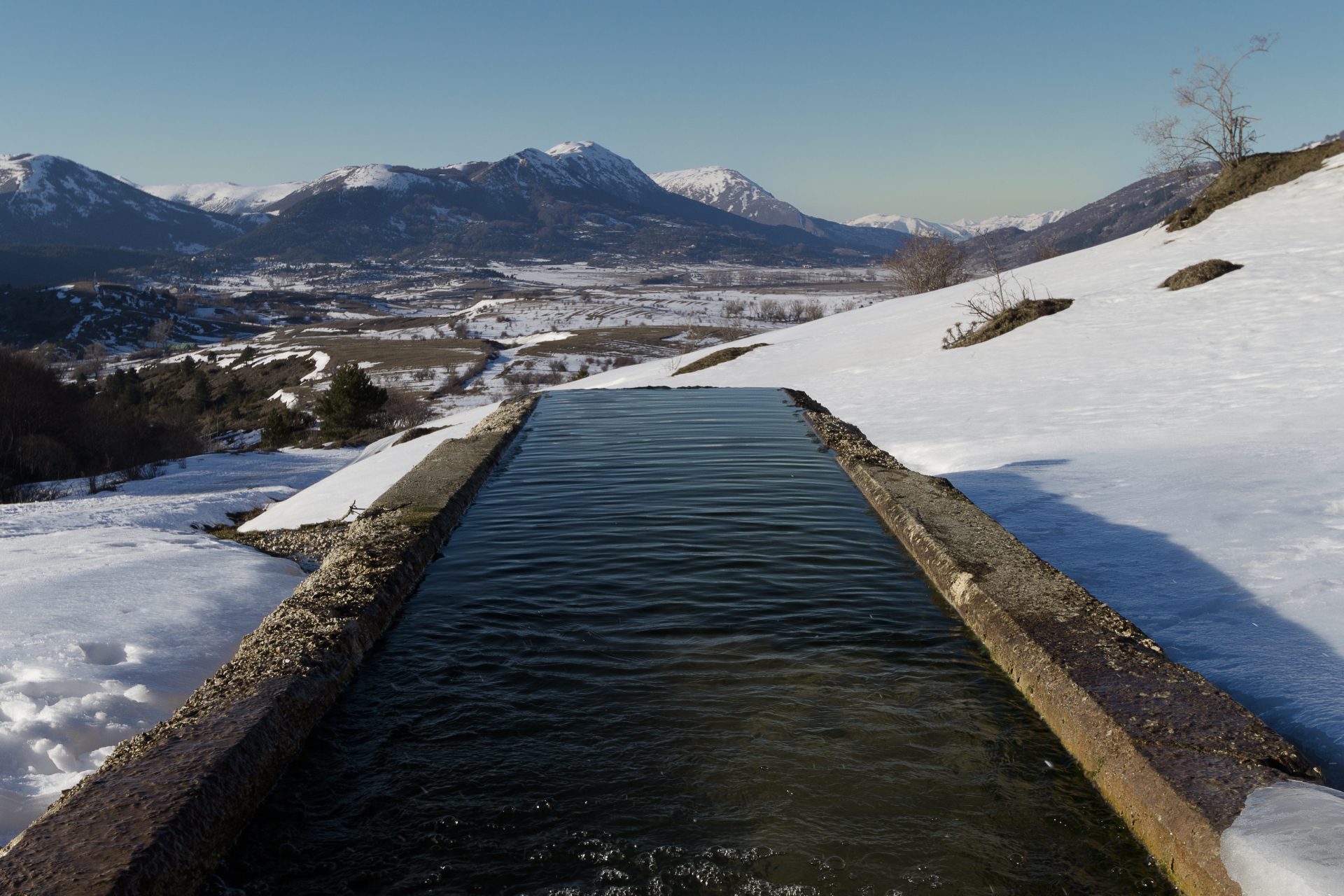
Located in the protected area of the Sirente-Velino Regional Natural Park, Ovindoli is an exceptional destination for lovers of winter sports. It has 21 slopes, three chairlifts, a ski lift, and the longest moving walkway in Italy. It is also perfect in summer for those who prefer fresh mountain air to a beach holiday. This beautiful mountain town is only 1.5 hour from Rome.
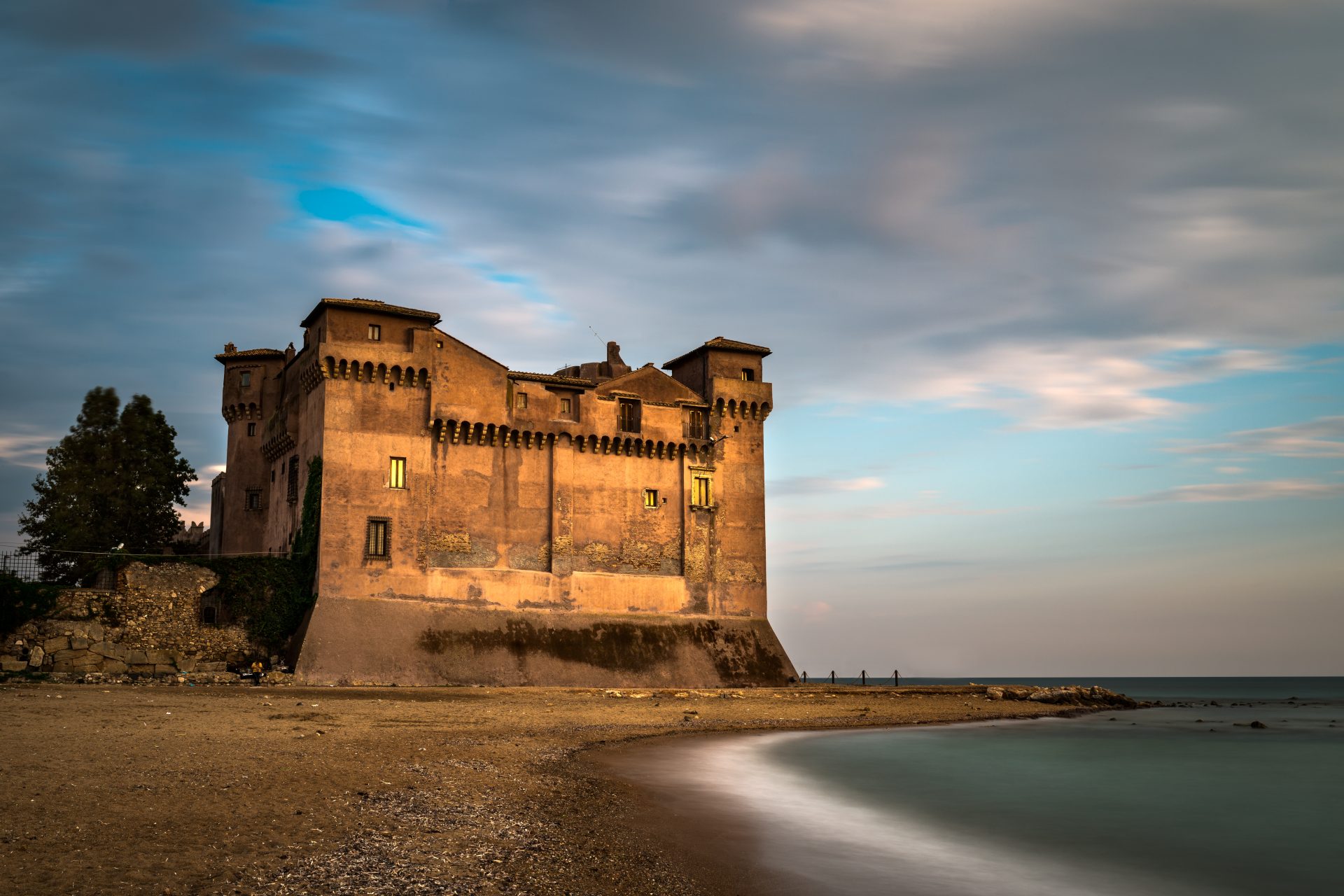
Santa Severa
Santa Severa is not only a splendid seaside resort but also a place rich in monuments of great historical interest. Among them is the castle of the same name (photo), one of the most romantic and evocative places in all of Lazio. Built on the remains of an important Etruscan town (Pyrgi), Santa Severa can be easily reached from Rome by train. The distance is only 50 km (31 miles).
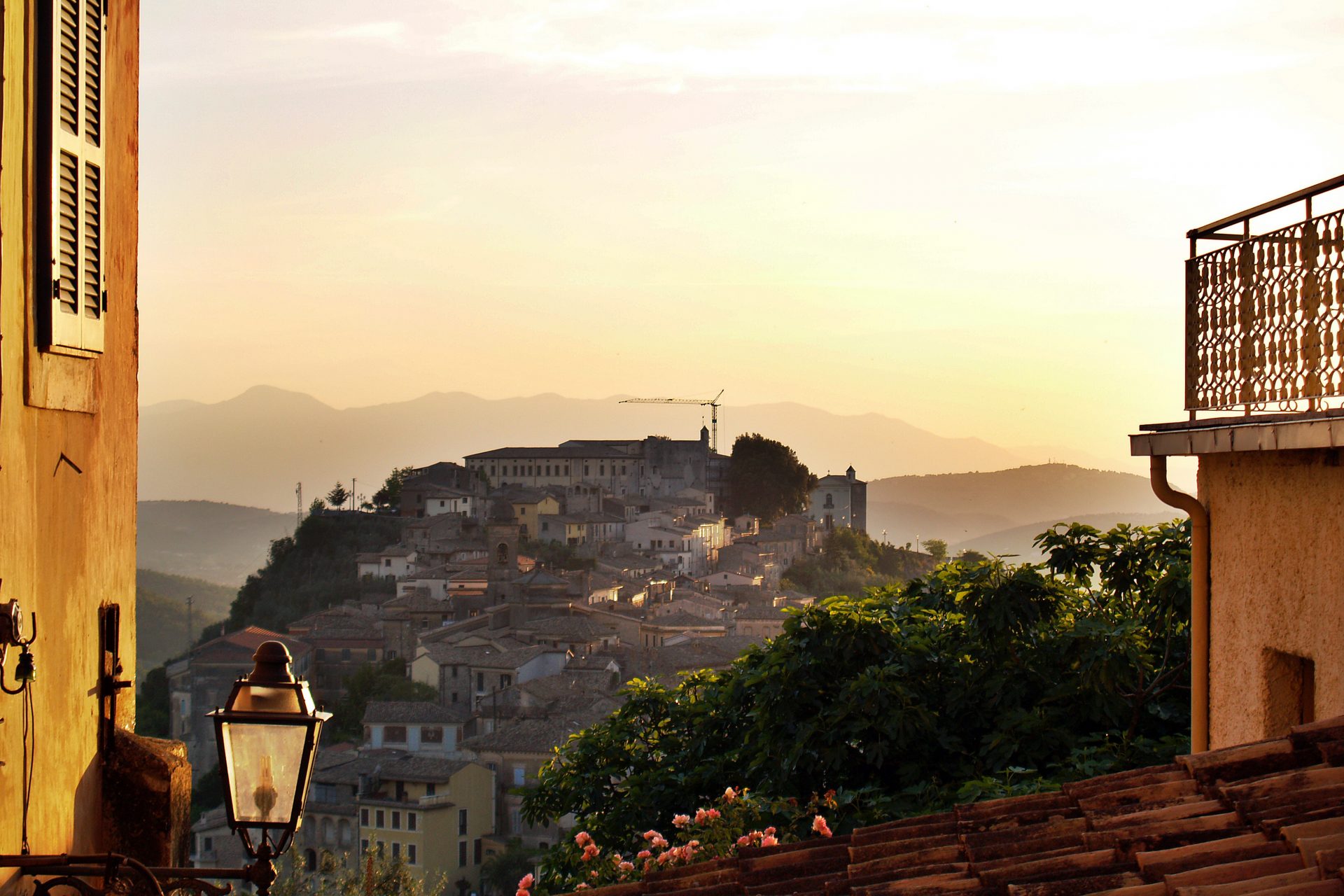
This town's origins are not Roman; they are even older. The evidence lies in the cyclopean walls of the acropolis which, according to some, date back to the Iron Age (VIII / VII century BC). Together with the medieval tower overlooking the town, the ruins are well worth a visit. Arpino also boasts a spectacular gastronomy. Finally, the panorama that opens to the eyes of visitors from its narrow streets, is incomparable - especially at sunset.
More for You
Jennifer Garner and Ben Affleck's daughter Violet graduates: See the emotional reaction
17 Things We Have Been Taught to Accept But We Shouldn’t
Transgender teen booed after winning girls’ track race at state championship
4 Chain Restaurants With The Absolute Best Chicken Pot Pie And 4 With The Worst
‘You’re both basically making minimum wage’: Self-employed couple have 2 kids, $4.5K in savings, $175K in debt and worry they’ll retire broke, but refuse to get 9-5 jobs. Ramit Sethi responds
The Sleep Habit That’s More Important Than Getting 8 Hours
Kevin Costner Makes Rare Red Carpet Appearance With 5 of His Children
Jon Lovitz: It seems the parties 'switched completely' on Israel
These Breeds Make the Best Guard Dogs
When is Pat Sajak’s last show on ‘Wheel of Fortune’? Release date, where to watch
Putin's brand new £26,000,000 missile ship Tsyklon struck
Eminem shares father-daughter dance with Hailie Jade as she marries Evan McClintock
Cleveland Browns Receive Another Huge Injury Update On Nick Chubb For 2024
WNBA Rookie Caitlin Clark Signs Historic Business Deal
States with the Most Foxes in America
'Wheel of Fortune' Praised for Not Allowing Contestant's Answer
I make 4 times more money than my husband earns. He later admitted he was jealous of me being the breadwinner.
Justin Long Says His ‘Dodgeball' Casting Got ‘Pushback' from Studio: ‘I Was Way Too Old to Play That Part'
What Does Your Favorite Color Say About Your Personality?
Trump prosecutor Fani Willis survives Georgia primary election
Money latest: Popular restaurant chain launches legal bid over cockney rhyming slang for curry
Dishoom has launched a legal battle over the cockney rhyming slang for curry. Read this and the rest of today's consumer and personal finance news - and leave a comment - below.
Tuesday 21 May 2024 20:26, UK
- Inflation could hit 2% target - with announcement at 7am on Wednesday
- UK economy heading for 'soft landing' but mistakes have been made, says IMF
- Good news for drivers as oil prices hit two-month low
- Dishoom launches legal battle over the cockney rhyming slang for curry
Essential reads
- Easiest countries for Britons to retire
- Britons should treat tea more like wine, expert says - as some secrets of improving flavour revealed
- Money Problem : 'My second-hand Ford is being written off with a known issue - but no one is taking responsibility'
- How to sell your home without an estate agent
- Basically... What is the FTSE
- Best of the Money blog - an archive
Ask a question or make a comment
Nationwide has doubled its maximum personal loan amount from £25,000 to £50,000.
The building society said its decision would help customers cope with rising construction costs, with many turning to loans to help with home improvement projects.
More than four in 10 households were hoping to start renovation plans and the end of this month, it said.
But, with recent forecasts predicting a 15% uplift in building costs over the next five years, they could be facing much steeper bills.
"With the impact of inflation and other external pressures, the costs of construction have seen significant increases in recent years," said head of personal loans at Nationwide Darren Bailey.
"However, we recognise many people will want to continue with the home improvement plans, even if that means they have downscaled their plans to accommodate their budget.
"Our increased maximum personal loan size of £50,000 means we have an option to suit everyone."
The increased loan amount will be available to Nationwide current account holders.
Customers can apply for the loan online, in branch or on the phone and receive the money the same day.
PrettyLittleThing has been reprimanded for posting "misleading" adverts, marking its ninth warning in four years.
Complaints about the online fashion retailer were made following its Black Friday social media campaign in November.
The Advertising Standards Authority investigated 15 posts on X, which mentioned several discounts ranging from 30% to 99%.
PrettyLittleThing said the period had become well known to consumers in the UK as a time when business offered promotions.
It also said its advertising and marketing was "reflective of what their customers wanted and expected", and "further terms and conditions were on their website".
However, the ASA found three issues with the campaign.
It said some misled customers into believing all products were included in the promotion, when some were excluded.
Others failed to specify when the deal ended, and some breached advertising rules with the "inclusion of closing dates from ads when promotional periods were shortened or extended".
In previous rulings, the company was found to have: broken the ASA's rules on offence and responsibility by objectifying women; run social media partnerships with influencers that did not make clear they were ads; run promotions that had not been administered fairly.
"While one breach of our rules is one too many, the bulk of the rulings were between 2020-22," the ASA told the Money team.
"To date, two have been published in the last two years. We hope the downward trend in upheld rulings continues but will take action if we see any ongoing issues."
Inflation is forecast to have fallen to around the Bank of England's 2% target in April - with an announcement at 7am on Wednesday.
A fall in the energy price cap at the start of April is a key reason - energy prices have been a driver of the huge price rises seen in the last two years.
The Bank itself forecast inflation could hit 2.1% for April - down from 3.2% in March and the 40-year high of 11.1% in October 2022.
Respected insights firm Pantheon Macroeconomics thinks it could hit 2% due to "four components"...
- Ofgem's 12.3% price cap cut that took effect in April will slice 40bp off CPI inflation;
- Food inflation shaves another 14bp off overall inflation, as fading commodity-price rises pass through to consumers;
- The BRC Shop Price Index suggests another fall in goods inflation, with help from weaker global costs, cutting headline inflation by 36bp;
- Services inflation is estimated to have fallen to 5.4% in April, from 6.0% in March - a range of items such as mobile bills and rents saw hikes, but these were less severe than those a year previously.
Industry figures released on Tuesday suggest food inflation is indeed falling...
The main upward driver of inflation in April was the price of petrol, which spiked during the month due to Iran-Israel tensions.
Capital Economics also forecasts overall CPI could dip to 2% - and says we could see inflation at 1% later this year, lower than the BoE expects.
It thinks energy prices will keep falling and "that, in response to the previous falls in agricultural commodity prices, CPI food inflation will fall below zero".
Inflation falls will influence how soon we get an interest rate cut - as rates are kept high in order to tame inflation by squeezing the economy.
The next Bank of England decision is on 20 June.
Pantheon says: "Markets are pricing a 60% chance of a rate cut in June and more than fully pricing one by August, so the key question is not whether the MPC will ease soon but how quickly it will cut again after the first reduction.
"We expect one cut per quarter to a 3.5% terminal rate, but with risks skewed to the BoE pausing temporarily at 4.0% to 4.5%."
Hotel Chocolat is to open 20 stores over the next 18 months and is expanding its online reach.
The shops will open in retail parks and feature a different design concept.
Speaking during Retail Gazette's Future Consumer Debate, the company's head of customer marketing, Amy Harman, said shoppers want to be able to see, smell and feel the chocolate they're buying.
"That's very much what we’re looking to do in our stores," she said.
Explaining the choice to target retail parks, she said that's where the footfall and demand is.
"There's more intent with consumers. They're going for a day out and going for an experience," she added.
The announcement comes as the brand prepares to launch on TikTok shop in the coming weeks as it looks to expand its online audience.
Dishoom has launched a legal battle over the cockney rhyming slang for curry.
The restaurant chain, which can be found in London, Manchester, Edinburgh and Birmingham, has asked for the term Ruby Murray to be freed up by the Intellectual Property Office.
At the moment, a man named Tariq Aziz has the rights to the name for food and drink uses, with an IPO filing showing he registered the trademark in 2019.
A search of the IPO site shows an application to revoke the trademark registration on the grounds that it has never been used was filed on 15 May by Dishoom Limited.
Mr Aziz now has until 15 July to indicate whether he will offer a defence.
If he fails to do so, the trademark will be revoked and removed from the register.
A Dishoom spokesperson told the Money team it doesn't believe the trademark's owner has ever used it.
"There is a principle of 'use or lose it' in trademark law and we have therefore asked the UK IPO to remove the Ruby Murray mark from the register," they said.
"Dishoom is not seeking to apply to register Ruby Murray in its own name; it wishes to remove the 'monopoly' on the use of Ruby Murray so it can be used freely by anyone when referring to curry."
Dishoom does have a chicken ruby on its menu and in its cookbook and the Money team are big, big fans.
The International Monetary Fund has said the UK economy is heading for a "soft landing", but reiterated its message to Jeremy Hunt that he should not have cut National Insurance at the last two fiscal events.
In its annual check-up on the state of Britain's economy, the Washington-based Fund raised its forecast for gross domestic product growth this year from 0.5% to 0.7%, saying: "The UK economy is approaching a soft landing, with a recovery in growth expected in 2024, strengthening in 2025."
The Fund now expects inflation to come down to close to 2% in the coming months, and the Bank of England to cut interest rates by as much as three quarters of a percent this year, and then another percentage point next year.
The chancellor welcomed the Fund's Article IV report, saying: "Today's report clearly shows that independent international economists agree that the UK economy has turned a corner and is on course for a soft landing.
"The IMF have upgraded our growth for this year and forecast we will grow faster than any other large European country over the next six years - so it is time to shake off some of the unjustified pessimism about our prospects."
Government 'won't meet its debt target'
However, the IMF, which has warned the government explicitly in the past not to cut taxes too fast, in the face of rising spending projections in future, said the two 2p National Insurance contribution cuts at the last two fiscal events were a mistake.
"In light of the medium-term fiscal challenge", the report said, "staff would have recommended against the NIC rate cuts, given their significant cost."
The Fund's staff also believes the government is not on track to meet its main fiscal rule, which commits it to cutting the national debt in five years' time.
It believes net debt will carry on rising towards 97% of GDP in the following years, instead of falling back to 93% of GDP, as the Office for Budget Responsibility has forecast.
The Fund's double-edged report comes amid improving news for the UK.
Data released two weeks ago showed the country ended its short-lived recession with faster than expected growth in the first quarter of the year.
The Office for National Statistics is expected to announce tomorrow that inflation dropped close to the Bank of England's 2% target in April. That may enable the Bank to begin cutting interest rates from their 5.25% level in June or August.
Bank should speak more
The Fund's report contained a number of other recommendations for economic policy in the UK, including that the Bank of England should commit to more news conferences to explain its decisions, and that the government should consider imposing road charges to replace the revenue lost from fuel duty as electric cars become more predominant on UK roads.
For many Britons, retirement means moving somewhere new.
New analysis from relocation experts Property Guides has found the easiest locations for retirees, taking into account culture, visa requirements, cost and more.
Landing in the number one spot is Ireland, with a lack of visa requirements, English-speaking residents and relatively "safe and happy" environment.
Spain, Portugal and Cyprus claim the next three spots on the list.
However, Spain is high on the minimum annual income requirement.
"Spain's is one of the most expensive. It is currently around €27,000 (£23,000) per year for the first applicant. Just over the border in Portugal, it is less than €8,500 per year. Turkey's is the cheapest, working out at a little over £5,000, while Italy requires over €30,000," Property Guides says.
Turkey also came out well for the low cost of living - unlike New Zealand.
European countries in general offer visas aimed specifically at those receiving pensions or investment incomes, according to Property Guides.
Commonwealth countries such as Australia and Canada, however, actively restrict those over 55 from moving there, even if they have a high passive income (income such as pensions, that doesn't require a job).
It becomes easier if retirees have children who are already legal residents.
"Golden visas", which encourage wealthy people to invest in a country, are becoming less common.
"Most countries are now cancelling their residential investment option, including Cyprus and Portugal, and Spain will soon be closing its own. However, for now, you can still get one in Spain, Greece and Turkey, for as little as a €250,000 property, and these we have judged the easiest to retire to."
Property Guides also looked at health services. They took rankings from a Legatum Prosperity Index.
"Top scorers were Germany, Italy and France, in that order. Bottom of the pile was the USA."
The research noted that state pensions are not uprated for retirees in Canada, New Zealand and Australia.
It also factored in "sunshine hours", with the top three being Cyprus, Portugal and the US. Ireland came last here.
By Sarah Taaffe-Maguire , business reporter
Good news for motorists: oil prices are at a more than two-month low at $83.08 for a barrel of Brent crude oil.
Lower prices will likely filter down to the pumps in about 10 days.
But it's not such good news for those in the Brixham area.
The parent company of South West Water - who supplies the Devon area - said 15% don't have normal service.
Shares in Pennon Group, which also owns Bournemouth Water and Bristol Water, fell 6.7% after it reported flat pre-tax profit - £16.8m was recorded for the 2023-24 financial year, the same as 2022-23.
That's despite shareholders being in line for a higher payout of 44.37p a share.
Drug maker AstraZeneca is one of the best-performing stocks on the FTSE 100 index of most valuable London-listed companies today.
After it announced it aims to double revenues by 2030, the share price rose 0.53%.
If you're buying dollars, you can get $1.27 for your pound or €1.17.
By James Sillars , business reporter
Grocery inflation has eased to its lowest level since October 2021, according to industry data released before official figures tipped to show a big dent in the overall pace of price increases in the economy.
Kantar Worldpanel - which tracks supermarket till prices, sales and market share - said its measure of grocery inflation slowed to 2.4% in the four weeks to 12 May from 3.2% the previous month.
The measure showed there is still upward pressure on the cost of items such as chilled fruit juices, drinks, sugar confectionery and chocolate confectionery - the latter a consequence of poor cocoa harvests.
Prices were still falling fastest in toilet tissues, butter and milk, the report said. It has previously pointed to wider assistance in falling costs from a price war among supermarkets.
Fraser McKevitt, Kantar's head of retail and consumer insight, said: "Grocery price inflation is gradually returning to what we would consider more normal levels. It's now sitting only 0.8 percentage points higher than the 10-year average of 1.6% between 2012 and 2021, which is just before prices began to climb.
"However, after nearly two and a half years of rapidly rising prices, it could take a bit longer for shoppers to unwind the habits they have learnt to help them manage the cost of living crisis."
Read more on this story below ...
Airbnb has the highest percentage of scam-related reviews, according to new data.
8.5% of comments left on the holiday-let site warned about scams, travel payment website PayFasto said.
Trivago came in second with 7.5%, Hotels.com third with 6.5%, Myholidays in fourth with 6.1% and Booking.com fifth with 5.8%.
PayFasto says it is essential to do your research before booking a holiday online.
"Sometimes, if a deal looks way too good to be true, it often is," the company said.
"Make sure you do research on the site and make sure they have legitimate ways to contact them if you were in the position where you needed to. If the site has no contact options, then this is certainly a red flag. "
It also warned holiday-goers to look for the ATOL (Air Travel Organisers' Licensing) scheme on websites, which guarantees customers protection separate from insurance when booking a package holiday that includes a flight.
Sky News has contacted Airbnb for comment.
Be the first to get Breaking News
Install the Sky News app for free


IMAGES
VIDEO
COMMENTS
A WWII -related dark site worth pointing out to the dark tourist is the abandoned and ruined old village of San Pietro Infine. Two sites related to the darkest side of WWII, namely the Holocaust, are to be found near Modena, namely the former concentration camp of Fossoli, which is complemented by the Museum of Deportation in nearby Carpi. The ...
The Macabre, Strange & Interesting Dark Tourism Destinations of Rome! 1. The Colosseum. Centuries ago, the Romans sat at the head of the metaphorical global table, with an unfathomable infrastructure and society that in some instances outdoes modern times. But unlike modern society, the world of technology was somewhat premature.
The San Cataldo cemetary by Maria Lucia Lucetti / Paolo Tedeschi. This hideous monstrosity was built as a high rise cemetery destined to become the eternal resting place of the towns inhabitants. The building was designed by noted architect Aldo Rossi and built between 1972 and 1976.
Pompeii. - darkometer rating : 7 -. A world-famous heritage site, one of Italy 's premier tourist attractions and one of the most important archaeological sites on Earth for its Ancient Roman remains and relics: it's the largest and best preserved Ancient Roman town. It is also a dark tourism spot, of course, namely for the reason it was ...
1. Chernobyl Exclusion Zone - Kyiv, Ukraine. The abandoned amusement park in Pripyat is one of dark tourism's crowning images. The haunting stills of the fairground that never heard the laughs of children hang in modern consciousness, a symbol of tragic loss and a warning of the mistakes men can make.
Below are some of the most well-known dark tourism destinations from around the world. 1. The Ruins of Pompeii // Pompeii, Italy. When Mount Vesuvius erupted in 79 AD, multiple nearby towns were ...
Pompeii, Italy. This ancient Roman city was wiped out when nearby Mount Vesuvius erupted in 79 AD. Historians estimate that about 2,000 people died in the disaster. ... There is nothing wrong with visiting dark tourist places, as long as you do so respectfully. One important thing to remember is that dark tourism is not a new form of tourism ...
Rome. - darkometer rating: 4 -. The capital of Italy and one of the greatest and most ancient cities in the world. The sites that are specifically of interest for dark tourists aren't that numerous, but some are pretty unique. On top of that, one of Rome's (and the world's) top two or three sights for tourism in general, the Colosseum, also has ...
Pompeii, Italy. Pompeii, Italy, stands as a captivating dark tourist site, frozen in time by the catastrophic eruption of Mount Vesuvius in 79 AD. The ancient city was buried under layers of ash and pumice, preserving its streets, buildings, and inhabitants in an eerie tableau.
Peter Hohenhaus, a widely travelled dark tourist based in Vienna, also points to the broader rise in off-the-beaten track tourism, beyond the territory of popular guidebooks and TripAdvisor rankings.
Whether you're intrigued by seemingly forgotten places from long ago or are a world traveler, who's fully embraced the dark tourism movement, it's hard to say no to visiting a good old-fashioned ghost town.As more and more people search for unique day trips, ghostly getaways, scary history tours, and haunted stays, one thing is clear—just about everyone loves a good ghost story.
9. Troyekurovskoye Cemetery, Moscow, Russia. Many of Europe's dark tourism spots remind us of terrors that happened generations ago, but this one still sees high-profile individuals being interred, often following a 'long and serious illness'. In 2018, Igor Korobov, the chief of Russian military intelligence, was buried here.
10 Pompeii, Italy. Pompeii is perhaps one of the first dark tourism sites to gain popularity, attracting international travelers for over 250 years. The fallen city is one of the best-preserved places to see Ancient Roman architecture, due significantly to the violent eruption of Mount Vesuvius. Volcanic ash blanketed the city, somewhat ...
10 Dark Tourism Destinations in Europe. by Chris Christensen. categories: europe travel tags: article, dark tourism, france, germany, italy, lithuania, northern ireland, scotland, spain, ukraine, united kingdom. Netflix's latest hit has seriously put 'dark tourism' on the map with search results in the UK increasing by a whopping 1000 ...
170. The Aokigahara forest in Japan, known as the suicide forest, is a dark tourism destination. Ko Sasaki for The New York Times. By Maria Cramer. Oct. 28, 2022. North Korea. East Timor. Nagorno ...
The Museo de las Momias (Museum of the Mummies) is one of the most popular places to visit, and best things to do in Guanajuato City, Mexico . One of the most famous of Mexico's dark tourism sites has about 100 mummified human bodies on display, in both glass cases and in the open.
Dark tourism refers to visiting places where some of the darkest events of human history have unfolded. That can include genocide, assassination, incarceration, ethnic cleansing, war or disaster ...
One of the oldest and most famous dark tourism destinations in the world is the Catacombs of Paris. The Catacombs are a deep series of tunnels that were converted into ossuaries as a solution to the overflow of dead bodies filling up Paris' cemeteries and creating a public health crisis in the 18th century. The remains of somewhere between 6 to ...
Dark tourism is generally defined as tourism involving travel to places historically associated with death and tragedy. It's an interesting, somewhat macabre idea and as such its definition has ...
Sperlonga, Lazio. The Lazio region is home to one of Italy's most famous cities, Rome, but that doesn't mean there aren't plenty of Italian hidden gems to find here, too, especially given it's such a hotbed of ancient architecture. Sperlonga is one of those places and worth going off the beaten path in Italy to visit.
16 PALAZZO DONN'ANNA - NAPOLI. This is one of the most popular haunted places in Italy, because of its story. It is said that its owner Donn'Anna, who also gives the name to the palace, was known for her sexual exploits. She used to make love with her lovers and then dump them in a trapdoor.
Lakes Como and Garda pull in the crowds as much as Italy's famous cities and best beaches. But Italy has lesser-known but equally spectacular lakes to visit.
Photos taken from all over the world show bright-colored skies across Europe, New Zealand and in the U.S., where it was visible farther south than usual.
Calcata. It is really worth visiting this jewel, just an hour from the capital, and getting lost in its narrow streets. The town was declared uninhabitable in 1935 but reoccupied in the 1960s by a ...
The number of 56-65 year olds looking to buy their first home has grown by 13% in the first quarter of this year. The average age of a first-time buyer is 33 - but 2.2% are now in the 56-65 age ...